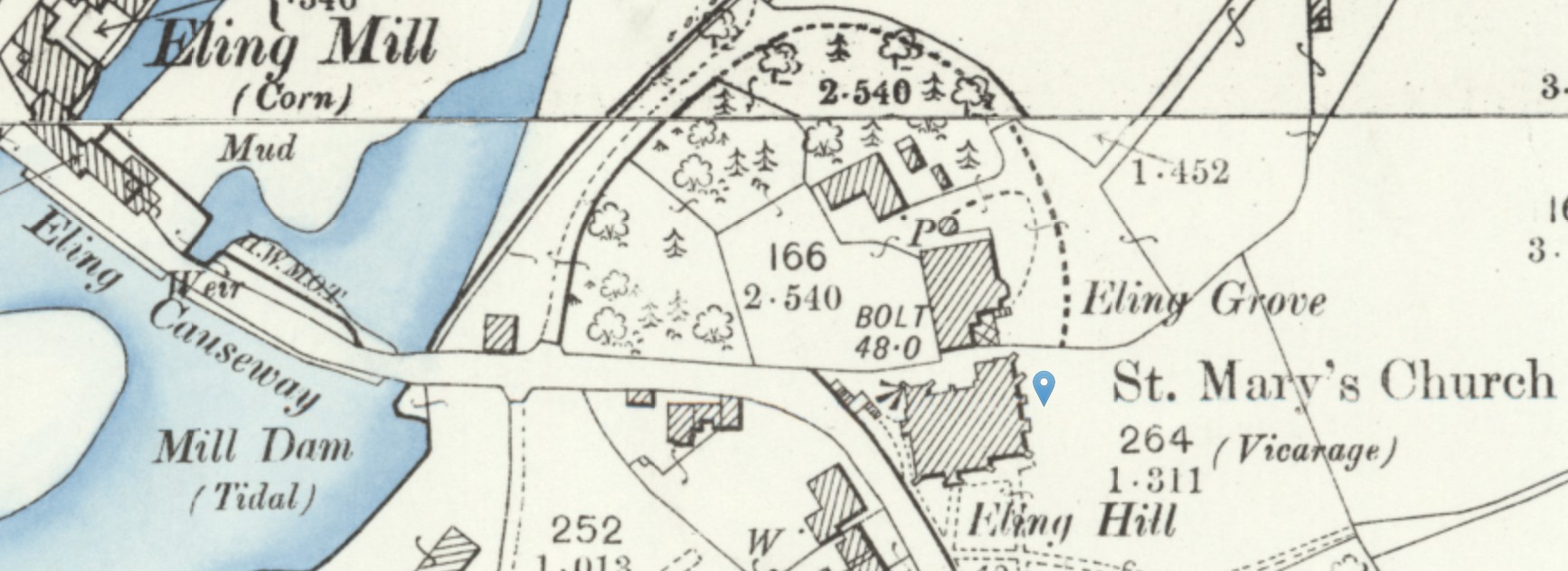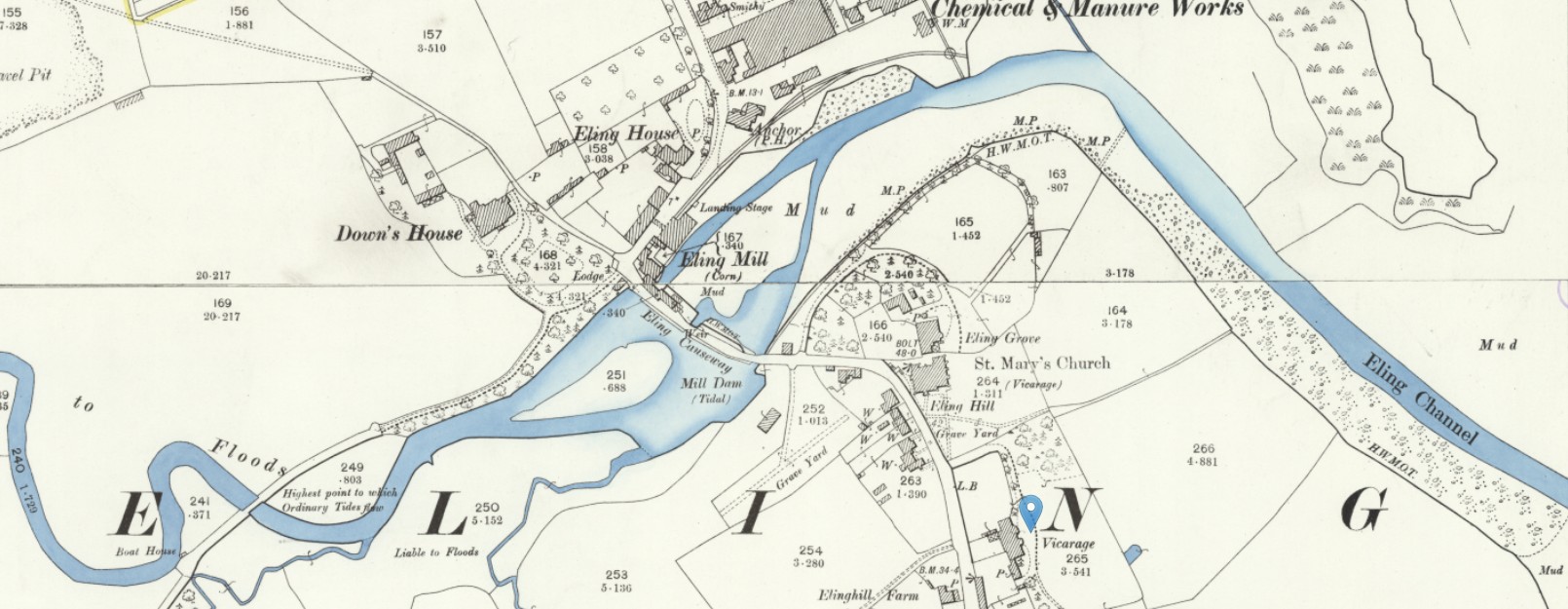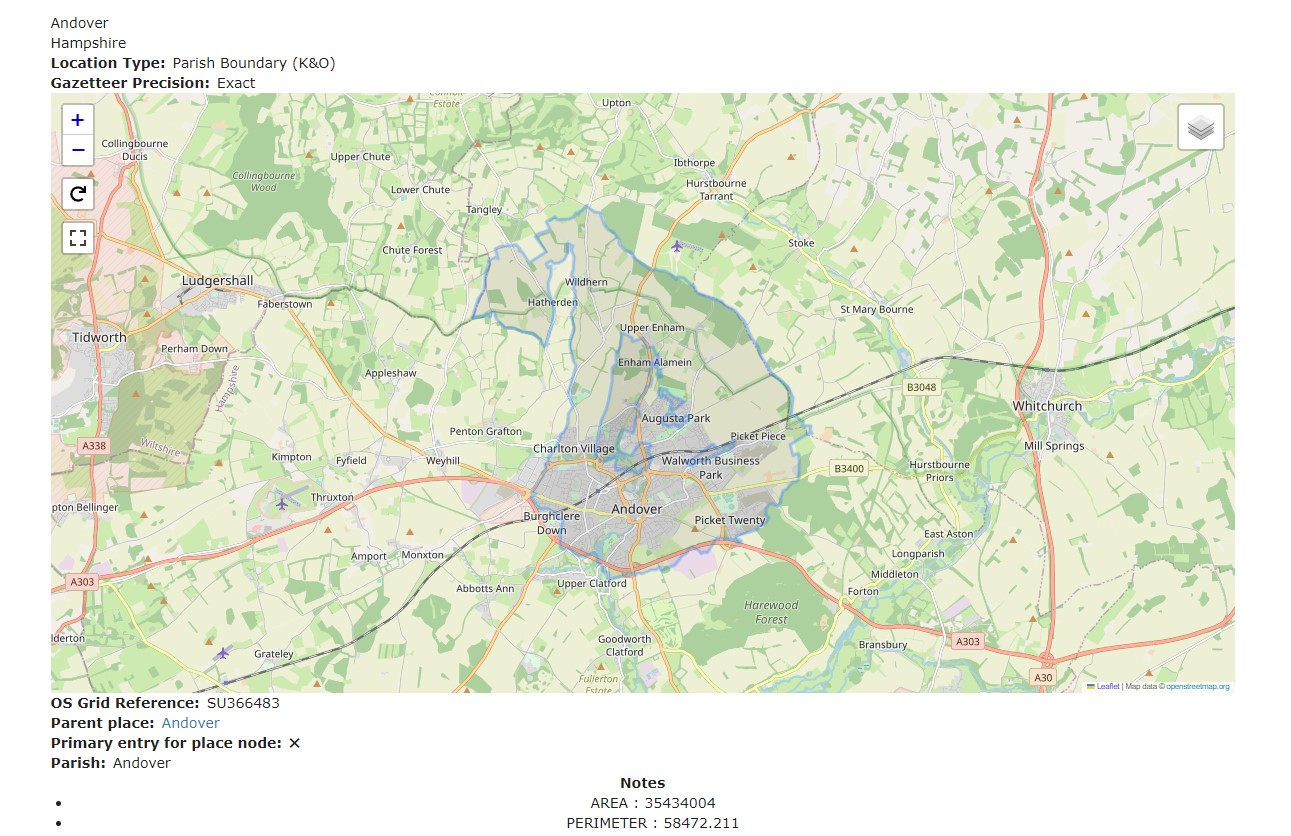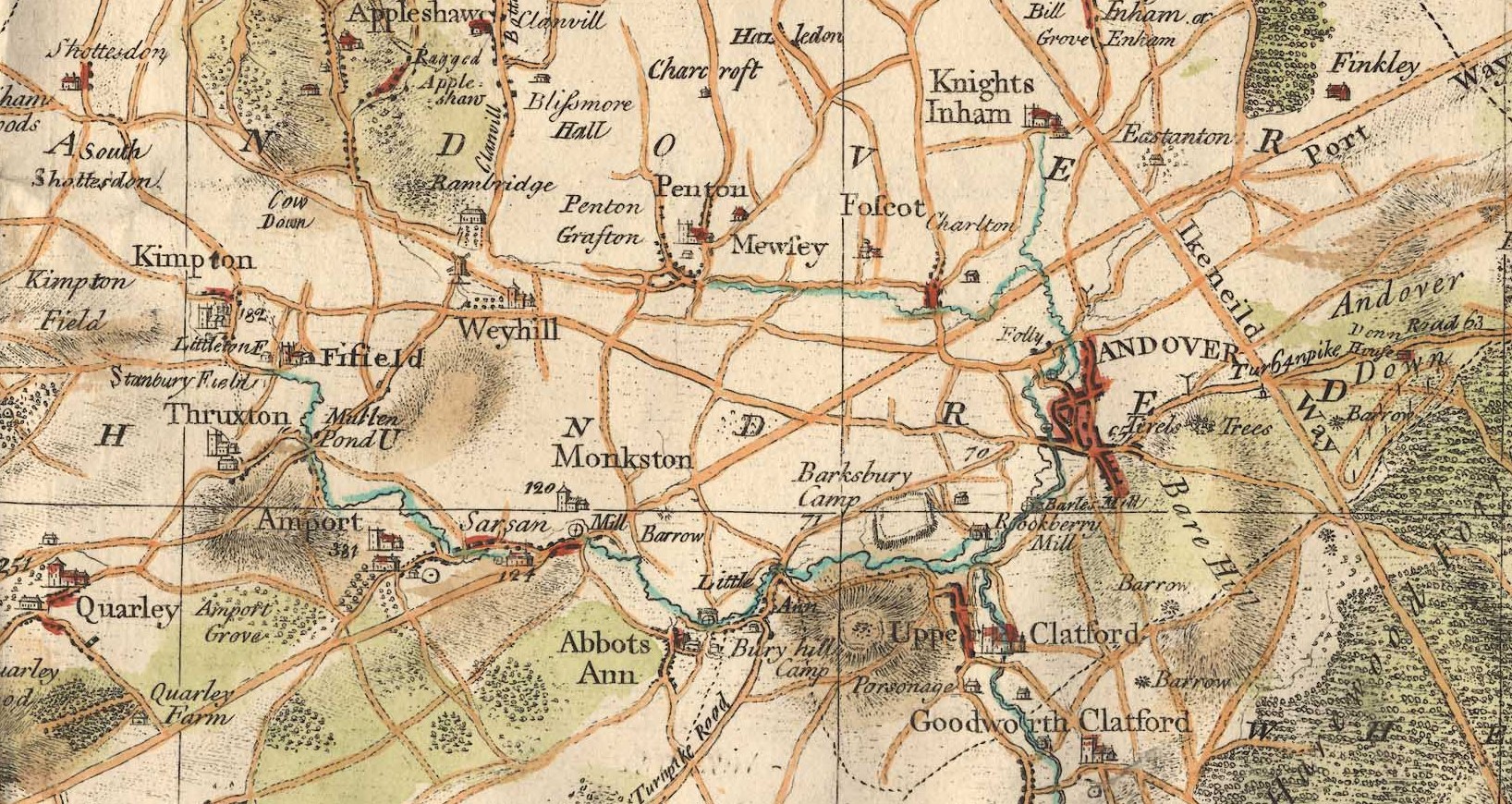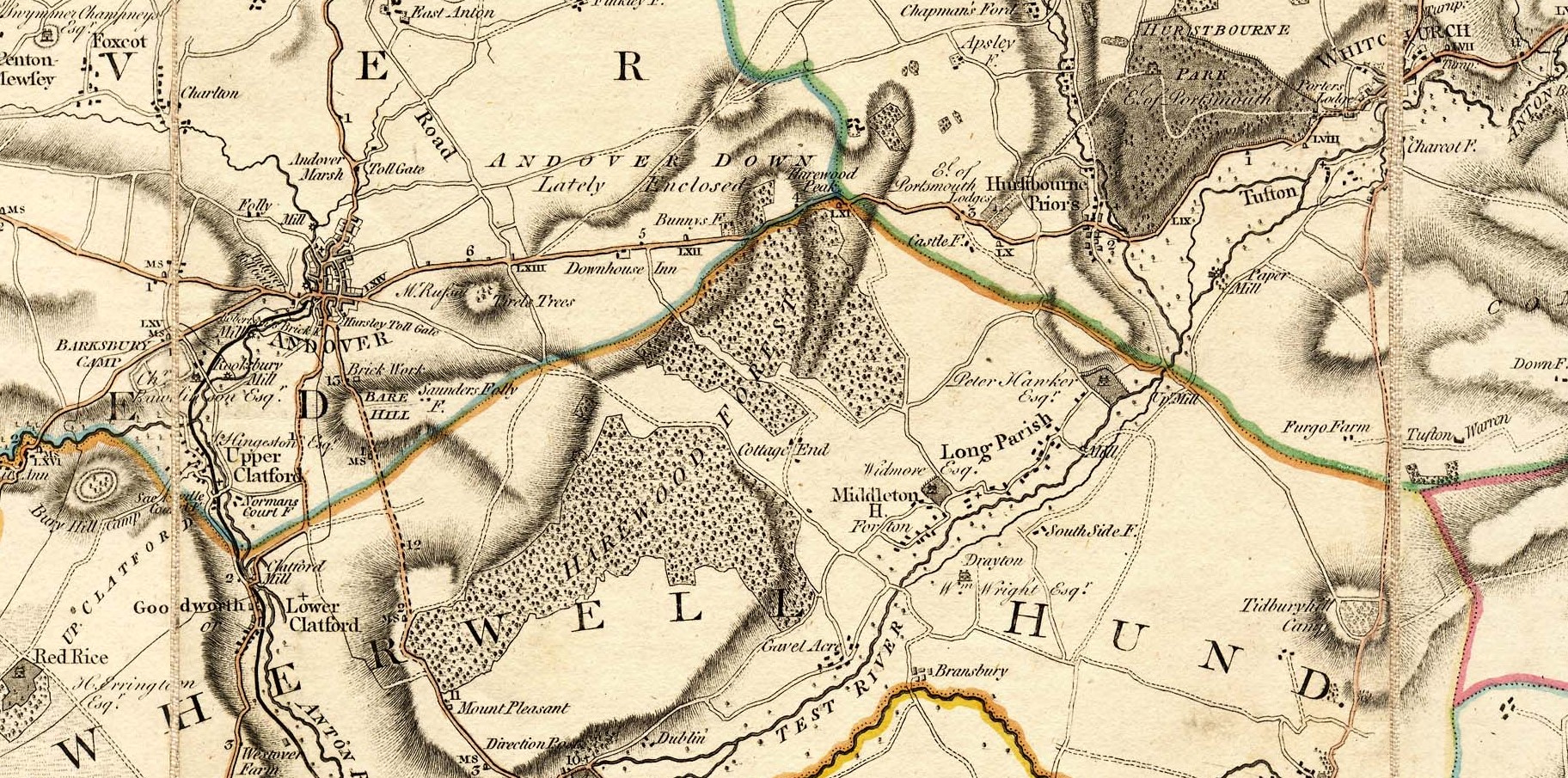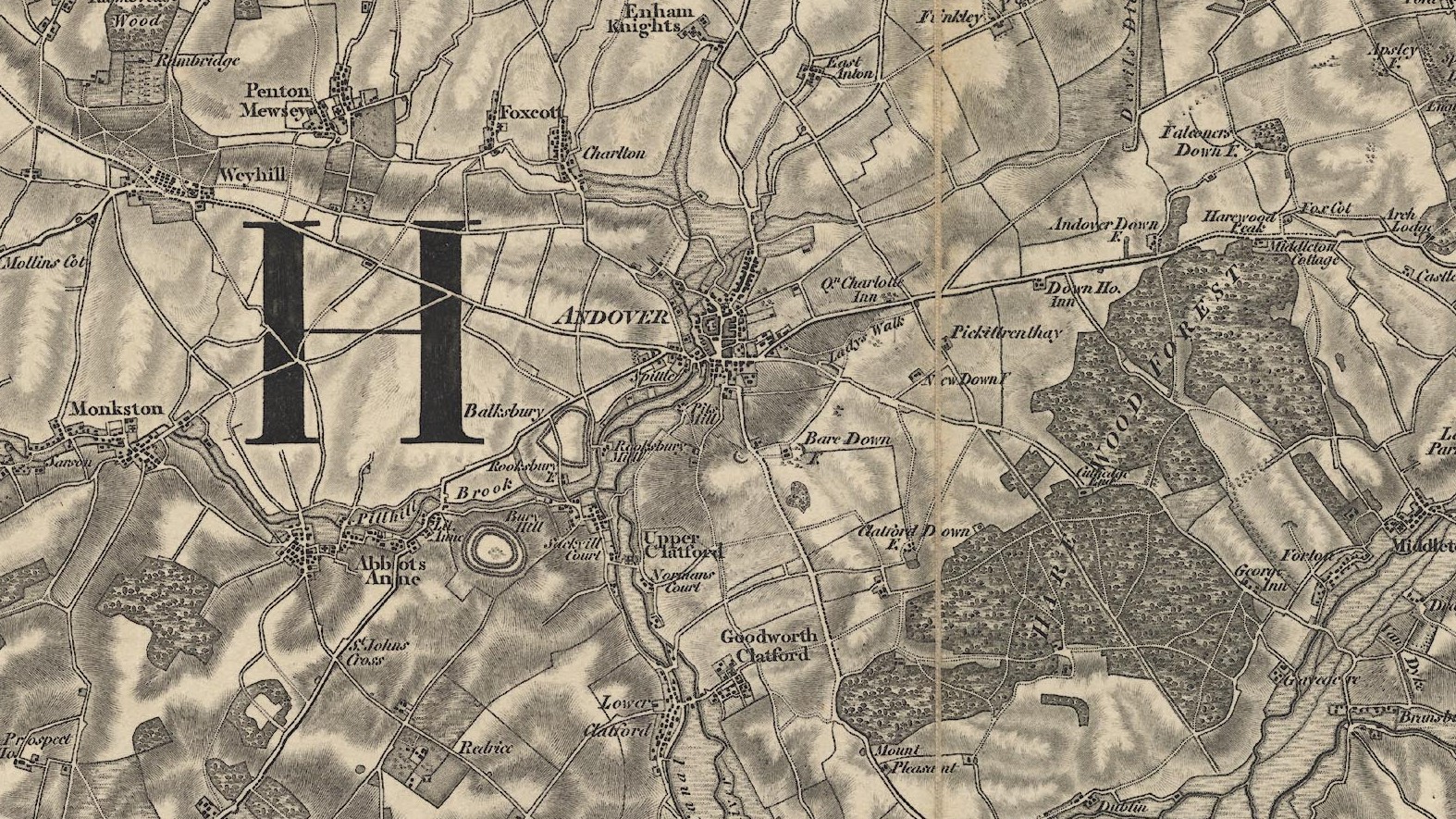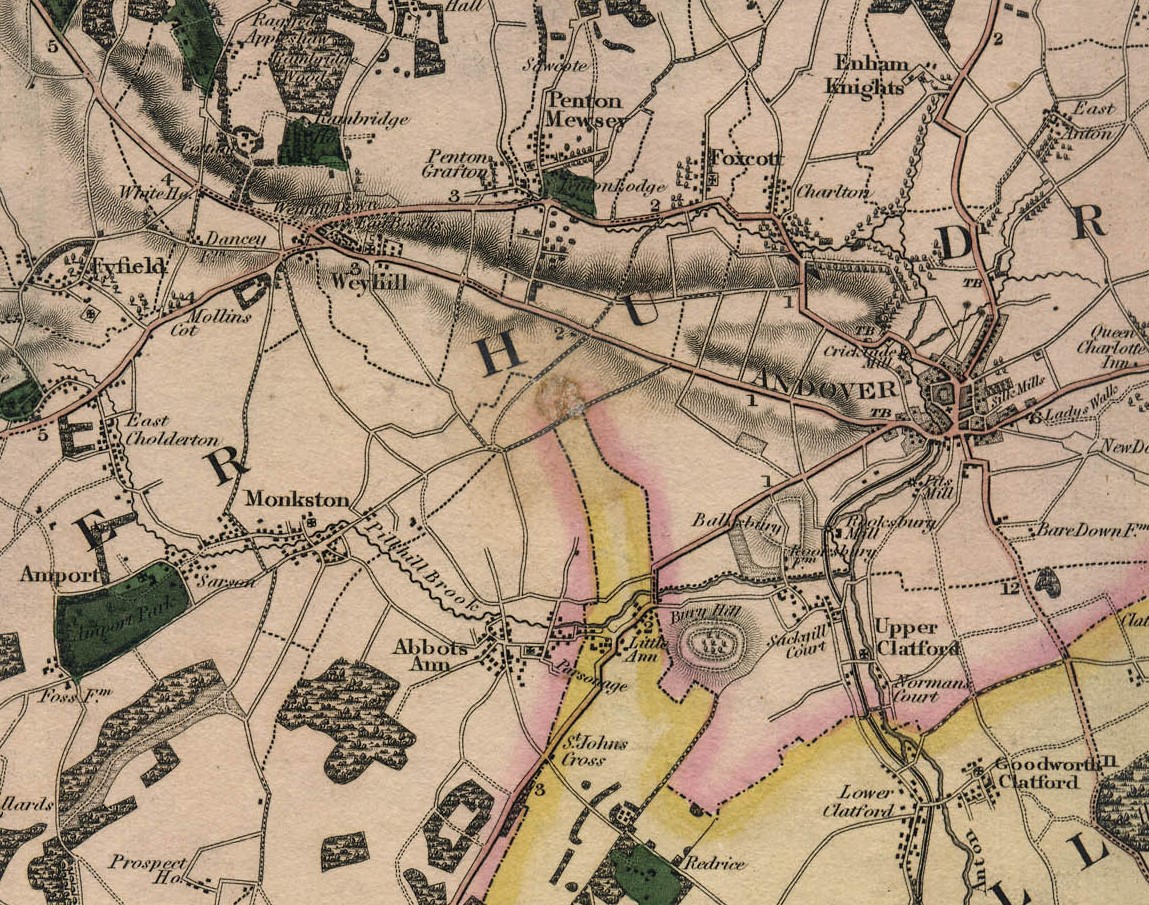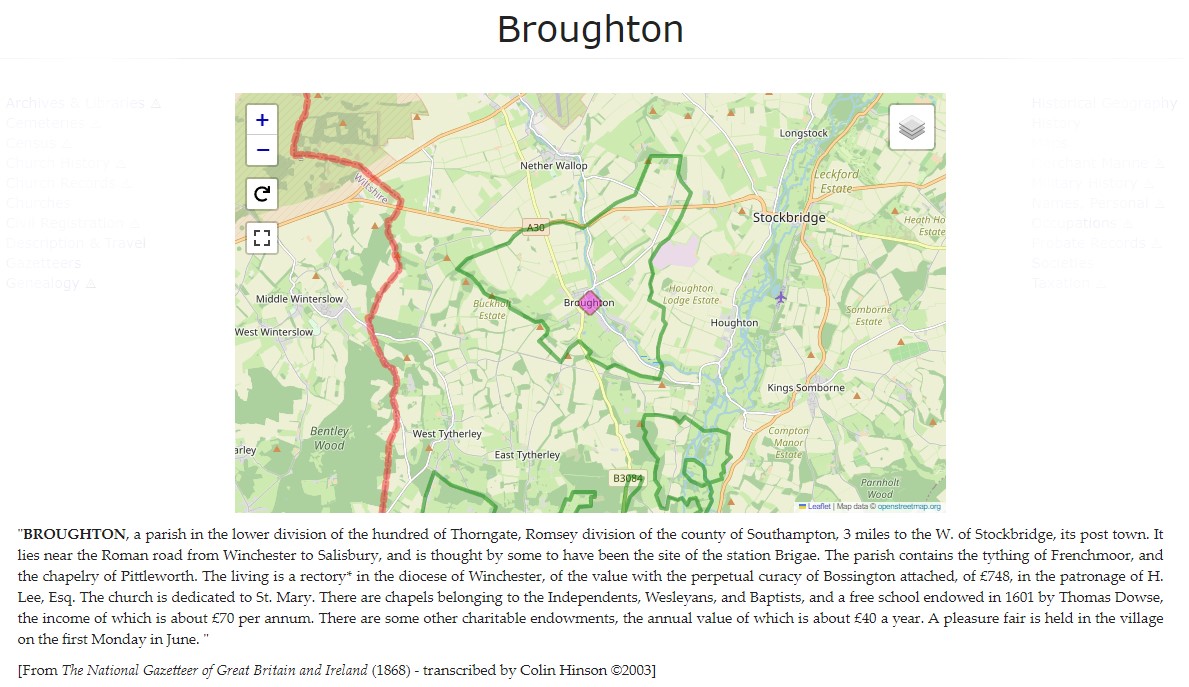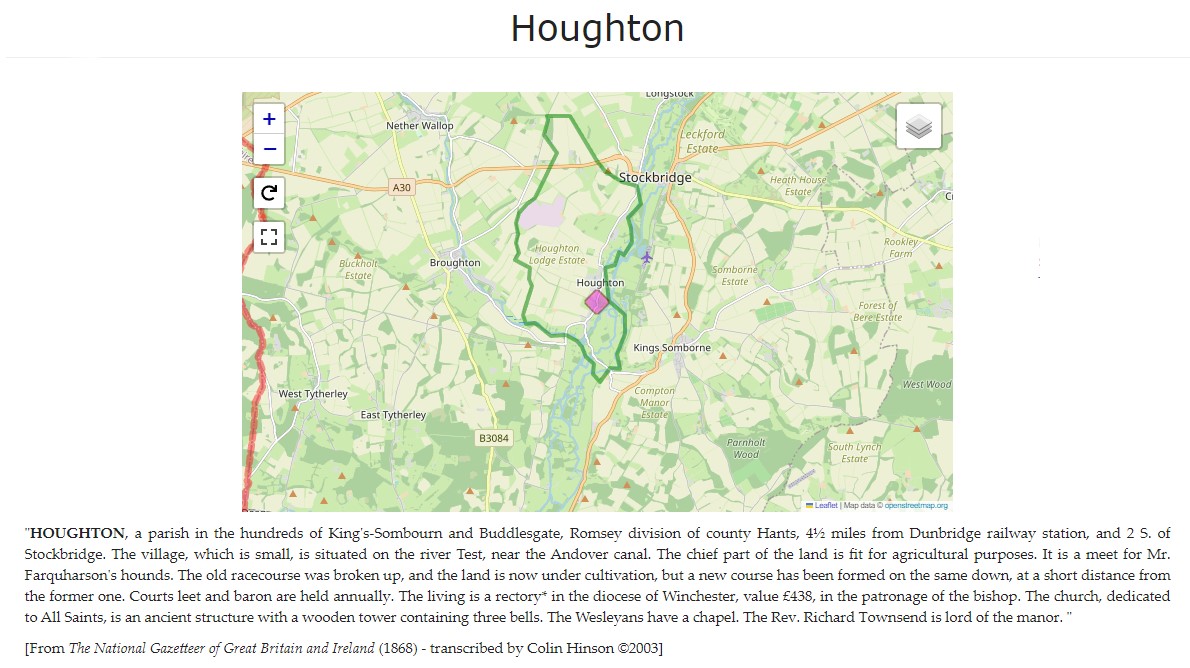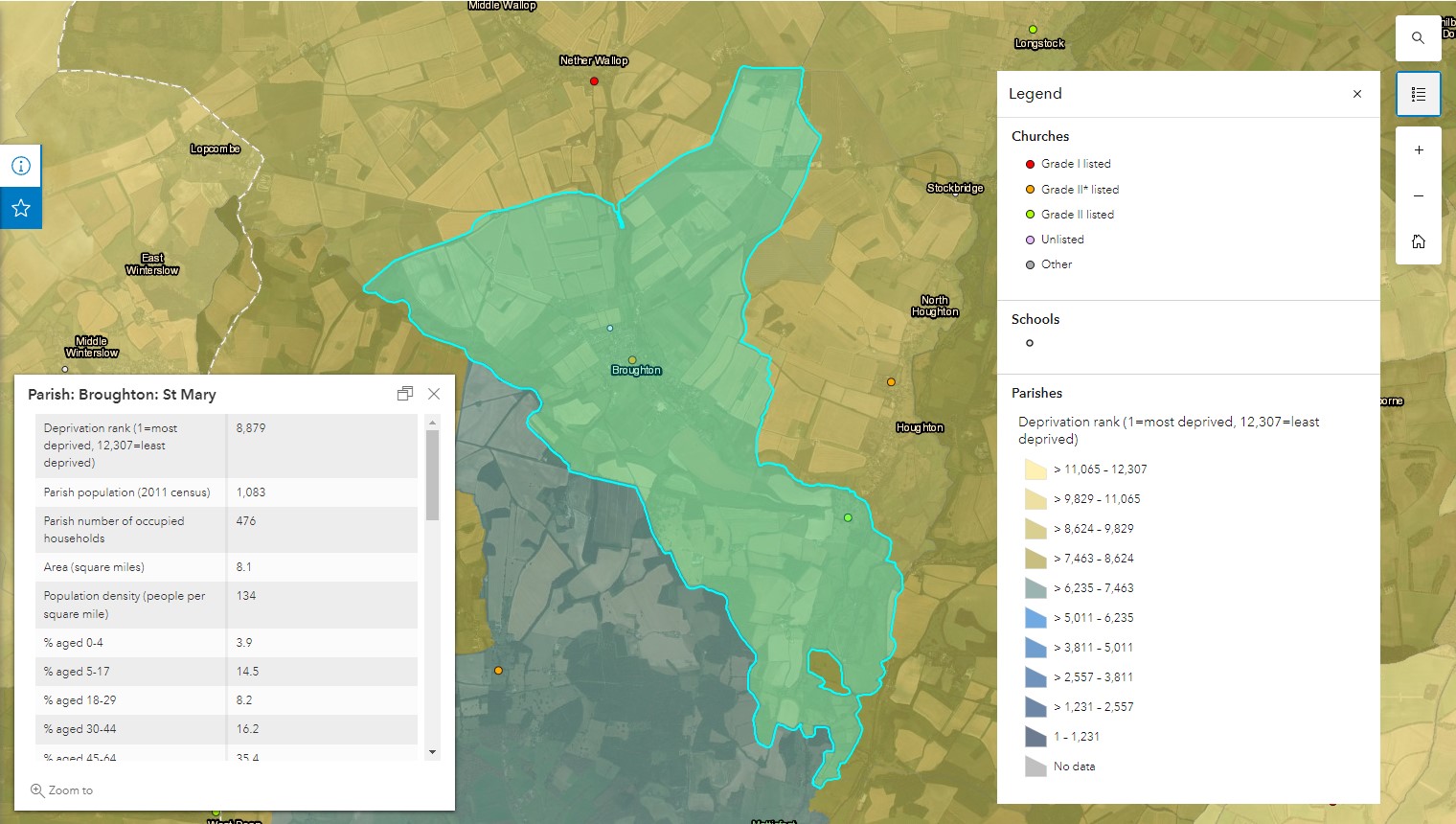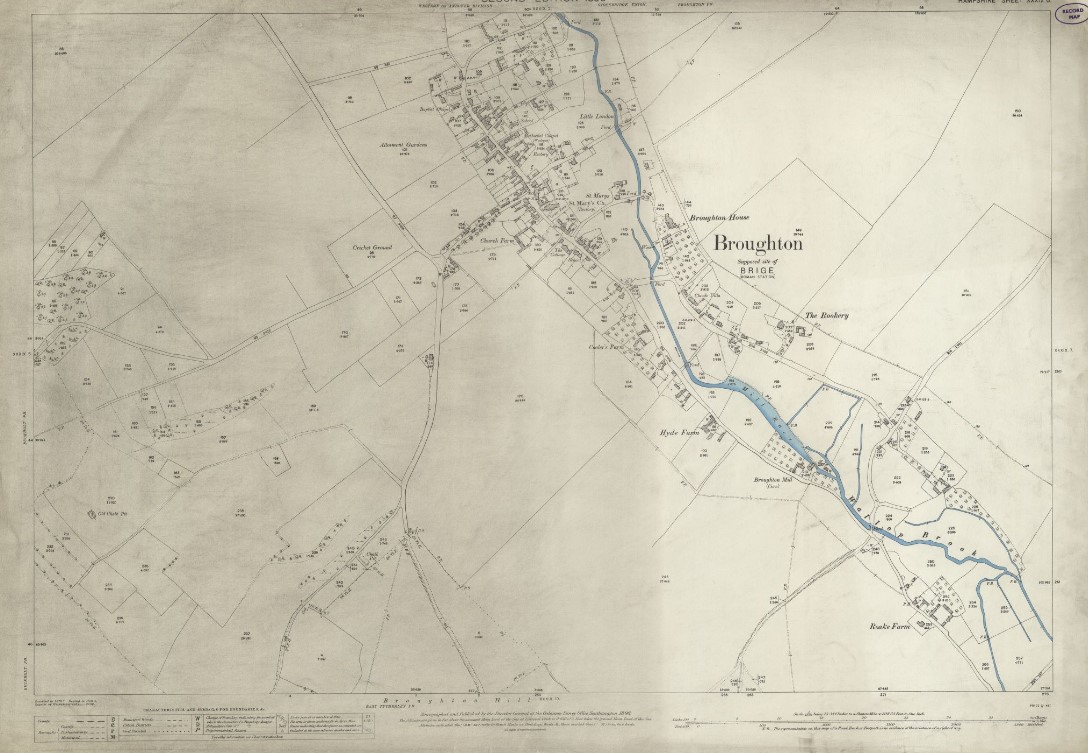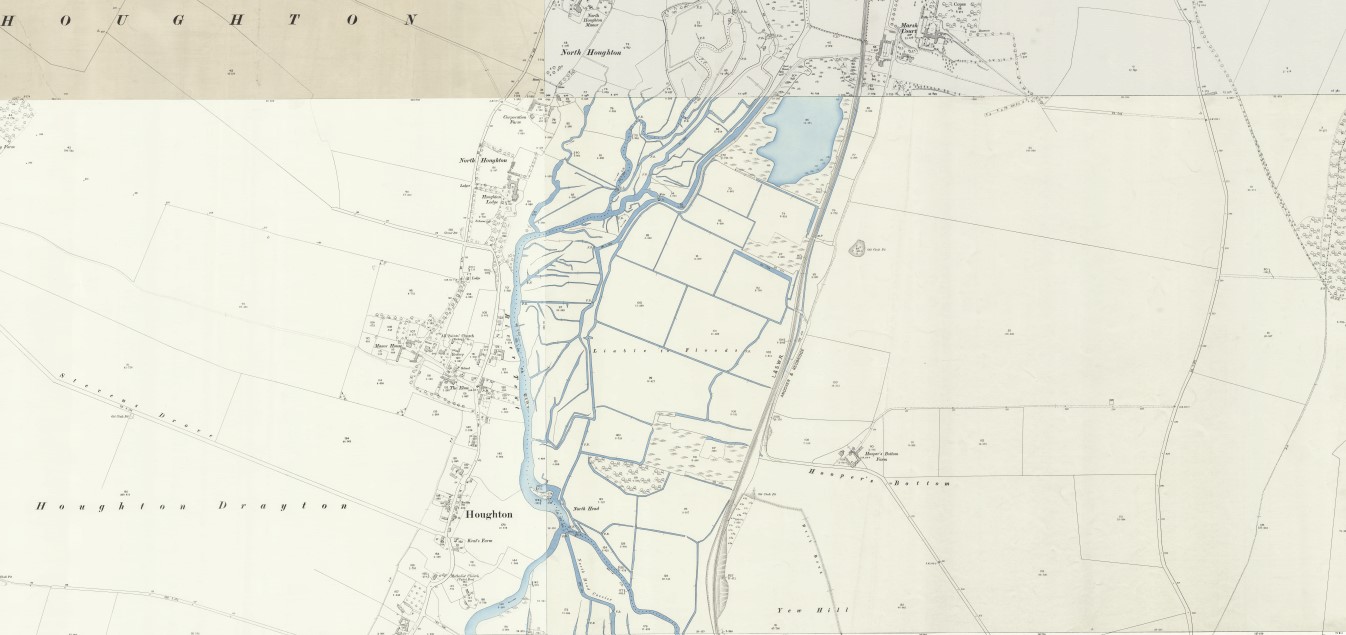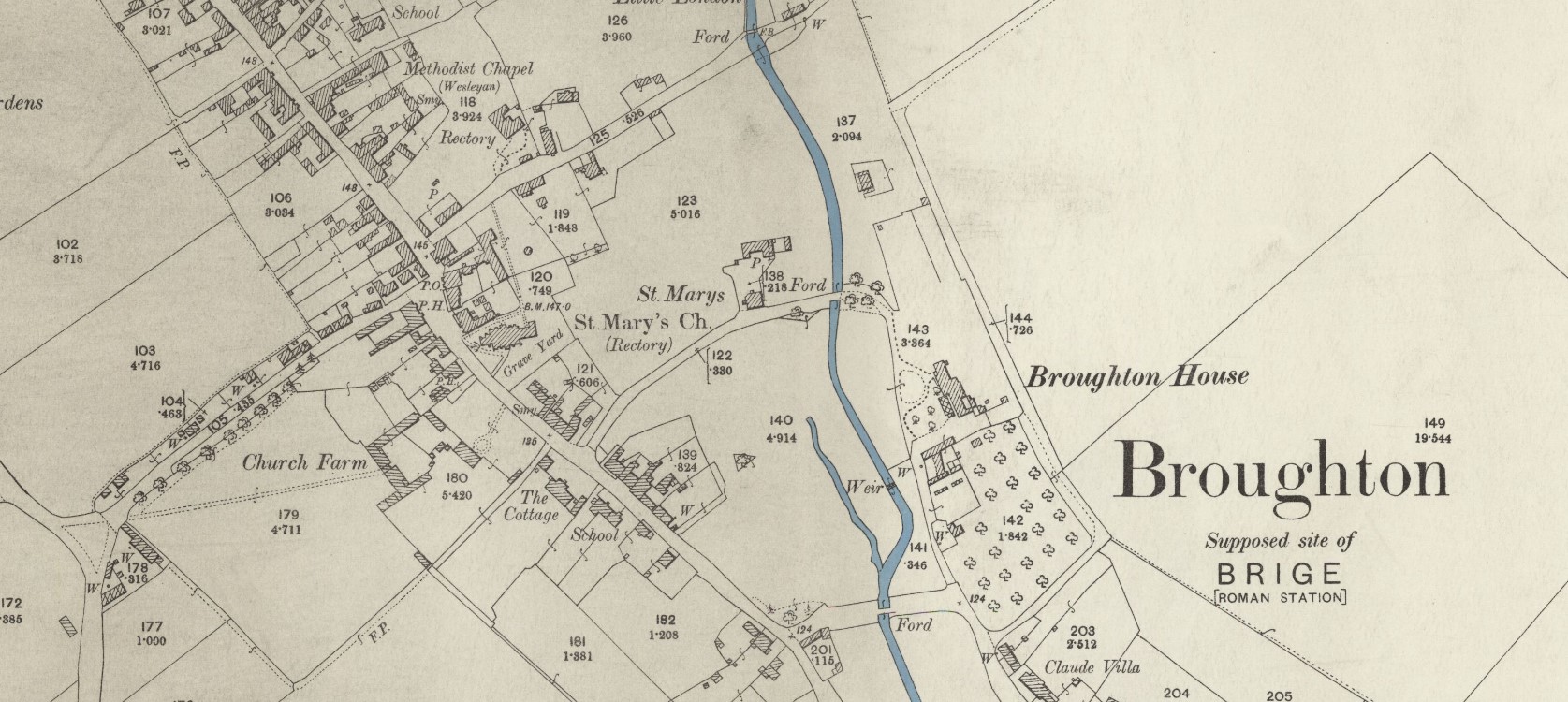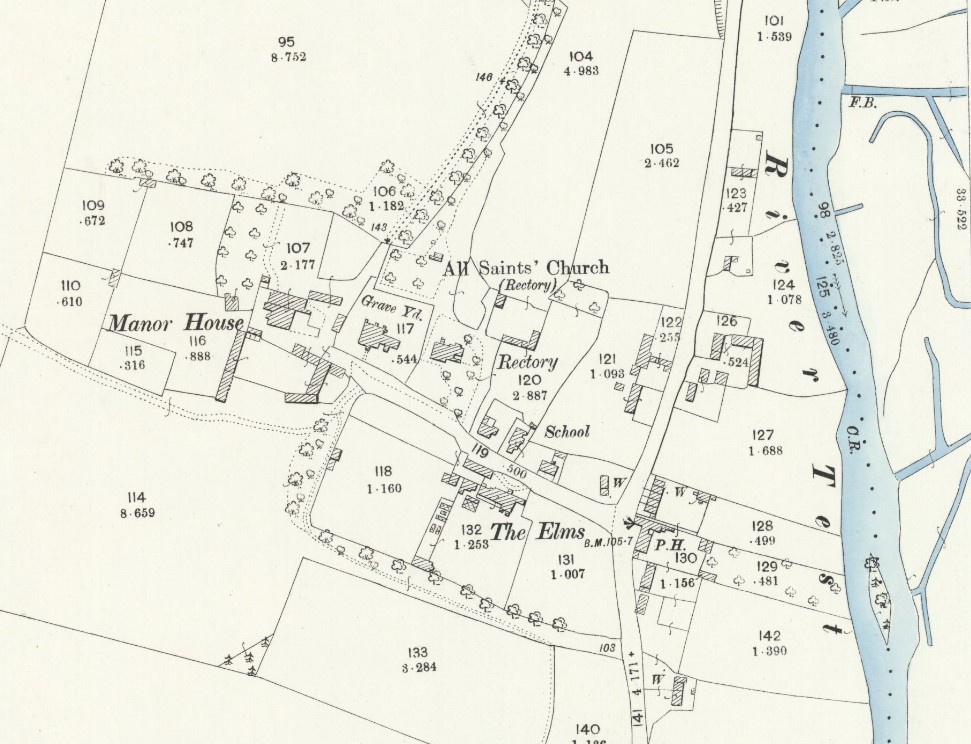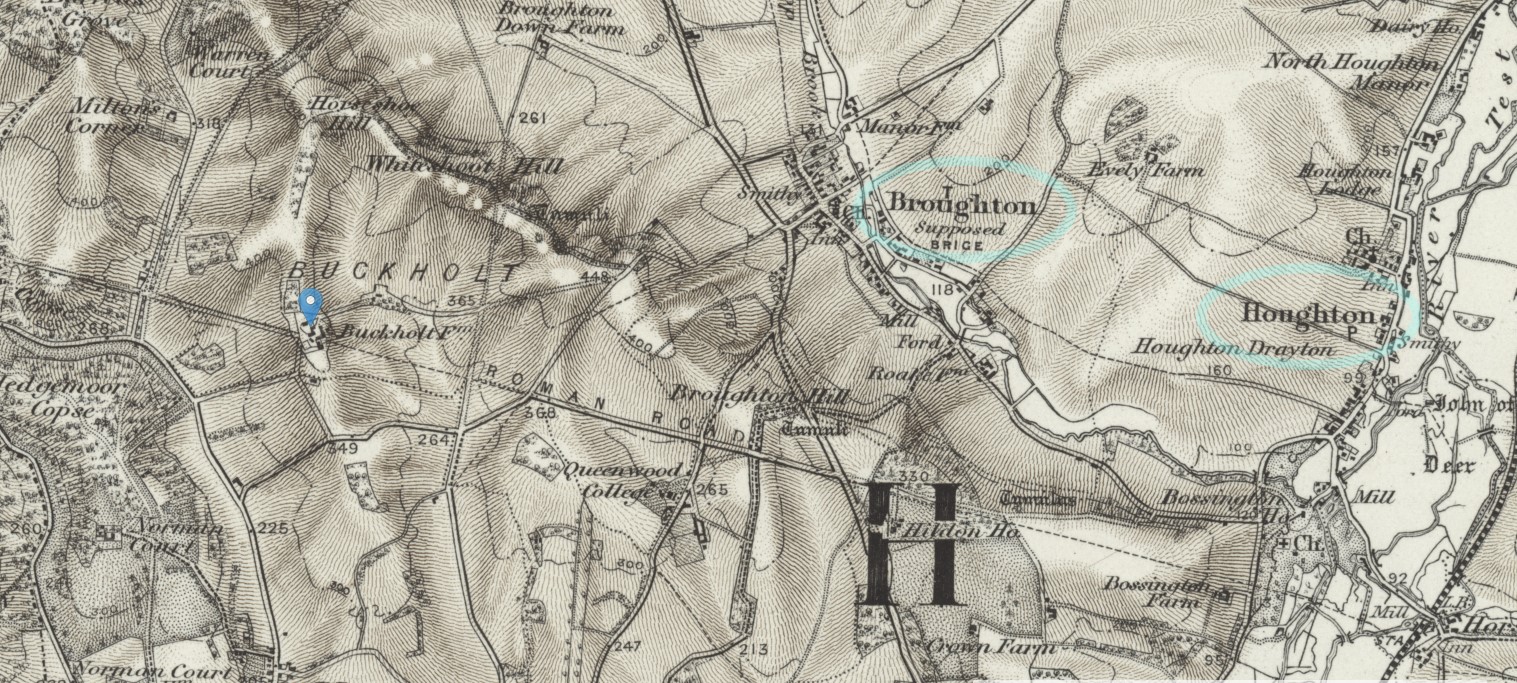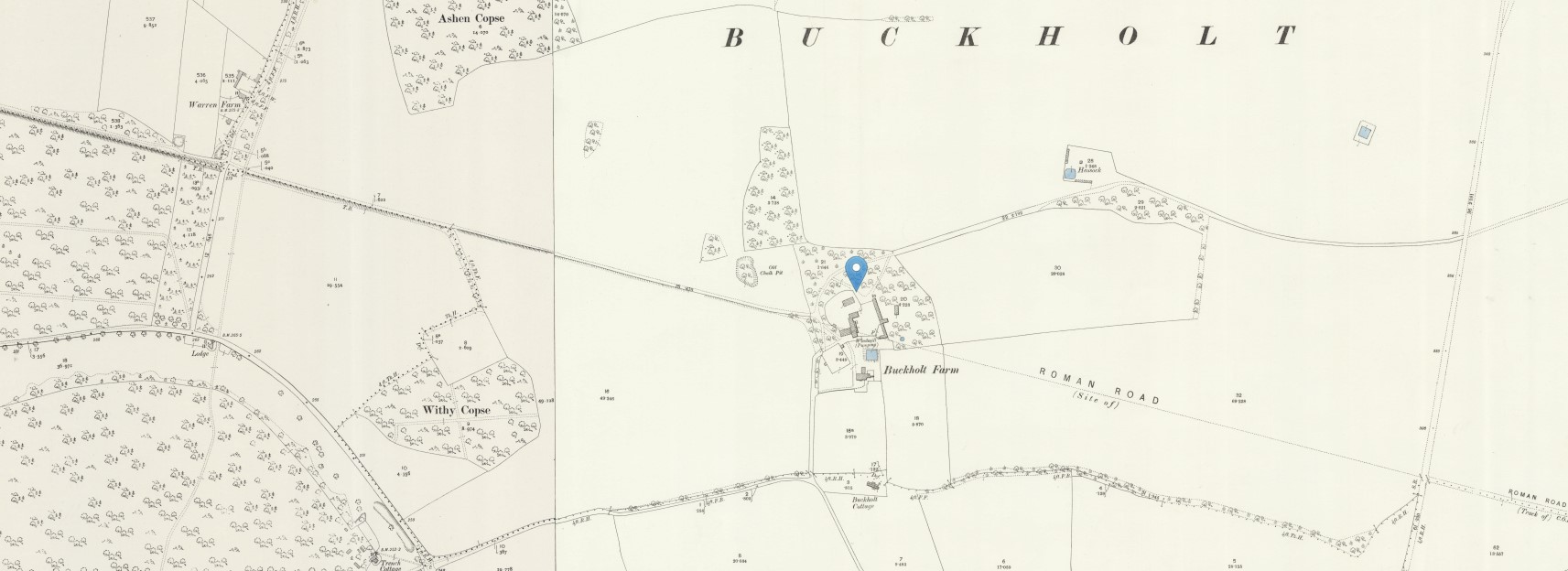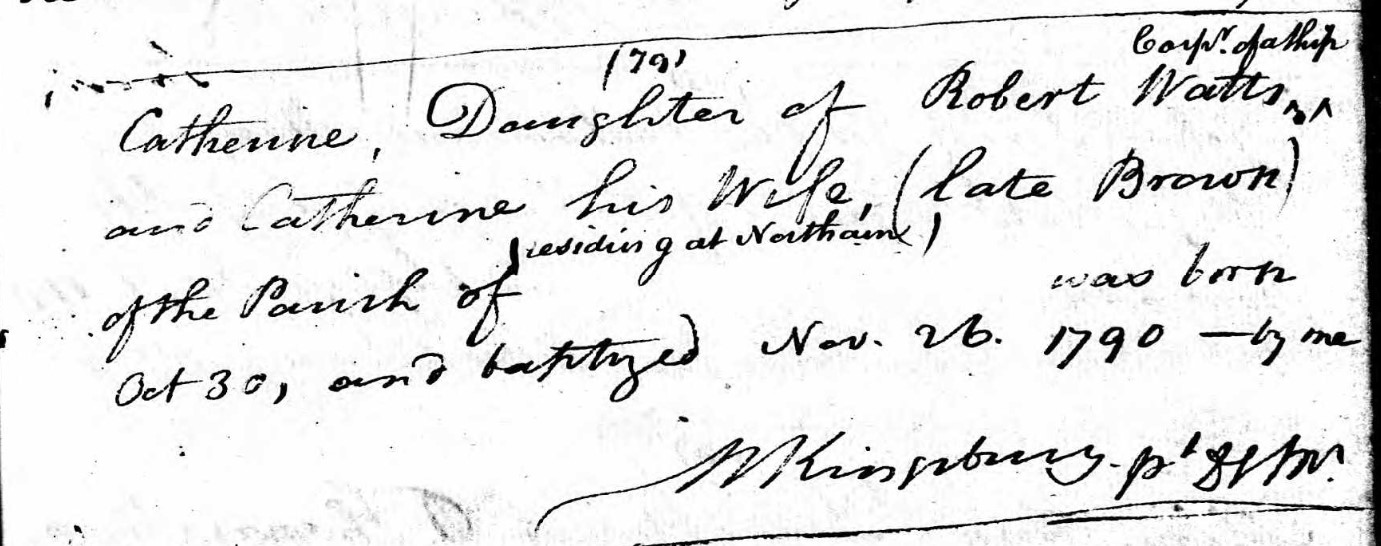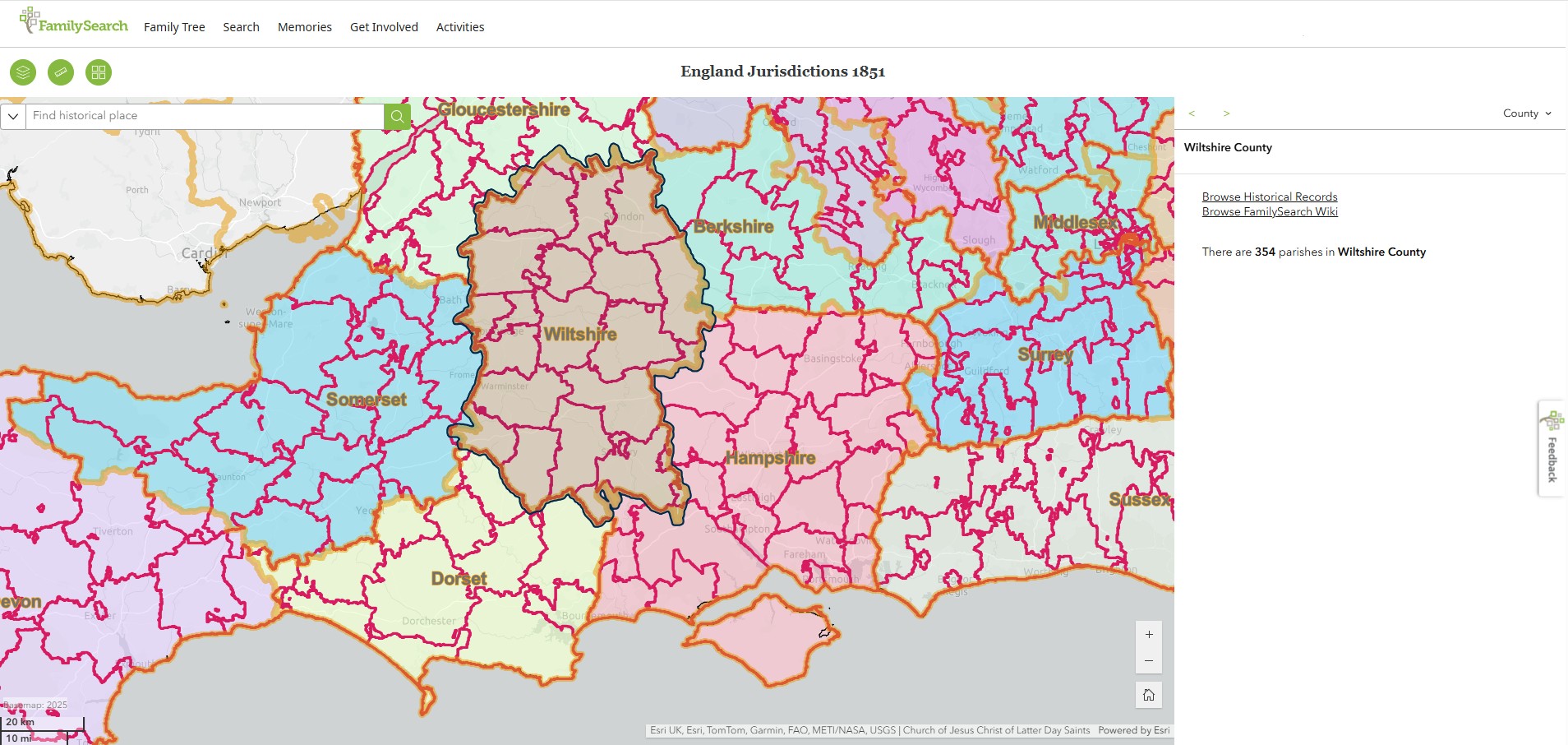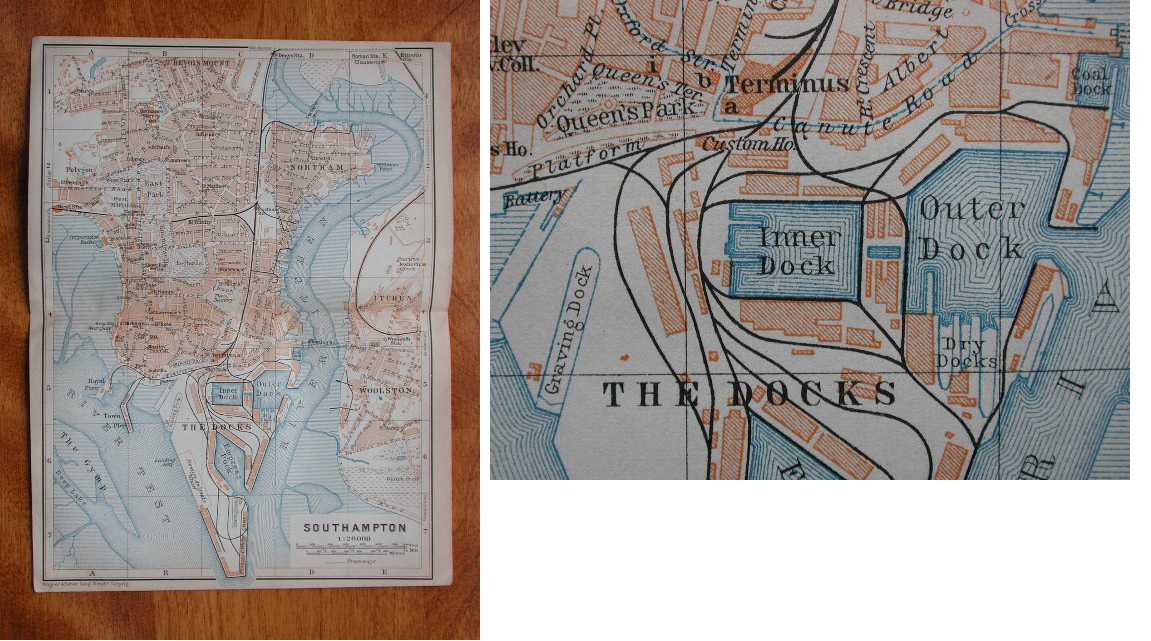John and Mary Mabey of Nursling
Another family another article.
Birth BEF. 17 JAN 1771 • Nursling, Hampshire, England. Baptised 17 Jan 1771.
Death 24 APR 1856 • Nursling, Hampshire, England
Starting relationship;
3rd great-grandfather of spouse of 2nd cousin of wife of 2nd cousin 1x removed
Starting Ancestry Synopsis;
When John Mabey was born on 17 January 1770 in Nursling, Hampshire, his father, William, was 36 and his mother, Ann, was 29. He married Mary Penny on 3 March 1794 in Eling, Hampshire. They had three children during their marriage. He died on 24 April 1856 in his hometown, having lived a long life of 86 years.
This will attempt to add some clarity regarding his family. Watch the story develop in 'Discovery'
Help Notes.
The expectation is that people reading this will use it in different ways. Some will just jump to the conclusion, whilst some others will want more information and go to the datasheet. A very few may read cover to cover, which I hope you will find interesting and informative. Especially the surprise revelation in Discovery - Other - The Camp.
| Contents | ||
|---|---|---|
| About the Parish of Nursling | Some history, maps, and location information | |
| Register of Nursling Parish Church 1736 to 1797 | Mainly a transcript of the Notes found in that Register | |
| Discovery | Discovery is the research | |
| Data Sheet | Data Sheet is a collation of the relevant data | |
Approx 20,000 words, estimated reading time 66 minutes for the words and 30 minutes for the images.
Surname : Mabey
Child's First Name: John
Date of Baptism : 17 Jan 1771
Parent(s) : William & Anne
Parish : Nursling
Son / Daughter : Son
Notes : N/A
Introduction - Explanation
Discovery
I have decided to split the information about this person into two main sections. The first is discovery. Generally the first discovery is from Ancestry Trees and Hints. For the avoidance of repetition, I will not repeat that in the Discovery section for each person. Sometimes the lead maybe from MyHeritage, or other similar genealogy sites. Where that is the case, I will state so. Another lead could be DNA, including Ancestry's ThroughLines, again to be stated.
However, the main point of the discovery section is to create something of a story for the person and his or her life. A brief synopsis, sometimes over and above that created by Ancestry's AI.
Data Sheet
The next part is the Data Sheet. Designed to be the collection of all the records, and information found about the person. It can include records already shown in the Discovery Section, for completeness of the Data Sheet. However, although the template is structured for lots of possible information, I am sure that there will be times when there will be many gaps, which will be left so, just in case more information comes to light at a later time.
Structure
The structure of the family website is multifaceted. It depends of where you come into the site as to how transparent this is. The most simple page is that of a single person. More complicated is a single family, where there is a father and the articles within for associated people such as wife and children. The next level is multi-generation built around a hub, Articles within articles, generation after generation. With time it slowly grows. Each person within the growing mass, has a single focused article with a similar structure. This method, I think, gives structure to the reader, and to me.
This itself is a snippet which is frequently repeated, and not therefore specific.
Transcription of records is generally shown in this colour.
About the Parish of Nursling
About the Parish of Nursling
This was the location for an introduction to the Parish of Nursling. I like to have the context of the place that I am researching. However, from a reading about the subject matter, it is more of an aside so it has been demoted to Work and Locations.
Register of Nursling Parish Church 1736 to 1797
Register of Nursling Parish Church 1736 to 1797
This Register book has a lot more notes than most Registers that I have looked at. I have accordingly extracted some of that information.
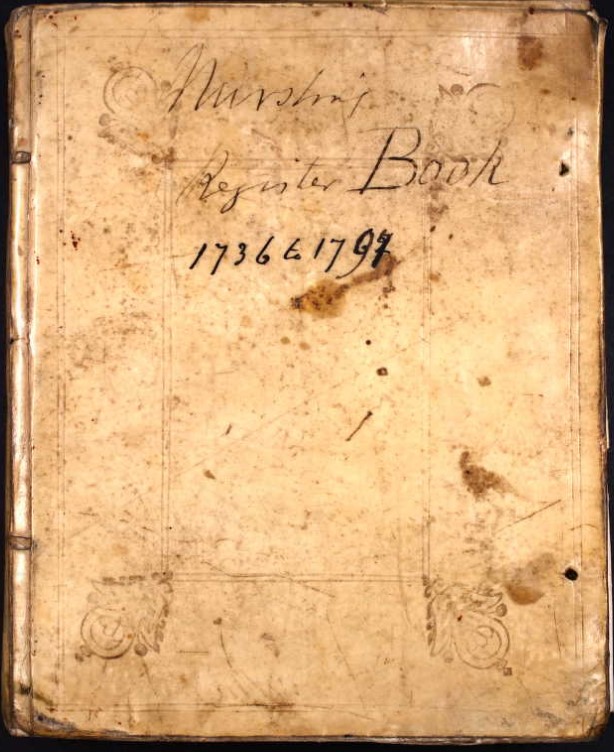
Baptisms, Marriages, Burials Register of Nursling Parish Church 1736 to 1797
However, before we go to there we will look at the previous register.

The Revd Mr Robert Bourne A.M. was inducted into the Rectory of Nutshaling alias Nursling the Fourteenth of November 1733.
It will become apparent the Revd Mr Robert Bourne is the Rector at the beginning of the Parish Register 1736 to 1797.
Transcriptions in sage green.

Fly leaf affixed at the front of the register book

Index
(November 1860) to the Book of ??? , ??? by S.C. Wilks, Rector
This Register Book having been kept in a confused manner, so that to be certain of an entry, or non-entry, it is necessary to make search throughout the whole volume, I soon after I came to Nursling paged it, (in pencil only, so as not to interfere with its integrity) & made the following memoranda, which I have transcribe, & affix, for the convenience of those who shall ??? ??? & to whom he ???, mercy, & peace in the ???.
| p 1 - 36 Baptisms | Baptisms April 11. 1736 to October 14. 1787 } Page 1 to 36 |
| 37 - 48 Marriages | Do Dec 22. 1787 to July 15. 1797 - P 49 to 57 |
| 49 - 57 Baptisms | Marriages Aug. 24. 1736 to June 18. 1780 - P 37 to 48 |
| 58 Burials | Burials June 23. 1796 to Dec. 31. 1797 - P. 58 |
| 59 - 60 Do but not ??? in date | Do (goes back ) Jun 5. 1795 to May 29. 1796 - P. 59 . 60 |
| 61 - 84 Do but not ??? in date | Do (goes back) Dec. 5. 1736 to Dec. 7. 1794 - P. 61 - 84 |
| Scarcement almes on fly-leaves at the end | |
| 1751-1769 | |
| Book 1738 - 1749 |

The marriages from April 14. 1752 (P.42) to June 18. 1780 (P.48) have been entered short, only names of the parties & dates, without clergymen or witnesses (as is the case in other parts of the book) - but beware using these entries for Certificates, the Act of George II c.26 having ordered a new book with fuller entries;- to which ???. This ??? ??? is I believe not always correct in spelling - but I have not ??? ??? of collation.
Opposite to this sheet on which I am writing is a note by ? Woodford Curate, 25 Dec. 1778 stating that "the Baptism of R. King was omitted, the service having been performed privately & the clerk not present so that it was not in the minutes which the Rector copied & entered in the register, but it was afterwards inserted by the Curate. " I found this a useful clue to what my ??? may find a difficulty, I have had many applications for certificates of entries, in former years, which are not to be found, though the families were well known parishioners & church people. Thus, W. Lowman, wishing for a Baptism Certificate, says he was born in 1789, had a sister Sarah about 7 years younger & ??? another sister; his son Ray were all baptised, and received into the church ("christened") & that it was in his ??? & his father's the custom for the children to be baptised at home. Another witness (over)
* I never took a note at the time of Shana Lacuna 2y. Only on chifly in Mr. Aranman's time; & only on chiefly in Baptisms. The ??? is ??? for preventing any ??? ??? the book several times as I have sometimes lest I ??? have misfiled anything Especially as there is now an Index . Morris died in 1776 aged 58 , Rector 30 years. Cranmer in 1809 aged 70:33 years. Lukin in 1846: aged64. 37 years.
Another note;-
S. C. W. succeeded Mr. Lukin Jan 1847. Born in 1788 [ Now living 1869 in my 81st year S. C, Wilks ]


Continued from (over) above.
Another witness ... tells me that Mr Lukin said he had great difficulty in correcting this ???. Further, I have been informed that the "receiving into the church" was often preformed at home. I find W. Low??? ??? Sarah; but neither he, nor his brother, or ??? sister, ??? found. He told me the name of one of his Godfathers, & I have no doubt of his baptism. Mr. Casnener was non-resident, on account (the Licence states) of Nursling Rectory being situate in a tract of many miles of unwholesome murshy ground; the Clerk therefore in keeping minutes for registering, & accounting for fees, may have made ???. In the very year 1789 when Mr Lowman was left out, there is the entry of "Recieved into the church William, Banjamin, & Elizabeth the sons & daughter of John & Elizabeth Bowles, at several times privatly baptised. " One might have been forgotten; but three could not but cause inquiry. R. King was forgotten; but King being a large farmer wanted his ??? ??? for some purpose ??? ??? ??? interpolates the baptism on the ??? ??? of his fly-leaf memorandum which could not be correct.
I thought this explanation ( & I might add other odd thinks in the ??? books) might minister to the convenience of future ???. S.C. Wilks.
Apparently, not all is well in terms of this registry.
Note


1736
A Registry of Baptisms, Marriages, & Burials for the Parish of Nutshalling, alias, Nursling.
Robert Bourne A: M: Rector.
N.B. The Baptism of Richard King was omitted, the Service having been performed privately and the Clerk not present, so that it was not in the Minutes which the Rector copied and entered in the Register, but it was afterwards inserted by the Curate.
25 Dec. 1778
Matt Woodford Curate.
Wittness Richd Whitcher
NB Thomas Richards having declared; that his Daughter's real name, who was registered Jany: 12. 1763, is Mary and not Elizabeth as set Down by mistake of the then Rector, it was on Sunday Octr. 29. 1780 altered and rectified, agreeably to this Declaration and the Testimony Blanch Pitman, who had knowledge of the Fact.
Robert Gunther Rector
Witness
Matt Woodford Curate
Extract of Will of Reverend Mr Bourne




By a Clause in the Will of the late Reverend Mr Bourne, Rector of Nursling, alias Nutshaling, the following Goods are bequeathed to the Parsonage.
I give & bequeath for the use of my Successors in the Rectory of Nursling, & as Standards to be preserved & contained in the Parsonage House.
Two Hanging Dressers, one in my Study, the other in a narrow Passage over the Hall.
A Dresser of Drawers in the Kitchen, & a narrow Case for Sugars, Spices, etc. in the Kitchen.
A Leaden Pump putt up quite new by me in the Brew house: a Bottle Rack, & Chicken Pen:- A Cheese Rack, & Bin for Oats in the Store room.
Two Corn Bins in the Stable:- Two Wheel Barrows, -- Two Garden Rorolers [Rollers?], one made of Stone, the other Wood.
And my Will is that this Clause be transcribed into the Parish Registry in order to prevent the sale or removal of any of the particulars.
Robt. Bourne.
The above written Clause was inserted in the Parish Registry of Nursling by me
Thomas Jefferies Curate.
Witness
June 7. 1745
John Morgan
Richd Whitcher
N.B. The Press, & Shelves over the Corn Bins in the Stable are not included in this Gift.
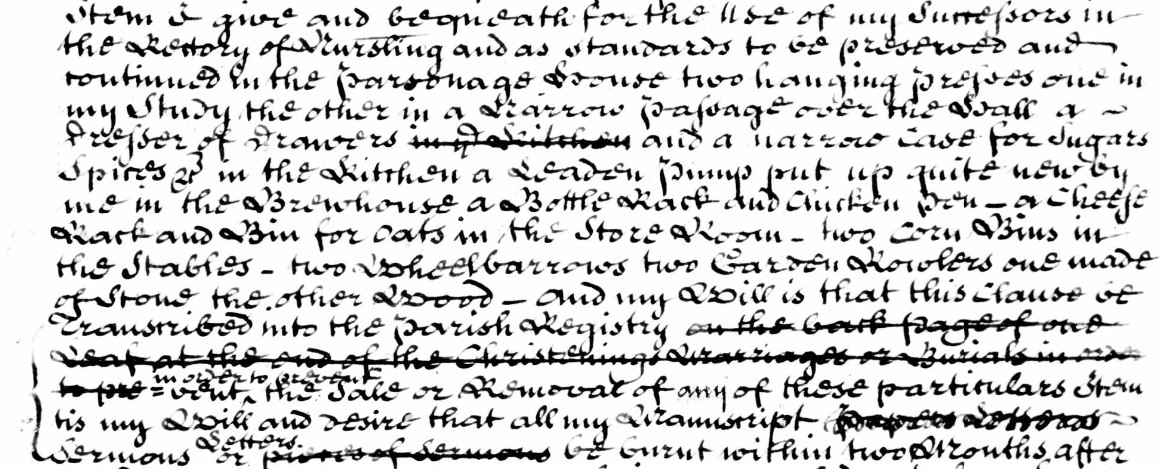
Above is not from the Parish Register but is an extract from the Probate copy of Robert Bourne's Will.

-------- Of the Articles referred to on the other side only the Stone Rollers were delivered over to the Rev S.C, Wilks on his coming to the Rectory (1847) the others having been previously worn out.
Wm Lichfield
Church Warden & Sequestrator

( The Rectory house was rebuilt by Mr Cranmer, long after Mr Bourne's death)
[There are some memoranda on the first paper leaf of this book ]
S. C. Wilks
It is evident that Mr. S. C. Wilks was very particular in his ways, and in the keeping of records.
About the Rectors and Vicars
We also have the beginnings of a list of Rectors of the Parish of Nursling.
Morris died in 1776 aged 58 , Rector 30 years. Cranmer in 1809 aged 70:33 years. Lukin in 1846: aged 64. 37 years.
Another note;-
S. C. W. succeeded Mr. Lukin Jan 1847. Born in 1788 [ Now living 1869 in my 81st year S. C, Wilks ]
| Name | Died | Age | Calculated birth | Period as Rector |
|---|---|---|---|---|
| Robert Bourne | 5 February 1744 | 53 | 1691 | 1736 to 1744, 8 years |
| Edmund Morris {& Matha } | 1776 | 58 | 1718 | 30 years |
| Robert Cranmer | 1809 | 70 | 1739 | 33 years |
| John Lukin | 1846 | 64 | 1782 | 37 years |
| S.C. Wilks | 1788 | 1847 to |
And now for something different.
A List of Rectors & Vicars
The above website was found whilst searching for Eling, but also has entries for Nursling. Click on the image to go to the source.
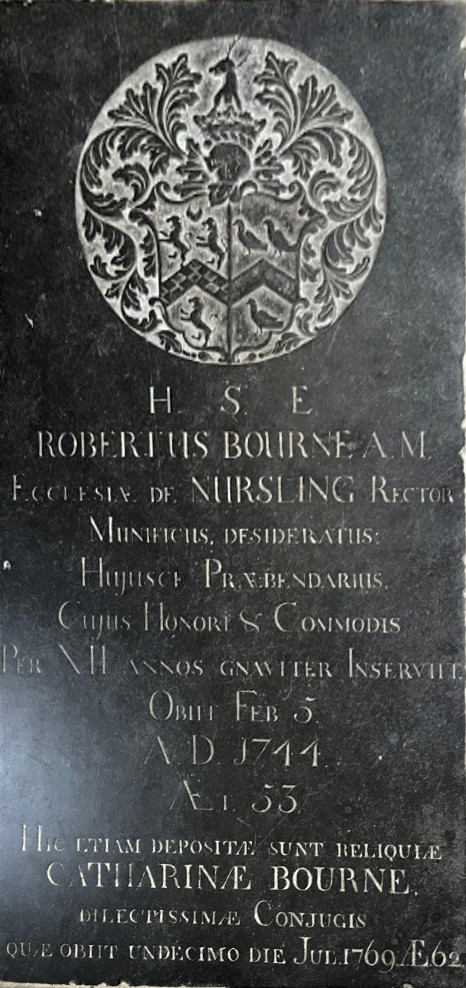
The Memorial Stone at Winchester Cathedral of Robert Bourne A. M., the first Rector mentioned in the Nursling Parish Register 1736 to 1797.
The stone inscription is in Latin.
Using Google Translate, it is something like;-
| Latin | English translation (Google) |
|---|---|
|
H. S. E. Robertus Bourne A. M. Ecclesia de Nursling Rectory munificus desideratus hijusce praebendarius cujus honori & Commodis Per \II annos gnwtter Inservi Obit Feb 5 AD 1744 At 53
|
H. S. E. Robert Bourne A. M. The Church of Nursling Rectory the munificent desired until now the benefactor of whose honor and favors Died Feb 5 AD 1744 Aged 53 |
| Hie etiam deposit sunt reliqule Catharine Bourne dilectissimae conjugis que obit undecimo die June 1769 AE 62 | Here are also deposited the remains of Catharine Bourne, his beloved spouse who died on the eleventh day of June 1769 Aged 62 |
The Church at Nursling dates from well before the start of this Registry in 1736.
More information from the Parish Register, this time about the Rector following the Rev. Robert Bourne, the Rev. Edmund Morris
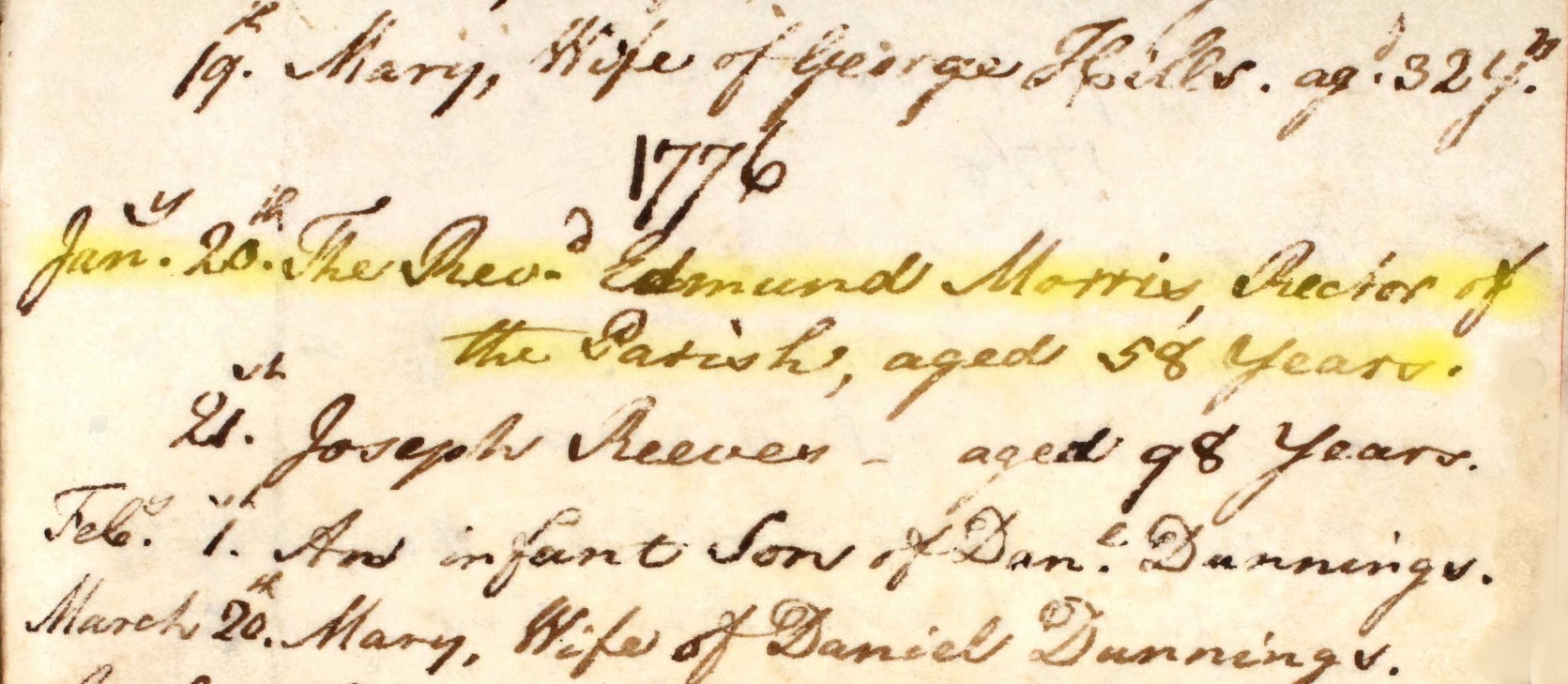
Jany. 20th. The Revd. Edmund Morris, Rector of the Parish, aged 58 Years
Jan 20, 1776 The Rev. Edmund Morris, Rector of the Parish, aged 58 Years
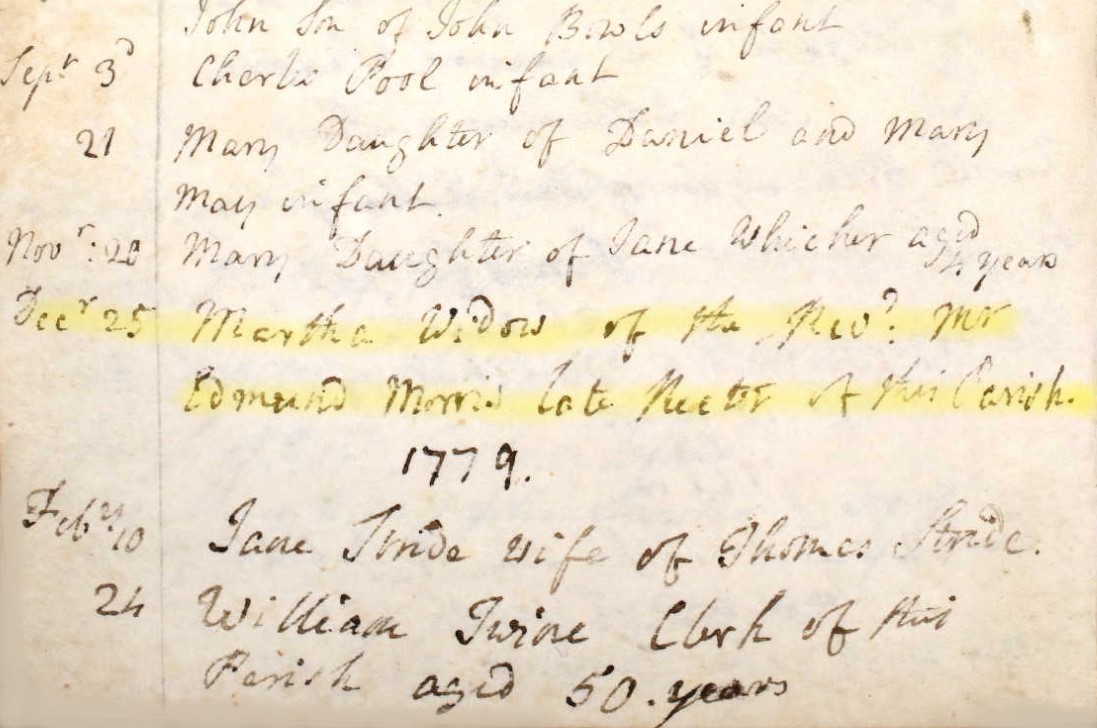
Decr 25 Martha Widow of Revd Mr Edward Morris late Rector of this Parish
Dec 25, 1778 Martha Widow of Revd Mr Edward Morris late Rector of this Parish.
His widow did not last many years after his death.
Discovery
Discovery
This is the research hub. A record of the information I have found, or sometimes not found, whist digging around in the past to find out about this family.
It could be called Research and Discovery, but the section mainly only records the discoveries made, hence the name.
The first part is very easy, outlining the seed or inspiration for this article, together with using Ancestry to provide some information about the Surname, Mabey. There is also a brief history of why we are lucky enough to have parish records today to delve into.
The next section is also, relatively easy, where I try to establish the initial parameters for the research. Of course, there will be rabbit holes which will need to be jumped in on the way, but that is only natural. Going down the rabbit whole is part of the frustration, and part of the fun.
The parish registers next, the serious, and very time consuming section.
I do a page turn of the Register images looking for any entries with the surname Mabey or Long, as well as variations of those surnames. This is part of the process of trying to establish John and Mary Mabey's family.
By seeing families in the Baptism Register can help eliminate alternative options for residents in Nursling, Hampshire, but only those of the Church of England. Dissident registers are held elsewhere.
I start with baptisms, but obliviously this method excludes families without children, but we know John and Mary had children because of the Ancestry Family tree, we just need to verify that. It also does not take into account other variables such as change of location.
This has only been one pass so I might have missed a Mabey or Long entry.
Although page turning the registry is slow, time consuming laborious work, it can bring forth revelations not possible by just searching the datasets of the transcriptions. The whole story about The Camp would not have come to light without. Some of the pages appear to be water damaged at the bottom, and those entries are not transcribed, presumably because the results would be un-reliable. In amongst such records, I found a missing baptism, with from what I could decipher was the surname Meabee. The writing of that had a distinctive shape. When again searching for that shape, I found additional records which had been transcribed, and entered into the dataset, but with different surnames, such as Meater. Looking at the information in isolation, I can fully understand the reasons why the transcription was as it was, but by the shapes, they were possibly, probably the same family.
Continue with Marriages, and Burials
The Spelling of Surnames
It is commonly accepted that for the printed word, the spelling system became standardised by the end of the seventeenth century. Powerful influences had been the introduction of the printing press (with spelling conventions set by the printers) and the publication of dictionaries. This standardisation was not echoed in the recording of surnames. Famously, Shakespeare had 5 other variants of his name, in his lifetime. Indeed, standardisation did not arrive until the advent of mass literacy in the twentieth century.
In surname studies, there is a complicated relationship between pronunciation, orthography and, presumably, the influence of the standardisation conventions of printed text.
With more names discovered, search for other sources, such as military and criminal records, wills, and newspapers.
The final part is to copy the relevant findings into the Data Sheet.
Seed
The seed for this research and discovery starts with his entry on my Family Tree in Ancestry and the core data from Hampshire Genealogical Society (HGS), as stated above.
According to my Ancestry Family Tree, John Mabey is a direct ancestor of a person with whom I converse with, a fellow genealogist. On my tree he is a more distant relative, on a branch which could benefit from further research and validation.
His parents were William and Ann(e)
Ancestry has John Mabey as being born in Nursling, Hampshire, which is assumed from his baptism record.
This discovery will explore his parents, siblings, and children, as well as himself and his wife.
Mabey Surname
The surname Mabey is an English surname that may have originated from a Middle English female name called Maby. Maby was a shortened version of the name Mabile, which was a popular version of the name Amabel.
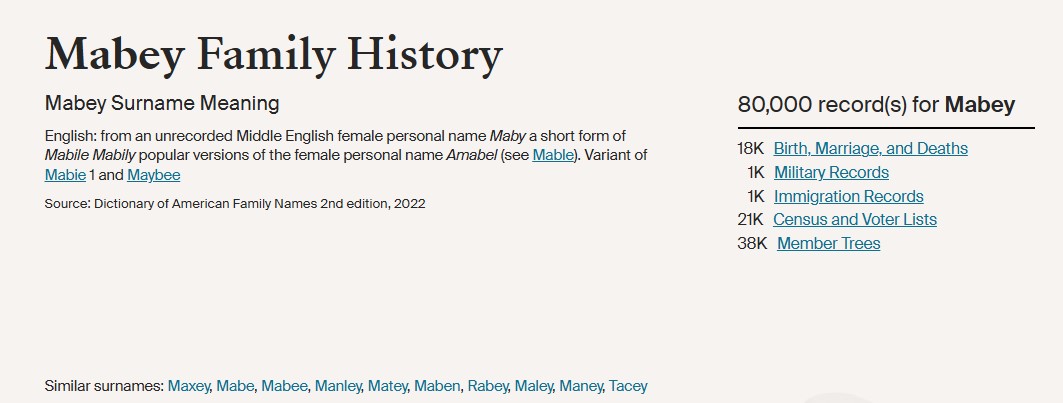
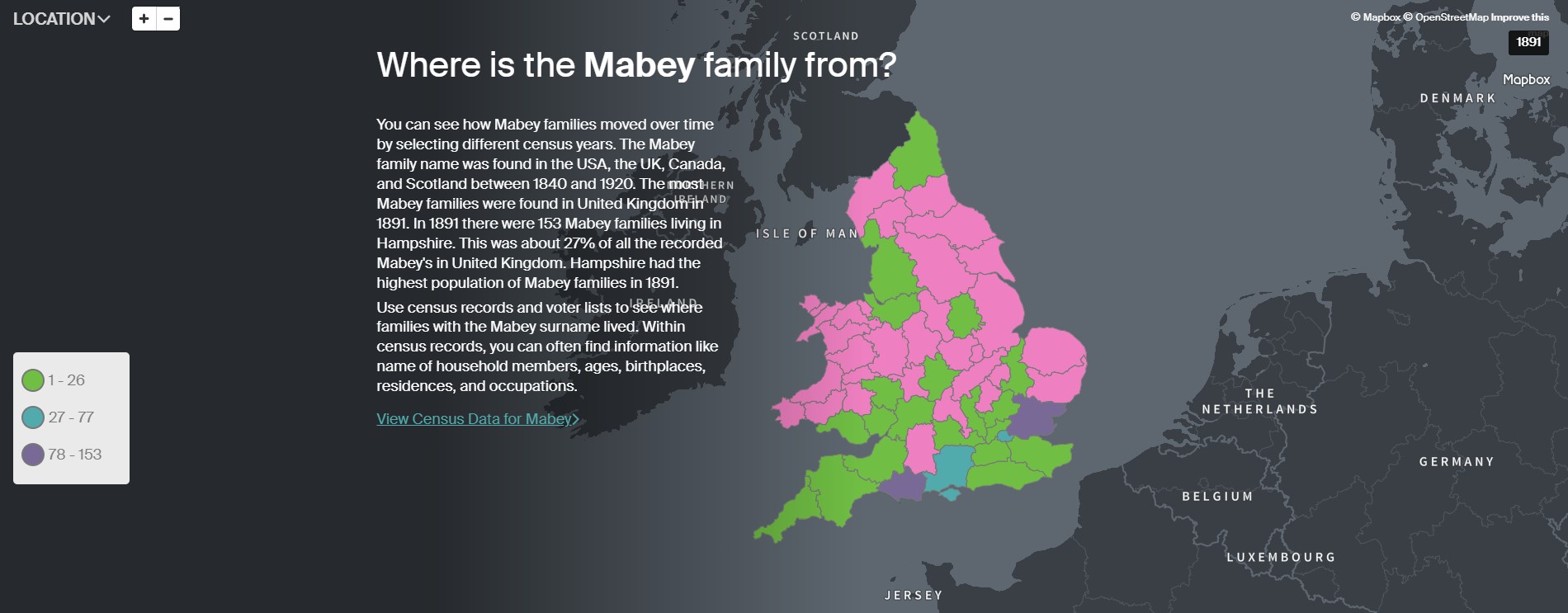
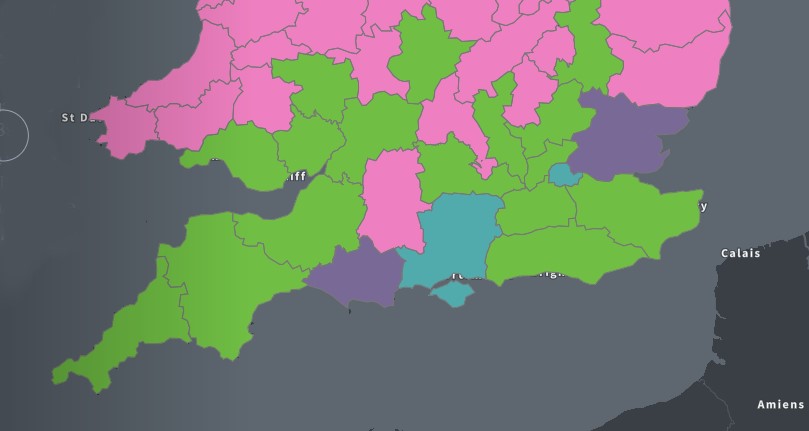
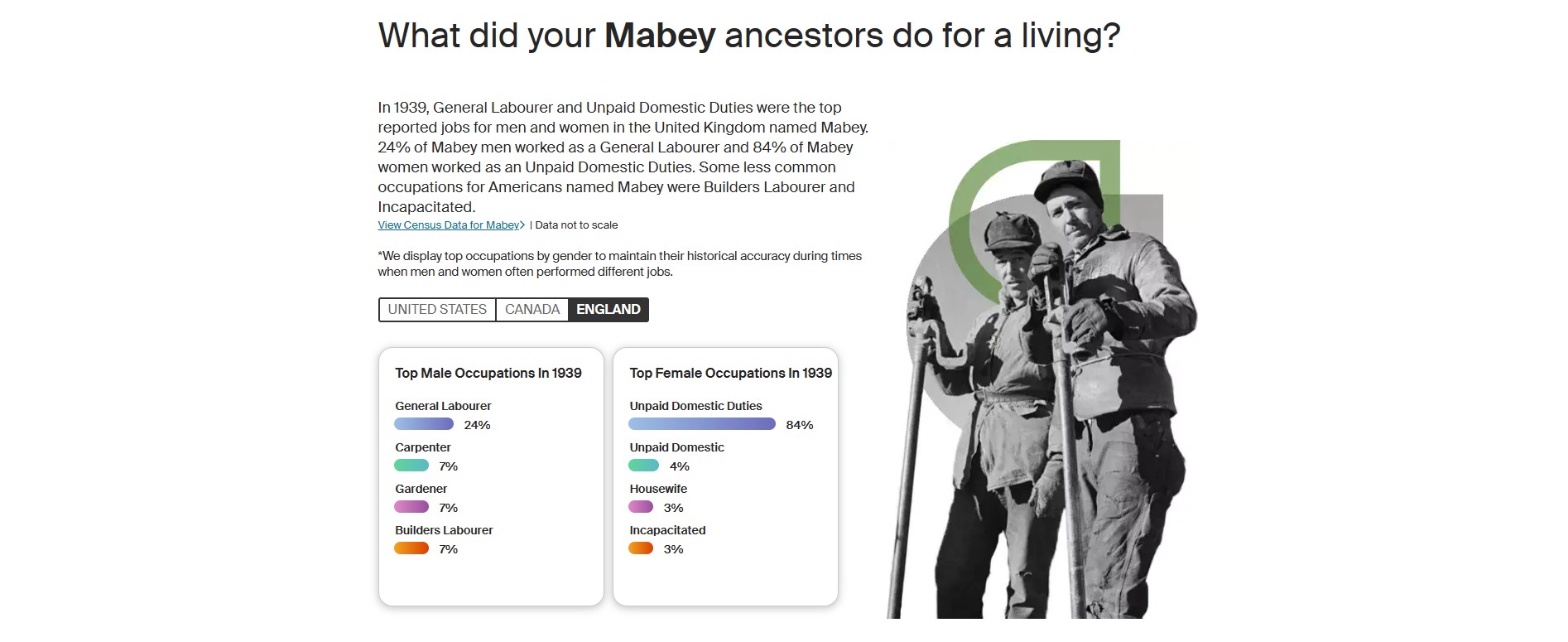
Why do we have Parish Records.
Why do we have Parish Records
Act for the Keeping of Parish Registers 1538
As family historians we own a debt of gratitude to Thomas Cromwell, Lord Privy Seal to Henry VIII and Chief Secretary to the King, for the creation of this act in Henry VIII's 29th year of reign. Without it and the subsequent similar act from Queen Elizabeth in 1558, we would not have such extensive records to assist us in our hobbies or professions.
A good précis of the history is found at Family Search, 'History of Parish Registers in England', reproduced in part below.
Medieval - In medieval times there were no parish registers. For some years before the Reformation, monastic houses (especially the smaller ones) the parish priest had been developing the custom of noting in an album or on the margins of the service books, the births and deaths of the leading local families.
1538 - Through the efforts of Thomas Cromwell a mandate was issued by Henry VIII to keep parish registers. This order that every parson, vicar or curate was to enter in a book every wedding, christening and burial in his parish. The parish was to provide a sure coffer with two locks, the parson having the custody of one key, the wardens the others. The entries were to be made each Sunday after the service in the presence of one of the wardens. The mandate was enforced under a penalty of 3 sols, 4 deniers for the repair' of the church. These entries were made on paper, sometimes upon loose sheets. The bishop in their visitations were to see that the names of sponsors were duly entered in the registers of baptism. The parishioners penalty was divided between the poor box and repairs for the church.
1558 - Queen Elizabeth passed another law that was a duplicate of her father's . Many more registers began at this date. Many of these very early records are hard to read plus being written in Latin and are often very sparse - giving only the fathers name at a Christening and only the persons name in a burial entry. The registers were the property of the incumbent minister and each parish was required to maintain a chest in the parish church for the safe keeping of the same. In time other records were kept in the chest such as poor law records, which were actually the civil parish records. Other records kept in the chest were removal orders, bastardy bonds, overseers of the poor accounts, Tithe award and Maps, Enclosure Awards and Maps, Church Wardens Accounts, etc.
1597 - Registers were to be made of parchment instead of paper, and annual reports of all parish register entries were required to be sent to the appropriate bishop, called Church of England Parish Registers (BT). No doubt the reason we have gaps in some of the early parish registers or they do not exist at all, is that the paper had disintegrated and were not available. In some areas earlier registers were destroyed at this time and some were recopied on parchment.
Some ministers made copies for the Bishop as entries were made in the register, some waited until the end of the year to make these copies. Some entries could have been missed. Most often the original parish entry is more complete.
1598 - The entries that were made on paper, sometimes upon loose sheets, and sixty years later these registers were ordered to be copied upon parchment in books, so that the registers which still survive dating back to 1538-1539 (perhaps about 1400 to 1500 in number). Therefore, any parish which survived this date are rarely the original entries. Some of the earliest paper registers had disappeared even before the transcription was ordered.
1731: 4 George 2 c.26: Proceedings in Courts of Justice Act
1731: 4 George 2 c.26: An act that all proceedings in courts of justice within that part of Great Britain called England, and in the court of exchequer in Scotland, shall be in the English language.
[This extended to Wales by 6 Geo. 2. c.14.]
[After 25 March 1733, all proceedings in courts in England, or exchequer in Scotland, to be in English, and in words at length. 6 Geo. 2. c. 6.]
That from and after the twenty-fifth day of March one thousand seven hundred and thirty-three, all writs, process and returns thereof, and proceedings thereon, and all pleadings, rules, orders, indictments, informations, inquisitions, preferments, verdicts, prohibitions, certificates, and all patents, charters, pardons, commissions, records, judgments, statutes, recognizances, bonds, rolls, entries, fines and recoveries, and all proceedings relating thereunto, and all proceedings of courts leet, courts baron and customary courts, and all copies thereof, and all proceedings whatsoever in any courts of justice within that part of Great Britain called England, and in the court of exchequer in Scotland, and which concern the law and administration of justice, shall be in the English tongue and language only, and not in Latin or French, or any other tongue or language whatsoever, and shall be written in such a common legible hand and character, as the acts of parliament are usually ingrossed in, and the lines and words of the same to be written at least as close as the said acts usually are, and not in any hand commonly called court hand, and in words at length and not abbreviated; any law, custom or usage heretofore to the contrary thereof notwithstanding:
This Act is referred to in S.C. Wilks notes the Nursling Register, but may be incorrectly referenced.
However, English was used in the Parish Registers form this date.
1752 - The Gregorian Calendar was adopted and the first day of the year was changed from March 25th (Ladyday) to January 1st. Up to 1752 use double dating between Jan.1st to Mar. 25th.
1753: 26 George 2 c.33: An Act for the Better Preventing of Clandestine Marriage.
Whereas great Mischiefs and Inconveniencies have arisen from Clandestine Marriages; for preventing thereof for the future, Be it enabled by the King’s most Excellent Majesty, by and with the Advice and Consent of the Lords Spiritual and Temporal, and Commons, in this present Parliament assembled, and by the Authority of the same, That from and after the twenty-fifth Day of March in the Year of our Lord one thousand seven hundred and fifty-four, all Banns of Matrimony shall be published in an audible manner in the Parish Church, or in some publick Chapel, in which publick Chapel Banns of Matrimony have been usually published, of or belonging to such Parish or Chapelry wherein the Persons to be married shall dwell, according to the Form of Words prescribed by the Rubrick prefixed to the Office of Matrimony in the Book of Common Prayer, upon three Sundays preceding the Solemnization of Marriage, during the Time of Morning Service, or of Evening Service (if there be no Morning Service in such Church or Chapel upon any of those Sundays) immediately after the second Lesson: And whensoever it shall happen that the Persons to be married shall dwell in divers Parishes or Chapelries, the Banns shall in like manner be published in the Church or Chapel belonging to such Parish or Chapelry wherein each of the said Persons shall dwell; and where both or either of the Persons to be married shall dwell in any extraparochial Place, (having no Church or Chapel wherein Banns have been usually published) then the Banns shall in like manner be published in the Parish Church or Chapel belonging to some Parish or Chapelry adjoining to such Extraparochial Place: And where Banns shall be published in any Church or Chapel belonging to any Parish adjoining to such Extraparochial Place, the Parson, Vicar, Minister Curate, publishing such Banns shall, in Writing under his Hand, certify the Publication thereof in such manner as if either of the Persons to be married dwelt in such adjoining Parish; and that all other the Rules prescribed by the said Rubrick concerning the Publication of Banns, and the Solemnization of Matrimony, and not hereby altered, shall be duly observed; and that in all Cases where Banns shall have been published, the Marriage shall be solemnized in one of the Parish Churches or Chapels where such Banns have been published, and in no other Place whatsoever.
...
XIV. And for preventing undue Entries and Abuses in Registers of Marriages; Be it enacted by the Authority aforesaid, That on or before the twenty-fifth Day of March in the Year one-thousand seven hundred and fifty-four, and from Time to Time afterwards as there shall be Occasion, the Church-wardens and Chapel-wardens of every Parish or Chapelry shall provide proper Books of Vellum, or good and durable Paper in which all Marriages and Banns of Marriage respectively, there published or solemnized, shall be registered, and every Page thereof shall be marked at the Top, with the Figure of the Number of every such Page, beginning at the second Leaf with Number-one; and every Leaf or Page so numbered, shall be ruled with Lines at proper and equal Distances from each other, or as near as may be; and all Banns and Marriages published or celebrated in any Church or Chapel, or within any such Parish or Chapelry, shall be respectively entered, registered, printed, or written upon or as near as conveniently may be to such ruled Line , and shall be signed by the Parson, Vicar, Minister or Curate, or by some other Person in his Presence and by his Direction; and such Entries shall be made as aforesaid, on or near such Lines in successive Order, where the Paper is not damaged or decayed, by Accident or Length of Time, until a new Book shall be thought proper or necessary to be provided for the same Purposes, and then the Directions aforesaid shall be observed in every such new Book; and all Books provided as aforesaid shall be deemed to belong to every such Parish or Chapel respectively, and shall be carefully kept and preserved for publick Use.
...
XV. And in order to preserve the Evidence of Marriages, and to make the Proof thereof more certain and easy, and for the Direction of Ministers in the Celebration of Marriages and registering thereof, Be it enacted, That from and after the twenty-fifth Day of March in the Year one thousand seven hundred and fifty-four, all Marriages shall be solemnized in the Presence of two or more credible Witnesses, besides the Minister who shall celebrate the same; and that immediately after the Celebration of every Marriage, an Entry thereof shall he made in such Register to be kept as aforesaid ; in which Entry or Register it shall be expressed, That the said Marriage was celebrated by Banns or Licence; and if both or either of the Parties married by Licence, be under Age, with Consent of the Parents or Guardians, as the Case shall be and shall be signed by the Minister with his proper Addition, and also by the Parties married, and attested by such two Witnesses; which Entry shall be made in the Form or to the Effect following; that is to say
A.B. of [the this] Parish
and C.D. of [the this] Parish
were married in this [Church Chapel] by [Banns Licence] with Consent of [Parents Guardians] this Day of in the Year by me J.J. [Rector Vicar Curate]
This Marriage was solemnized between us A.B. C.D. in the Presence of E.F. G.H.
...
etc.
Without these Acts, there would be little to no records upon which to base our research and discovery.
Discovery
Research and discovery starts with trying to establish the parameters for the research.
Extent of Mabey Surname, and variations.
This is part of the process of trying to establish if there is another Mabey family in the area, which could confuse matters. By seeing families in the Baptism Register can help eliminate alternative options for residents in Nursling, Hampshire, of the Church of England. Obliviously this method excludes families without children. It also does not take into account other variables such as change of location. It is just indicative, but helpful.
Baptism Index 1537 -1659
Hampshire Genealogical Society (HGS) Baptism Index 1537 -1659
Filtered for the, All Parishes
Searches for the surnames of Mab, returned 53 results, with one being Maberly, but in Yateley. None of the results were from the Parish of Eling or Nursling.
Filtered for the Parish of Nursling.
Returned nil results with a surname beginning with Mab, and only 13 results beginning with the letter M. None similar to Mabey.

Baptism Index 1660 -1751
Hampshire Genealogical Society (HGS) Baptism Index 1660 -1751
Filtered for the, All Parishes
Searches for the surnames of Mab, returned 17 results.
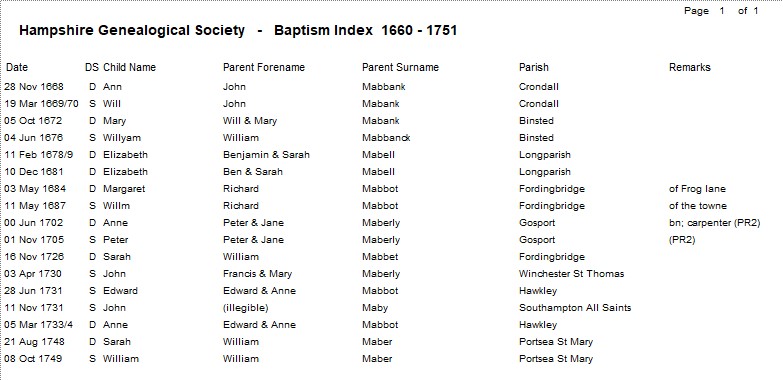
None of the results were from the Parish of Eling or Nursling and the only potential surname was Maby, and possibly Maberly.
Filtered for the Parish of Nursling.
Returned nil results with a surname beginning with Mab, and only 31 results beginning with the letter M.
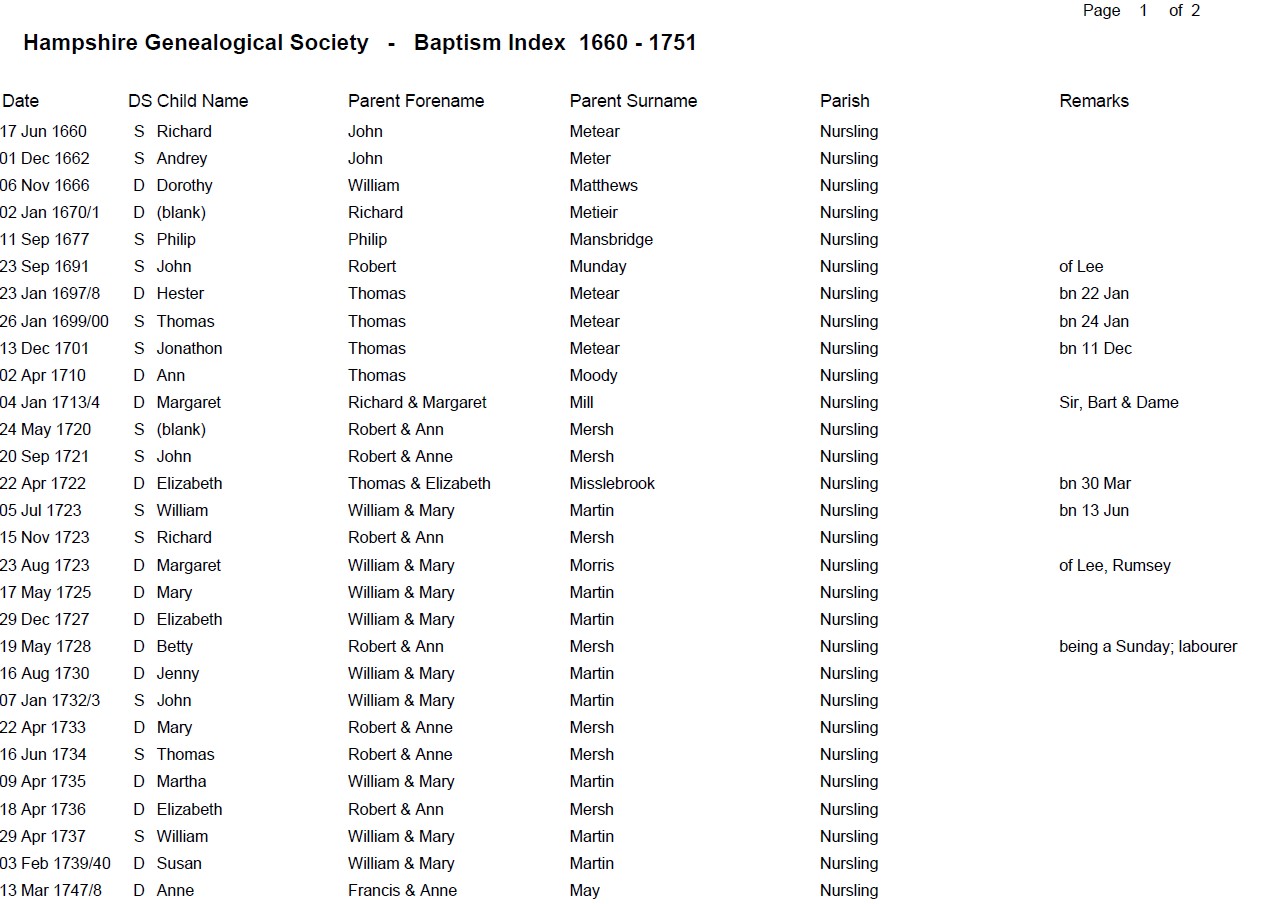
Page 2 of the list gives us information about the Rector. We can add his forename, Edmund, to our list above.

Baptism Index 1752 -1812
Hampshire Genealogical Society (HGS) Baptism Index 1752 -1812
Filtered for surname Mabey.
Some results in this time period.

Parishes in list are Nursling, and Portsea St. Mary's, and Minstead. Families are William blank and William & Jane in Portsea St. Mary's and Jonathan & Jane in Minstead.
Filtered for surname Mabey and Parish Nursling

My current conclusion from the incidences of the Mabey surname is that the William & Ann(e) family of Nursling are the only family of that name in the area and timeframe.
However, it is by no means definitive as changing the match criteria to the loser Soundex, or 'sounds like', reveals a longer list, some of which should also be considered.
Filtered for surname Mabey and All Parishes, but with surname match set for Soundex.
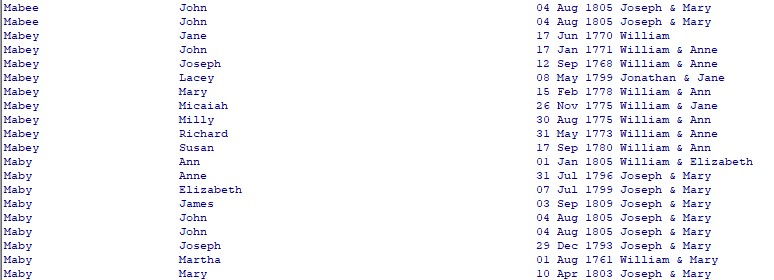
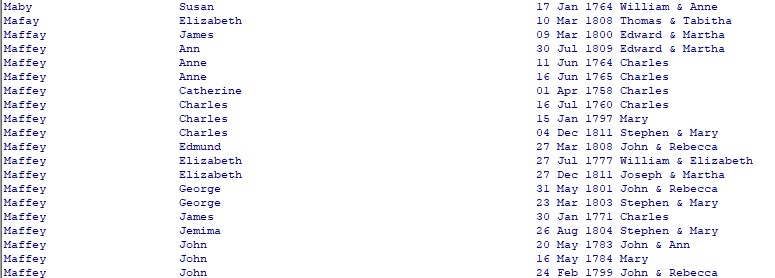

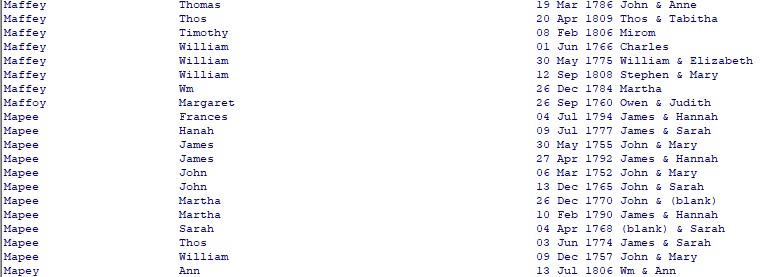
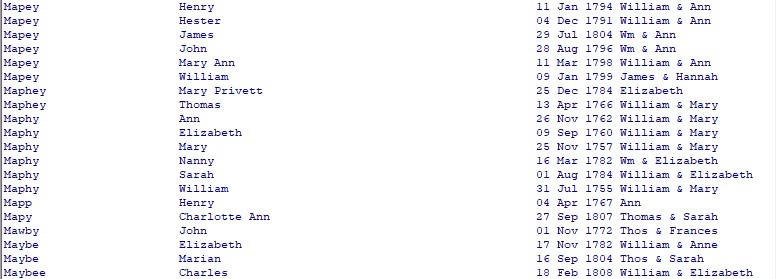
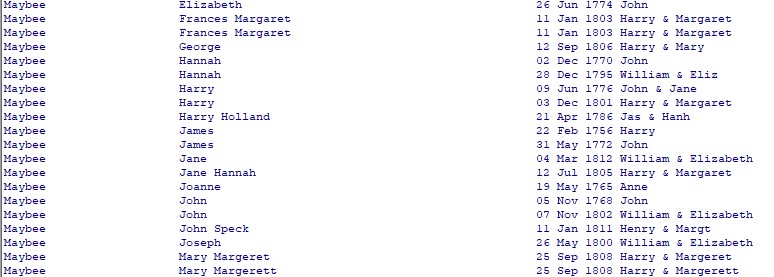
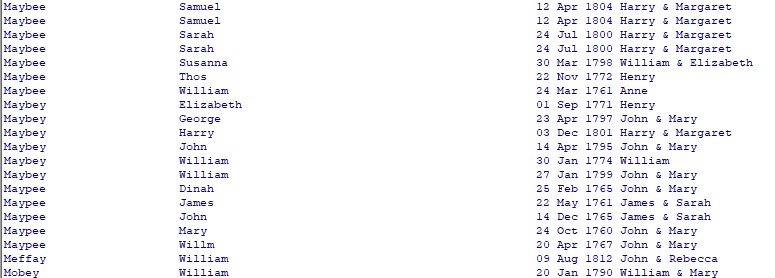

Filtered for surname Mabey and Parish Nursling, but with surname match set for Soundex.
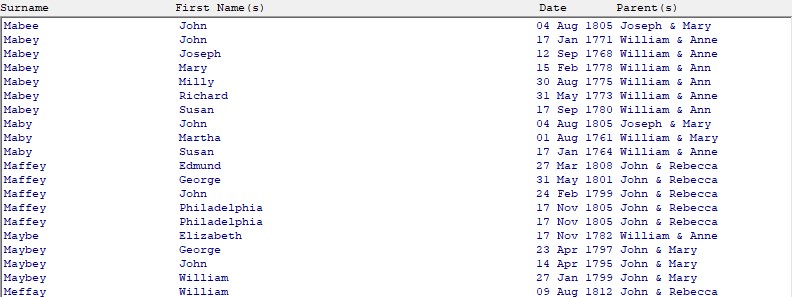
At least one of these should be considered as a possible addition to the family of William and Ann(e) Maybe.
Parish Registers
Moving on from an overview of the Register to a detailed look at the contents, on a journey of discovery for Baptisms, Marriages, and Burials, and perhaps a few other things on the way. Hoping to find validation regarding people in my Ancestry Family Tree, and perhaps some additional information / people.
List of Rectors & Vicars
A spectacular find. Click on image to go to source.
Nursling
Eling
These lists are so helpful. In the past I would look through the Parish Register for information to create a list, or go to some of the sources at the top of the image. This is so much easier, just look the parish up, and there is the list. I recognise some of the names from the Marriage Certificates.
Baptism
Nursling 1617 to 1735
Baptisms in the Nursling Parish Register 1617 to 1735
The first interest in this registry is looking for the Baptism of William Mabey or variations of that spelling. The reason for reviewing these particular years is the Burial record of a William Mayby.
Burials, 1795
April 14 William Mayby aged 63 years
Form his stated age at burial it would suggest a birth of around 1732.
The range of search shown below is 1730 to 1735. Remember that until 1752 the beginning of the New Year was 25 March (Lady Day, the Feast of the Annunciation). This is evident in the pages below.
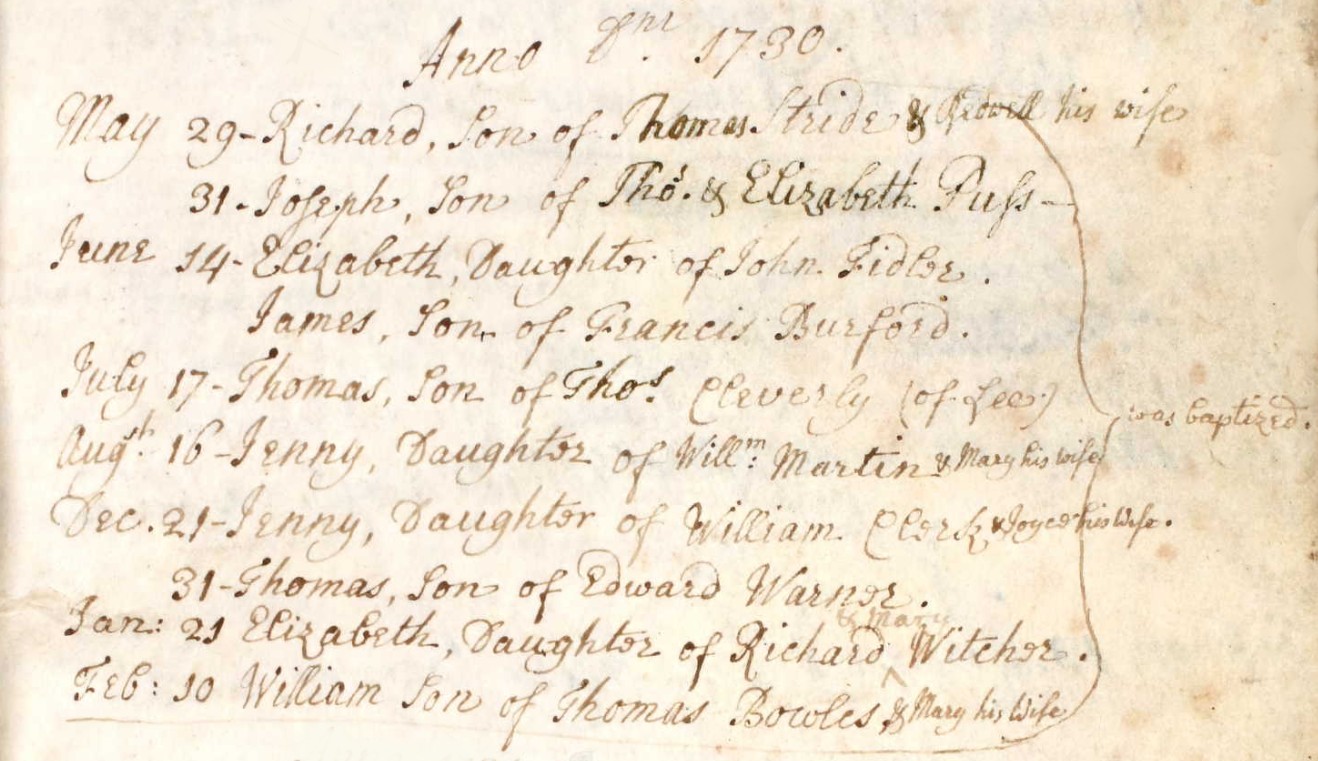
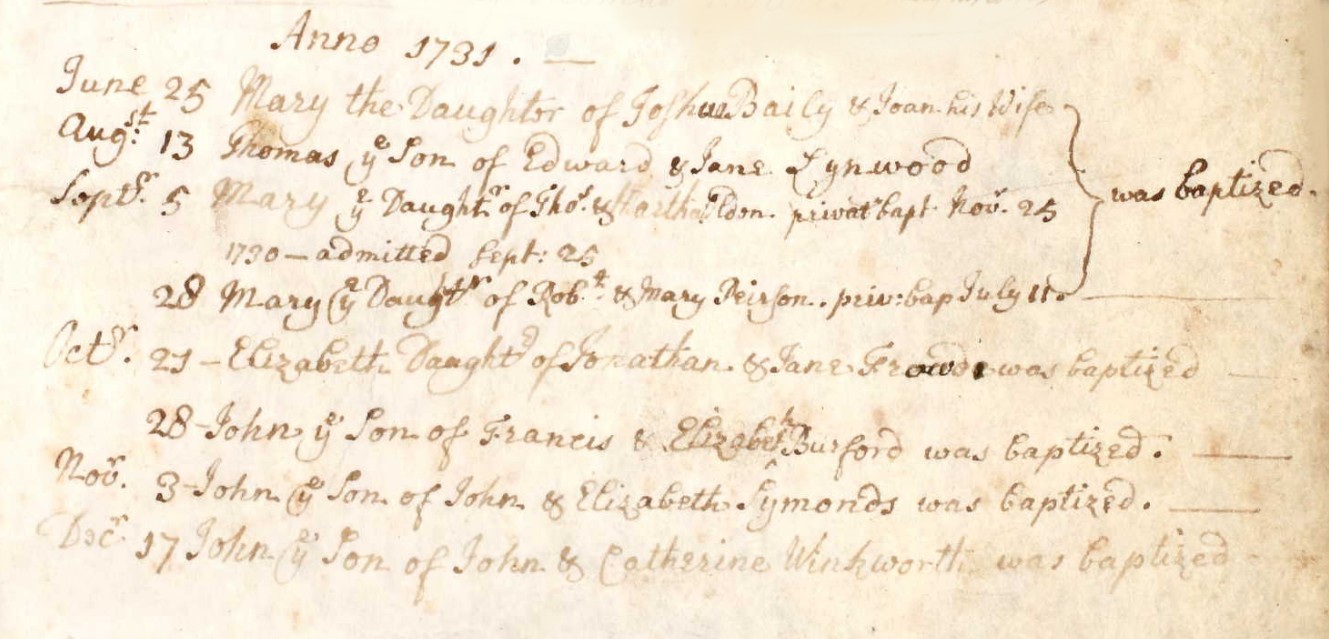
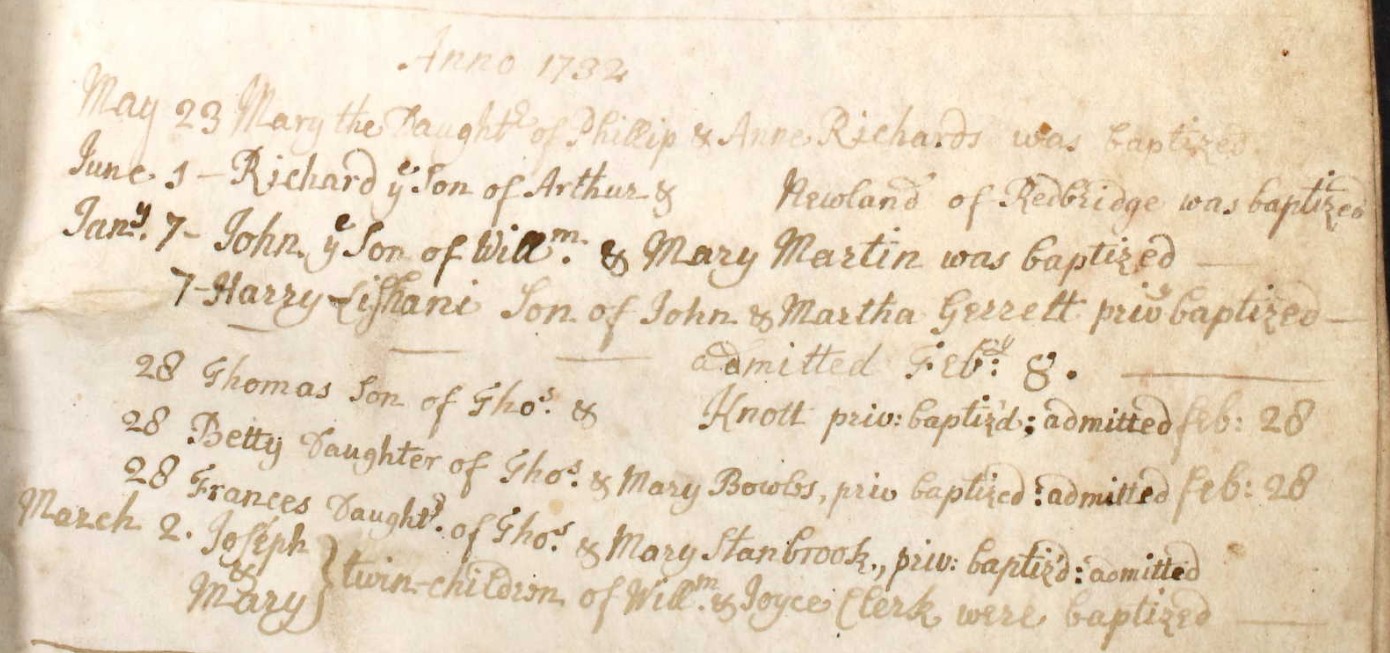

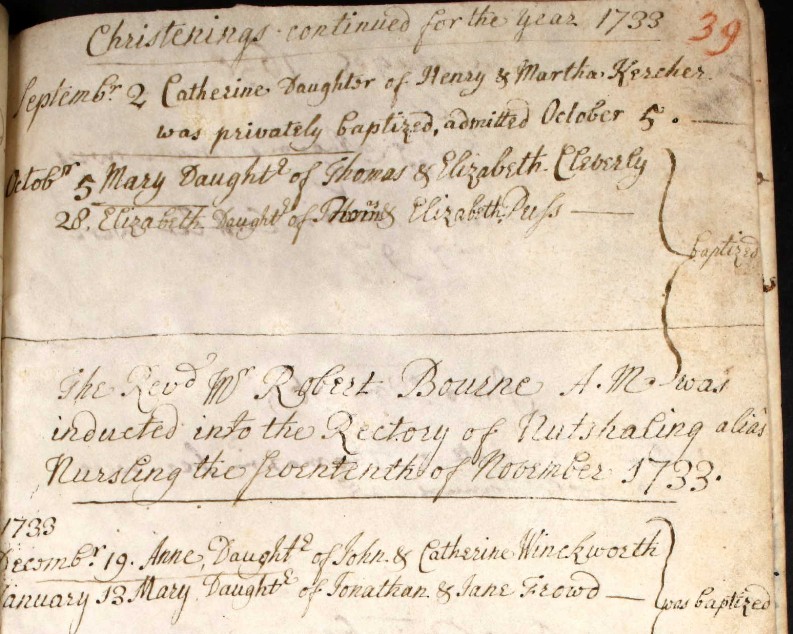
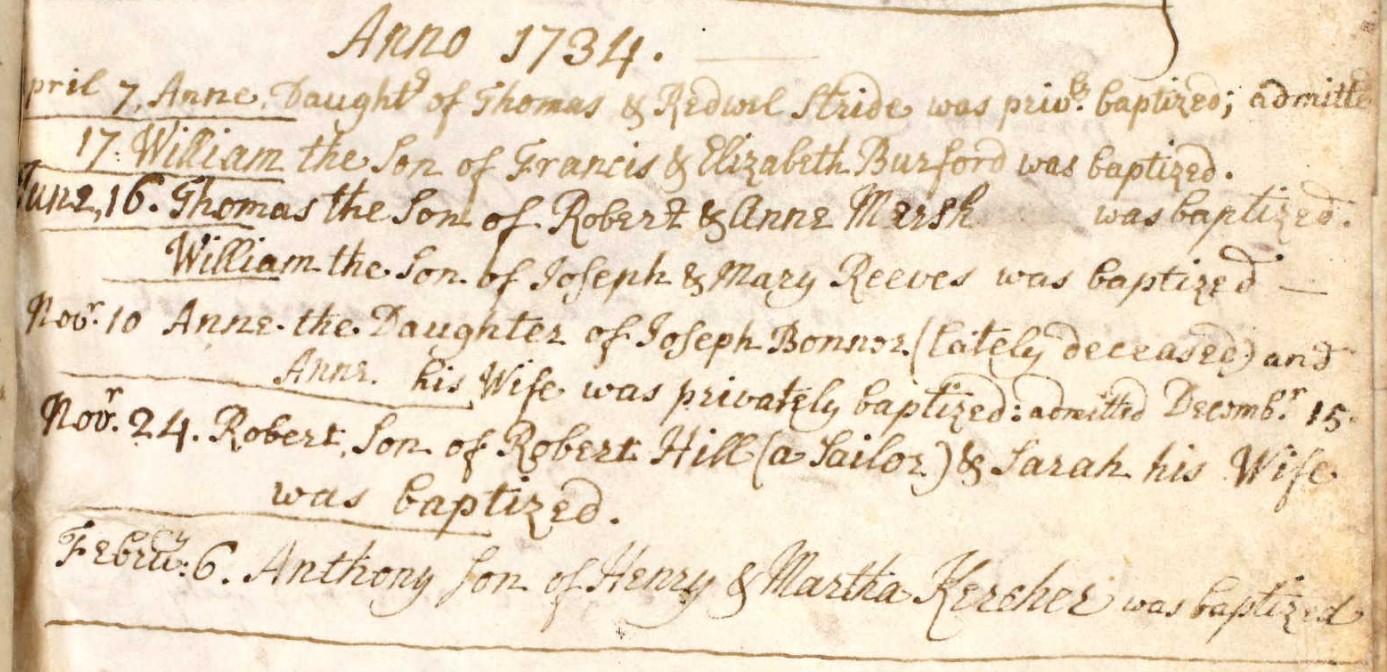
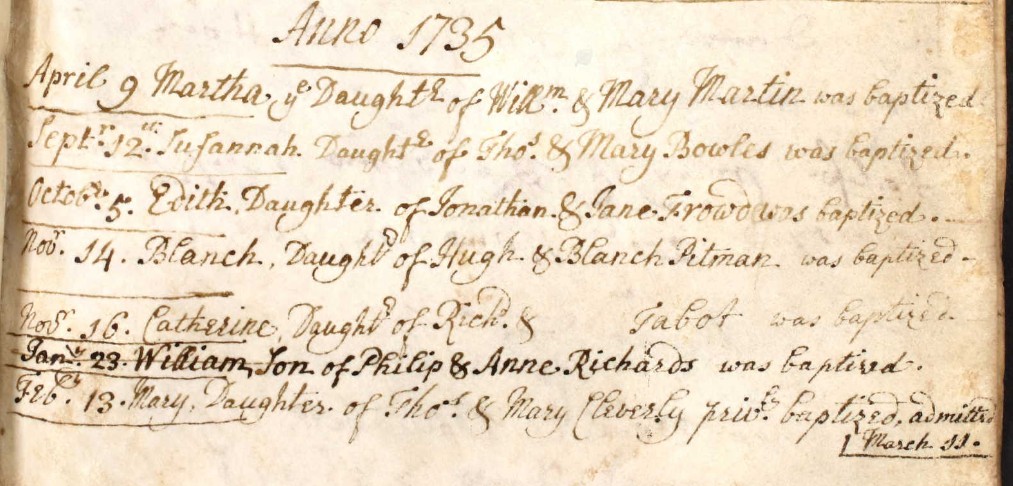
As far as I can see there are only four boys baptised William in the Parish of Nursling between the years 1730 to 1735 inclusive. None of them to a Mabey of similar family.
The search will have to be widened.
Nursling 1736 to 1797
Baptisms in the Nursling Parish Register 1736 to 1797
Baptised at Nursling Parish Church, St Boniface.
Looking in the relevant Parish Registers first, starting with Nursling, Hampshire.
I did a page turn of the Register images looking for any entries with the surname Mabey, aided by the HGS Baptism Index shown above.
Looking through other registers there are a lot of babies privately baptised because they are weak or sick who are taken into the "Congregation of Xt's Flock", "Congregation of Christ's Flock", or "buried on", all in the same entry.
There are a number of recognisable family names within the early pages, which may or may not be related, but it is not until 17?? that I came across the Baptism of a Mabey.
Before listing the finds in the Mabey family, lets look at the Long family.
This is to establish a presence of the Long family in the parish of Nursling, which may help explain the addition of a Mabey family to Nursling parish. Where did William Mabey move from when he married Ann Long in St Boniface Church in Nursling?
Mary, Daughter of Nathaniel & Rebeccah Long
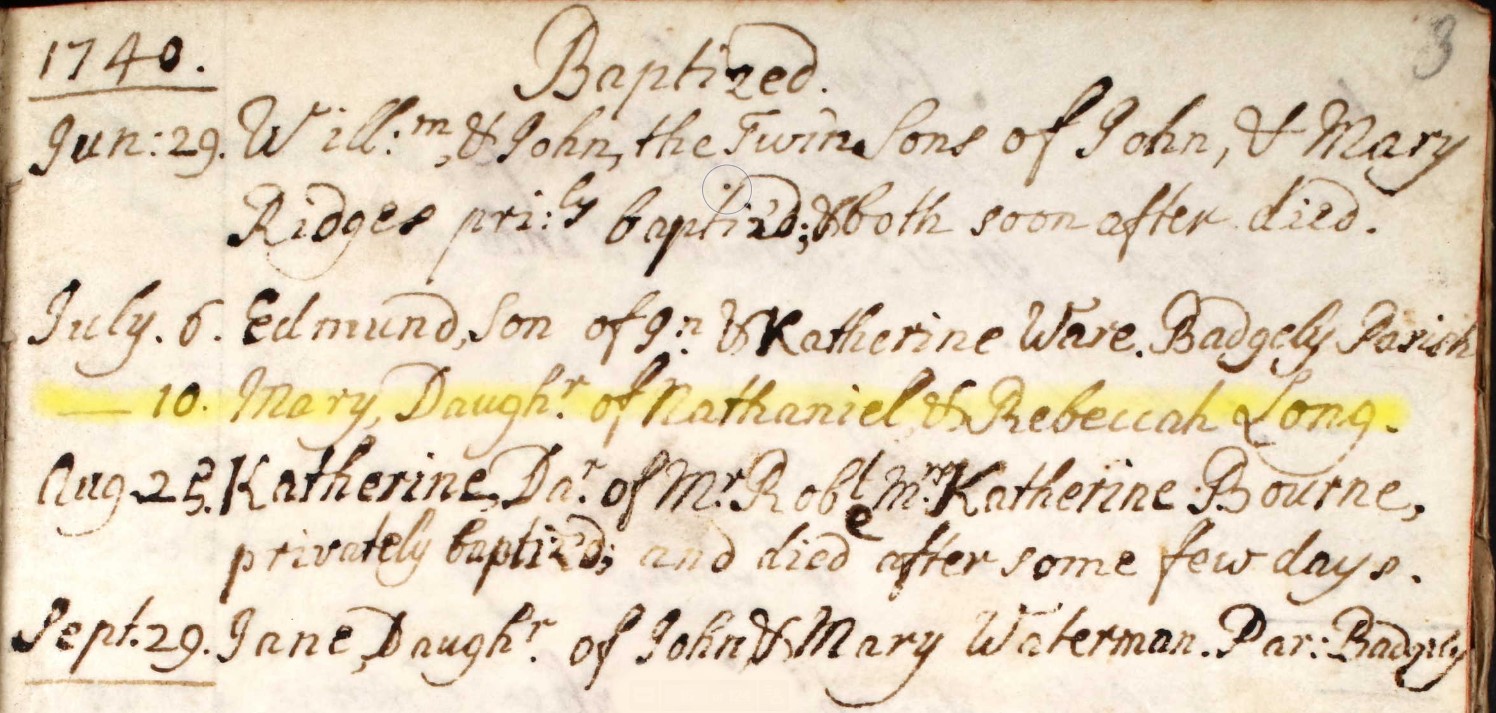
10. Mary, Daughr. of Nathaniel & Rebeccah Long.
July 10, 1740 Mary, Daughter of Nathaniel & Rebeccah Long.
This register only started in 1736 and this is page 3, with the page numbers added later in pencil by S. C. Wilks.
Note two other sad entries on this page, '... privately baptised & both soon after died' and '... privately baptised and died after some few days.' Checks in burials may possibly include the mother. Child birth was a particularly difficult and hazardous event in these times.
Ann, Daughter of Nathaniel & Rebeccah Long
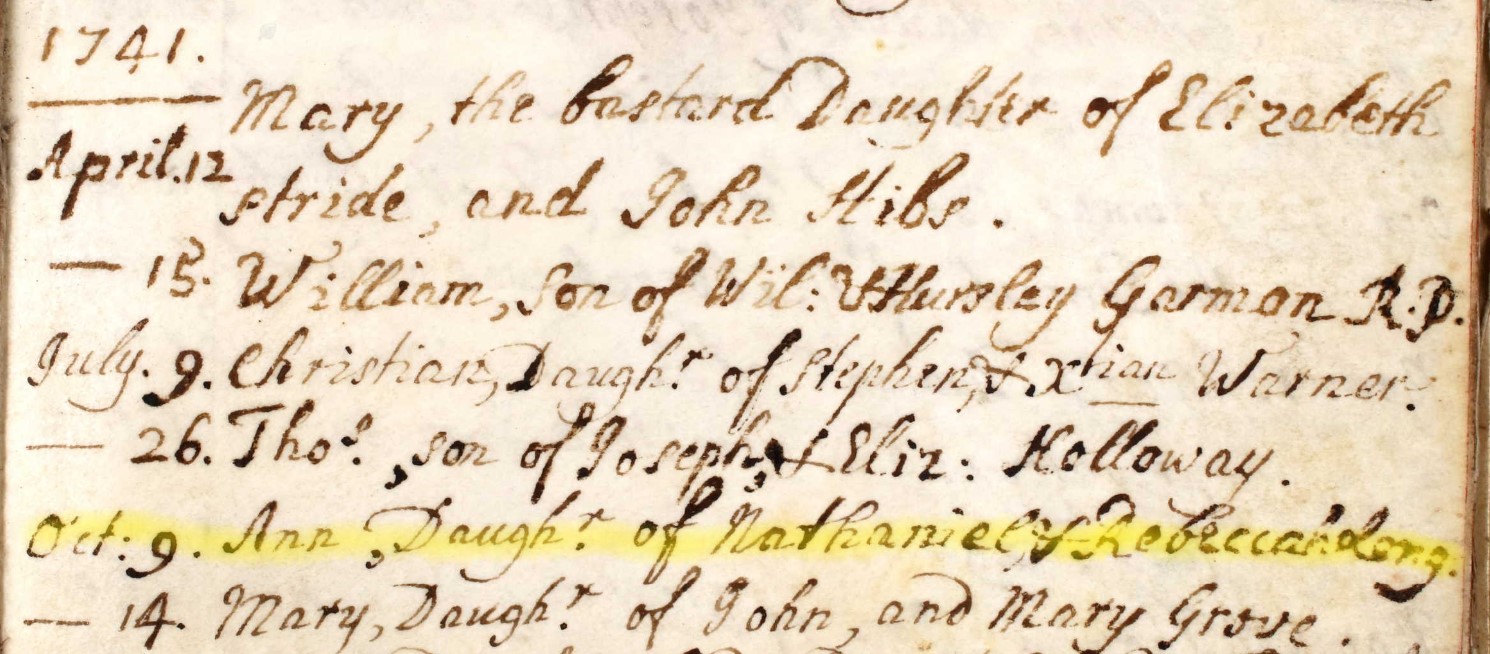
Oct: 9. Ann, Daughr. of Nathaniel & Rebeccah Long.
Oct: 9, 1741. Ann, Daughter of Nathaniel & Rebeccah Long.
Potentially, this Ann Long is the mother of John Mabey. Look to marriages section to find William Mabey married to Ann Long.
Susan, Daughter, of Nathaniel, & Rebeccah Long
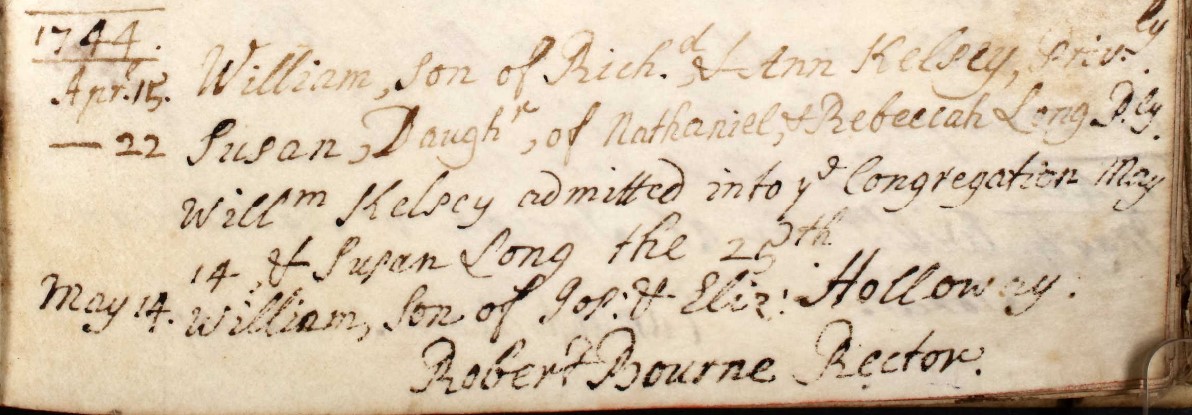
Apr 22 Susan, Daughr, of Nathaniel, & Rebeccah Long P.ly
Willm Kelsey admitted into ye Congregation May 14, & Susan Long the 25th
Apr 22 1744 Susan, Daughter, of Nathaniel, & Rebeccah Long Baptised Privately. William Kelsey admitted into the Congregation May 14, & Susan Long the May 25th
Again, not a Mabey for this baptism record. However, it is another Long, the significance of which will hopefully become apparent later. Also it is an example of Baptised Privately and subsequently admitted into the Congregation / Church.
Nathan, Richard, & Phebe Sons and Daughter of Nathan & Rebecca Long
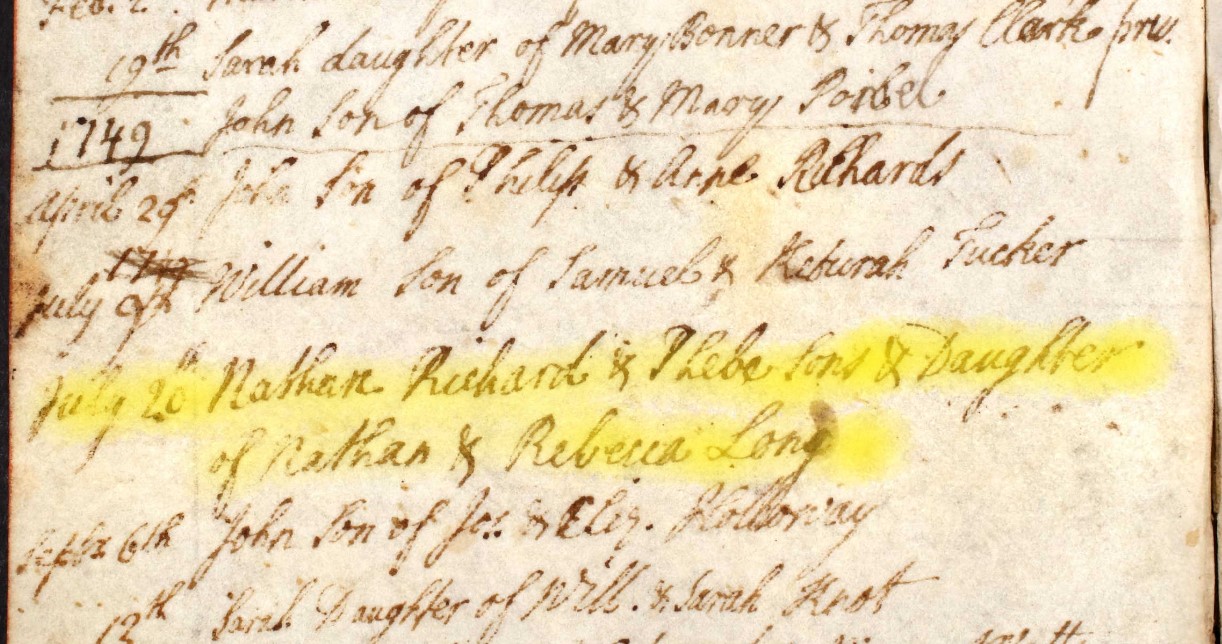
July 20 Nathan Richard & Phebe Sons and Daughter of Nathan & Rebecca Long
July 20 1749 Nathan, Richard, & Phebe Sons and Daughter of Nathan & Rebecca Long
A job lot? Susan Long, above, was Baptised on Apr 22 1744, approximately 5 years before this Baptism. Which is sufficient time for 3 separate pregnancies giving rise to 3 children being baptised at the same time. It could be triplets, or twins and a single, but the is sufficient time interval for it to be three individual births between 1745 and 1749.
John Son of Nathan & Rebecca Long
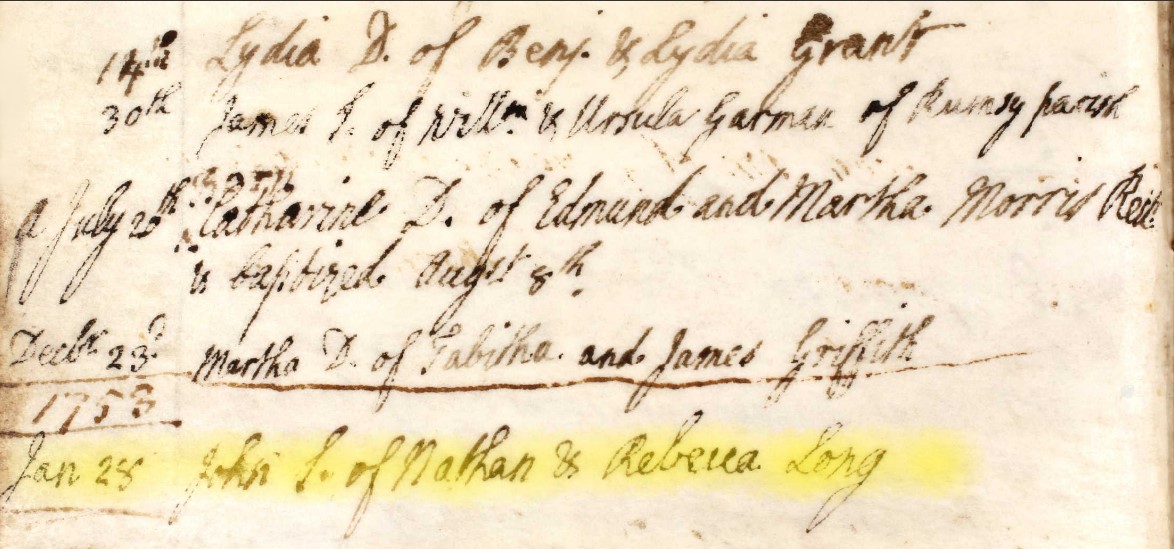
Jan 28 John S. of Nathan & Rebecca Long
Jan 28 1758 John Son of Nathan & Rebecca Long
On this page there is also the baptism of Catharine, daughter of Edmund and Martha Morris, the Rector of this parish, and his wife.
| Baptism date | Child name | S/D | Parents |
|---|---|---|---|
| July 10, 1740 | Mary Long | D | Nathaniel & Rebeccah Long. |
| Oct: 9, 1741 | Ann Long | D | Nathaniel & Rebeccah Long. |
| Apr 22, 1744 | Susan Long | D | Nathaniel, & Rebeccah Long |
| July 20, 1749 | Nathan Long | S | Nathan & Rebecca Long |
| July 20, 1749 | Richard Long | S | Nathan & Rebecca Long |
| July 20, 1749 | Phebe Long | D | Nathan & Rebecca Long |
| Jan 28 1758 | John Long | S | Nathan & Rebecca Long |
Seven children in 18 years, is not implausible, nor is the gaps between them, albeit three baptised at the same time. I have given those three estimated years of birth between 1745 and 1749. However, is this one family or two. Parents are Nathaniel, & Rebeccah Long until 1744 and then at the next baptism, in 1749, they are Nathan & Rebecca Long. Very similar names, but are the people one in the same? On the basis of probability, I will go with the thought that it is all one family, but I accept that is not definitive.
I think there is sufficient evidence to confirm that there is an established presence of a Long family in the Parish of Nursling.
Now on to the Mabey surname.
Martha Daughter of William & Mary Maby
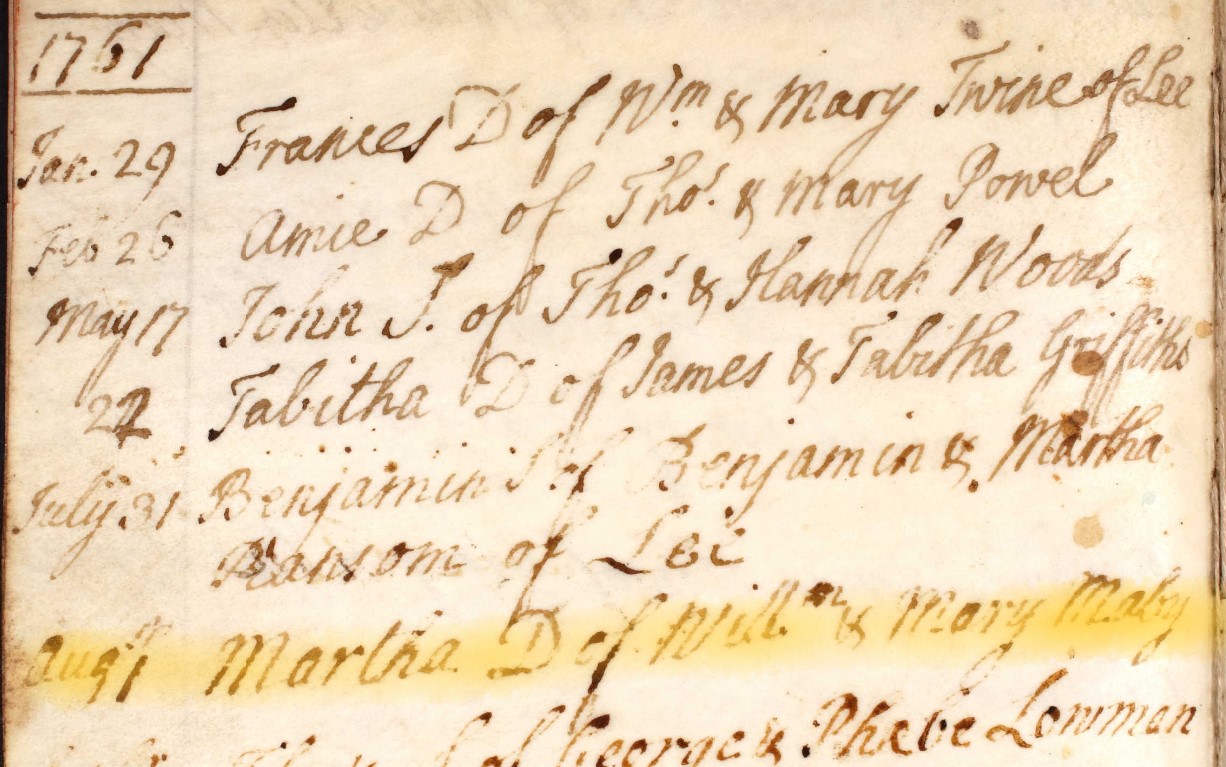
Aug 1 Martha D of Willm & Mary Maby
Aug 1, 1761 Martha Daughter of William & Mary Maby
Maby is not Mabey but is similar.
William Mabey and Ann Long were married at St Boniface Church, Nursling, Hampshire on 29 October 1760. So 1st August 1761 is a respectable date of first born after marriage.
However, who is Mary? William married Ann, not Mary. Is Mary an alternative name for Ann, such as Mary Ann, or Ann Mary. Not according to the baptism record.
Susan Daughter of William & Anne Maby
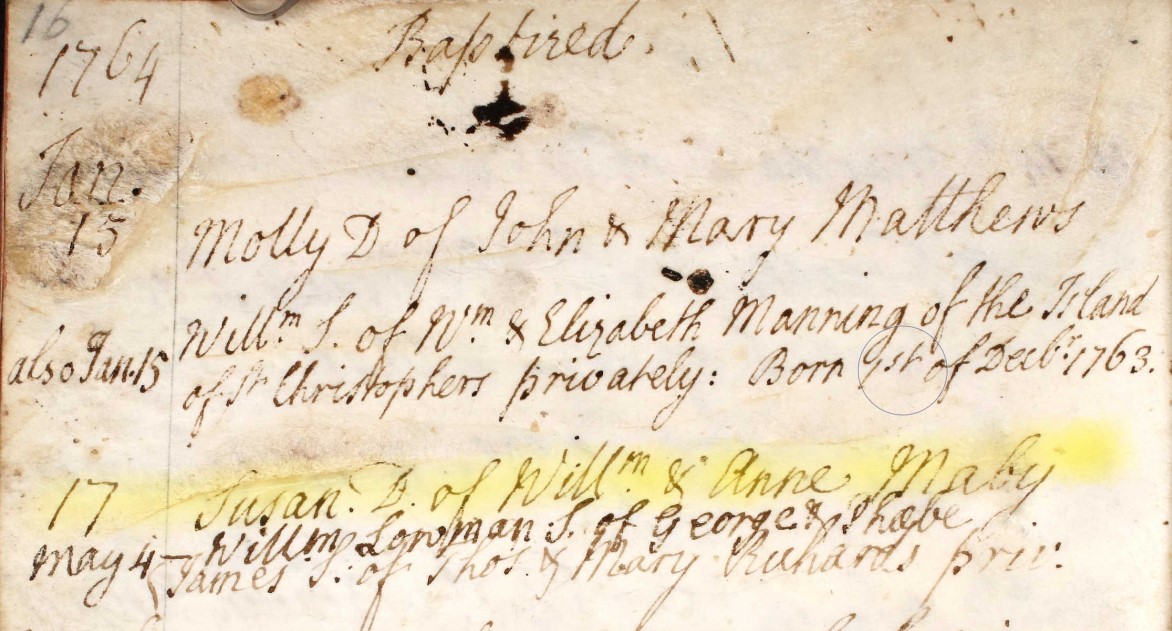
May 4 Susan. D. of Willm & Anne Maby
May 4, 1764 Susan Daughter of William & Anne Maby
Again, Maby is not Mabey but is similar.
At least the parents are the expected William and Ann.
1768
Ann Daughter of James Penny
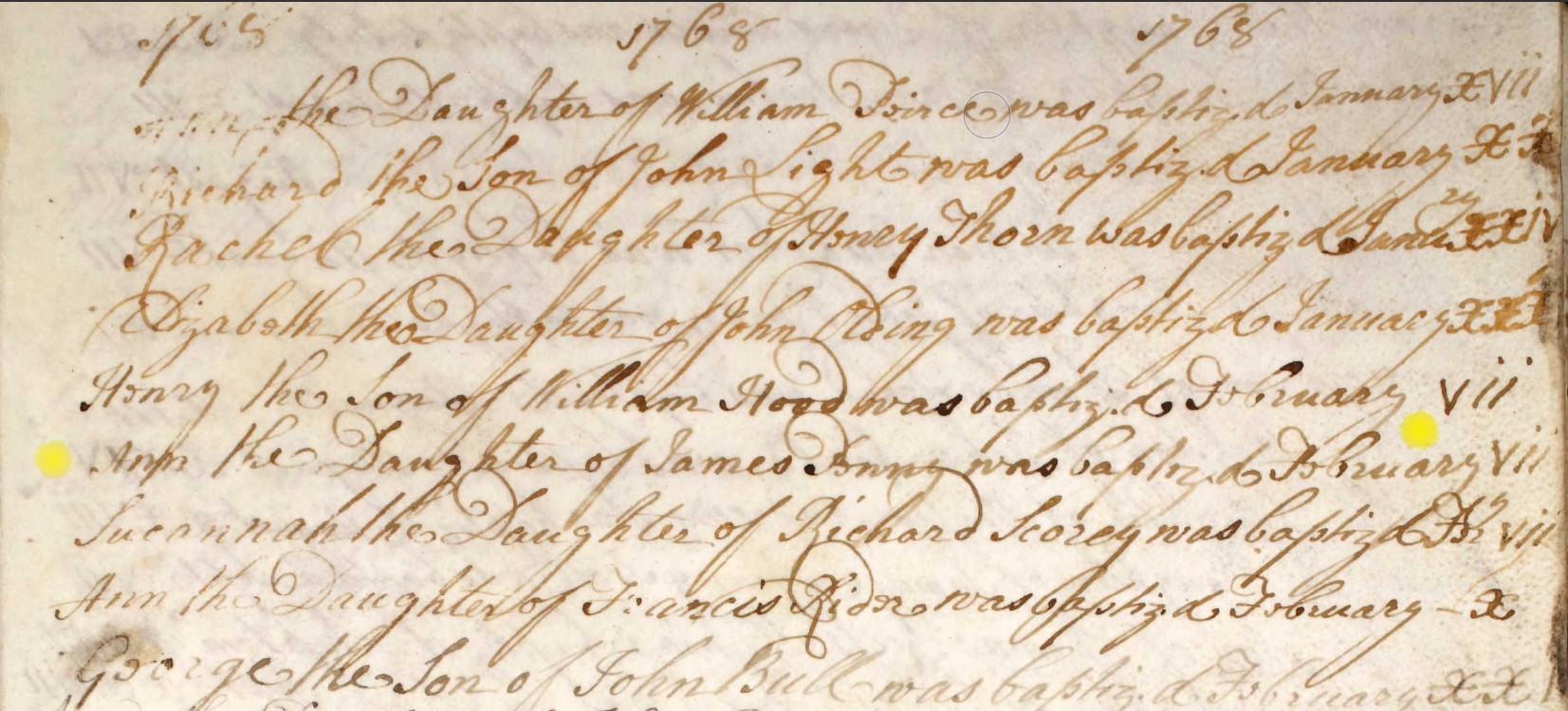
Ann the Daughter of James Penny was baptised February vii - 7th Feb 1768, was baptised at St Boniface Church Nursling.
1768
Joseph Son of William & Anne Mabey
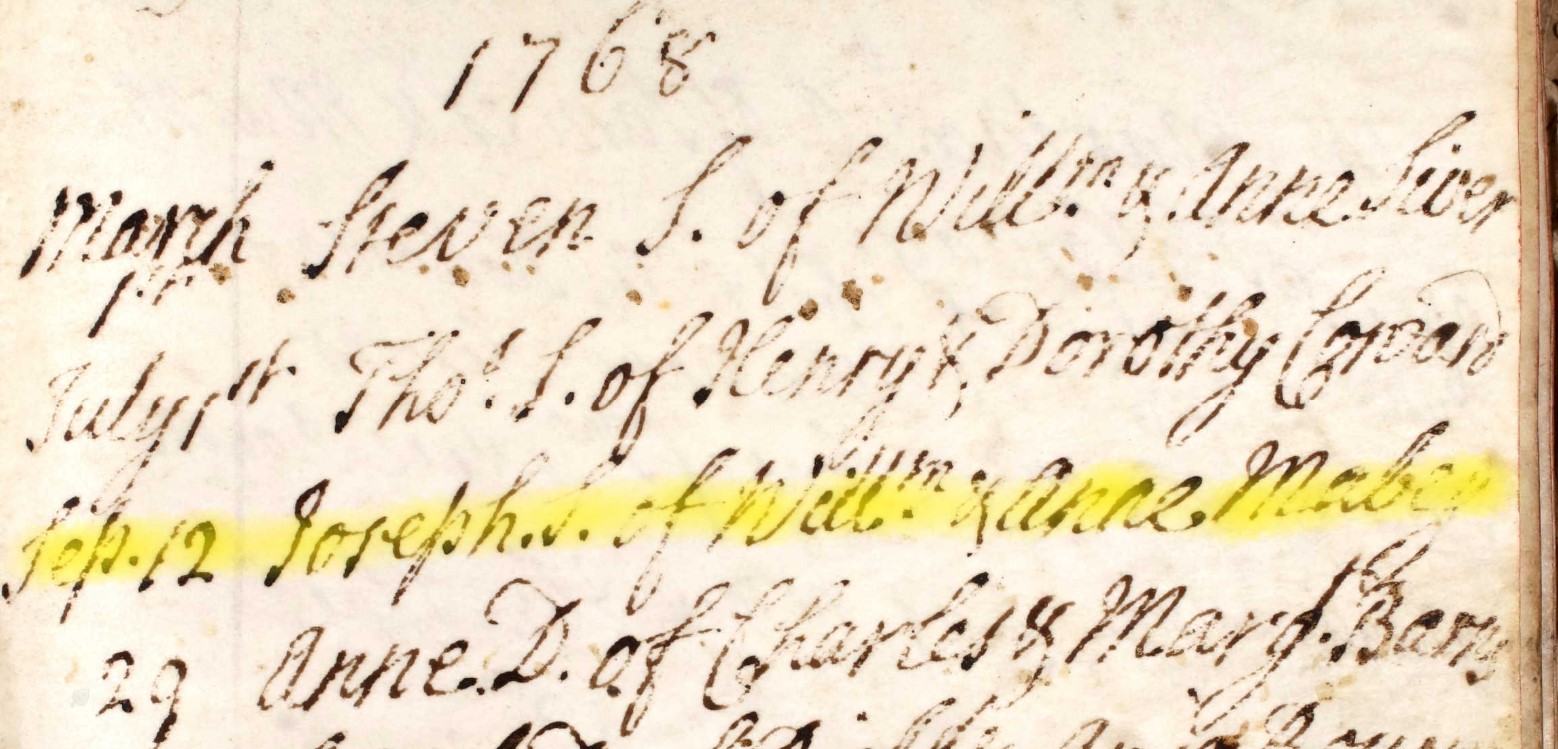
Sep 12 Joseph. S, of Willm. & Anne Mabey
Sep 12, 1768, Joseph Son of William & Anne Mabey.
1771
John Son of William & Anne Mabey
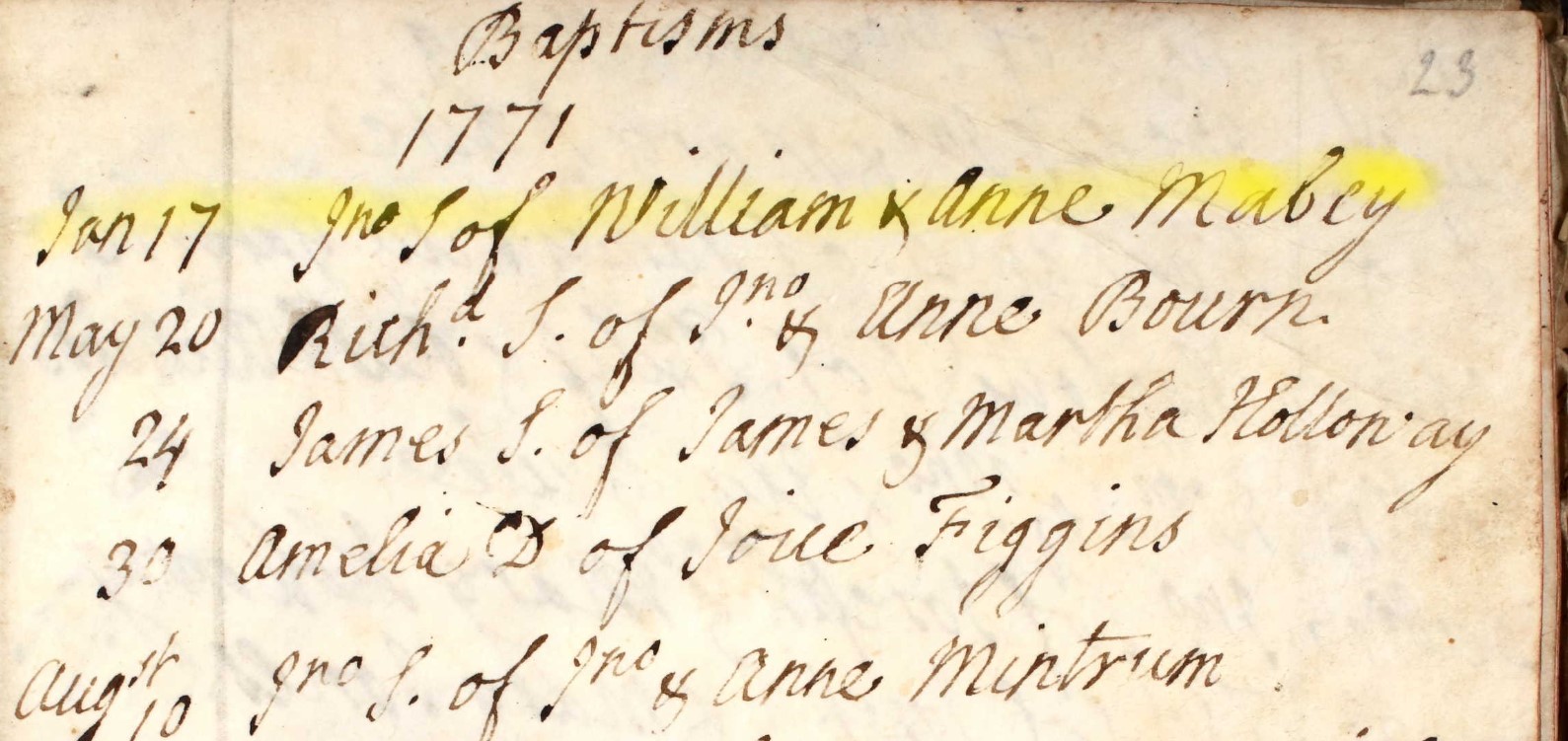
Jan 17 Jno S of William & Anne Mabey
Jan 17, 1771 John Son of William & Anne Mabey
1773
Richard Son of William & Anne Mabey
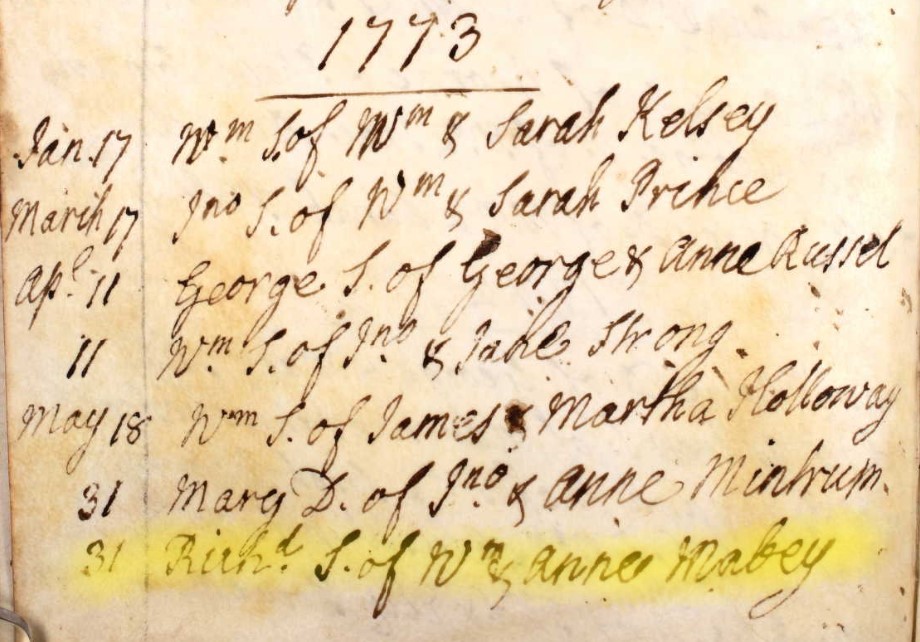
May 31 Richd S. of Wm & Anne Mabey
May 31, 1773 Richard Son of William & Anne Mabey
1775
John, Son of John & Sarah Penny
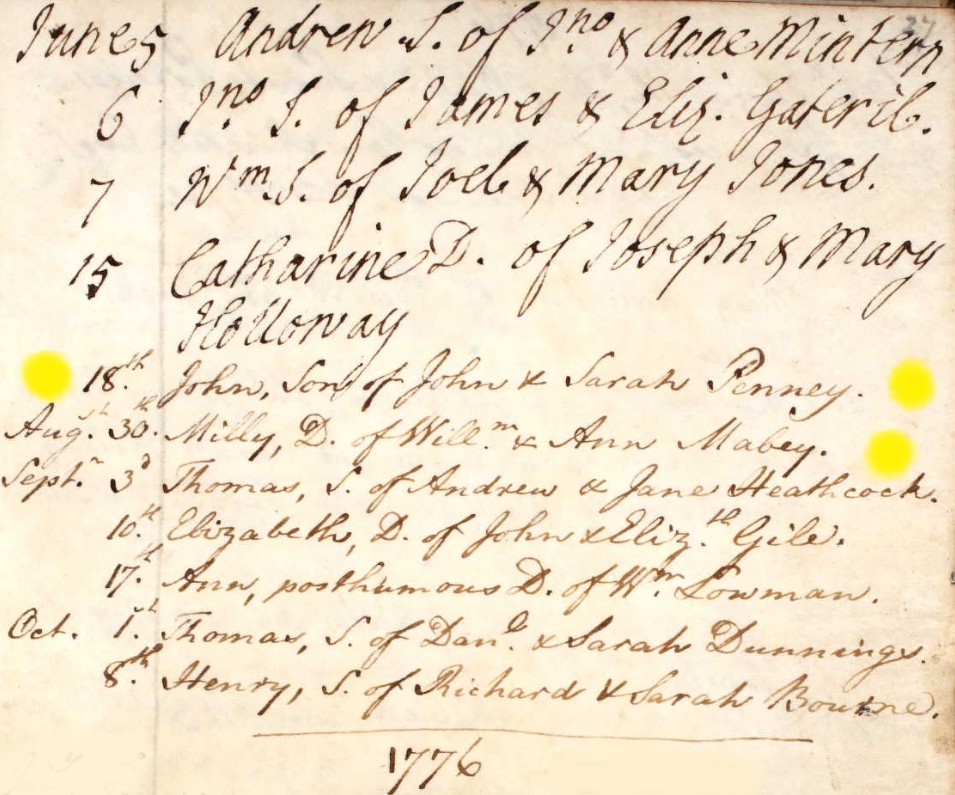
I have copied both pages of the register for 1775 here, looking for John Penny. For the whole year of 1775 there are only two baptisms with male names beginning with J,
June 6 Jno S. of James & Eliz. Gateril
June 18th John, Son of John & Sarah Penny
The next record is Milly, shown below
1775
Milly Daughter of William & Ann Mabey
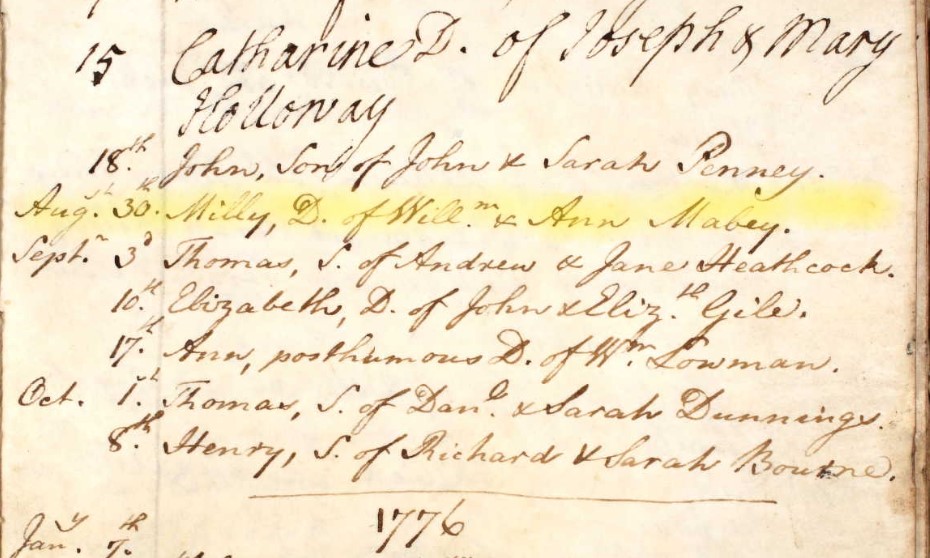
Aug 30 Milly, D. of Willm & Ann Mabey
Aug 30, 1775 Milly Daughter of William & Ann Mabey
1778
Mary Daughter of William and Ann Mabey
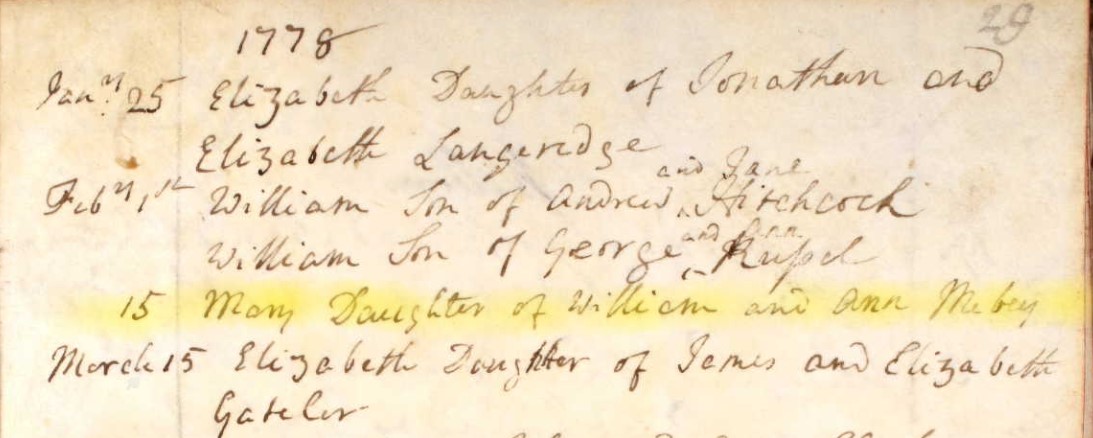
Feb 15 Mary Daughter of William and Ann Mabey
Feb 15, 1778 Mary Daughter of William and Ann Mabey
1780
Susan Daughter of William & Ann Mabey
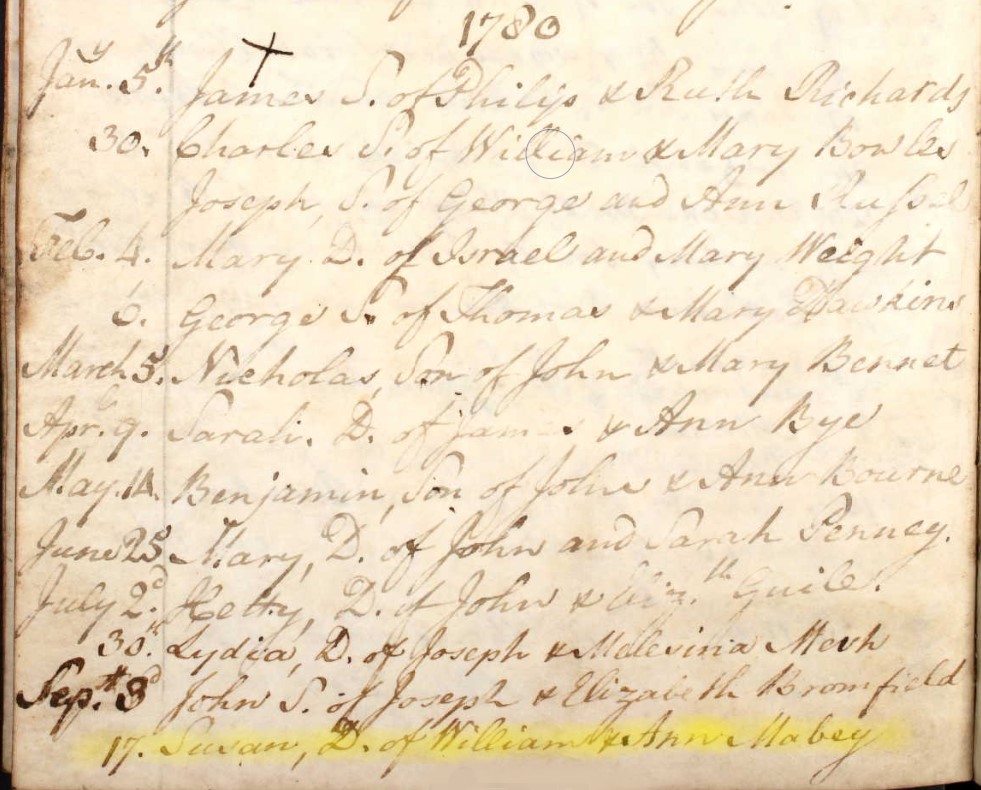
Sep 17 Susan, D. of William & Ann Mabey
Sep 17, 1780 Susan Daughter of William & Ann Mabey
Second use of the name Susan in this family, which implies the first Susan died before this year.
1782
Elizabeth Daughter of William & Anne Maybe
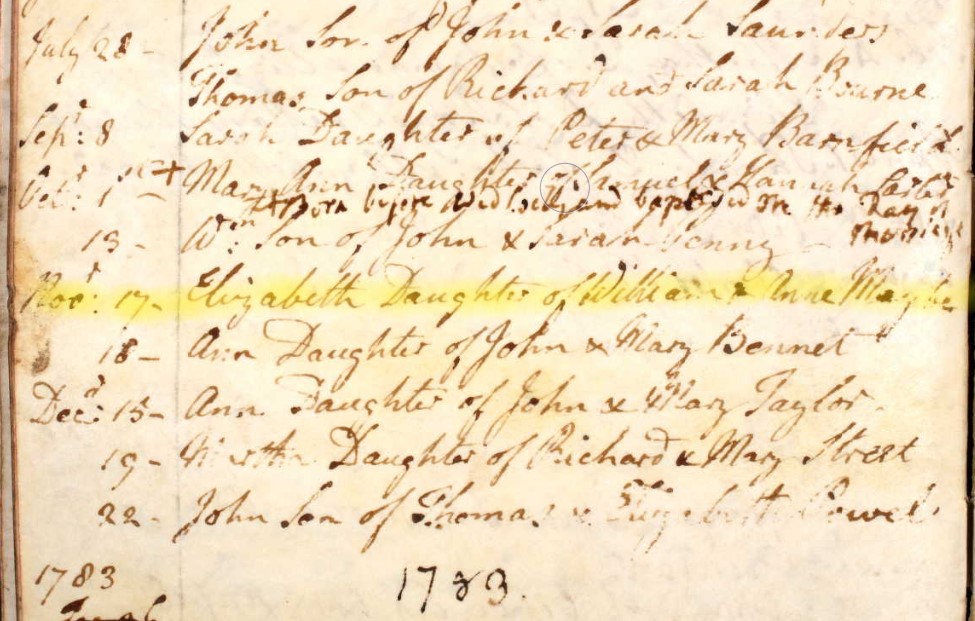
Novr 17. Elizabeth Daughter of William & Anne Maybe
Nov 17, 1782 Elizabeth Daughter of William & Anne Maybe
Note surname written as Maybe not Mabey. Assumed to be the same family.

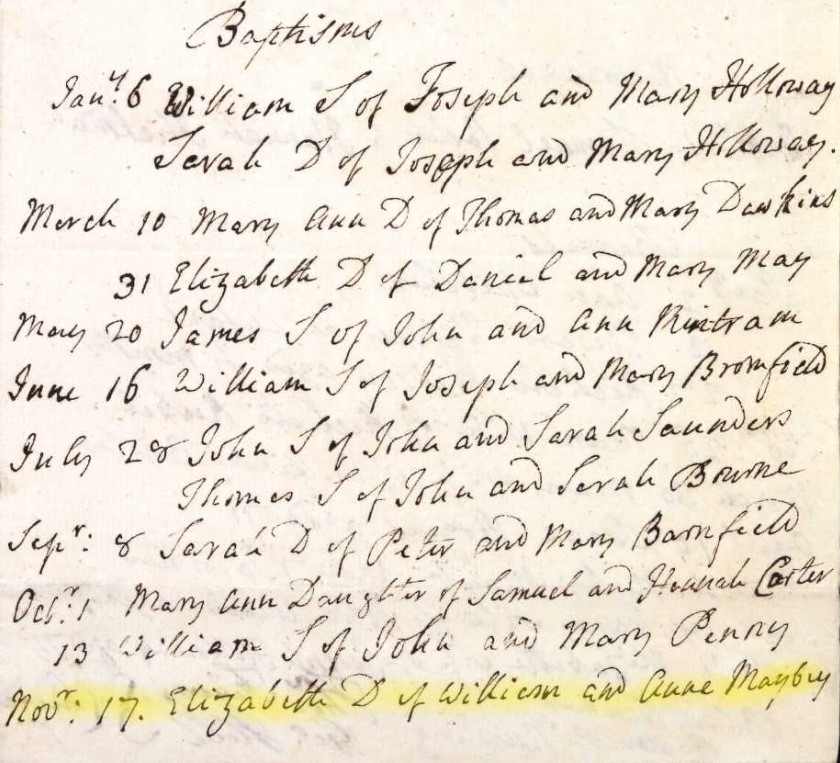
Another copy within the same Register, fortunately with the same information.
Charlotte Mabey
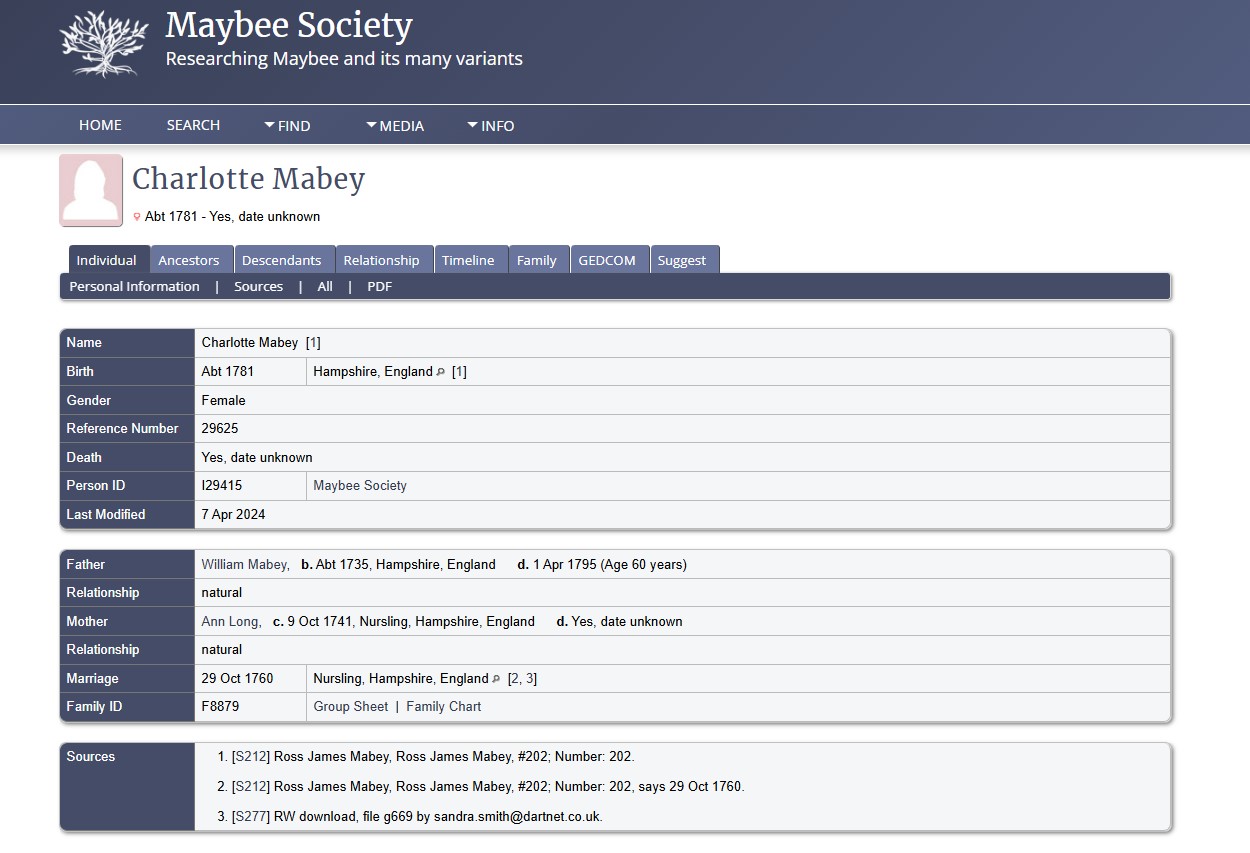
The above is a extract from the Maybee Society regarding Charlotte Mabey b. 1781.
However, so far, I have not found any primary data in respect of Charlotte.
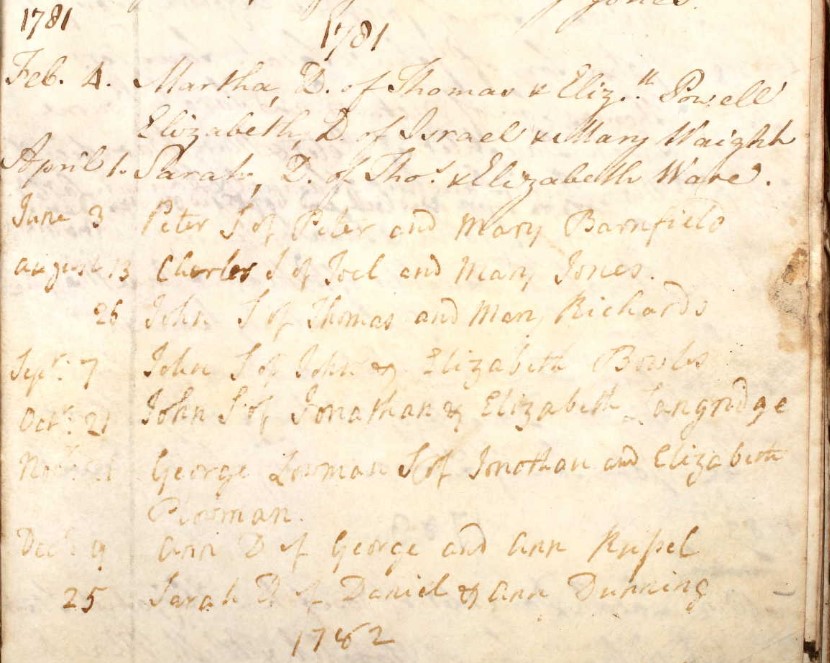
The above is the page for the Parish of Nursling Register in the Baptised section, for 1781. There is no entry for a Charlotte on this page.
The Hampshire Genealogical Society (HGS) Baptism Index 1752 -1812 did not reveal any potential matches, across Hampshire.
The last entry for Baptisms in this section of the Registry is page 36 for the year 1787. No Mabey family found from Elizabeth in 1782 to 1787.
1797
George Son of John & Mary Maybey
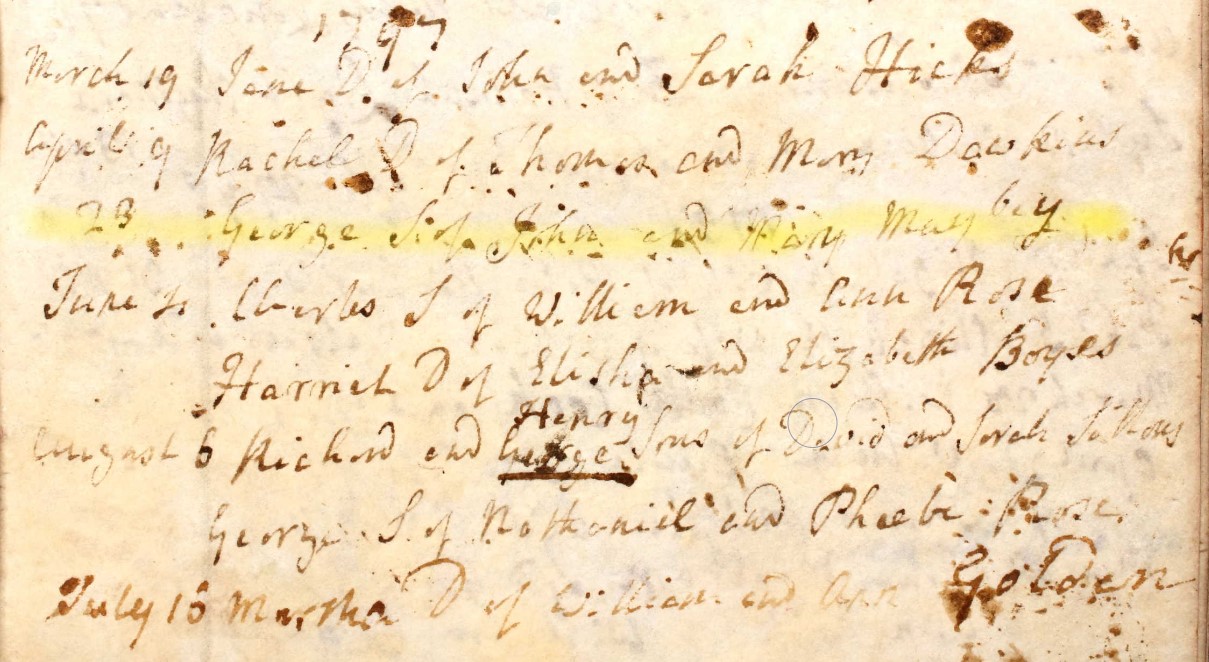
April 23 George S. of John & Mary Maybey
Apr 23, 1797 George Son of John & Mary Maybey
| Baptism date | Child name | S/D | Parents |
|---|---|---|---|
| Aug 1, 1761 | Martha Maby | D | William & Mary Maby |
| Abt. 1762 | William Mabey | S | |
| Abt. 1781 | Charlotte Mabey | D | |
| Apr 23, 1797 | George Maybey | S | John & Mary Maybey |
The three people above are thought to be part of the family according to other Ancestry trees, however, they are not yet proved from the baptism records found so far. The fourth is possibly a grandchild.
| Baptism date | Child name | S/D | Parents |
|---|---|---|---|
| May 4, 1764 | Susan Maby | D | William & Anne Maby |
| Sep 12, 1768 | Joseph Mabey | S | William & Anne Mabey |
| Jan 17 1771 | John Mabey | S | William & Anne Mabey |
| May 31, 1773 | Richard Mabey | S | William & Anne Mabey |
| Aug 30, 1775 | Milly Mabey | D | William & Ann Mabey |
| Feb 15, 1778 | Mary Mabey | D | William and Ann Mabey |
| Sep 17, 1780 | Susan Mabey | D | William & Ann Mabey |
| Nov 17, 1782 | Elizabeth Maybe | D | William & Anne Maybe |
Eight children in 18 years, is not implausible. Even eleven, adding the uncertain children, is still plausible both in terms of elapsed date and separation of dates.
Jump back to top of Parish Records tabs
Nursling 1798 to 1812
Baptisms in the Nursling Parish Register 1798 to 1812
Baptised at Nursling Parish Church, St Boniface.
Jump back to top of Parish Records tabs
Jump back to top of Parish Records tabs
Eling 1672 to 1749
Baptisms in the Eling Parish Register 1672 to 1749
Baptised at Eling Parish Church, St Mary the Virgin, aka St Mary's Church.
Following a similar search in the Nursling Parish Register, without result, it is time to turn attention to the Parish of Eling, Hampshire. General searches of numerous datasets of Parish Records and Bishop's Transcripts have not reveled suitable matches. This could be because of errors in transcription, the variable nature of spelling at the time, or the state of the records, missing or difficult to render a reliable transcription.
The reason for looking in Eling next is some information about his father from Rodney Whale.
Notes: William MABY-245
General: This spelling was as baptised.
Was living in Botley, Hants and moved to Eling. He was examined by the Overseers of the Poor and because he had no settlement certificate he was returned to Botley. However a year later he returned to Eling bearing the certificate and was allowed to settle.
His origins are obscure but he was almost certainly from Dorset. He appears in Swanage for a short while, where his first child was baptised in 1726 and his first wife was buried there in 1731. There is a marriage of a Bernard Mabey in Swanage around this time and he may have been William's brother particularly as William named a son as Bernard.
This information was added to in September 2010 by virtue of his baptism being discovered.
The settlement certificate for Botley is dated 19091738 and one of the Overseers of the poor was Jacob Emery, an ancestor of Beryl Whale nee Sharp.
The Removal Order mentioned was dated 03021737.
The first interest in this Eling registry is looking for the Baptism of William Mabey or variations of that spelling. The reason for reviewing these particular years is the Burial record of a William Mayby.
Burials, 1795
April 14 William Mayby aged 63 years
Form his stated age at burial it would suggest a birth of around 1732.
The range of search shown below is 1730 to 1735. Remember that until 1752 the beginning of the New Year was 25 March (Lady Day, the Feast of the Annunciation). This is evident in the pages below.
1730
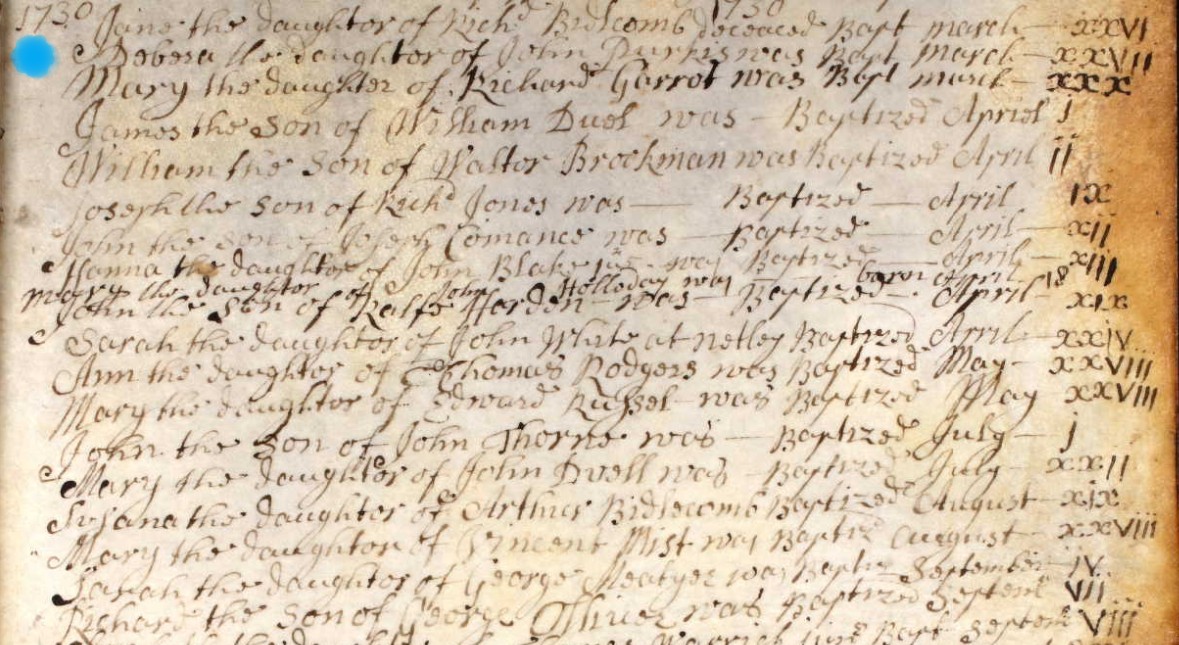
Following the location of three relevant baptisms, I am reviewing these images again looking for the shape of the surname.
The last line but one reveals:-
Sarah the daughter of George Meabyee was Baptised September iv. Baptised 4th September 1730 in St. Mary the Virgin Church, Eling.
However, an alternative direction of travel is a Marriage Certificate for a Sarah Meatyar.
Not here, but on my work in progress tree, I have added George Meabyee, annotated hypothesis, as a brother of William Mabey, b. 1705, the father of William Mabey b. 1734, the person whose Baptism record we are searching for.

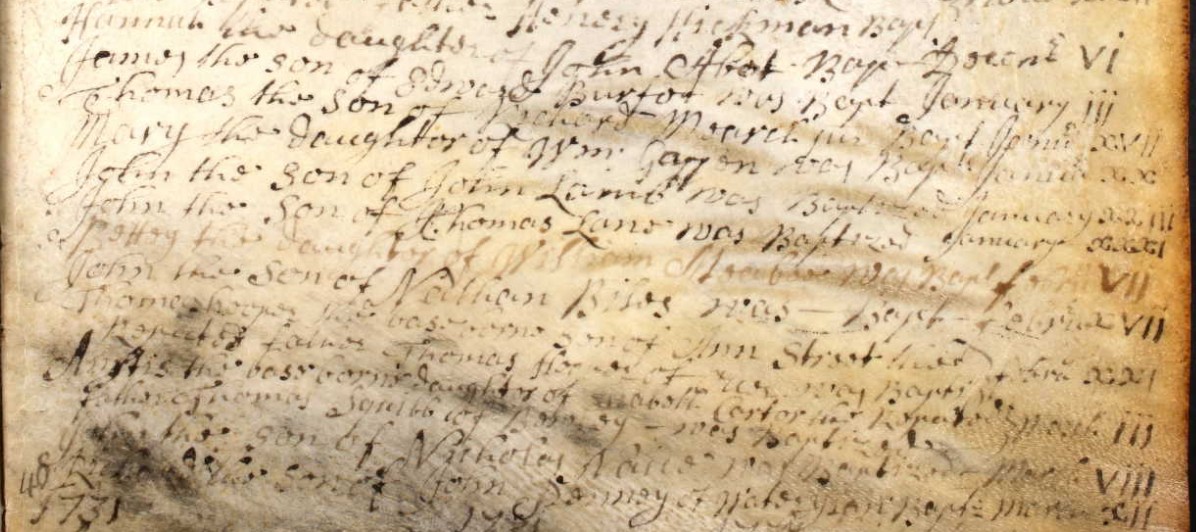
I have split the page into three parts to ensure that the writing is large enough for you to be able to read it, and find something that I have missed. There will therefore be some duplication at the joints.
You can see that there are a lot more baptisms in a year than in Nursling, as to be expected, Eling is larger both by area and population.
As you can see, the page gets very difficult to read towards the bottom. I can fully understand why this was not transcribed, as that would produce unreliable data.
However, I believe I can make out enough to search for a name of William for the baptised person, and an M for the beginning of the father's surname.
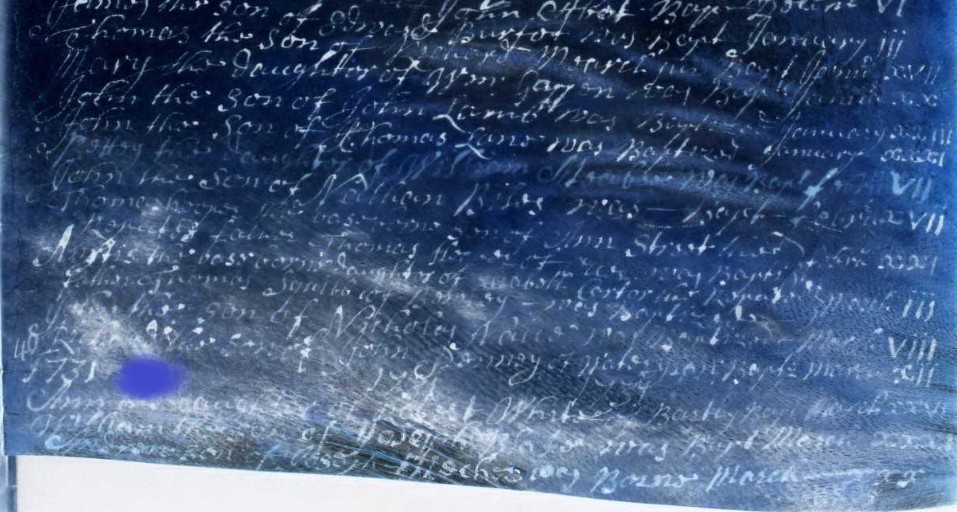
Fortunately, Ancestry, as well as some other sites, has the ability to invert the colours of the image, in the tools section. Sometimes this can make the image more legible. Not always sufficient to transcribe though, and I doubt the original transcribers had this technique available to them.
1731

Below, the sixth record from the top reveals:-
Andrew the Son of Joseph Meabyee was Baptised April vii. Baptised 7th April 1731 in St. Mary the Virgin Church, Eling.
However, an alternative direction of travel is a Marriage Certificate for a Sarah Meatyar, but no similar alternative for Andrew.
Not here, but on my work in progress tree, I have added Joseph Meabyee, annotated hypothesis, as a brother of William Mabey, b. 1705, the father of William Mabey b. 1734, the person whose Baptism record we are searching for.
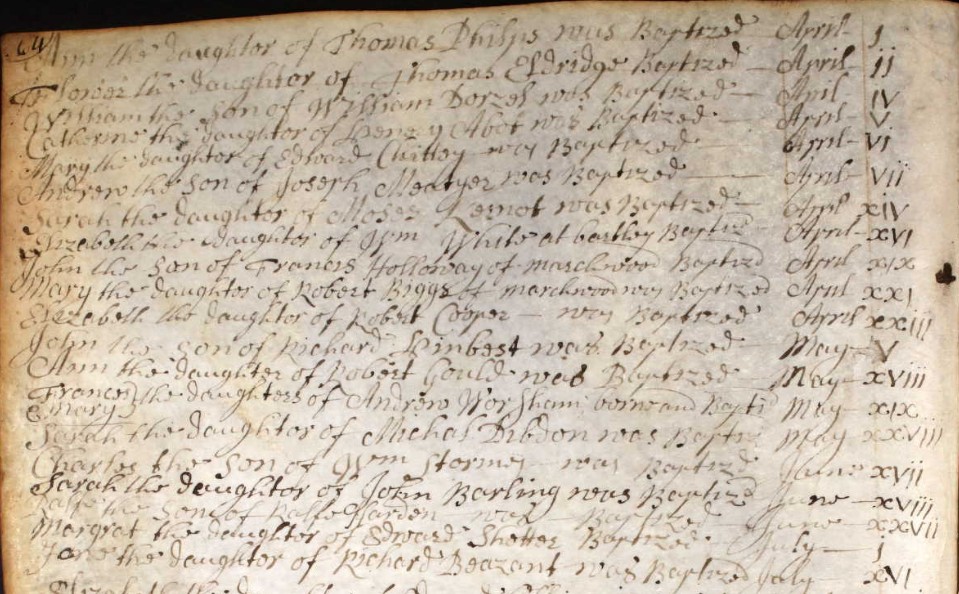
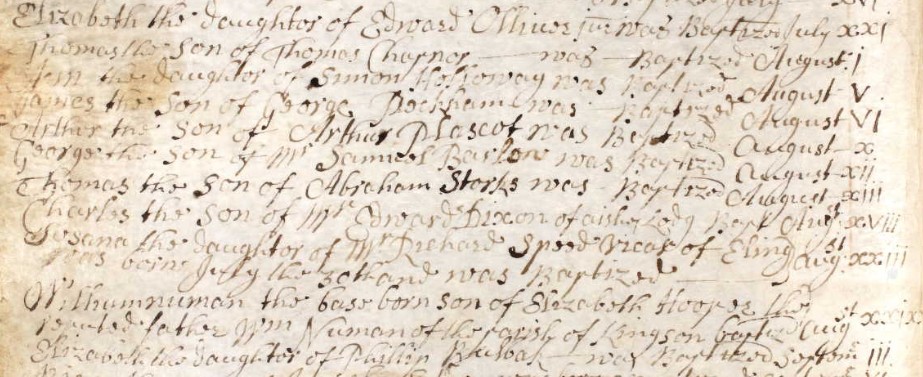
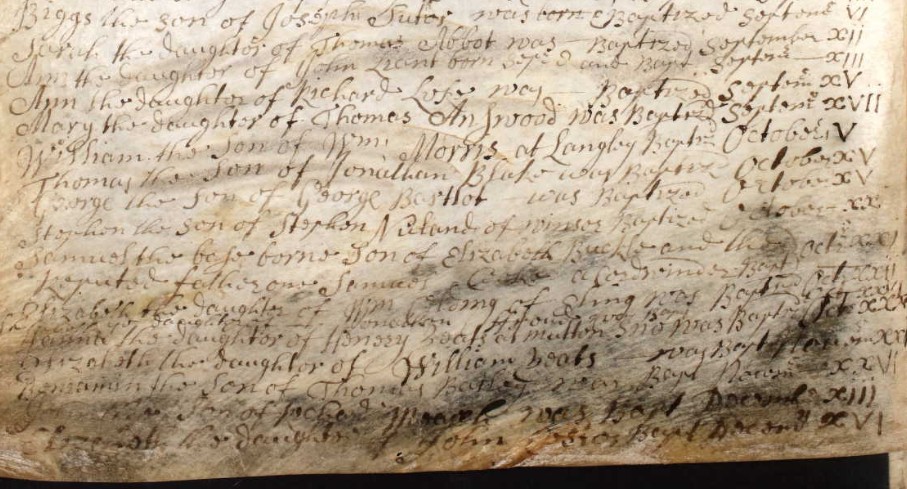
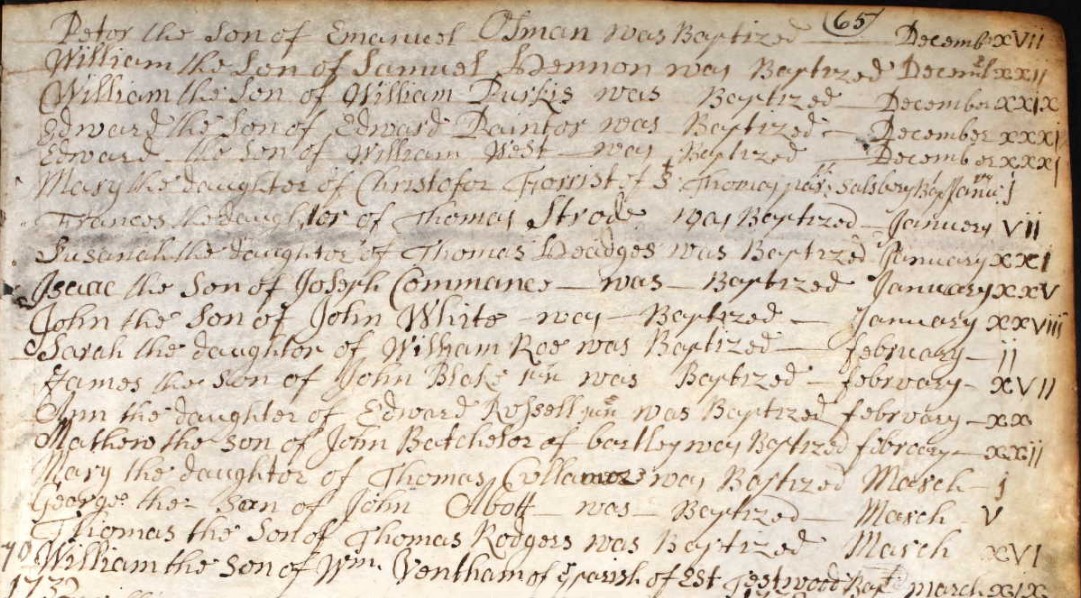
1732
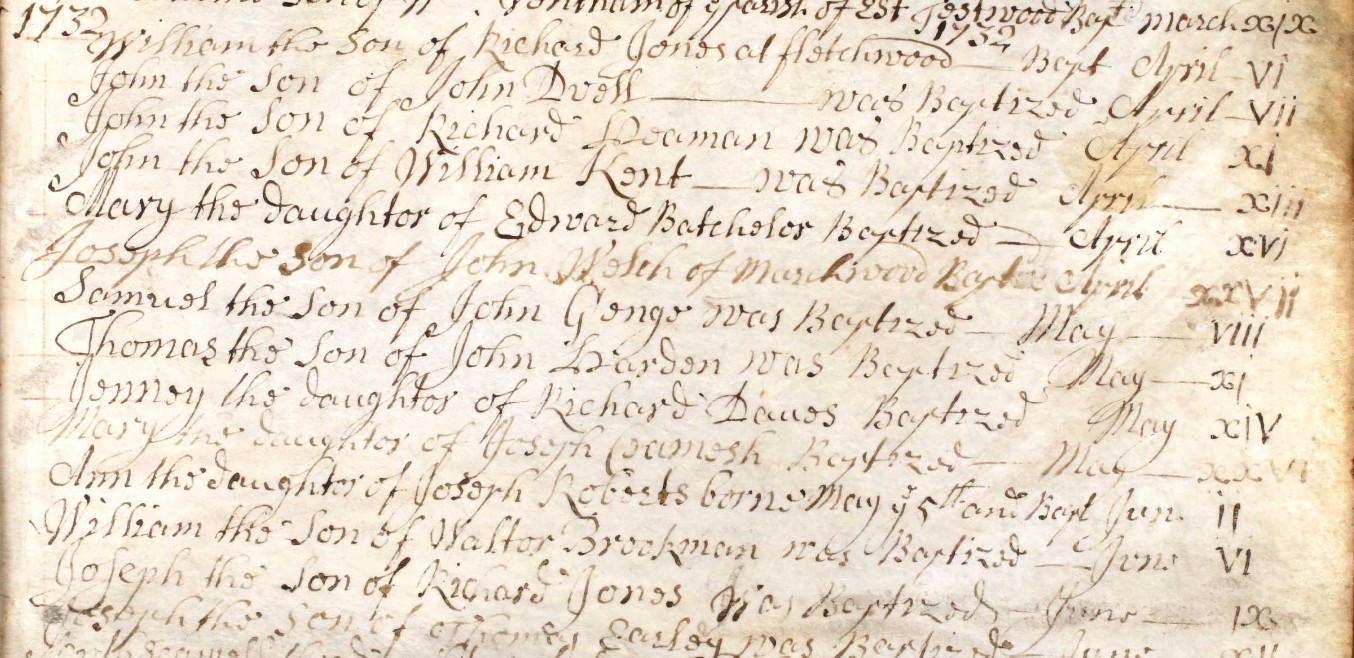
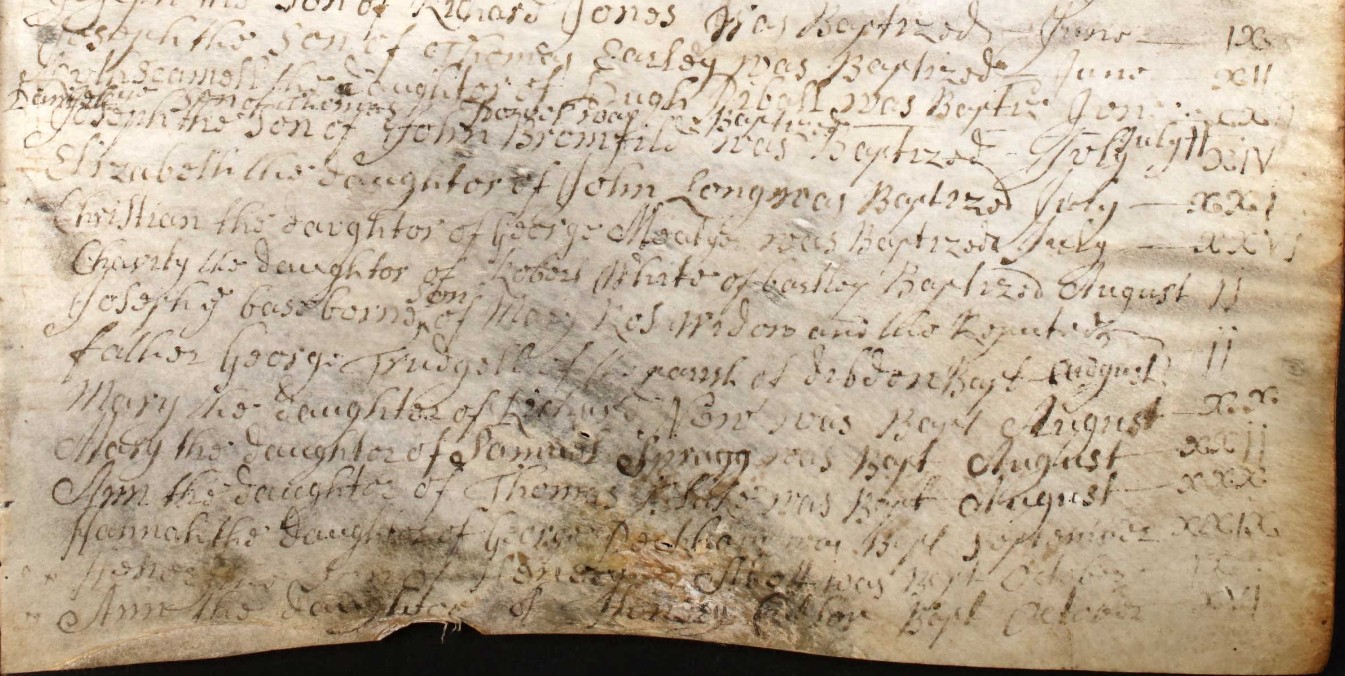
Another possible, four records down from the top of the last section; Christian the daughter of George M???? was baptised July xxvi. July 26th 1732 baptised at St Mary the Virgin Church, Eling. An unusual name for a daughter. Not transcribed in Ancestry.
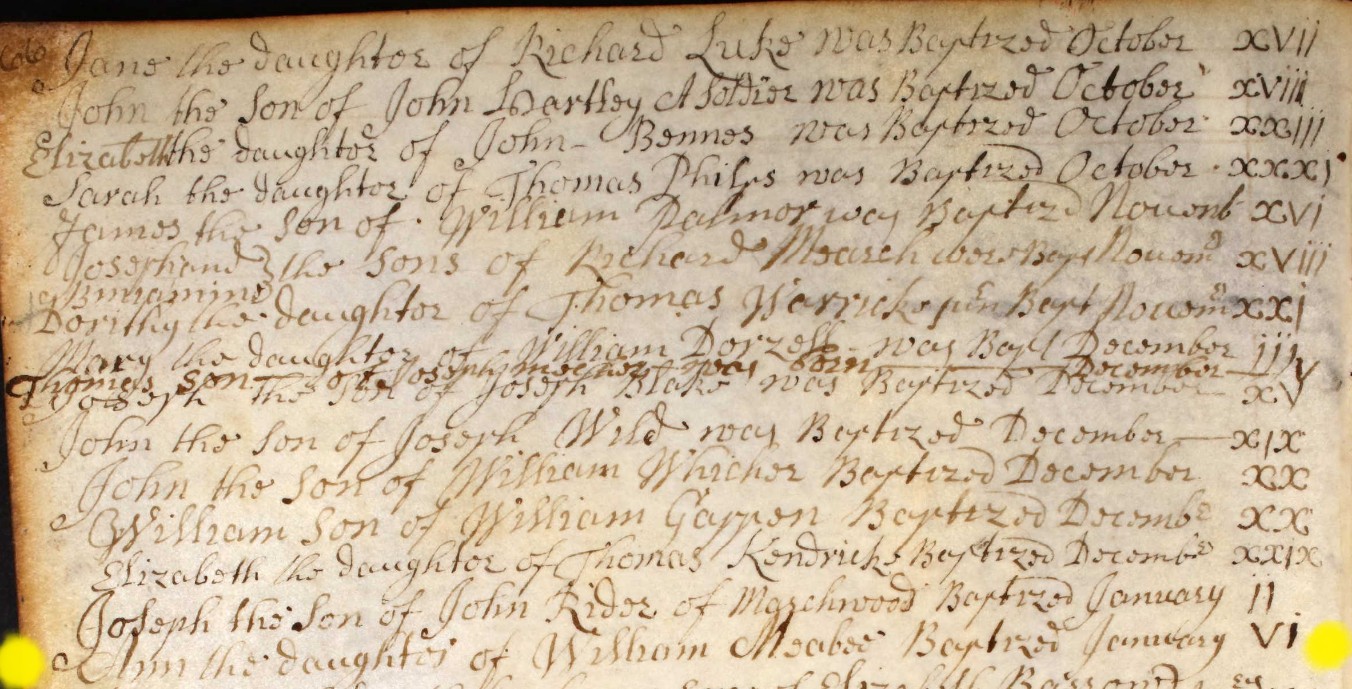
Yellow dots, instead of a light wash to highlight, so as to not obscure the writing on the Registry page. Ann the daughter of William Meabee Baptised January vi. Baptised 6th January 1732 in St. Mary the Virgin Church, Eling.
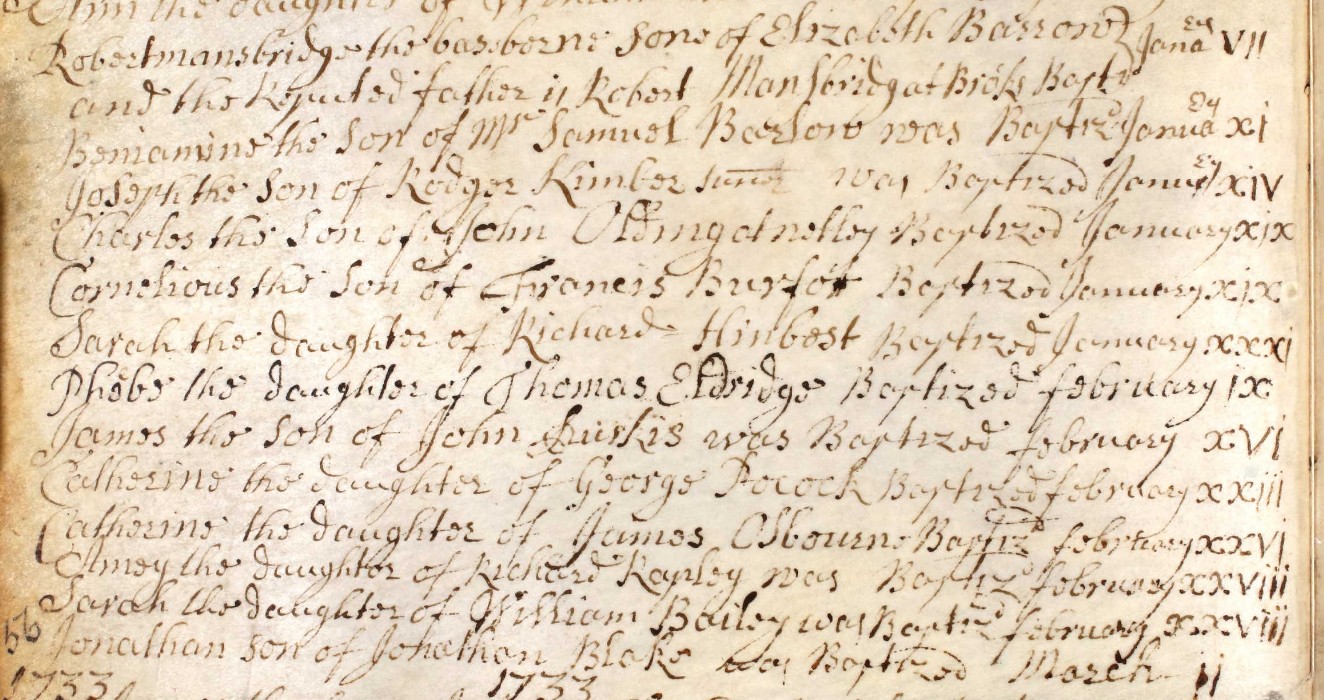
1733
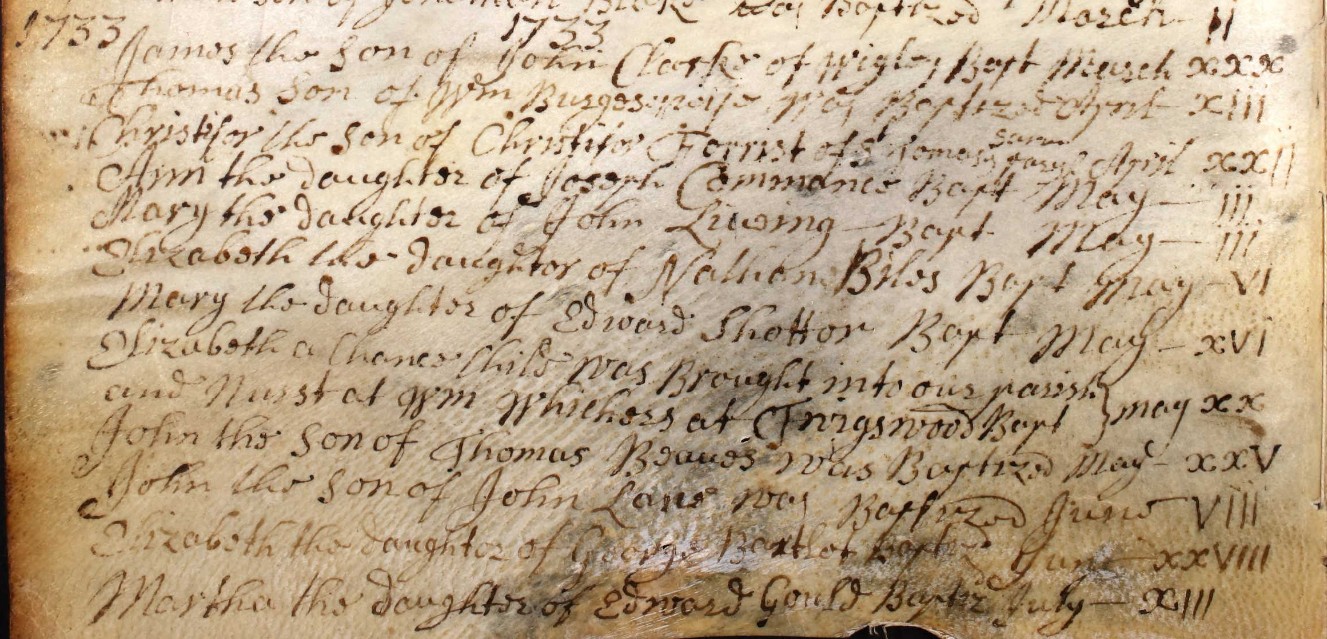
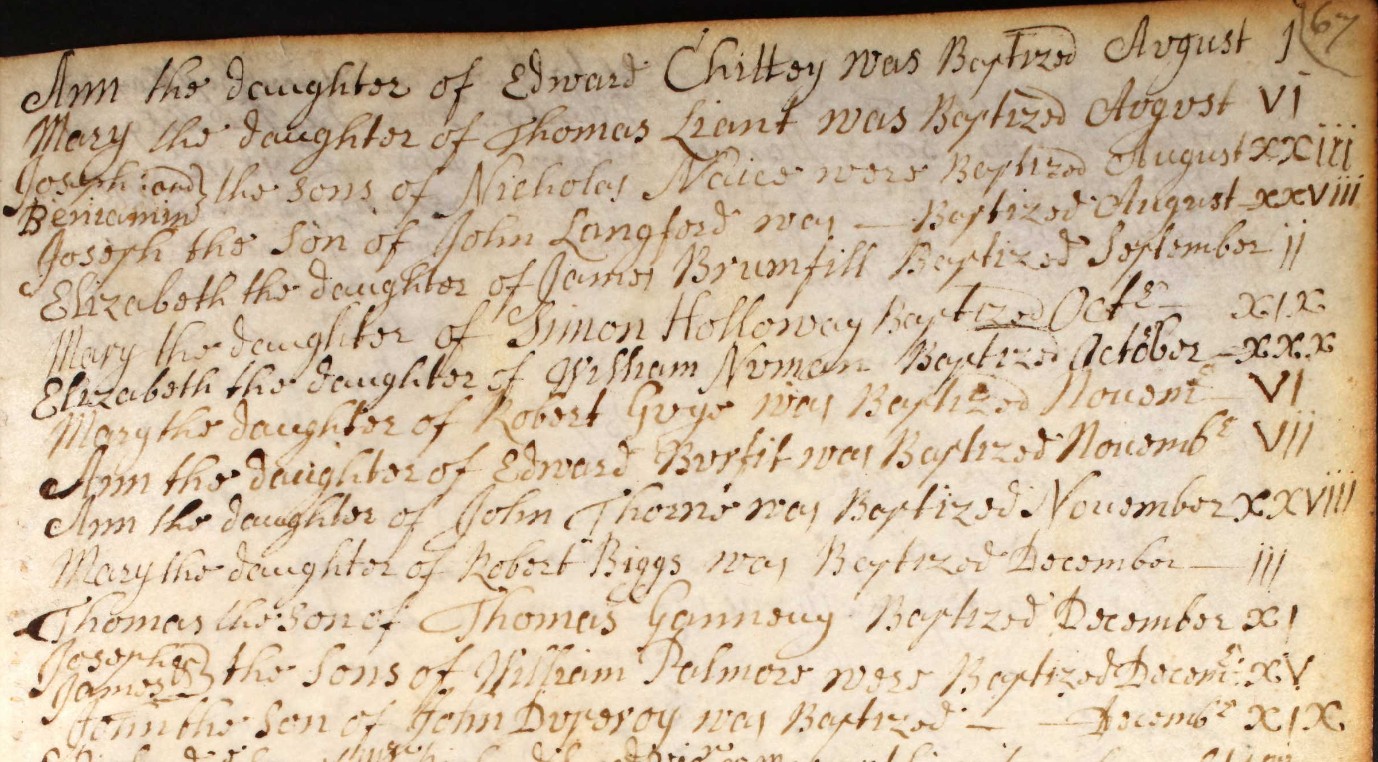
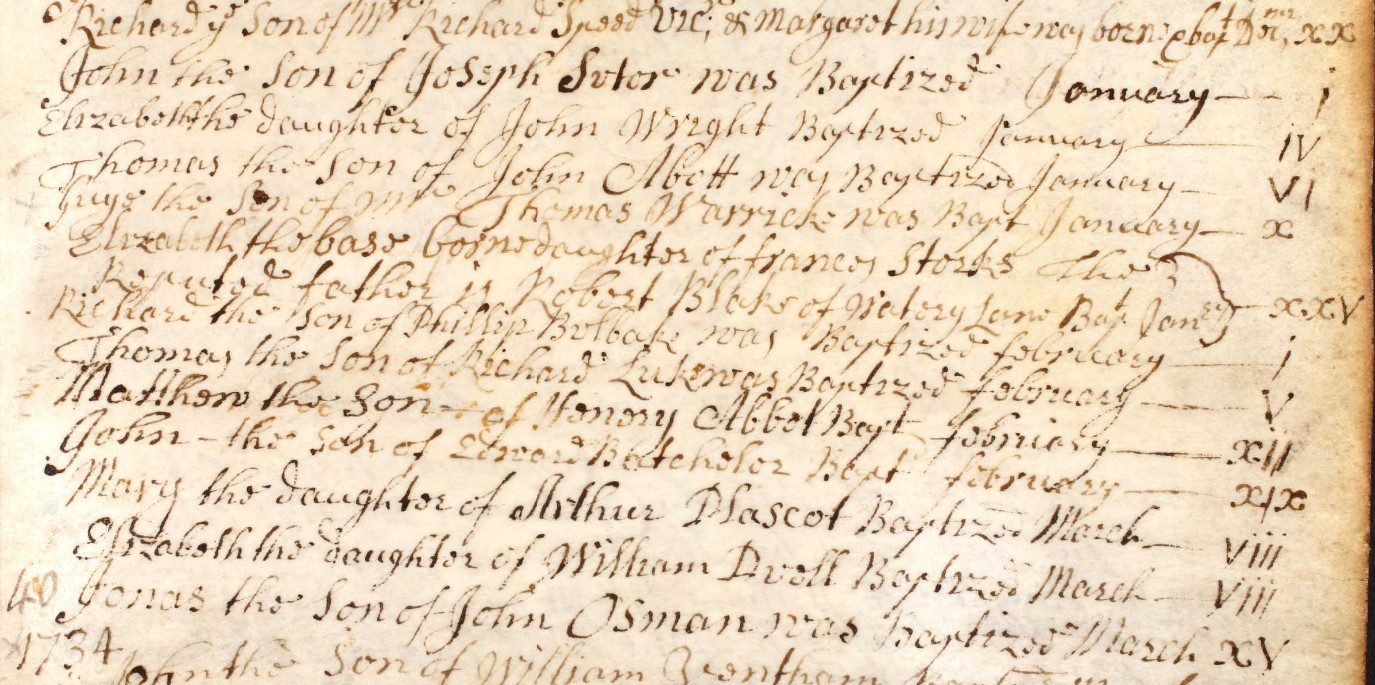
1734
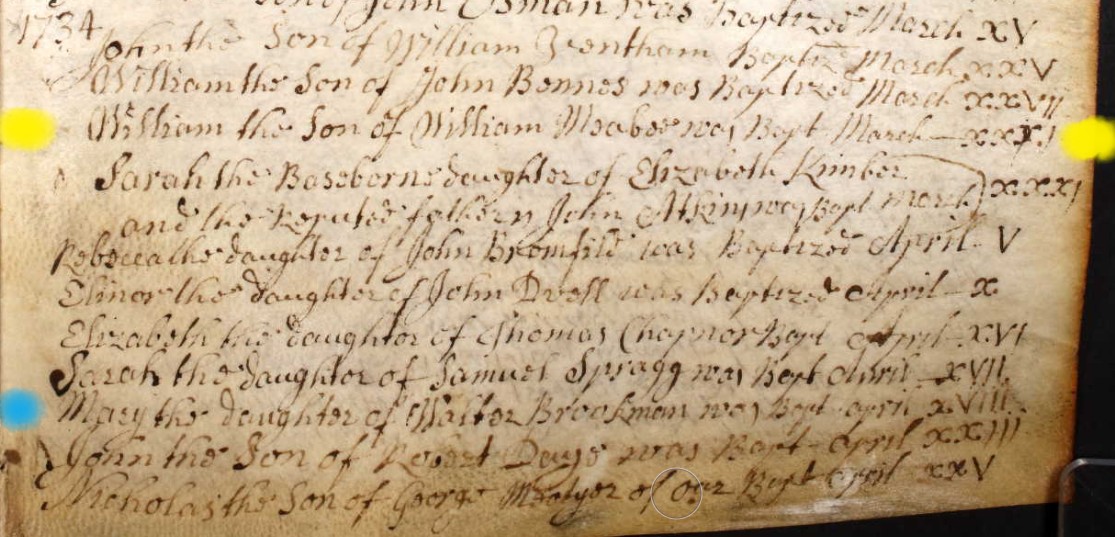
William the Son of William Maebee was Bapt. March xxxi. Baptised 31st March 1734 in St. Mary the Virgin Church, Eling.
The blue dot is just to highlight the use of a capital M, in a word recognisable as Mary, for comparison with Maebee, which is much less certain.
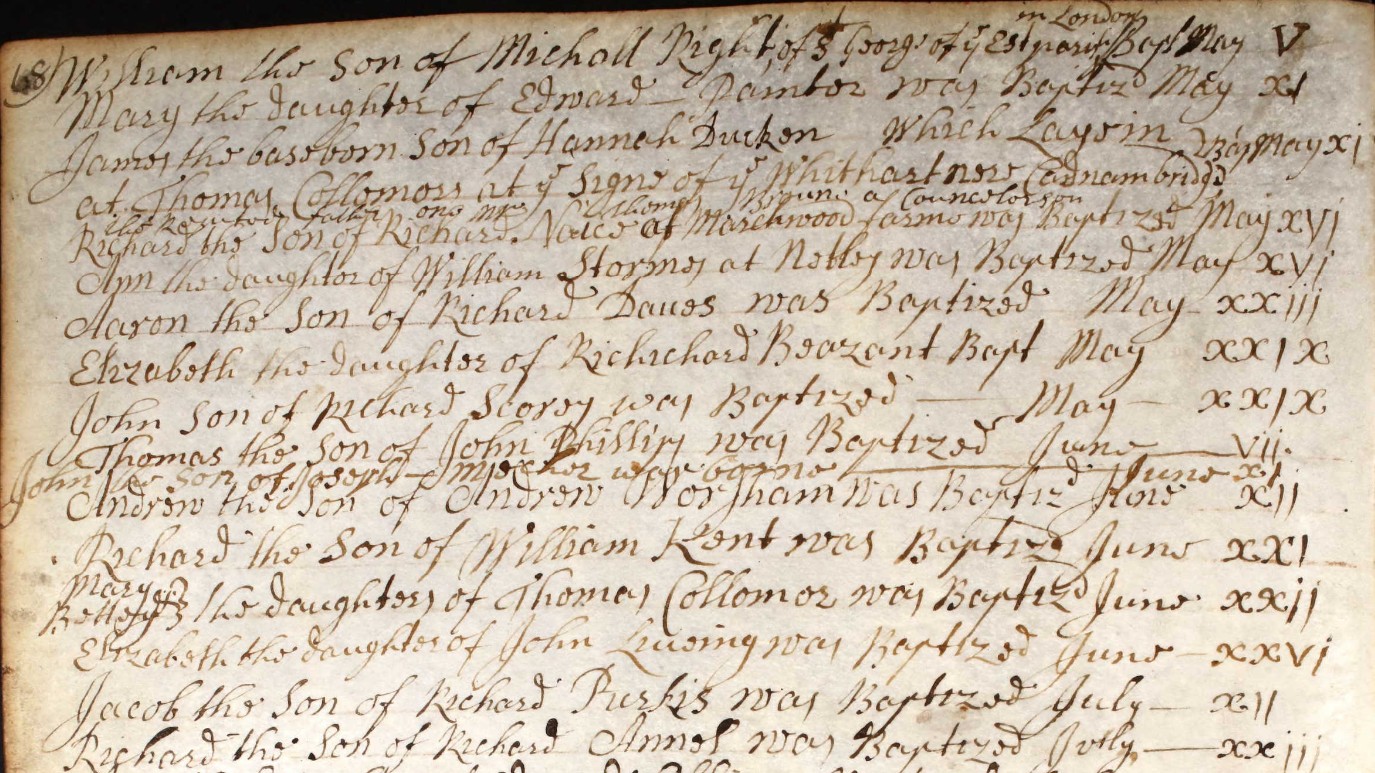
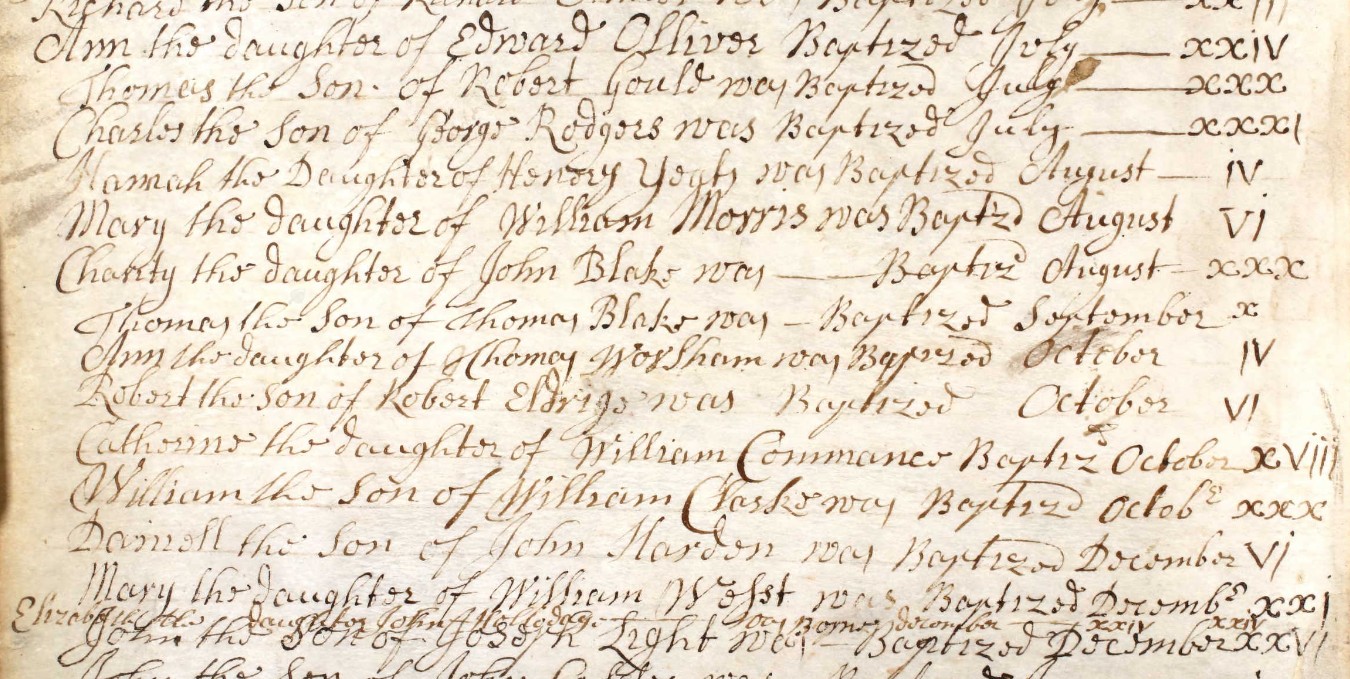
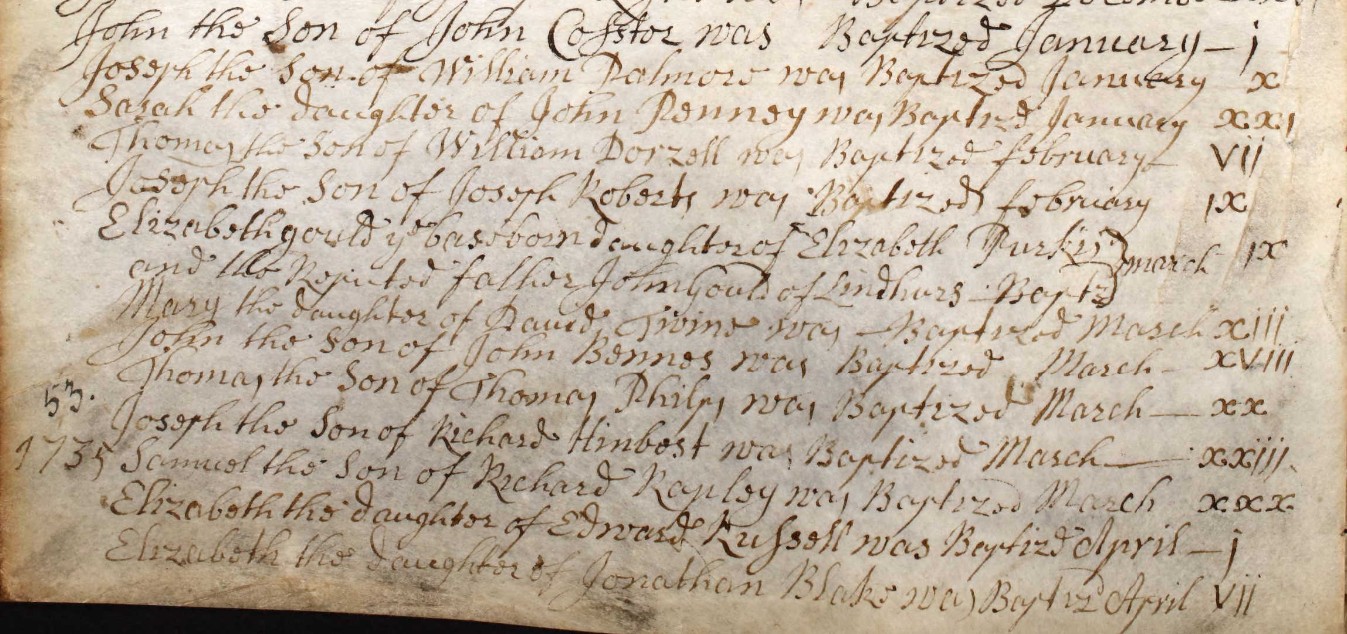
1735

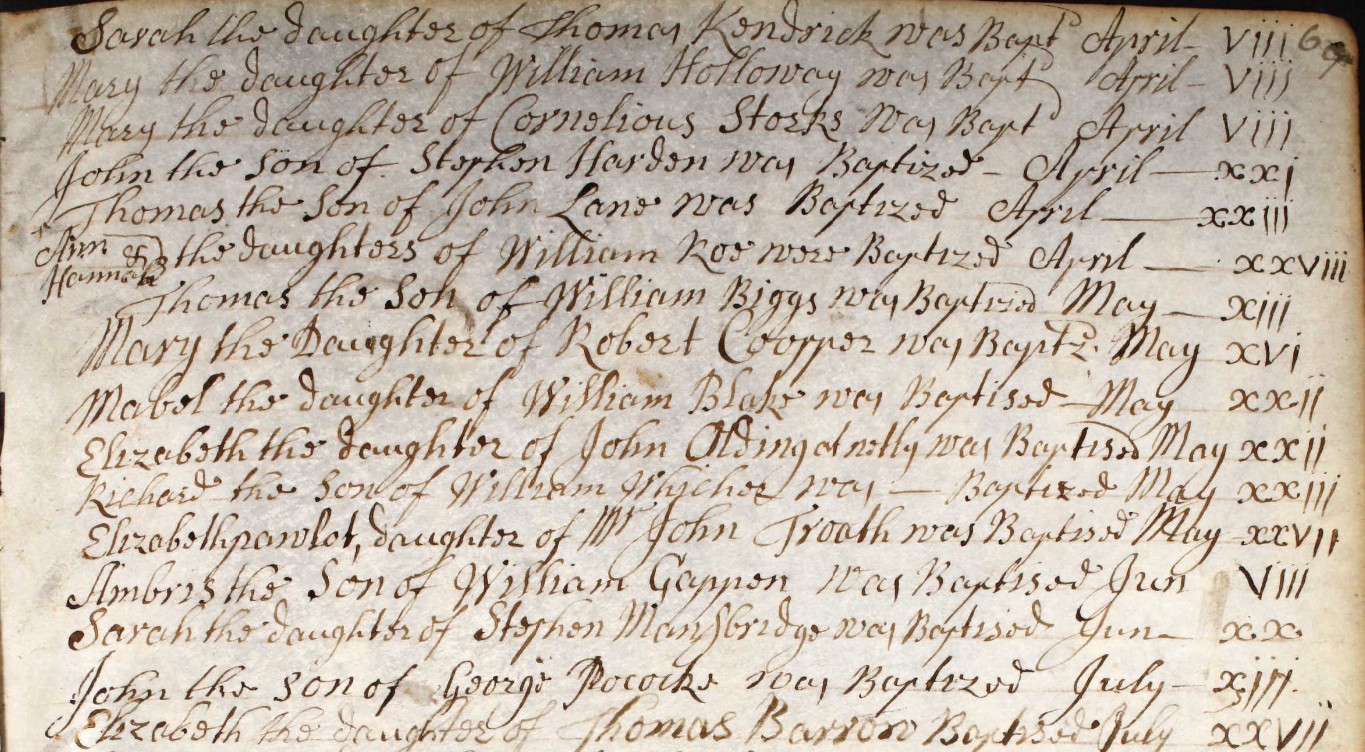
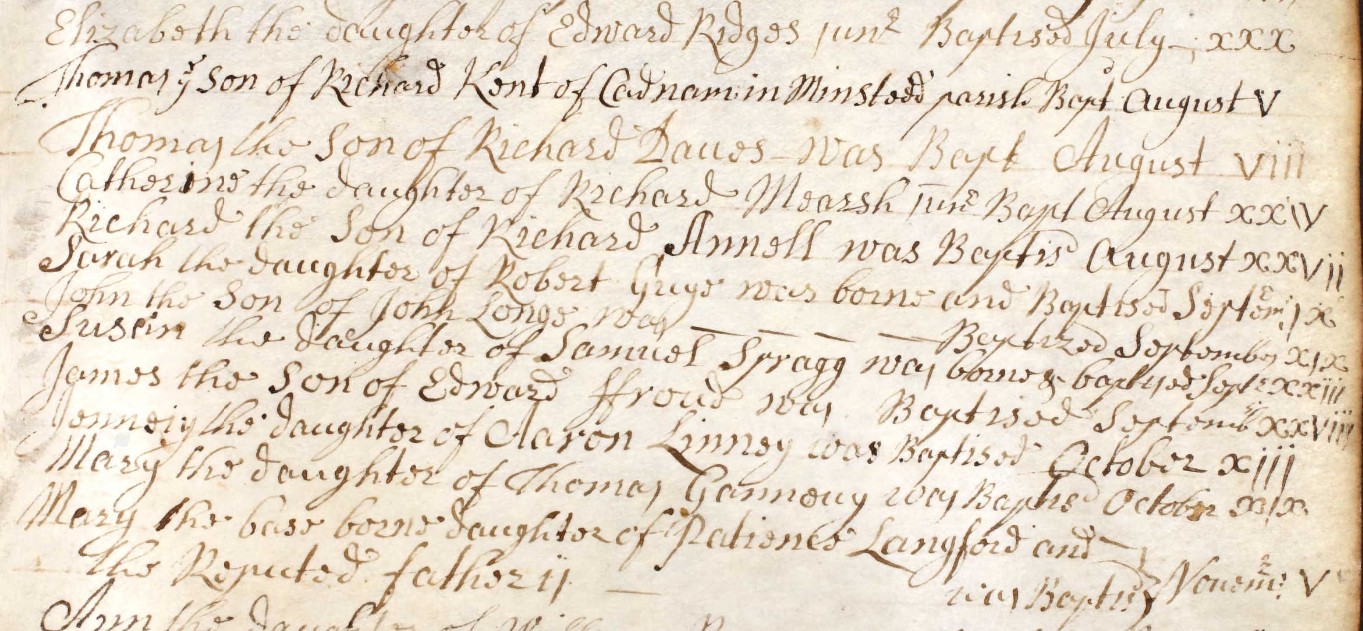
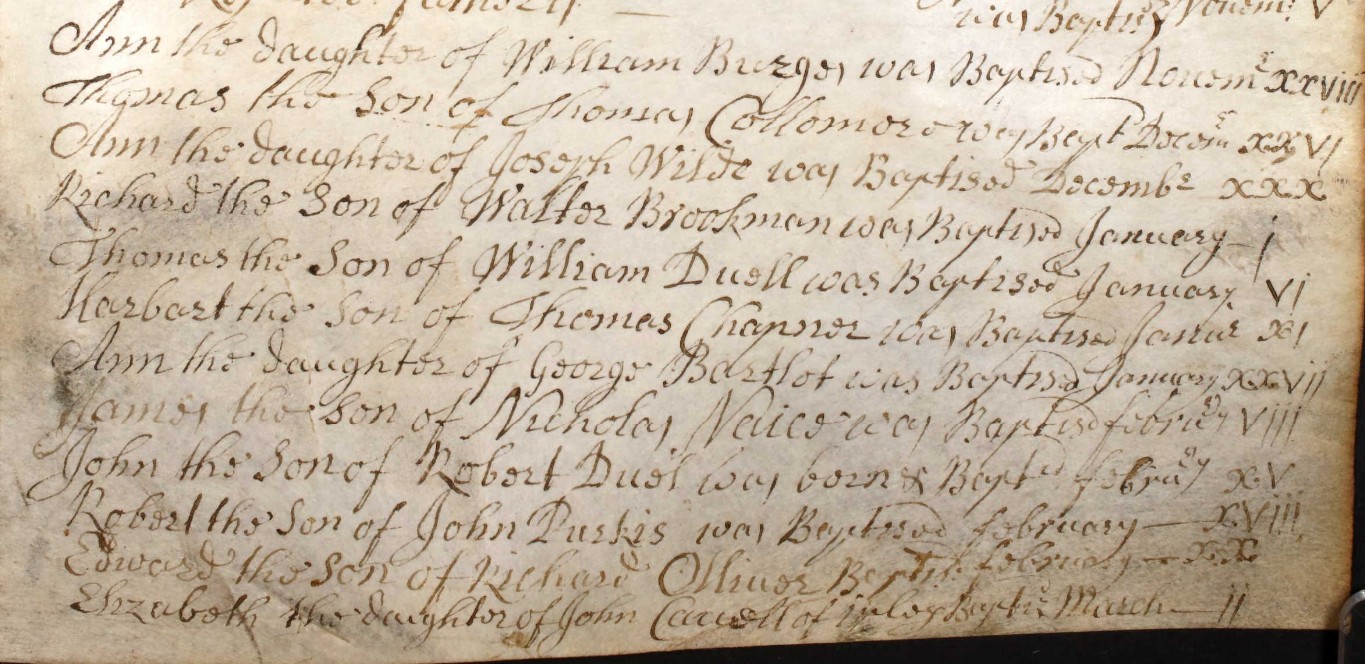

Mary the daughter of William Maebee was Baptised March viii. Baptised 8th March 1735 in St. Mary the Virgin Church, Eling.
1736 Part only
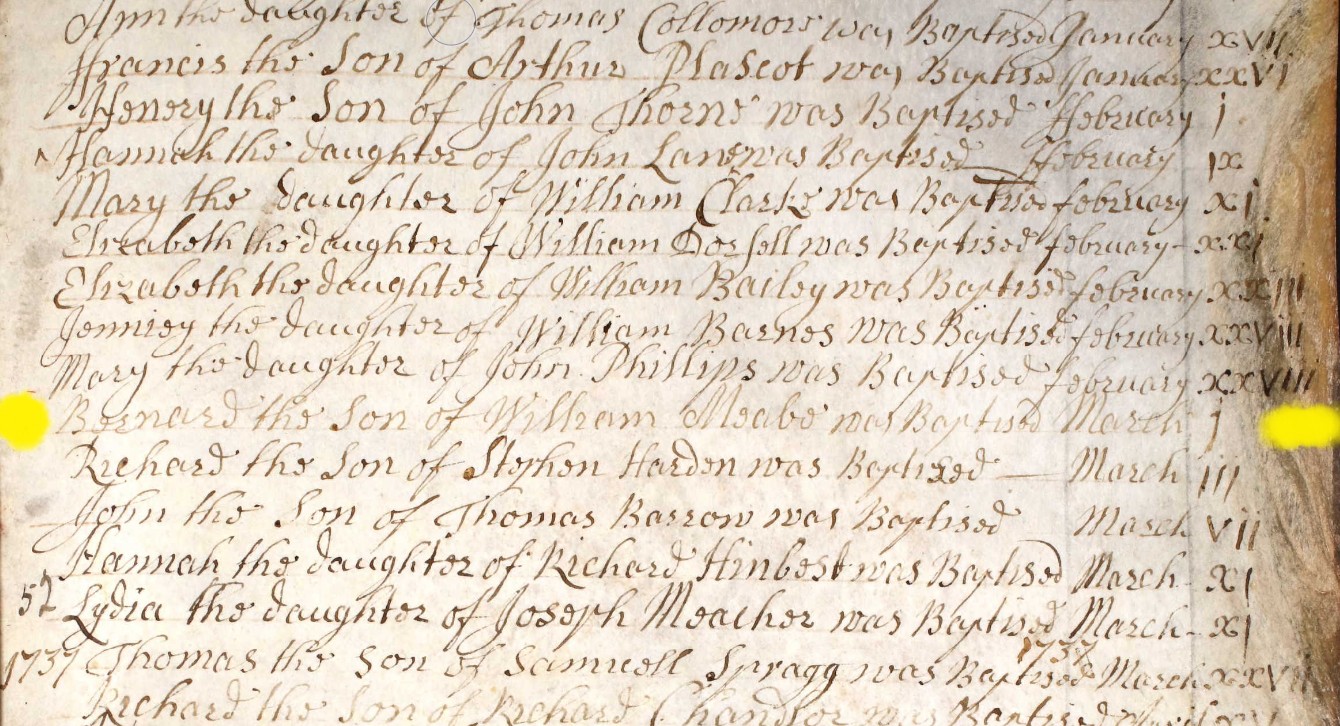
Bernard the Son of William Meabe was Baptised March i. Baptised on 1st March 1736 at St Mary the Virgin Church, Eling, Hampshire.
1738
Ann the Daughter of Robert & Ann Eldridge

Ann the Daughter of Robert & Ann Eldridge was baptised October xxxi - 31st October 1738, baptised at St Mary the Virgin Church, Eling, Hampshire.
The baptism record above Ann, is also interesting, Robert Brown of about 17 Years of Age (his Parents being Quakers) was bap: Oct. xxi. Further confirms that older children may have their age shown, and sometimes annotated with a reason for late baptism.
Eling 1750 to 1798
Baptisms in the Eling Parish Register 1750 to 1798
Baptised at Eling Parish Church, St Mary the Virgin, aka St Mary's Church.
A reminder that until 1752 the beginning of the New Year was 25 March (Lady Day, the Feast of the Annunciation). This is evident in the pages below.
1750
Thomas the Son of John & Elizabeth Penny
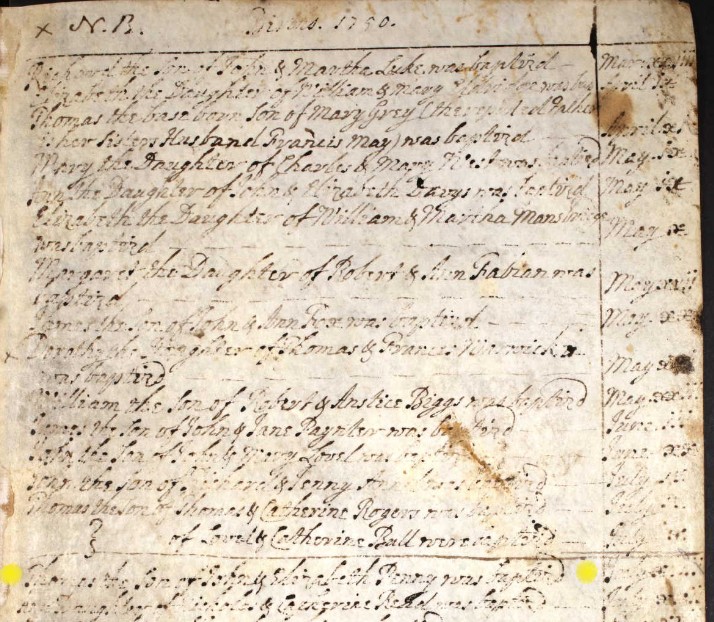
Thomas the Son of John & Elizabeth Penny was baptised July xiii - 13th July 1750, baptised at St Mary the Virgin Church, Eling, Hampshire.
Not particularly relevant, just the same surname.
However, it does provide some evidence of Penny family or families in the Parish of Eling, at least from 1750.
1759
Ann Daughter of William and Mary Eldridge

Ann Daughter of William and Mary Eldridge was baptized July xv - 15th July 1759, baptised at St Mary the Virgin Church, Eling, Hampshire.
List of Rectors & Vicars
A spectacular find. Click on image to go to source.
This list is so helpful. In the past I would look through the Parish Register for information to create a list, or go to some of the sources at the top of the image. This is so much easier, just look the parish up, and there is the list. I recognise some of the names from the Marriage Certificates.
Why have I put this here? Well some of the Ancestry Trees have some of the Penny family being born at The Vicarage, Eling Hill, Eling, Hampshire. Which is the correct address for the vicarage of St Mary's, aka St Mary the Virgin Church.
It does not appear that the Penny family are the rector or vicar of the parish, but that does not make the information incorrect. They could be part of the domestic or gardening / farming team.
1772
George the Son of William & Ann Penny
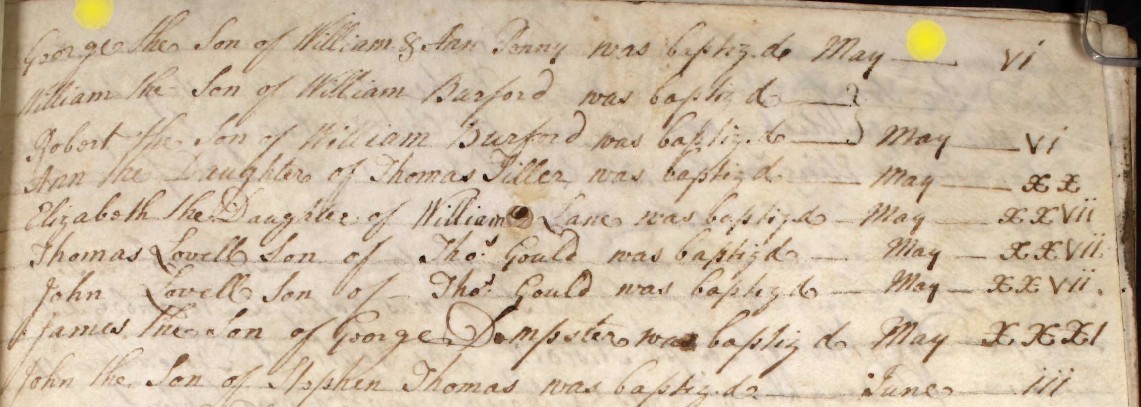
George the Son of William & Ann Penny was baptised May vi. - 6th May 1772 baptised at St Mary the Virgin Church, Eling.
A Penny family found in Eling, just not the one looked for.
1776
Joseph & Mary Son & Daughter of James & Ann Peny
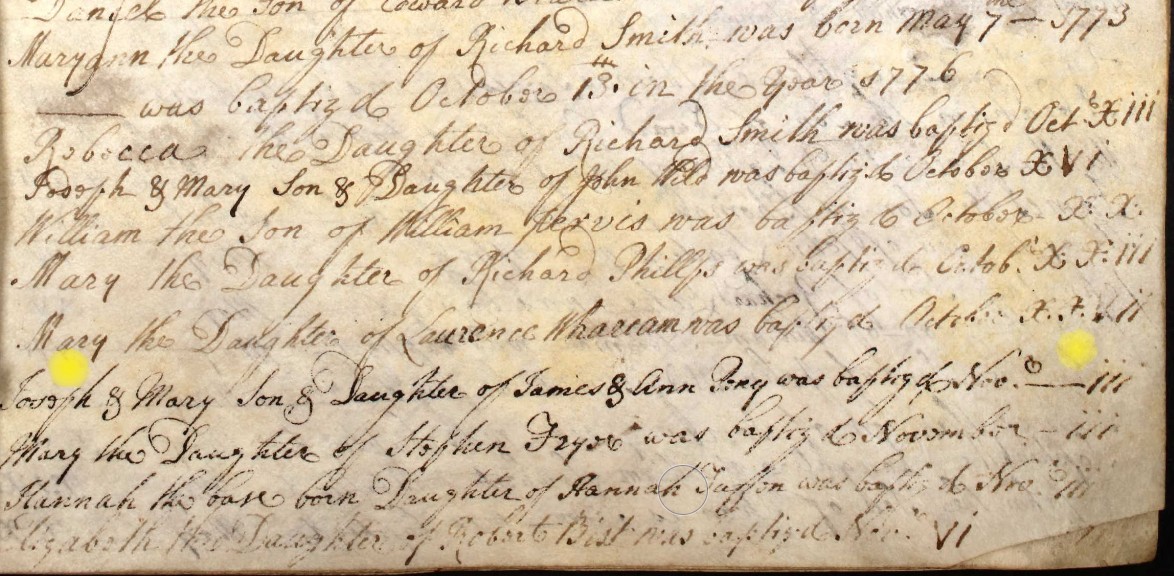
Joseph & Mary Son & Daughter of James & Ann Peny was baptised Novr iii - 3rd November 1776 baptised at St Mary the Virgin Church, Eling.
I believe Mary is the person I was looking for. She becomes John Mabey's wife.
I think Peny and Penny are the same families.
Eling Parish Register
1790
William Son of William and Mary Mabey
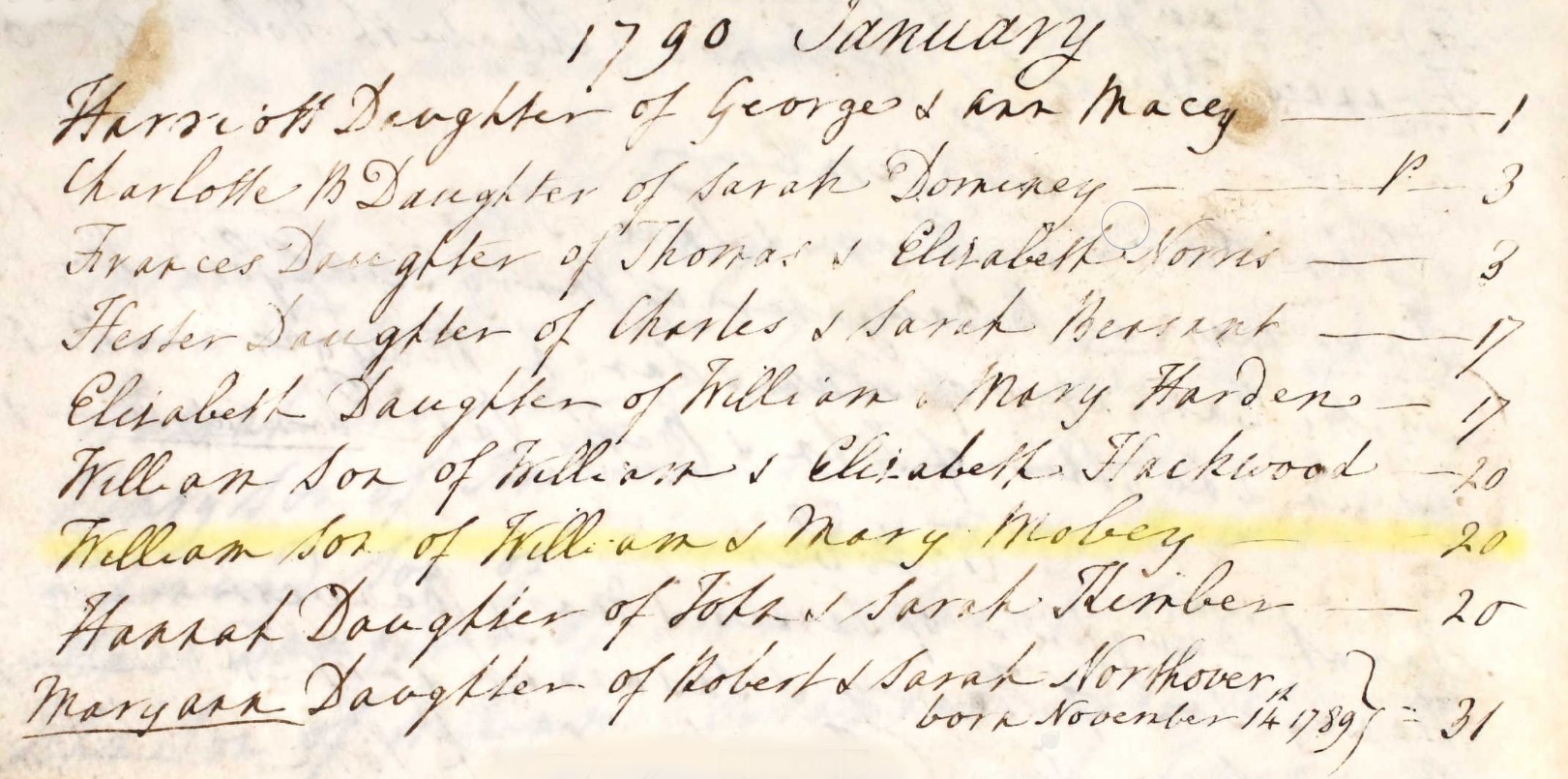
William Son of William & Mary Mabey [or Mobey] 20
20 Jan, 1790 William Son of William & Mary Mabey
Jump back to top of Parish Records tabs
Jump back to top of Parish Records tabs
Marriage
Before we get into the registers ...
Marriage, a snippet of information
In 1780, the minimum legal age for marriage was 12 years for women and 14 years for men. It was also possible for the couple to get engaged at the age of 7, with the right to break off the engagement on reaching the minimum age of consent. However, early marriages were rather rare, and the average age of the newlyweds was about 25 years.
An extract from a Royal Historical Society article.
Nursling 1736 to 1797
Marriages in the Nursling Parish Register 1736 to 1797
William Maby to Anne Long
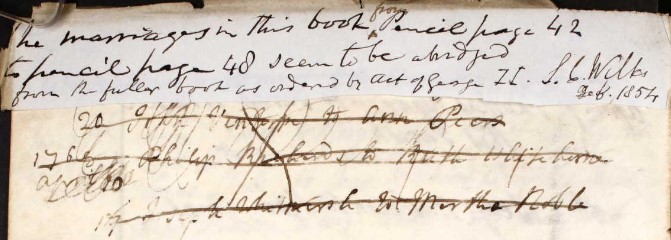
The marriages in this book from pencil page 42 to pencil page 48 seem to be abridged from the fuller book as ordered by Act of George II . S.C. Wilks Feb. 1854.
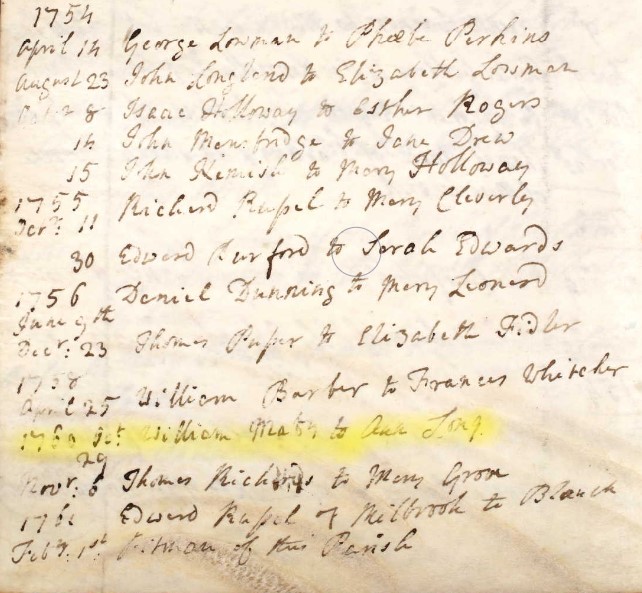
1760 Oct 29 William Maby to Ann Long

| 1760 | |||||
| No 9 | |||||
| Banns of Marriage between | William Maby | ||||
| and | Anne Long | ||||
| were published on the three Sundays underwritten: | |||||
| That is to say, | On Sunday, | the 12 | ) | ||
| On Sunday, | the 19 | } | October | by Ed. Morris Rector | |
| On Sunday, | the 26 | ) |
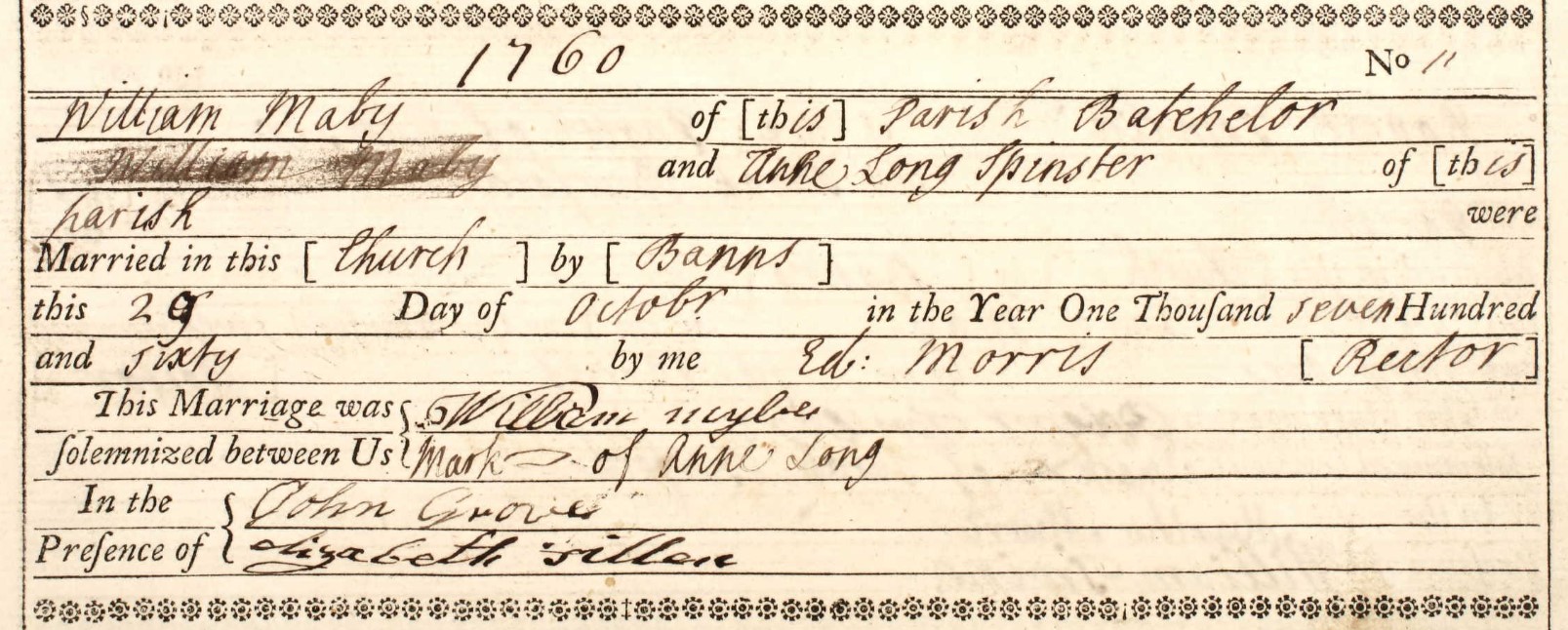
| 1760 | ||||||
| No. 11 | ||||||
| William Maby of this Parish Batchelor | ||||||
| and | ||||||
| Anne Long Spinster of this parish | ||||||
| were Married in this Church by | Banns this | 29 Day of October in the Year One Thousand seven Hundred and Sixty | by me | Ed: Morris | Rector | |
| This Marriage was solemnized between us | William Mybe | |||||
| Mark x of Anne Long | ||||||
| In the Presence of | John Grove | |||||
| Elizabeth Fillere | ||||||
| 29 Oct 1760 |
John Grove is the witness to a number of these marriages which suggests that he may be a clerk or a churchwarden as opposed to a relative.
John Mathews to Mary Long
No entry in the Banns Register between 1762 and 1767 inclusive. Also records no 12 and 13 are blank.
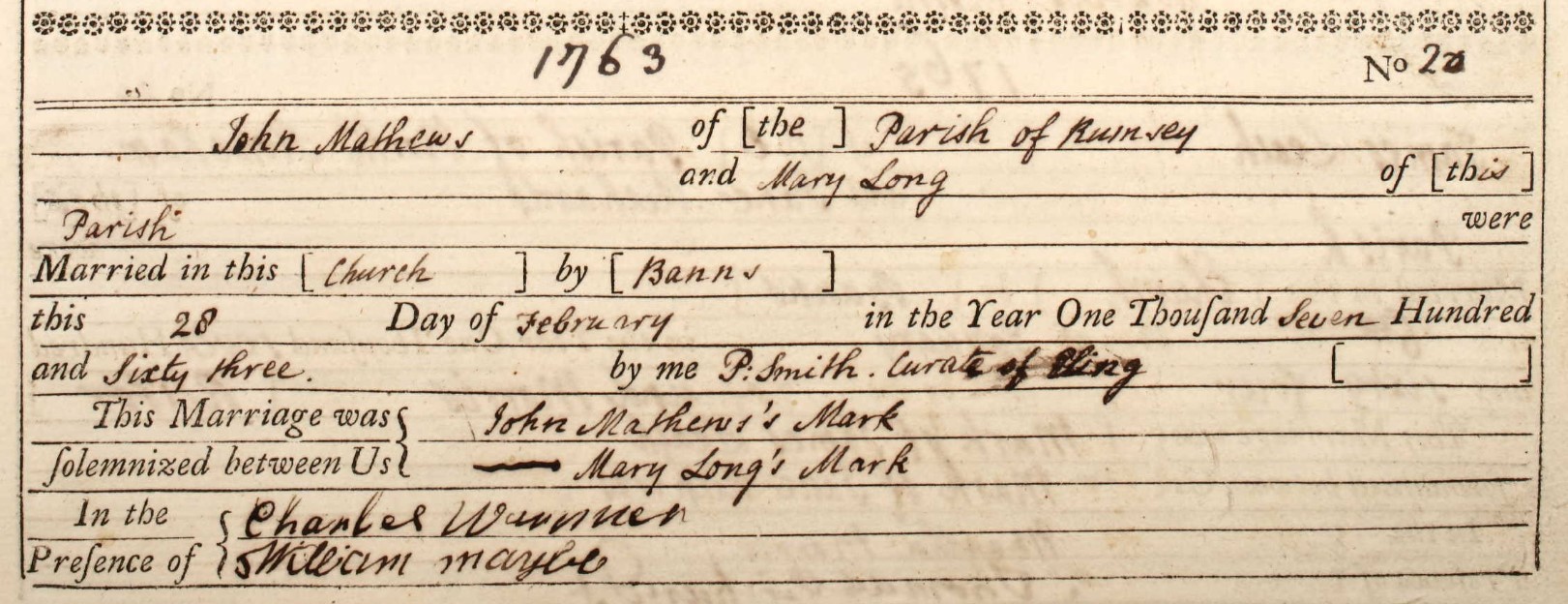
| 1763 | ||||||
| No. 20 | ||||||
| John Mathews of the Parish of Rumsey [Romsey] | ||||||
| and | ||||||
| Mary Long of this parish | ||||||
| were Married in this Church by | Banns this | 28 Day of February in the Year One Thousand Seven Hundred and Sixty three | by me | P. Smith | Curate of Eling. | |
| This Marriage was solemnized between us | John Mathew's Mark ----- | |||||
| Mary Long's Mark | ||||||
| In the Presence of | Charles Waunner | |||||
| William Maybe | ||||||
| 28 Feb 1763 |
Oh, for all writing to be as clear as the Curates! I would still transcribe the data even though it is not necessary to read it, but doing so makes it searchable.
Nathan Long to Mary Powel
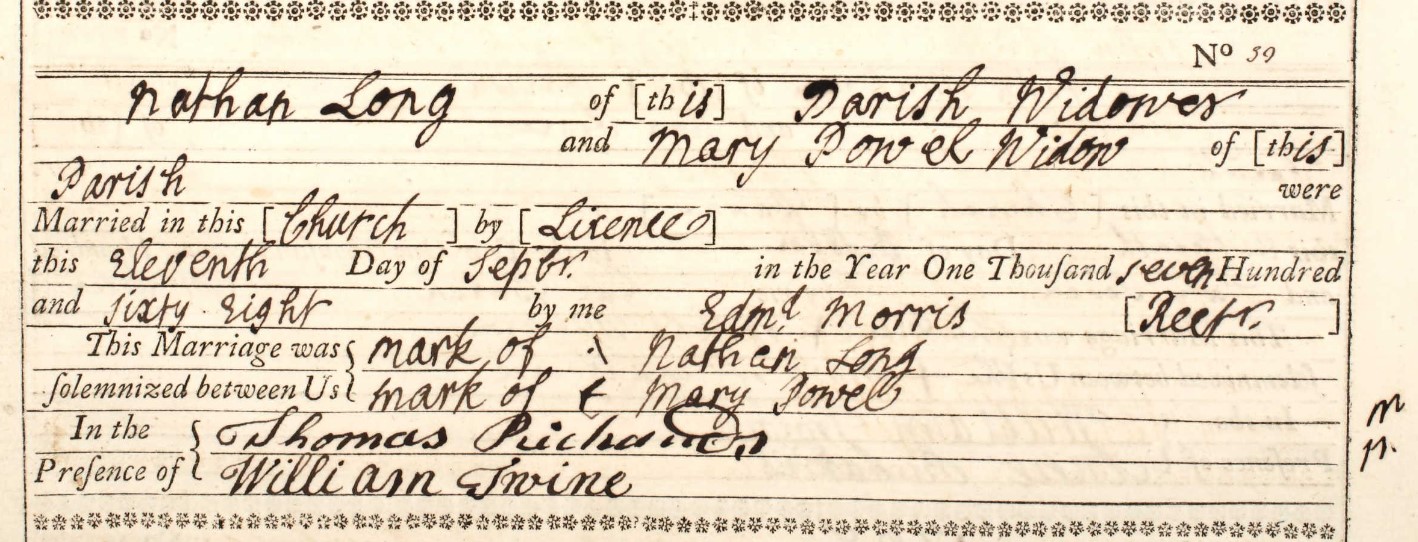
| 1768 | ||||||
| No. 59 | ||||||
| Nathan Long of this Parish Widower | ||||||
| and | ||||||
| Mary Powel Widow | ||||||
| were Married in this Church by | Licence this | Eleventh Day of Sepbr. in the Year One Thousand seven Hundred and Sixty Eight | by me | Edmd Morris | Rector | |
| This Marriage was solemnized between us | Mark of \ Nathan Long | |||||
| Mark of + of Mary Powel | ||||||
| In the Presence of | Thomas Richards | |||||
| William Irvine | ||||||
| 11 Sept 1768 |
John Osman to Sarah Maybey
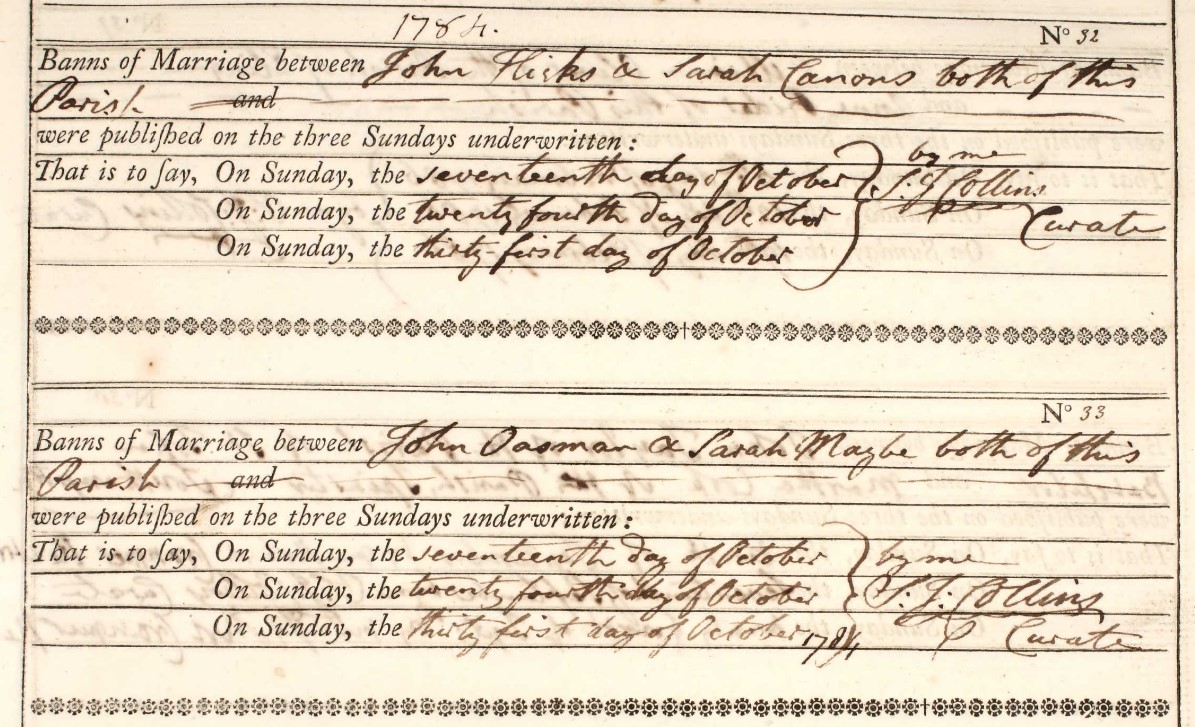
| 1784 | |||||
| No 33 | |||||
| Banns of Marriage between | John Oasman | ||||
| and | Sarah Maybe | both of this parish | |||
| were published on the three Sundays underwritten: | |||||
| That is to say, | On Sunday, | the seventeenth | day of | October | |
| On Sunday, | the twenty fourth | day of | October | by me S. J. Collins | |
| On Sunday, | the thirty first | day of | October 1784 | Curate |
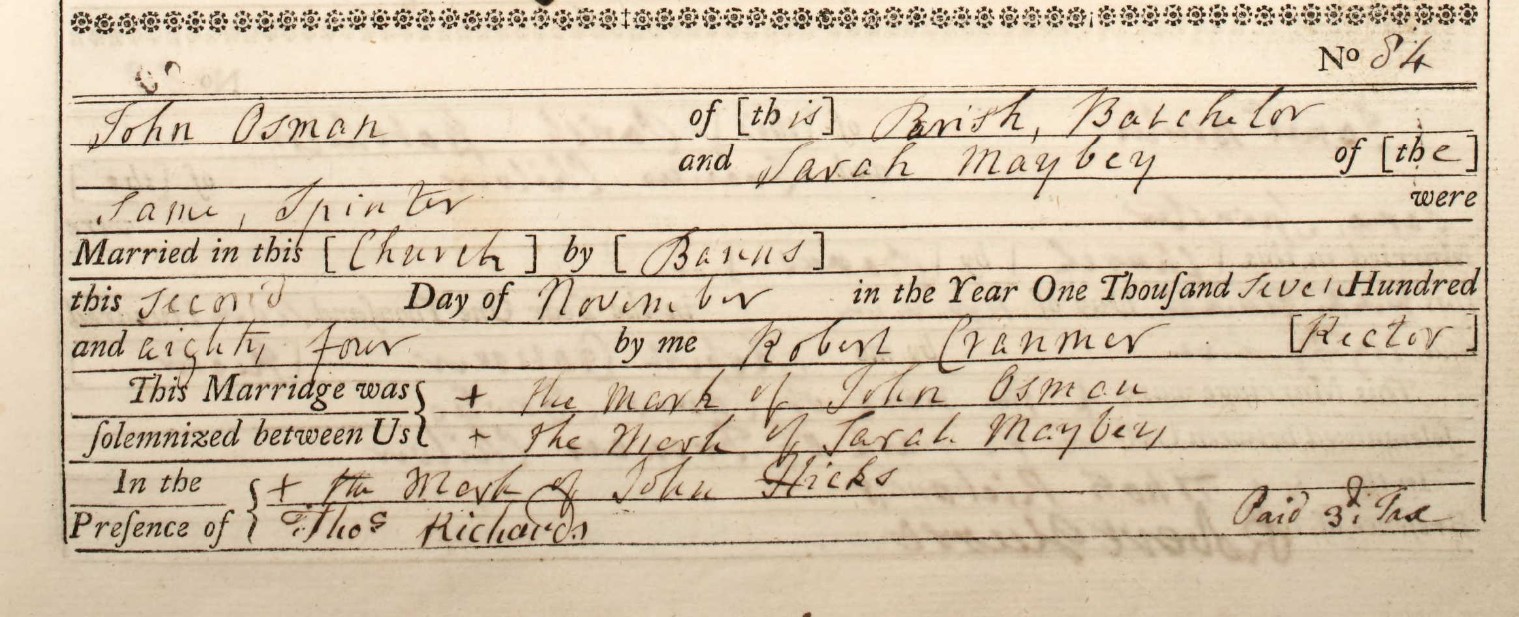
| 1784 | ||||||
| No. 84 | ||||||
| John Osman of this Parish Batchelor | ||||||
| and | ||||||
| Sarah Maybey of the same, Spinster | ||||||
| were Married in this Church by | Banns this | second Day of November in the Year One Thousand seven Hundred and Eighty four | by me | Ed: Morris | Rector | |
| This Marriage was solemnized between us | + the Mark of John Osman | |||||
|
+ the Mark of Sarah Maybey |
||||||
| In the Presence of | + the Mark of John Hicks | |||||
| Thos Richards | ||||||
| 2 Nov 1784 |
John Maybe to Mary Penny
Banns are from Nursling and therefore included here, as well as the Marriage recorded in Eling Parish Register and Bishops Transcripts. All kept together for clarity.
| 1794 | |||||
| No 54 | |||||
| Banns of Marriage between | John Maybe | of this parish | |||
| and | Mary Penny | of the parish of Eling | |||
| were published on the three Sundays underwritten: | |||||
| That is to say, | On Sunday, | the 16th of Feby | 1794 | by me S. J. Collins | Curate |
| On Sunday, | the 23d of Feby | 1794 | by me S. J. Collins | Curate | |
| On Sunday, | the 2d of March | 1794 | by me S. J. Collins | Curate |
The Bride is from the Parish of Eling, so unsurprisingly, the marriage took place in Eling.
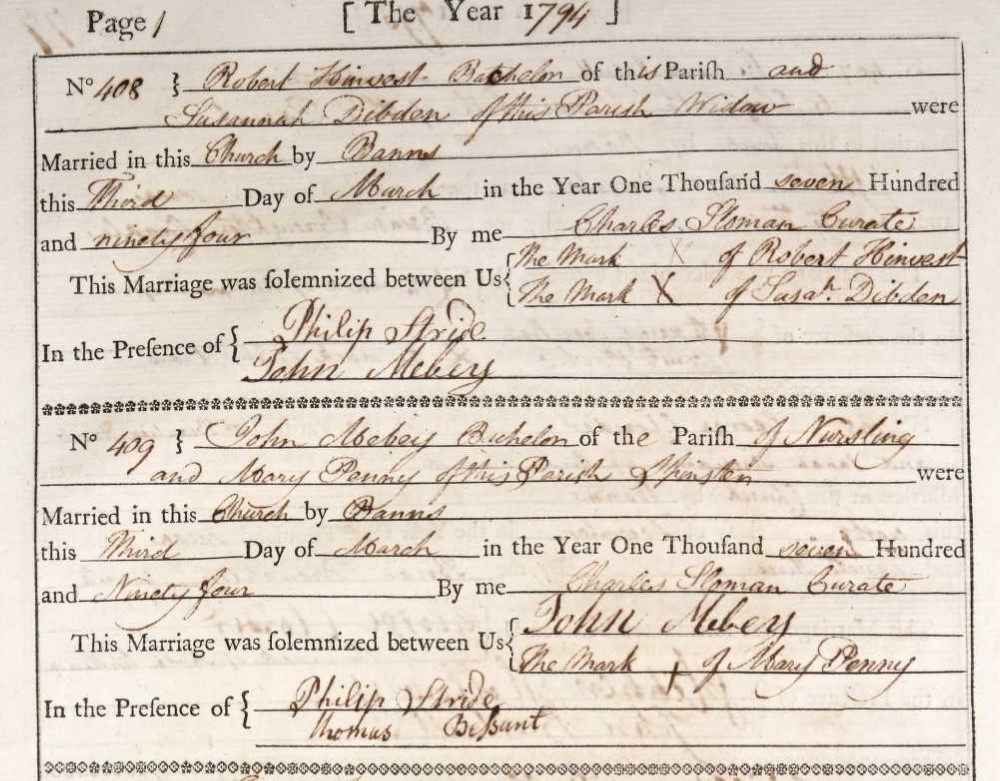
The first entry on this page, no. 408, is copied here just because John Mebey signed as a witness. The signature looks to be the same for his own wedding, so perhaps it has no other significance than he was presence for both weddings, on the third of March and could write.
| 1794 | ||||||
| No. 409 | ||||||
| John Mebey Batchelor of the Parish of Nursling | ||||||
| and | ||||||
| Mary Penny of this parish Spinster | ||||||
| were Married in this Church by | Banns this | Third Day of March in the Year One Thousand seven Hundred and Ninety Four | by me | Charles Sloman | Curate | |
| This Marriage was solemnized between us | John Mebey | |||||
| Mark + of Mary Penny | ||||||
| In the Presence of | Philip Stride | |||||
| Thomas Bessant | ||||||
| 3 Mar 1794 |
The associated Bishop's Transcripts, also for Eling
John Goff to Mary Maybey
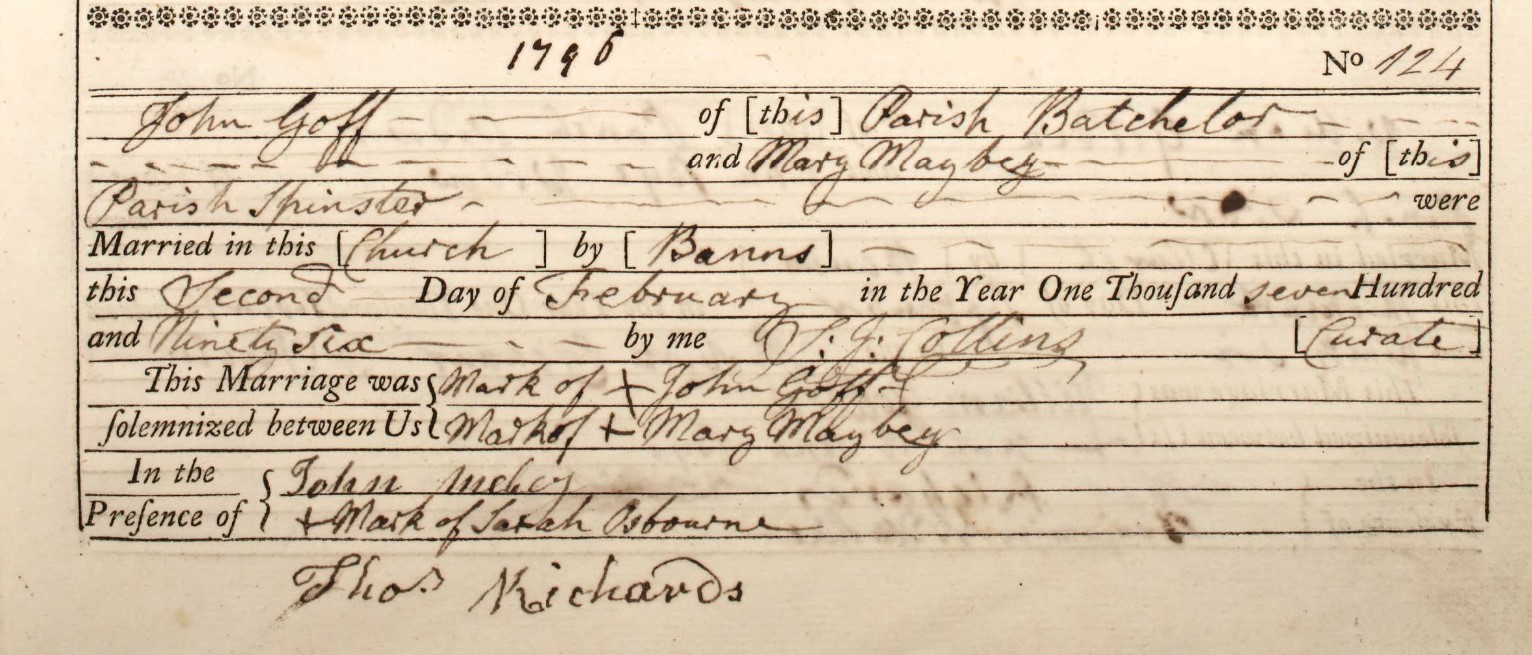
| 1796 | ||||||
| No. 124 | ||||||
| John Goff of this Parish Batchelor | ||||||
| and | ||||||
| Mary Maybey of this parish Spinster | ||||||
| were Married in this Church by | Banns this | Second Day of February in the Year One Thousand seven Hundred and Ninety Six | by me | S. J. Collins | Curate | |
| This Marriage was solemnized between us | Mark x of John Goff | |||||
| Mark x of Mary Maybey | ||||||
| In the Presence of | John Mebey | |||||
| Mark x of Sarah Osbourne | ||||||
| Thoms Richards | ||||||
| 2 Feb 1796 |
John Goff [or is this Goss]
sssssssssssssssssssssssssssssssssssssssssssssssssssssssssssssss
| 1760 | ||||||
| No. 11 | ||||||
| his name of this Parish Batchelor | ||||||
| and | ||||||
| her name Spinster of this parish | ||||||
| were Married in this Church by | Banns this | 29 Day of October in the Year One Thousand seven Hundred and Sixty | by me | Ed: Morris | Rector | |
| This Marriage was solemnized between us | William Mybe | |||||
| Mark x of Anne Long | ||||||
| In the Presence of | John Grove | |||||
| Elizabeth Fillere | ||||||
| 29 Oct 1760 |
xxxxxxxxxxxxxxxxxxxxxxxxxxxxxxxxxxxxxxxxxxxxxxxxxxxxxxxxxxx
sssssssssssssssssssssssssssssssssssssssssssssssssssssssssssssss
| 1760 | ||||||
| No. 11 | ||||||
| his name of this Parish Batchelor | ||||||
| and | ||||||
| her name Spinster of this parish | ||||||
| were Married in this Church by | Banns this | 29 Day of October in the Year One Thousand seven Hundred and Sixty | by me | Ed: Morris | Rector | |
| This Marriage was solemnized between us | William Mybe | |||||
| Mark x of Anne Long | ||||||
| In the Presence of | John Grove | |||||
| Elizabeth Fillere | ||||||
| 29 Oct 1760 |
xxxxxxxxxxxxxxxxxxxxxxxxxxxxxxxxxxxxxxxxxxxxxxxxxxxxxxxxxxx
sssssssssssssssssssssssssssssssssssssssssssssssssssssssssssssss
| 1760 | ||||||
| No. 11 | ||||||
| his name of this Parish Batchelor | ||||||
| and | ||||||
| her name Spinster of this parish | ||||||
| were Married in this Church by | Banns this | 29 Day of October in the Year One Thousand seven Hundred and Sixty | by me | Ed: Morris | Rector | |
| This Marriage was solemnized between us | William Mybe | |||||
| Mark x of Anne Long | ||||||
| In the Presence of | John Grove | |||||
| Elizabeth Fillere | ||||||
| 29 Oct 1760 |
xxxxxxxxxxxxxxxxxxxxxxxxxxxxxxxxxxxxxxxxxxxxxxxxxxxxxxxxxxx
sssssssssssssssssssssssssssssssssssssssssssssssssssssssssssssss
| 1760 | ||||||
| No. 11 | ||||||
| his name of this Parish Batchelor | ||||||
| and | ||||||
| her name Spinster of this parish | ||||||
| were Married in this Church by | Banns this | 29 Day of October in the Year One Thousand seven Hundred and Sixty | by me | Ed: Morris | Rector | |
| This Marriage was solemnized between us | William Mybe | |||||
| Mark x of Anne Long | ||||||
| In the Presence of | John Grove | |||||
| Elizabeth Fillere | ||||||
| 29 Oct 1760 |
xxxxxxxxxxxxxxxxxxxxxxxxxxxxxxxxxxxxxxxxxxxxxxxxxxxxxxxxxxx
sssssssssssssssssssssssssssssssssssssssssssssssssssssssssssssss
| 1760 | ||||||
| No. 11 | ||||||
| his name of this Parish Batchelor | ||||||
| and | ||||||
| her name Spinster of this parish | ||||||
| were Married in this Church by | Banns this | 29 Day of October in the Year One Thousand seven Hundred and Sixty | by me | Ed: Morris | Rector | |
| This Marriage was solemnized between us | William Mybe | |||||
| Mark x of Anne Long | ||||||
| In the Presence of | John Grove | |||||
| Elizabeth Fillere | ||||||
| 29 Oct 1760 |
xxxxxxxxxxxxxxxxxxxxxxxxxxxxxxxxxxxxxxxxxxxxxxxxxxxxxxxxxxx
sssssssssssssssssssssssssssssssssssssssssssssssssssssssssssssss
| 1760 | ||||||
| No. 11 | ||||||
| his name of this Parish Batchelor | ||||||
| and | ||||||
| her name Spinster of this parish | ||||||
| were Married in this Church by | Banns this | 29 Day of October in the Year One Thousand seven Hundred and Sixty | by me | Ed: Morris | Rector | |
| This Marriage was solemnized between us | William Mybe | |||||
| Mark x of Anne Long | ||||||
| In the Presence of | John Grove | |||||
| Elizabeth Fillere | ||||||
| 29 Oct 1760 |
xxxxxxxxxxxxxxxxxxxxxxxxxxxxxxxxxxxxxxxxxxxxxxxxxxxxxxxxxxx
sssssssssssssssssssssssssssssssssssssssssssssssssssssssssssssss
| 1760 | ||||||
| No. 11 | ||||||
| his name of this Parish Batchelor | ||||||
| and | ||||||
| her name Spinster of this parish | ||||||
| were Married in this Church by | Banns this | 29 Day of October in the Year One Thousand seven Hundred and Sixty | by me | Ed: Morris | Rector | |
| This Marriage was solemnized between us | William Mybe | |||||
| Mark x of Anne Long | ||||||
| In the Presence of | John Grove | |||||
| Elizabeth Fillere | ||||||
| 29 Oct 1760 |
xxxxxxxxxxxxxxxxxxxxxxxxxxxxxxxxxxxxxxxxxxxxxxxxxxxxxxxxxxx
Jump back to top of Parish Records tabs
Nursling 1798 to 1812
Marriages in the Nursling Parish Register 1798 to 1812
xxxxxxxxxxxxxxxxxxxxxxxxxxxxxxxxxxxxxxxxxxxxxxxxxxxxxxxxxxxxxxxxxxxxx
EXAMPLE
xxxxxxxxxxxxxxxxxxxxxxxxxxxxxxxxxxxxxxxxxxxxxxxxxxxxxxxxxxxxxxxxxxxxx
| 1760 | |||||
| No 9 | |||||
| Banns of Marriage between | his name | ||||
| and | her name | ||||
| were published on the three Sundays underwritten: | |||||
| That is to say, | On Sunday, | the 12 | ) | ||
| On Sunday, | the 19 | } | October | by Ed. Morris Rector | |
| On Sunday, | the 26 | ) |

sssssssssssssssssssssssssssssssssssssssssssssssssssssssssssssss
| 1760 | ||||||
| No. 11 | ||||||
| his name of this Parish Batchelor | ||||||
| and | ||||||
| her name Spinster of this parish | ||||||
| were Married in this Church by | Banns this | 29 Day of October in the Year One Thousand seven Hundred and Sixty | by me | Ed: Morris | Rector | |
| This Marriage was solemnized between us | William Mybe | |||||
| Mark x of Anne Long | ||||||
| In the Presence of | John Grove | |||||
| Elizabeth Fillere | ||||||
| 29 Oct 1760 |
xxxxxxxxxxxxxxxxxxxxxxxxxxxxxxxxxxxxxxxxxxxxxxxxxxxxxxxxxxx
Eling 1754 to 1783
Marriages in the Eling Parish Register 1754 to 1783
1758
Marriage of James Penny and Ann Eldridge
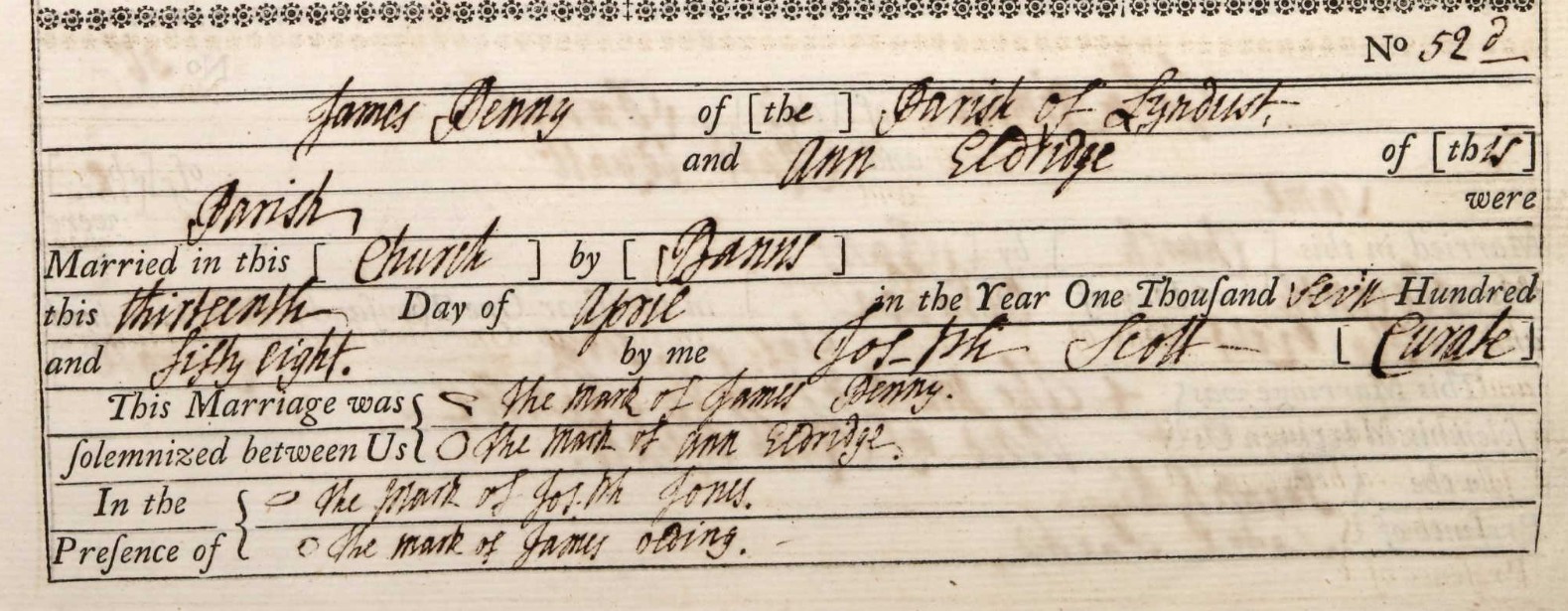
| 1758 | ||||||
| No. 52 | ||||||
| James Penny of the Parish of Lyndhurst | ||||||
| and | ||||||
| Ann Eldridge of this Parish | ||||||
| were Married in this Church by | Banns this | thirteenth Day of April in the Year One Thousand seven Hundred and fifty eight | by me | Joseph Scott | Curate | |
| This Marriage was solemnized between Us | C the Mark of James Penny | |||||
|
O the Mark of Ann Eldridge |
||||||
| In the Presence of | O the Mark of Joseph Jones | |||||
| O the Mark of James Olding | ||||||
| 13 April 1758 |
Jump back to top of Parish Records tabs
Eling 1784 to 1797
Eling 1798 to 1812
Marriages in the Eling Parish Register 1798 to 1812
xxxxxxxxxxxxxxxxxxxxxxxxxxxxxxxxxxxxxxxxxxxxxxxxxxxxxxxxxxxxxxxxxxxxx
EXAMPLE
xxxxxxxxxxxxxxxxxxxxxxxxxxxxxxxxxxxxxxxxxxxxxxxxxxxxxxxxxxxxxxxxxxxxx
| 1760 | |||||
| No 9 | |||||
| Banns of Marriage between | his name | ||||
| and | her name | ||||
| were published on the three Sundays underwritten: | |||||
| That is to say, | On Sunday, | the 12 | ) | ||
| On Sunday, | the 19 | } | October | by Ed. Morris Rector | |
| On Sunday, | the 26 | ) |
xxxxxxxxxxxxxxxxxxxxxxxxxxxxxxxxxxxxxxxxxxxxxxxxxxxxxxxxxxxxxxxxxxxxx
1792
Richard Penny and Elizabeth Stanswood
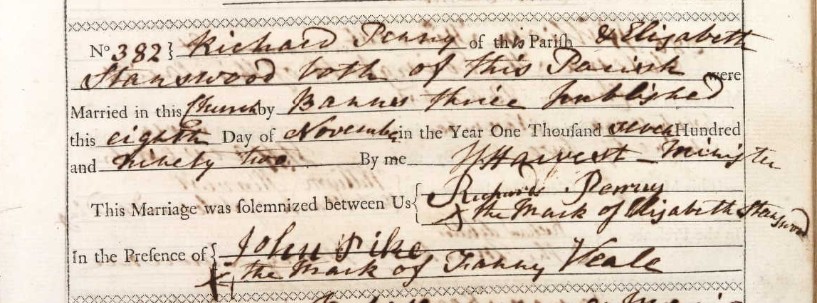
| 1792 | ||||||
| No. 382 | ||||||
| Richard Penny of this Parish | ||||||
| and | ||||||
| Elizabeth Stanswood both of this parish | ||||||
| were Married in this Church by | Banns thrice published this | eighth Day of November in the Year One Thousand seven Hundred and Ninety two | by me | H Haivest | Minister | |
| This Marriage was solemnized between us | Richard Penny | |||||
| x the Mark of Elizabeth Stanswooh | ||||||
| In the Presence of | John Pike | |||||
| x the Mark Fanny Veale | ||||||
| 8 Nov 1792 |
Jump back to top of Parish Records tabs
Jump back to top of Parish Records tabs
Burial
The Burying in Woollen Acts
I would note that within some Parish Registers, burials started to be annotated with the affidavit about being buried in wool. Below is an example of same, but for a different parish. There are similar annotations in this parish during the appropriate dates.
The Register of the Parish of the Church of Thorncombe.
One example of many.
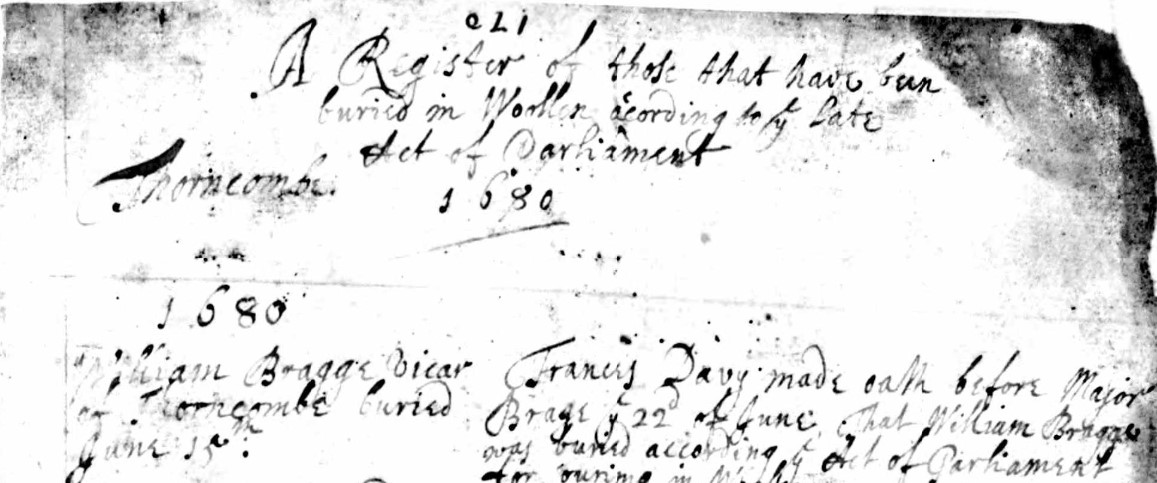
The first, well actually the second page of the register is headed;
A Register of those that have been buried in Woollen according to ?? ??? Act of Parliament Thorncombe 1680.
The primary thing to note here is that the book is indeed in relation to Thorncombe and that there is no reference to it being any other form of church, so presumably the Established Church.
The other thing of particular interest was the 'buried in Woollen according to Act of Parliament.' I had not come across this before so had to look it up. Wikipedia quickly provided an answer.
The Burying in Woollen Acts 1666–80 w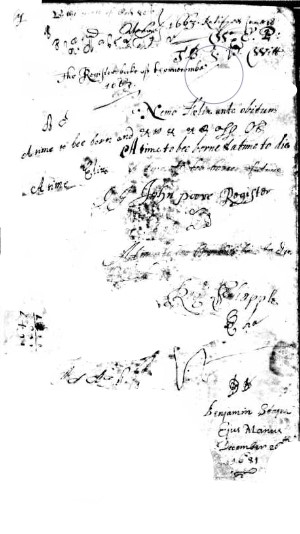 ere Acts of the Parliament of England (Cha. II c. 4 (1666), Cha. II c. 3 (1678) and Cha. II c. 1 (1680) ) which required the dead, except plague victims and the destitute, to be buried in pure English woollen shrouds to the exclusion of any foreign textiles.
ere Acts of the Parliament of England (Cha. II c. 4 (1666), Cha. II c. 3 (1678) and Cha. II c. 1 (1680) ) which required the dead, except plague victims and the destitute, to be buried in pure English woollen shrouds to the exclusion of any foreign textiles.
Enforcement
It was a requirement that an affidavit be sworn in front of a Justice of the Peace (usually by a relative of the deceased), confirming burial in wool, with the punishment of a £5 fee for noncompliance. Burial entries in parish registers were marked with the word "affidavit" or its equivalent to confirm that affidavit had been sworn; it would be marked "naked" for those too poor to afford the woollen shroud.
The legislation was in force until 1814, but was generally ignored after 1770. The 1666 Act was repealed by the Statute Law Revision Act 1863.
The next interesting title page was at the beginning of the baptisms. It was a very smudged copy so I have tried to clean it up a little, without losing any of the original writing, however it is still difficult to decipher in the whole.
However, again it confirms that the book pertains to Thorncombe and seems to commence in 1663.
'A time to be born and a time to die' is one of the lines on the page.
It is difficult to make things out on the page, but it is nearly 4 centuries old. The Mayflower sailed to America in 1620 and the monarchy had been restored in 1660 with Charles II on the throne.
Turning to the next page of the scan, there are baptisms records, in Latin commencing in 15?? followed by 1552.
Nursling 1736 to 1797
Burials in the Nursling Parish Register 1736 to 1797

Before we get into the subject matter. Above is the record of the Rector of the Parish.
1776
Jany 20th The Revd Edmund Morris, Rector of the Parish, aged 58 years.
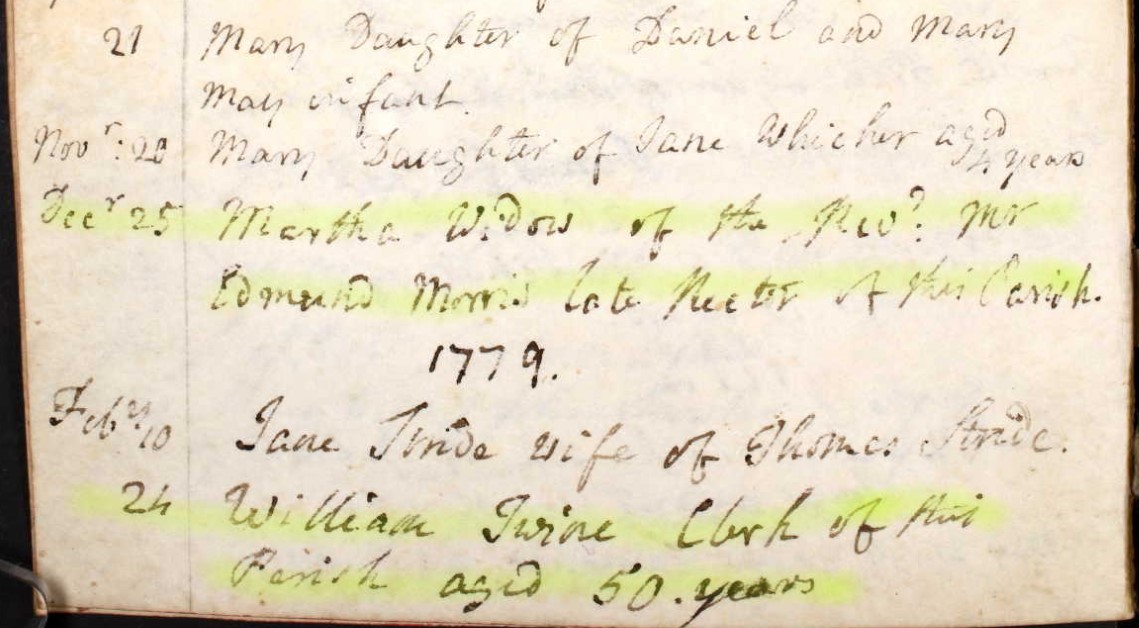
Nearly three years later his wife is buried.
Dec 25 Matha Widow of the Rev. Mr Edmund Morris late Rector of this Parish
Dec 25, 1778 Matha Widow of the Rev. Mr Edmund Morris late Rector of this Parish
Also on this page,
Feby 24 William Iwine Clerk of this Parish aged 50 . years
Feb 24, 1779 William Iwine Clerk of this Parish aged 50 . years
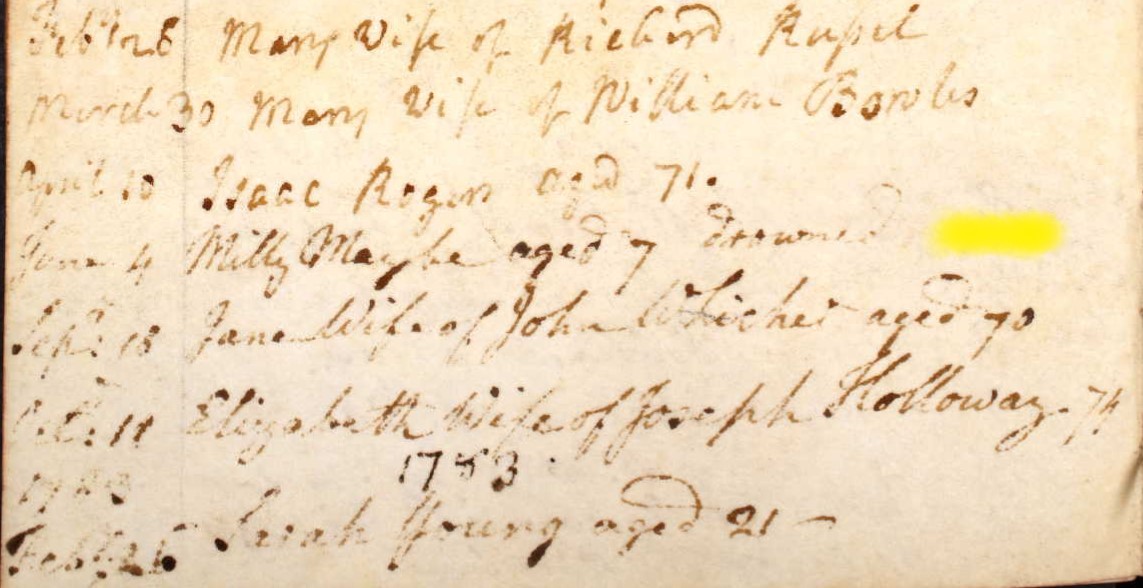
I can read this page but it is easier with the Bishops Transcription below.

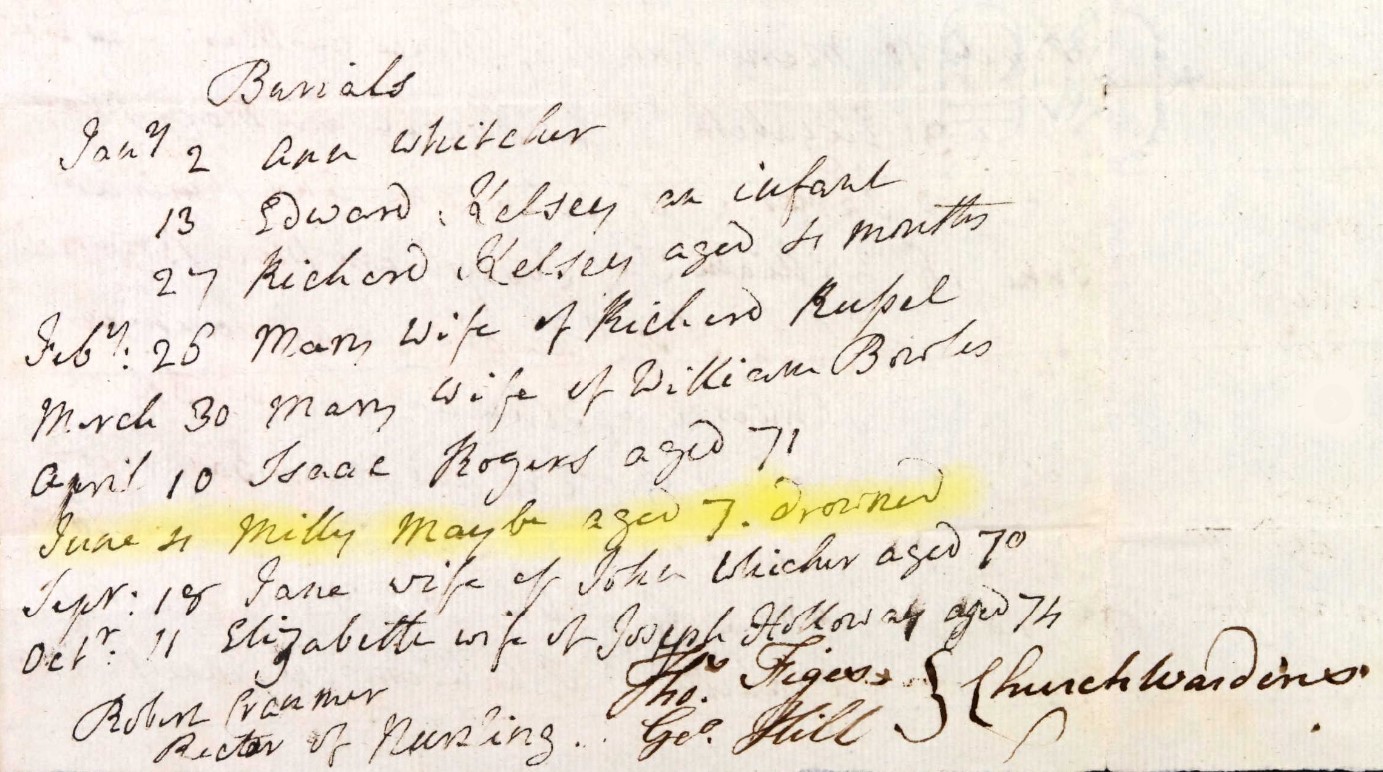
June 4 Milly Maybe aged 7. drowned
4 June, 1782 Milly Maybe aged 7. drowned
Also on page;
Robert Cranmer Rector of Nursling
Thos Figes}
Geo Hill } Churchwardens
The Churchwardens in 1782 were Thomas Figes and George Hill
1795
William Mayby
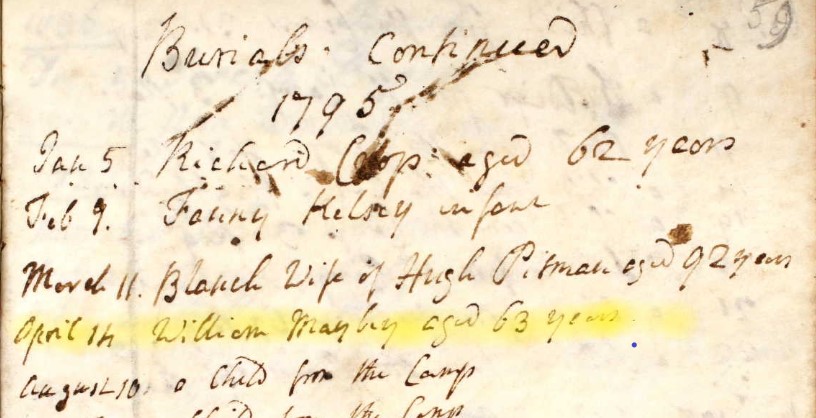
Burials, 1795
April 14 William Mayby aged 63 years
Form his stated age at burial it would suggest a birth of around 1732.
Jump back to top of Parish Records tabs
Nursling 1798 to 1812
Eling A 1798 to 1812
Eling B 1798 to 1812
Wilts West Knoyle 1813 to 1991
1819
Ann Penny
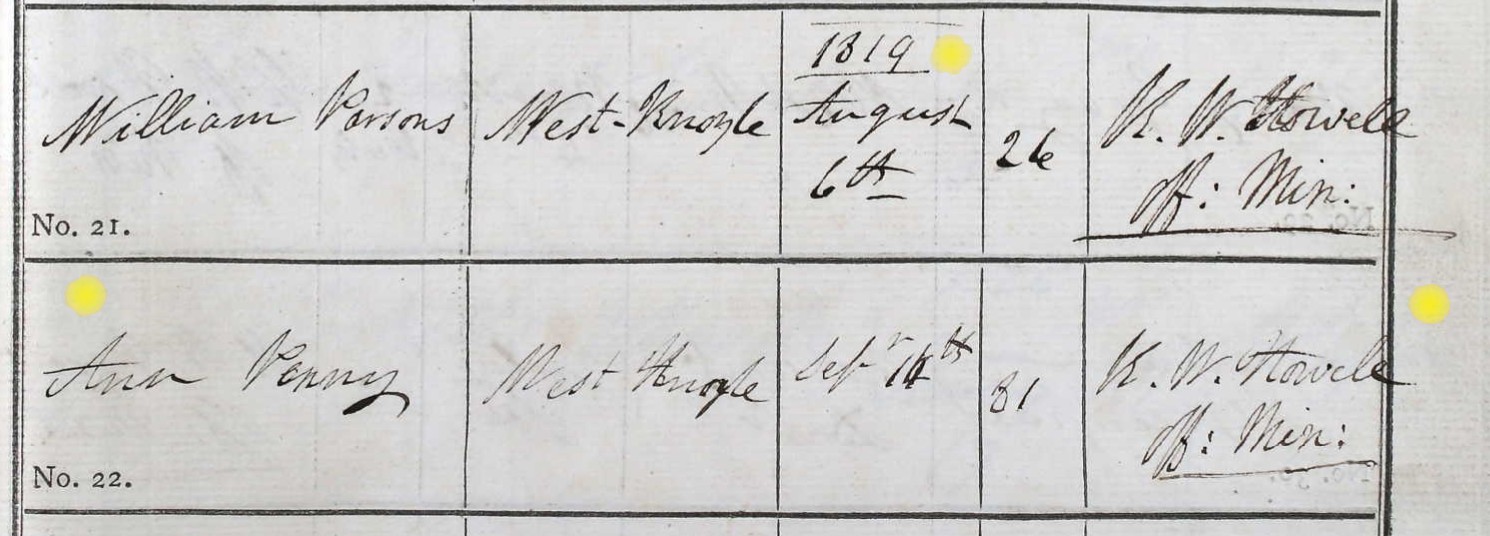
Burials in the Parish of West Knoyle, Wiltshire - Ann Penny Abode, West Knoyle was buried Sepr 14th [1819] aged 81
Jump back to top of Parish Records tabs
Other A 1798 to 1812
Jump back to top of Parish Records tabs
Census
Unlike other tab structures in this article, the Census will be organised by year of Census not by Parish.
1841
1841 Census Sunday 6th June 1841
After his death.
West Knoyle
The reason for looking at the Census in West Knoyle is that there is a record of burial for Ann Penny in the register, with the Abode stated as West Knoyle. In 1819, 22 years before this census. Was she living with her family who perhaps had moved here from Eling or Nursling?
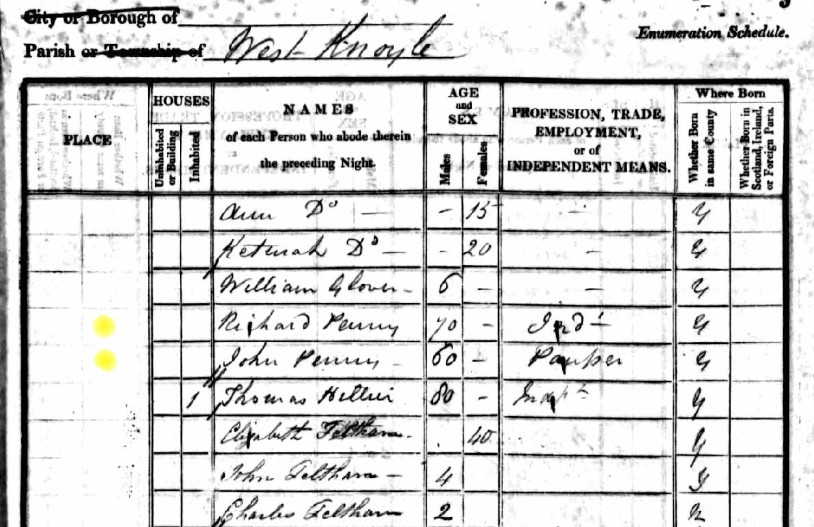
Richard Penny, male, aged 70, of Independant means, Born in same county, yes, i.e, Wiltshire
John Penny, male, aged 60, Pauper, Born in same county, yes, i.e, Wiltshire
Other surnames in building, Glover and Sanger.
Both Richard and John Penny state they were born in Wiltshire.
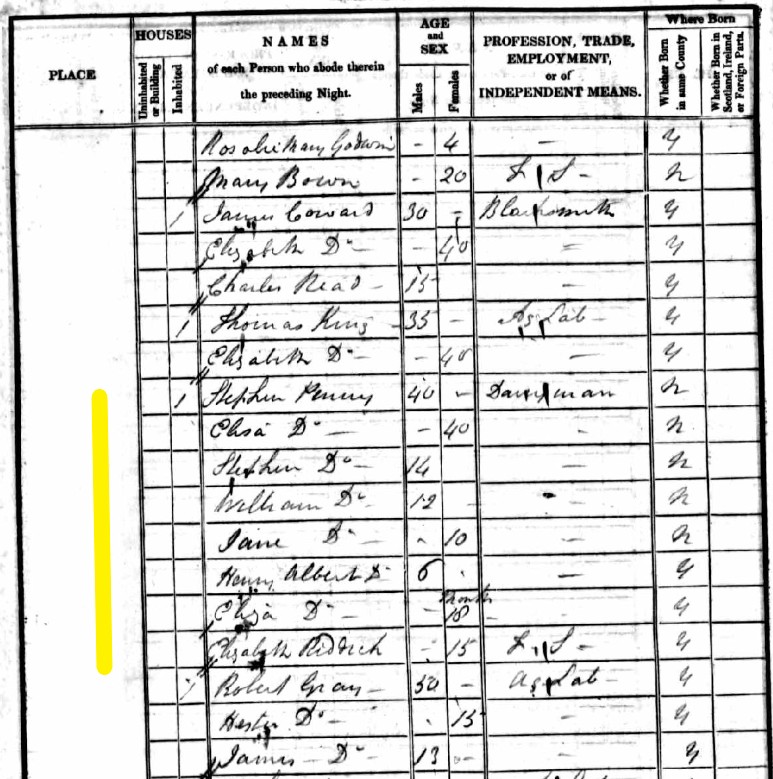
Stephen Penny, male, aged 40, a Dairyman, Born in same county, no
Elisa Penny, female, aged 40, Born in same county, no.
Stephen Penny, male, aged 14, Born in same county, no.
William Penny, male, aged 12, Born in same county, no.
Jane Penny, female, aged 10, Born in same county, no.
Henry Albert Penny, male, aged 6, Born in same county, i.e, Wiltshire
Elisa Penny, female, aged 18 months, Born in same county, i.e, Wiltshire
Other people in the building, Elisabeth Riddick, Female Servant, Born in same county, yes.
Reviewing this family, looking at the names, Stephen aged 14 might be the first boy, From where Born in same county, 'no', changes to 'yes' between Jane and Henry Albert, who were aged 10 and 6 respectively. I therefore suspect that the family moved to Wiltshire between 1831 and 1835.
This is too late for Ann Penny's burial in 1819.
From the above last two records, the only ones with surname Penny, living in West Knoyle, for the 1841 Census, it appears unlikely that Ann Penny was living with either family before her death in 1819.
A similar search for the surname Eldridge, Ann's maiden name, revealed zero results.
It could be that the Ann Penny who died in 1819 is related to Richard and John Penny mentioned in the 1841 census above, but as they were born in Wiltshire, it is possible that it is a different Ann Penny, that our Ann Penny nee Eldridge, who married James Penny. From the Ancestry Tree, James and Ann had children named John Penny, Birth 1759 • Eling, Hampshire and Richard Penny, Birth 1764 • Eling, Hampshire, England. Whereas, from the Census Richard was born about 1771, and John 1781. So, names match, but age, order of birth, and location of birth do not match. Was Ann the Mother of Richard and John from the Census, Recalibrating to 1819, Ann was 81, Richard 48, and John 38, In this scenario, Ann would have been 33 when Richard was born and 43 when John was born.
This in itself is not enough to discount the record of Ann Penny's burial, but it does not validate it as was hoped. I will expand her tree further to see if that sheds some light.
1851
1851 Census Sunday 30th March 1851
After his death.
1861
1861 Census Sunday 7th April 1861
After his death.
1871
1871 Census Sunday 2nd April 1871
After his death.
1881
1881 Census Sunday 3rd April 1881
After his death.
1891
1891 Census Sunday 5th April 1891
After his death.
1901
1901 Census Sunday 31st March 1901
After his death.
1911
1911 Census Sunday 2nd April 1911
After his death.
Jump back to top of Parish Records tabs
Other
The Camp
Other in the Nursling Parish Register 1736 to 1797
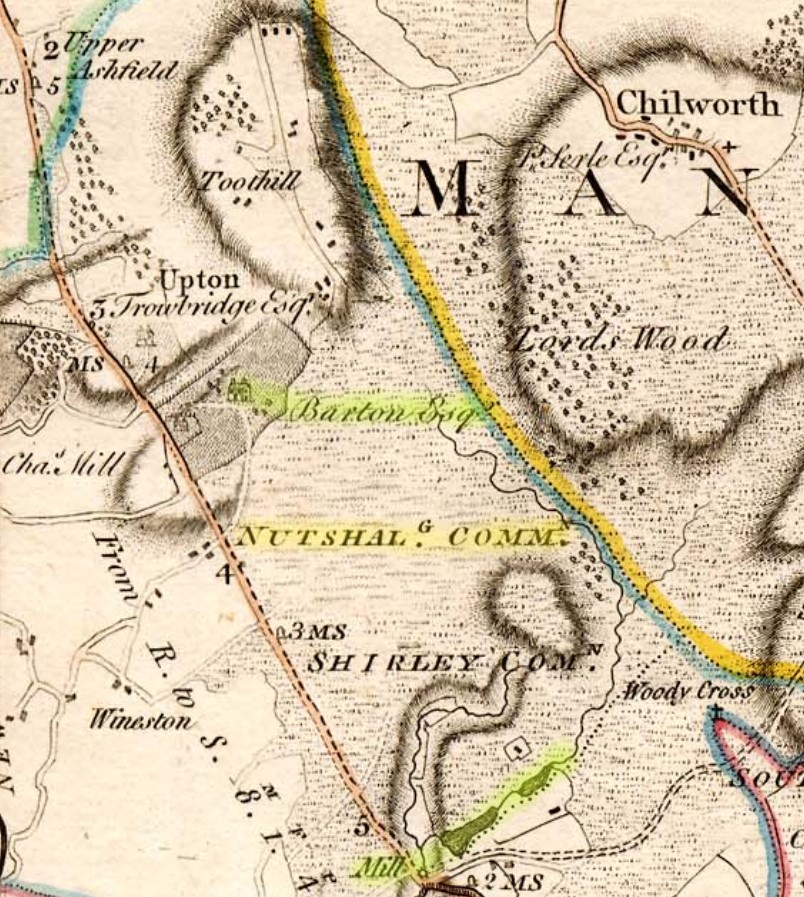
The Camp on Nursling Common, Hampshire - 1795
The Camp
In the Parish Register for Nursling, there are several references to 'the Camp' or 'from the Camp', without any clear explanation of where or what the Camp was. From context it is assumed to be a place.
The Camp, why
I have yet to find any clear reason for the Camp, but looking at the history of the time may provide some insight.
The French Revolution (1789–1799) and the French Revolutionary Wars (1792–1802) caused considerably disquiet in the politics of Britain at the time.
Armies were raised in preparation, for defense against invasion by France.
See British Regiments and the Men Who Led Them 1793-1815: the "Ephemeral Corps" 1793-1796
I assume there was a massing of families associated with those regiments within Hampshire and other Counties along the South Coast.
The Camp, evidence
This is evident in the sudden increase in baptisms and burials found in the Parish Register for Nursling.
The records refer to 'from the Camp' but don't explicitly state if that is Toot Hill Camp or some other area.
The Camp seems to have been set up sometime shortly before August 1795.
{There is a surprise towards the end}
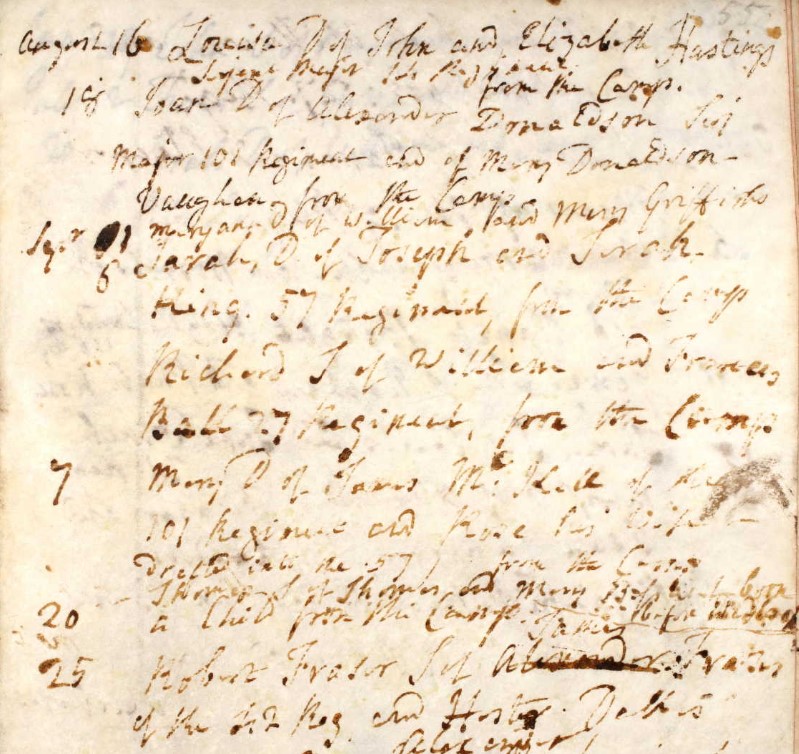
August 16 Louisa D of John and Elizabeth Hastings
18 Joan D of Alexander Donaldson Sargent Major 101 Regiment and of Mary Dodaldson-Vaughan from the Camp
Sepr 1 Maryann D of William and Mary Griffiths
6 Sarah, D of Joseph and Sarah King, 57 Regiment, from the Camp
Richard, S of William and Frances Ball 27 Regiment, from the Camp
7 Mary D of James McKell of Kings 101 Regiment and Rose his Wife - ??? the 57 , from the Camp
etc.
Two locals and four from the Camp, just in this part of the page. Before the writing becomes difficult to decipher.
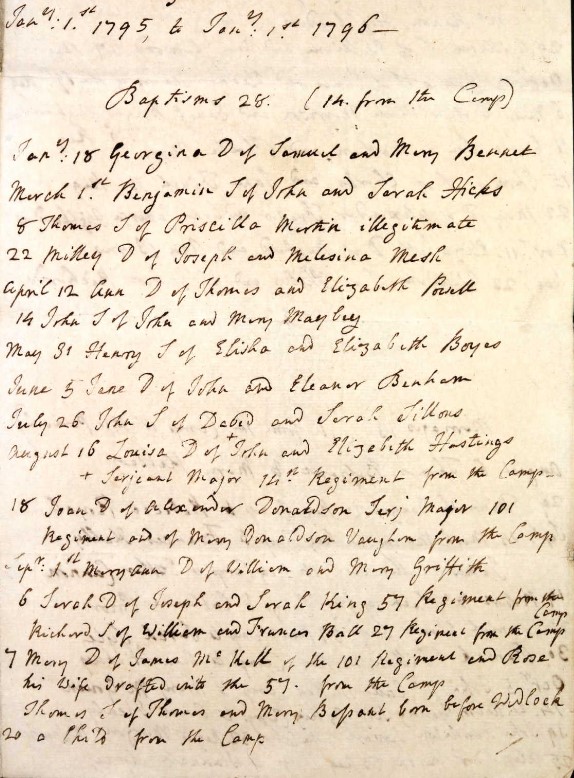
The same information as the Parish Register, but this is from the Bishop's Transcript, which in this instance is easier to read.
As a matter of note I have taken the information about Joan Donaldson and her baptism on 18th August 1795, and created a mini tree, in my Ancestry Research Tree. Using that tree I have searched for more information about her Sargent Major father within Military Records. Unfortunately, I did not get any closer to definitively finding the location of the Camp referred to in the Register.
A similar exercise for Louise Hastings, also on the 18th August 1795, and whose father is also a Sargent Major, but 14th Regiment, also failed.
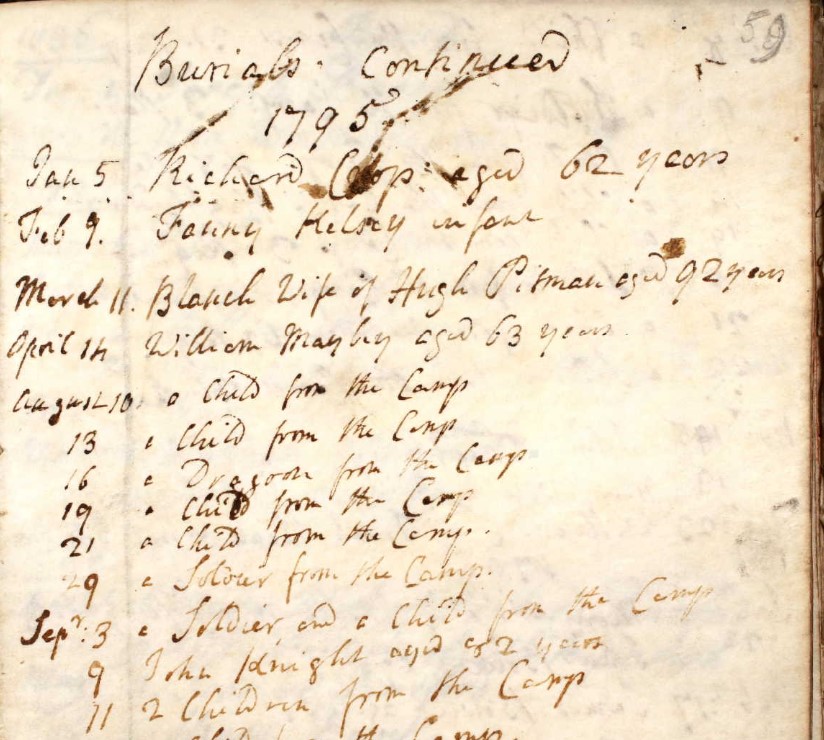
At least with the baptisms from the Camp, there were names. With these burials the records are 'a child from the Camp', 'a Dragoon from the Camp', 'a Soldier from the Camp', 'a Soldier and a Child from the Camp', '2 Children from the Camp'. I am guessing that all of these are in unmarked graves.
It is amazing to me that there are so many different regiments referred to in this camp. I wonder if it is some sort of hospital or recovery camp.
The Camp, location
At last, amongst the Marriage Records, a location for the Camp.

Marriage of Devenish Jagget and Rebecca Royal on 29 August 1795. However, the significant part for us is + belonging to 28th Regiment at Camp on Nursling Common.
The Camp is on Nursling Common. This reinforces the temporary nature of the Camp.
Nursling or Nutshalling Common is shown on Milne's Hampshire 1791 map.

Also highlighted on the above extract are the House of Barton Esq and the Mill and ponds at the bottom of the image.
From a fascinating article about The Country Houses of Southampton, which includes Rownhams House.
Rownhams House, a mid-eighteenth century red brick building set in a park of 39 acres, was greatly enlarged around 1800 by the Barton family: the brick facade of the stables was of an unusual design.
The location on the map and the above text link Rownhams House and the Barton Esq highlighted on the map.
The Mill and ponds are at the junction of Romsey Road and Old Shirley Hill / Winchester Road, by the Tanners Brook. The Mill is called Shirley Mill located at the confluence of the Hollybrook and Tanner's Brook streams, which power it. Shirley Mill had three large ponds on the Holly Brook, to the side of Winchester Road, two of which are shown on the below map. One pond, the middle one, still exists.
Both Nursling and Shirley Commons are between these two know places.
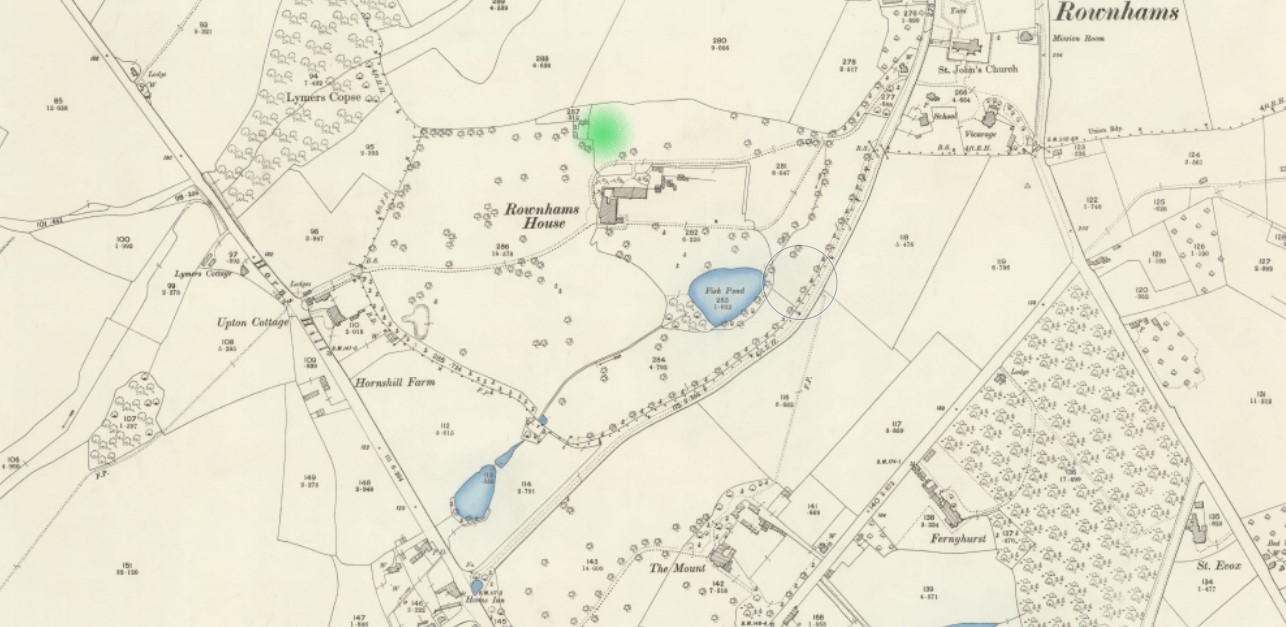
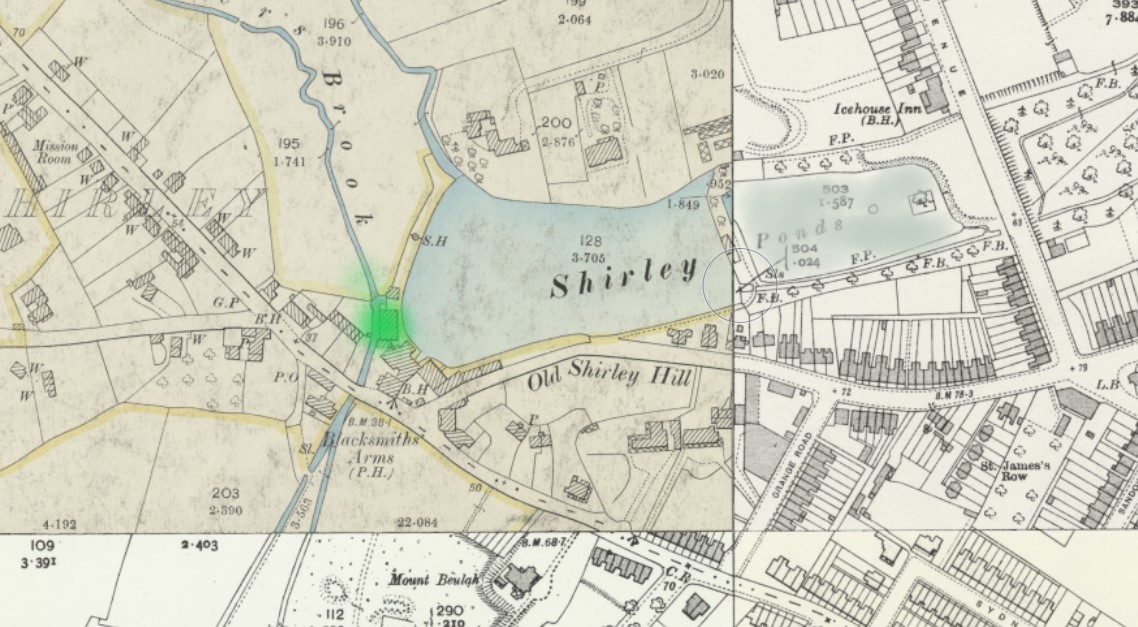
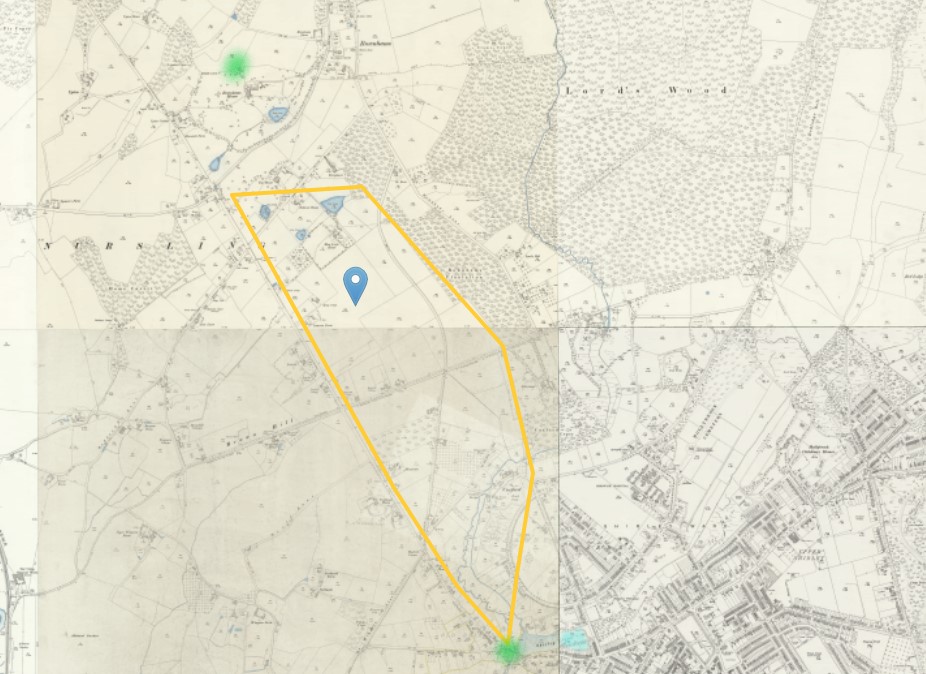
All three above maps are based on the Ordinance Survey 25" Old Maps from the National Library of Scotland.
The approximate location of Nursling or Nutshalling Common together with Shirley Common are bounded by the yellow line. In fact, Shirley Common extends further south than shown on this map.
Nursling Common is in the area of the marker on the above map.
Tithe Apportionment - Nursling - 1846
Looking at the Tithe Apportionment Map of Nursling dated 1846.
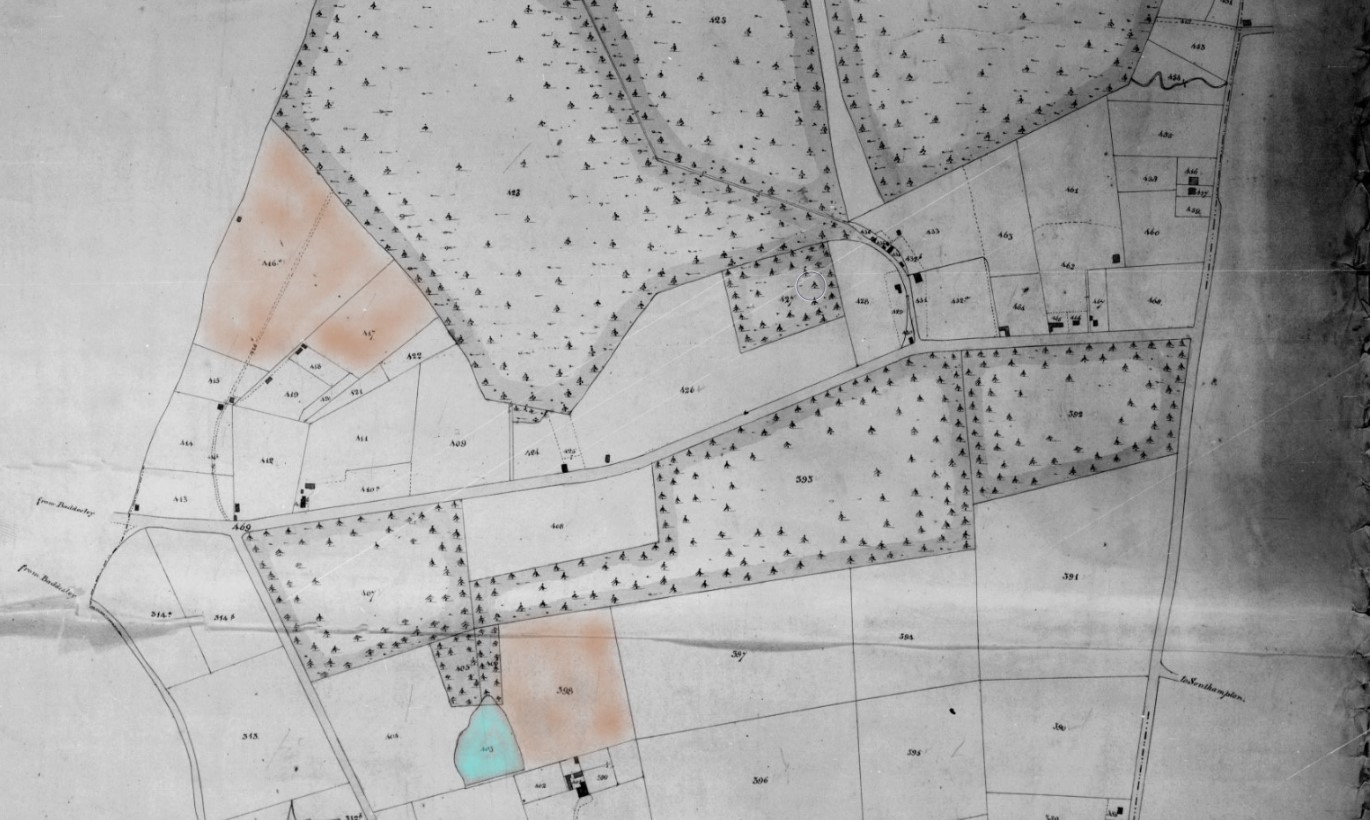
The plots described as common in the Tithe Apportionment are washed brown. However, they are not at this time actually Common.
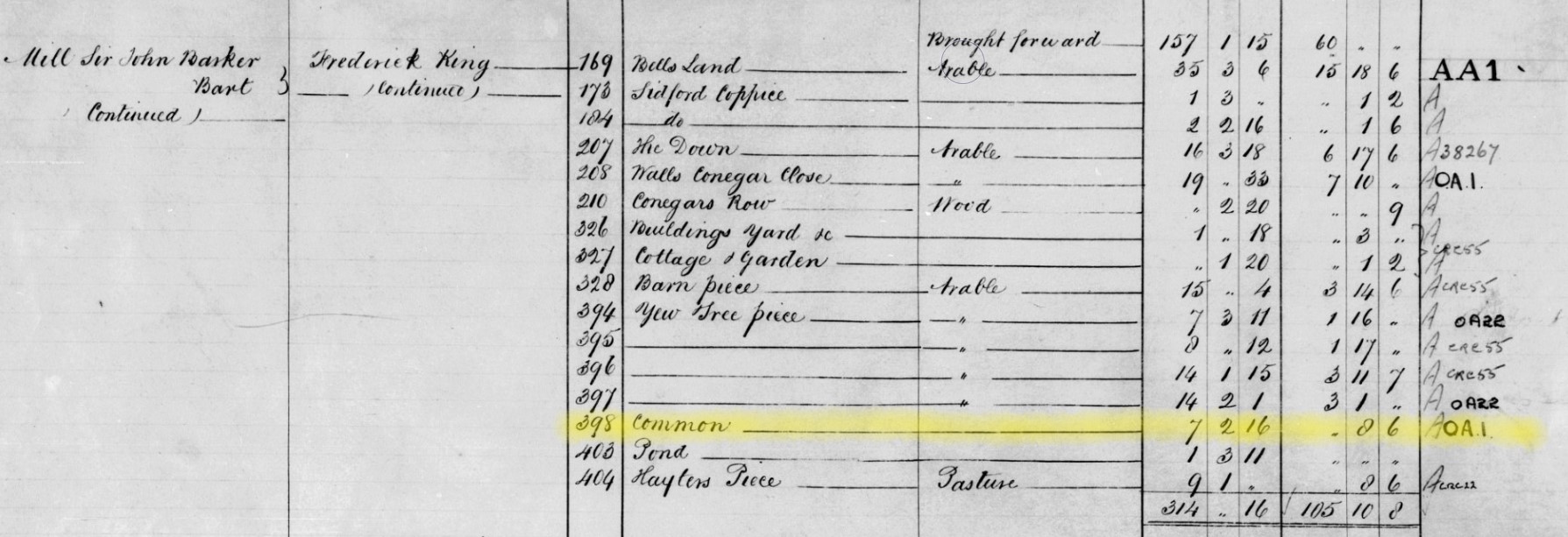

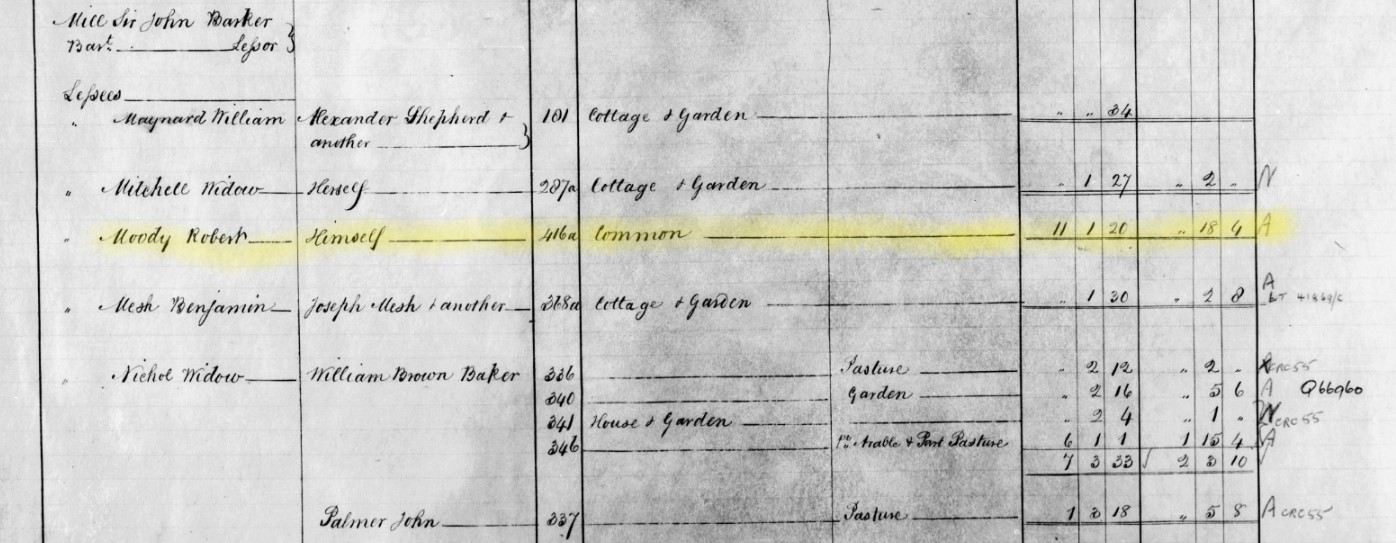
The fields are described as common but they are occupied and have a Tithe Apportionment allocated to them.
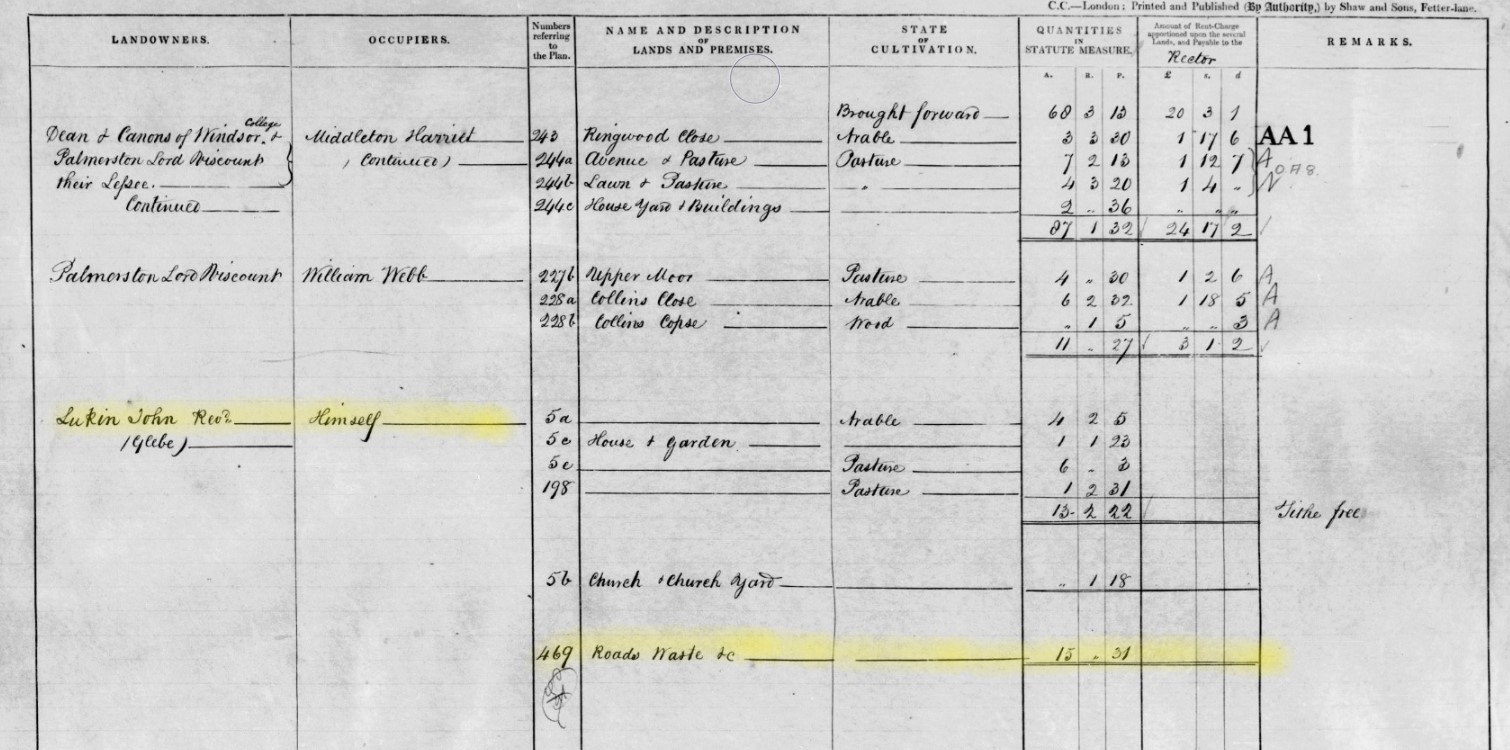
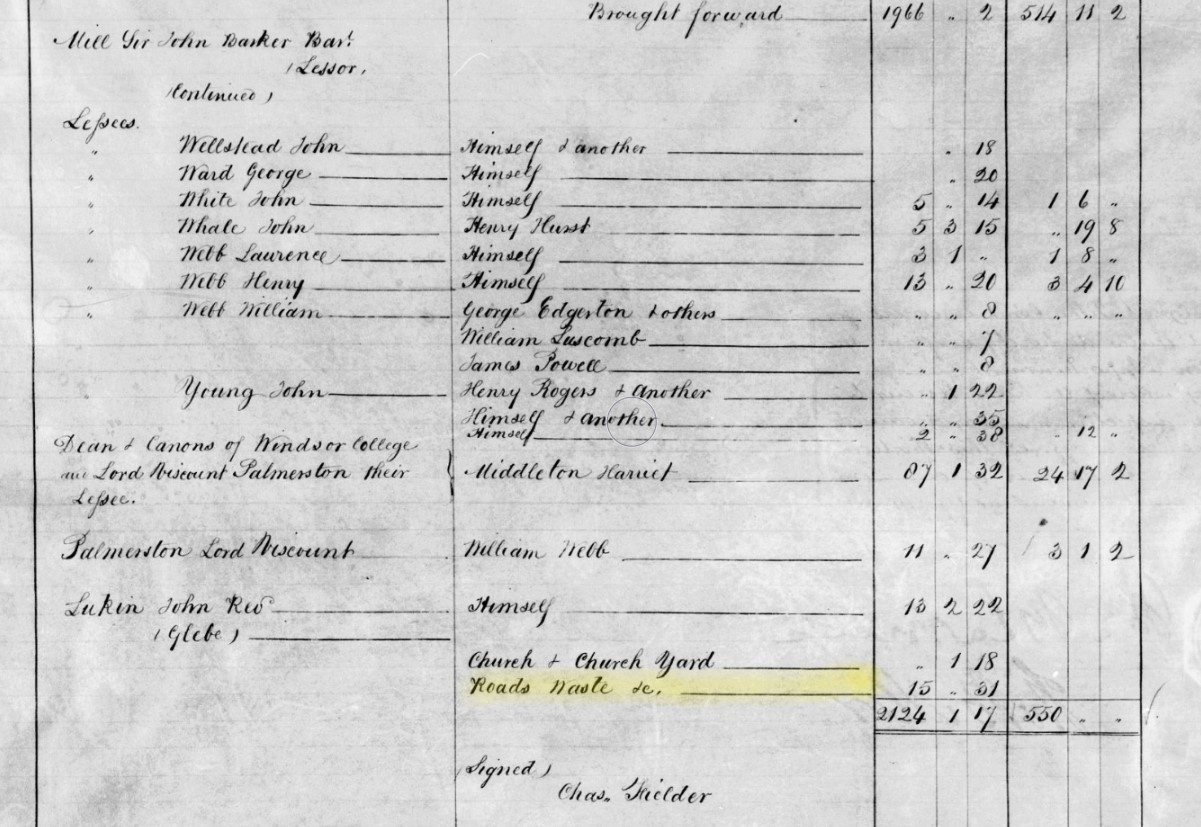
Common Land is sometimes called Waste on Tithe Apportionment. It can be seen that there is a reference to Roads, Waste etc. However, checking the Tithe Map for plot 469 I found several items, but the were all roads. None were expanses of 'waste'.
However, searching the Hampshire Records Office catalogue, I found this title;-
Agreement for the enclosure of the common fields, the demesne lands and glebe lands of Nursling and Millbrook dated 19 Jul 1756. The Tithe Apportionment Map was dated 90 years later so perhaps no surprise that there is so little evidence of the Common Lands, to be found in the Tithe Apportionment.
Hampshire Records Office also has details about leases regarding lands late of Nursling Common.
Together these might provide enough detail to firmly establish the location and extent of Nursling Common. However, until that time I will continue with the below approximation.
The Camp, data.
Baptisms
| Name | Gender | Baptism Date | Baptism Place | Father | Mother | Father's Rank | Regiment | Note |
|---|---|---|---|---|---|---|---|---|
| Louisa Hastings | Female | 16 Aug 1795 | Nursling | John Hastings | Elizabeth Hastings | Sergeant Major | ?? | from the Camp |
| Joan Donaldson | Female | 18 Aug 1795 | Nursling | Alexander Donaldson | Mary Donaldson-Vaughan | Sergeant Major | 101 | from the Camp |
| Sarah King | Female | 6 Sep 1795 | Nursling | Joseph King | Sarah King | --- | 57 | from the Camp |
| Richard Ball | Male | 6 Sep 1795 | Nursling | William Ball | Frances Ball | 27 | from the Camp | |
| Mary McKell | Female | 7 Sep 1795 | Nursling | James McKell | Rose McKell | King's 101 | from the Camp | |
| Thomas Boss | Male | 20 Sep 1795 | Nursling | Thomas Boss | Mary Boss | Drafted into 57 | a child from the Camp | |
| Robert Fraser | Male | 25 Sep 1795 | Nursling | Alexander Fraser | Hester ??? | 102 | ||
| Catherine Maclanring | Female | 25 Sep 1795 | Nursling | Alexander Maclanring | Belle Makay | Light ?? | ||
| John Campbell | Male | 27 Sep 1795 | Nursling | John Campbell | Janet Campbell-McKenon | Highlanders | ||
| William Harwood | Male | 29 Sep 1795 | Nursling | William Harwood | Ann Harwood | 27 | ||
| James Mears | Male | 2 Oct 1795 | Nursling | James Mears | Eleanor Mears | 19 | ||
| Mary Morrison | Female | 5 Oct 1795 | Nursling | William Morrison | Janet Bright | Highlanders 118 | ||
| Thomas Finch | Male | 15 Oct 1795 | Nursling | Charles Finch | Jane Finch | 31 | ||
| Mary Fraser | Female | 20 Oct 1795 | Nursling | Alexander Fraser | Jane Janeron | Highlanders |
Not all are annotated 'from the Camp' but I put that down to the scribe not wishing to continuously repeat, and waste precious paper.
Some of the writing is not very clear so some of the transcribing is a little questionable.
First entry 16th Aug 1795 and last entry 20th Oct 1795.
Fourteen Baptisms, seven boys and seven girls, in 66 days, or just over nine weeks.
Burials
| Name | Gender | Burial Date | Burial Place | Father | Mother | Father's Rank | Regiment | Note |
|---|---|---|---|---|---|---|---|---|
| A Child from the Camp | 10 Aug 1795 | Nursling | ||||||
| A Child from the Camp | 13 Aug 1795 | Nursling | ||||||
| A Dragoon from the Camp | Male | 16 Aug 1795 | Nursling | |||||
| A Child from the Camp | 19 Aug 1795 | Nursling | ||||||
| A Child from the Camp | 21 Aug 1795 | Nursling | ||||||
| A Soldier from the Camp | Male | 29 Aug 1795 | Nursling | |||||
| A Soldier and a Child from the Camp | 3 Sep 1795 | Nursling | ||||||
| 2 Children from the Camp | 11 Sep 1795 | Nursling | ||||||
| A Child from the Camp | 14 Sep 1795 | Nursling | ||||||
| A Soldier from the Camp | 22 Sep 1795 | Nursling | 90 | |||||
| A Soldier from the Camp | 26 Sep 1795 | Nursling | ||||||
| A Child from the Camp | 27 Sep 1795 | Nursling | ||||||
| A Child from the Camp | 1 Oct 1795 | Nursling | Highlander | |||||
| A Child from the Camp | 5 Oct 1795 | Nursling | 3 | |||||
| A Child from the Camp | 8 Oct 1795 | Nursling | 34 | |||||
| A Soldier from the Camp | 9 Oct 1795 | Nursling | 3 | |||||
| A Child from the Camp | 11 Oct 1795 | Nursling | ?? | |||||
| A Child from the Camp | 14 Oct 1795 | Nursling | Highlanders | |||||
| A Child from the Camp | 19 Oct 1795 | Nursling | 3 | |||||
| A Soldier from the Camp | 20 Oct 1795 | Nursling | Highlanders | |||||
| A Child from the Camp | 21 Oct 1795 | Nursling | 63 | |||||
| A Soldier from the Camp | 22 Oct 1795 | Nursling | 31 |
The writing was easier to read for this section, however, there is a distinct lack of names.
First entry 10th Aug 1795 and last entry 22nd Oct 1795.
That is 24 people buried in a duration of 74 days, or 10 1/2 weeks. More buried than baptised. Of the 24, eight were adults, and 16 were children.
Marriages
| Groom's Name | Bride's Name | Marriage Date | Marriage Place | His parish | His status | Her parish | Her Status | Rank | Regiment | Note | Type | |
|---|---|---|---|---|---|---|---|---|---|---|---|---|
| Dennish Tagget | Rebecca Royel | 29 Aug 1795 | Nursling | Nursling | Widower | All Saints, Southampton | 28 | belonging to 28th Regiment at Camp on Nursling Common | Licence | |||
| Mark Moring | Frances Kelly | 14 Sep 1795 | Nursling | Nursling | Bachelor | Nursling | Spinster | 14 | of the 14 Reg. | Banns | Y | |
| James Mallen | Esther Cannon | 4 Sep 1795 | Nursling | Nursling | Bachelor | Nursling | Widow | Sergeant | 14 | Sergeant of the 14 Regiment | Banns | Y |
| Robert McPheen | Catherine Prior | 19 Sep 1795 | Nursling | Nursling | Bachelor | Nursling | Widow | 19 | of the 19th Reg. | Licence | ||
| Daniel Elmer | Sarah Syle | 21 Sep 1795 | Nursling | Nursling | Bachelor | Nursling | Widow | Sergeant | 57 | Sert 57 Regt | Licence | |
| Patrick Dillon | Ann Hickay | 30 Sep 1795 | Nursling | Nursling | Bachelor | Nursling | Widow | Sergeant | 28 | Sert of the 28th Regt. of Foot | Licence | |
| John McCall | Mary McGouin | 5 Oct 1795 | Nursling | Nursling | Bachelor | Nursling | Widow | 14 | 14 Reg | Banns | Y | |
| William Young | Anne Healy | 14 Oct 1795 | Nursling | Nursling | Nursling | Spinster | Sergeant | 63 | Sert of the 63 Regt. of Foot | Licence | ||
| John Ferington | Margaret McLaurin | 19 Oct 1795 | Nursling | Nursling | Bachelor | Nursling | Spinster | 32 | a servant of the Col: of the 32d Reg. | Banns | Y | |
| Alexander Knox | Hannah Grey | 25 Oct 1795 | Nursling | Nursling | Bachelor | Nursling | Spinster | Sergeant | 53 | 53d Regiment Serj. | Banns | Y |
| Robert Hipperd | Penelope Riddel | 26 Oct 1795 | Nursling | Nursling | Bachelor | Nursling | Spinster | Musician | 31 | Musician of the 31 Regt | Banns | Y |
Eleven marriages in the period 29th August 1795 to 26th Oct 1795. That is just 59 days or 8 1/2 weeks.
Of the brides five were widows, and five were spinsters, with one unknown.
Five of the marriages were by Licence and six by Banns.
The Rector and his staff were very busy between 10th August 1795 (Burials) to 26th Oct 1795 (Marriages), with 49 events, plus reading of the Banns, in just 78 days, about eleven weeks.
The Camp, Regiments
From the documents above, there are people identified as being with the following regiments, in the Camp on Nursling Common in 1795.
Only the first column has been completed from the above documents, and of course there is the potential for errors in transcriptions. The remaining columns are completed by search the internet based on the data in the first column, the regimental number.
| Regiment | Full name of Regiment and Colonel(s) | Formed | End | Info link | Notes |
|---|---|---|---|---|---|
| 3 |
3rd (the East Kent) Regiment of Foot Regiment Colonel: Gen. Thomas Hall |
1572 Thomas Morgan's Company formed for service in Holland 1605 expanded to brigade of four regiments 1665 The British brigade, numbering three English and four Scottish regiments were required to take the oath of allegiance to the States-General or be cashiered. The English refused and disbanded in Holland. The Scots continued in Dutch service until 1794 when they were placed on the British establishment as The Scotch Brigade. 31 May 1665 The Holland Regiment formed in England from repatriated veterans of the three disbanded English regiments in Dutch service; also known until 1751 by the names of colonels |
1 Mar 1961 Amalgamated with The Queen's Own Royal West Kent Regiment, to form The Queen's Own Buffs, The Royal Kent Regiment. |
The regiment was sent to the West Indies in December 1795 for service in the French Revolutionary Wars. It took part in the capture of Grenada in March 1796 and of Saint Vincent in June 1796 and the capture of Trinidad in February 1797 and of various other islands in March 1801 before returning home in autumn 1802 "The Buffs landed at Yarmouth, and were subsequently encamped in that neighbourhood, form whence they were removed into quarters at Norwich. After a short stay at this place they embarked at Tilbury Fort, for Spithead, and one of the vessels ran aground at Dungeness ; the men were saved, but the vessel and the most part of the baggage were lost, This party was soon afterwards united with the remainder of the regiment, and encamped at Nursling, where the whole of the lieutenants, non-commissioned offices and soldiers of the 102nd regiment were received, to complete the establishment." "At this camp was assembled a force amounting to about eighteen thousand men, under Major-General Sir Ralph Abercromby, to complete the deliverance of the French West India islands from the power of the republican government, and to reduce to obedience the insurgents on the islands of St. Vincent and Grenada, which formerly belonged to France, but had been captured during the American war, and ceded to Great Britain by the treaty of 1783. The departure of this fleet was embarked in Indiamen of immense burden, and the BUFFS occupied two fine ships, each carrying five hundred rank and file. ..." |
|
| 14 |
14th (the Bedfordshire) Regiment of Foot Regiment Colonel: Gen. George Hotham |
22 Jun 1685 Sir Edward Hales's Regiment of Foot raised at Canterbury; also known until 1751 by other colonels, from 1747 Maj-Gen. Hon. William Herbert |
In 1809 the 14th exchanged territorial titles with the 16th Foot so that the 14th became the Buckinghamshire Regiment and the 16th the Bedfordshire Regiment. | After the 14th were part of the Duke of York's army, fighting at Famars in 1793, Valenciennes and Tournai in 1794, they were next sent to the West Indies again and suffered sickness and death there until they returned in 1803. | |
| 19 |
19th (1st North Riding of Yorkshire) Regiment of Foot Regiment Colonel: Gen. David Graeme of Gorthry |
1688 Lutrell's Regiment 19th Regiment of Foot |
Several name changes until 6 Jun 2006 United with The Prince of Wales's Own Regt of Yorkshire , and The Duke of Wellington's Regt, to form The Yorkshire Regiment (14th/15th, 19th, and 33rd/76th Foot) | 1744 - The regiment took the nickname of Green Howards in Flanders during the Wars of the Austrian Succession. As there were two regiments each commanded by a Colonel Howard, both being known as Howard's Regiment. To avoid confusion, the 3rd Foot (Thomas Howard) was named the Buff Howards, and the 19th Foot (Charles Howard) the Green Howards after the colour of their regimental facings worn on the collar and cuffs. From then on the Regiment were also known by the nickname of "The Green Howards". | |
| 27 |
27th (Inniskilling) Regiment of Foot Regiment Colonel: Gen. Eyre (Massey), 1st Baron Clarina |
26 Jun 1689 Zacharaiah Tiffin's Regiment of Foot formed at Enniskillen as Militia; also known until 1751 by the names of other colonels, from 1737 Lt-Gen. William L. (Blakeney), 1st Baron Blakeney |
1 Jul 1881 United with 108th Regiment of Foot (Madras Infantry), to form The Royal Inniskilling Fusiliers |
Archive.org - The historical record of the 27th Inniskilling regiment. by Trimble, William Copeland |
In July, 1795, the 27th embarked at Portsmouth with four other regiments, under General Graham Campbell, for the purpose of co-operating with a body of emigrants against Chouans, which had made a descent at Quideron, under M. de Puisage and Count Sombreuil. The ships were long beating down the Channel, and having at last reached the French coast, they fell in with the Anson frigate, which acquainted them of the disastorous event at Quiberon. The troops in consequence returned to England ; the 27th to Southampton, where it encamped. The regiment was there again completed to their establishment by drafts from several of the newly raised corps. Sir Ralph Abercrombie having assumed the command of a numerous armament then preparing for an expedition to the West Indies, the 27th was again embarked for that service. November 11. -- The embarkation of the whole of the troops being now complete, the fleet, amounting to upwards of 300 sail, got under weigh with a favourable breeze; but in consequence of the flag-ship Impregnable having struck on a sand rock, a signal for recall was made, and the fleet ordered to come to anchor. On the 15th November, the fleet again weighed anchor and sailed ; but scarcely had it cleared the Channel, when it was dispersed and driven back by furious gale, and with the loss of several ships and many hundred lives. Another attempt was made to put to, and as the fleet was clearing the Channel on the 13th a violent storm commenced, and continued with unabated violence for many weeks. The admiral (Christian), however, persevered until the end of January, when the disabled state of such of the ships as kept with him rendered it impossible to remain longer at sea : he therefore made a signal to run for Portsmouth, where he arrived on the 29th January, 1796. The transports of the 27th anchored at Portsmouth the same day, after being upwards of seven weeks at sea. On the 4th of March the fleet under Admiral Christian finnaly sailed and arrive at Barbadoes, and the next day appeared off St. Lucia. The 27th Regiment landed on the 9th of May, 1756, and it was, on the 21st of May, placed under the command of that great officer and superb soldier, Sir John Moore, a major-general in Sir Ralph Abercombie's army. ... The commander of the forces ordered that the 27th Regiment, in consequence of their gallant conduct, should take possession of Morne Fortuné, and that the French garrison (about 2000) should march out and lay down their arms to the regiment on the glacis. Sir Ralph further directed that the king's colours of the Inniskilling regiment should be displayed on the flag-staff of the fort for one hour previous to hoisting the usual union flag. After the capture of St. Lucia the regiment was sent to reinforce the garrison of Grenada. Letter from Horse Guards Horse Guards, 6th April, 1836. Sir I have the honour to acquaint you, by direction of the General commanding-in-chief, that his Majesty has been graciously pleased to permit the 27th Enniskillen Regiment of Foot to bear on its colours and appointments, in addition to any other badges or devices which may have heretofore been authorised, the words 'St. Lucia;' in commemoration of the gallant conduct evinced by the 27th Regiment on the 24th May, 1796, in the attack upon Morne Fortuné, which led to the surrender of the island of St. Lucia on the 26th of that month. I have the honour, etc., John Macdonald Adjutant-General |
| 28 (28 Regt. of Foot) |
28th (the North Gloucestershire) Regiment of Foot Regiment Colonel: Gen. Robert Prescott |
12 Feb 1702 Sir John Gibson's Regiment of Foot also known until 1751 by the names of other colonels. From 10 Oct 1734 Lt-Gen. Philip Bragg |
1 Jul 1881 United with 61st (South Gloucestershire) Regiment of Foot, to form The Gloucestershire Regiment | The regiment returned to Flanders following the outbreak of war with revolutionary France in 1793, before moving to the West Indies two years later. A detachment also remained in Gibraltar before being moved to Minorca in 1798. | |
| 31 |
31st (the Huntingdonshire) Regiment of Foot Regiment Colonel: Gen. Henry (Phipps), 1st Earl of Musgrave, GCB |
14 Mar 1702 George Villiers's Regiment of Marines From 8 May 1749 Lt-Gen. Henry Holmes |
1 Jul 1881 United with 70th (Surrey) Regiment of Foot , to form The East Surrey Regiment |
Following a spell of home service, it was sent to the West Indies in 1794, where it helped take Martinique (1794), Guadeloupe (1794) and Saint Lucia (1796) from the French. But in 1797, having lost all but 85 men to yellow fever, it was forced to return home to re-recruit. 1795 - Returned to England 1796 In this year the regiment returned to England, and landed at Plymouth on 27th February, 1795. A camp was formed in the month of August, at Nursling, near Southampton, which the THIRTY-FIRST regiment joined on the 25th of that month, and received a reinforcement to its strength in drafts from the 43rd, 88th, 92, and 94th regiments, which raised its establishment to 1000 rank and file, with a second lieutenant-cornel, a major, and one additional lieutenant to each company, besides two recruiting companies. On the 25th of October, 1795, the THIRTY-FIRST regiment embarked for the West Indies, as part of the armament which had been prepared for the deliverance off the French West India Islands from the power of republicanism, and to reduce to obedience the insurgents of St. Vincent and Grenada. The expedition, commanded by Lieut-General Sir Ralph Abercromby, sailed with the immense fleet, under the convoy of a squadron of the Royal Navy, commanded by Rear-Admiral Sir Hugh Cristian. The troops amounted to about 25,000 men, in the highest state of equipment.
|
|
| 32 |
32nd (the Cornwall) Regiment of Foot Regiment Colonel: Lt-Gen. William Amherst |
12 Feb1702 Edward Fox's Regiment of Marines also known as 3rd Regiment of Marines; also known until 1751 by the names of other colonels 1713 disbanded in England 1714 Jacob Borr's Regiment of Foot re-formed |
1 Jul 1881 United with 46th (South Devonshire) Regiment of Foot, to form The Duke of Cornwall's Light Infantry |
In 1796 the regiment was deployed to Saint-Domingue as part of the response to a rebellion there but one of the transport ships was captured by the French Navy and some soldiers from the regiment, along with Lieutenant General Frederick Wetherall, became prisoners of war. 1795 After waiting some time, expecting fresh transports, the regiment was ordered to Cork, and thence to Spike Island into camp -- as the writer of the foregoing extract says, "a nasty boggy place" -- and was there when the 105th and 113th regiments mutinied, "which was near being a very serious business, but by Genl. Massey's exertion they all laid down there armes. there were near 2,000 men that mutinied." Note:- Whilst there is evidence of the 32 at Plymouth, Cork, Spike Island and the West Indies, that does not place them at Nursling. |
|
| 34 |
34th (the Cumberland) Regiment of Foot Regiment Colonel: Lord Frederick Cavendish |
12 Feb 1702 Lord Lucas's Regiment of Foot also known until 1751 by the names of other colonels 1713 disbanded 1715 re-formed without loss of precedence, and officers restored to former rank |
1 Jul 1881 United with 55th (Westmorland) Regiment of Foot, to form The Border Regiment |
On the breaking out of the French revolutionary war, the establishment of the regiment was augmented. In 1793 a British army proceeded to Flanders ; but the THIRTY-FOURTH remained in Great Britain until the middle of February, 1795, when they embarked for the West Indies. Previous to this date the revolutionary principles, which had involved France in anarchy and crime, had extended to the French West India islands ; but the planters of these colonies had been delivered from the power of the republicans by British armament, under General Sir Charles (afterwards Earl) ; the THIRTY-FOURTH Regiment, commanded by Lieutenant-Colonel Dickens, proceeded to St, Lucia, which island had been captured from the French in April, 1794. ... Early in 1796, additional forces arrived at the West Indies, where Lieutenant-General Sir Ralph Abercromby assumed the command of an armament to complete the deliverance of the West India islands from the power of the republicans, and to reduce to obedience the insurgents of St. Vincent and Grenada. |
|
| 53 |
53rd (the Shropshire) Regiment of Foot Regiment Colonel: Gen. Gerard (Lake), 1st Viscount Lake |
21 Dec 1755 55th Regiment of Foot raised in north of England 25 Dec 1756 53rd Regiment of Foot renumbered upon disbandment of 50th Regiment and 51st Regiment |
1 Jul 1881 United with 85th, or The King's Regiment of Light Infantry (Bucks Volunteers), to form The King's Light Infantry (Shropshire Regiment) |
The regiment returned to England in spring 1795 but then embarked for the West Indies in November 1795 where it took part in the capture of Saint Lucia in May 1796. It also helped suppress an insurrection by caribs on Saint Vincent in June 1796; expeditions to Trinidad and Puerto Rico followed in February 1797 and April 1797 respectively. The regiment returned home in 1802. A sever frost having rendered the rivers passable on the ice, the British troops retired through Holland to Germany. The FIFTY-THIRD shared in the toil, privation, and suffering occasioned by long marches through a country covered with ice and snow : in the spring of 1795 they embarked for England, where they arrive in May. The regiment was encamped near Southampton where its ranks were completed by drafts from the 109th regiment ; in November it embarked for the West Indies, and afterwards sailed with the armament under General Sir Ralph Abercromby, for the conquest of the French West India Islands. The disasters which befell this fleet from storms at sea, and the number of shipwrecks which took place, are recorded in the history of great Britain. Four companies of the regiment commended by Major Brisbane, arrive at Barbadoes in March, 1796, and they formed part of the armament which proceeded against St. Lucia.
|
|
| 57 |
57th (the West Middlesex) Regiment of Foot Regiment Colonel: Gen. John Campbell (of Strachur) |
The regiment started out as the 59th Regiment of Foot raised in Gloucester in 1755. After the disbandment of the 50th Regiment of Foot and the 51st Regiment of Foot in 1756, it became the 57th Regiment of Foot. In 1782, it was given a county connection, becoming the 57th (the West Middlesex) Regiment of Foot. | 1881 |
Historical Records of the Fifty-seventh, Or, West Middlesex Regiment of Foot |
The 57th moved to Nova Scotia in October 1783 and returned to England in November 1790. In 1793 the regiment embarked for the Low Countries for service in the Flanders Campaign and re-enforced the garrison at Nieuwpoort for some months before returning home later in the year. The regiment returned to Flanders in 1794 before returning home again in 1795. In 1881 it was united with the 77th (East Middlesex) Regiment of Foot to form The Middlesex Regiment. |
| 63 (63 Regt. of Foot) |
63rd (the West Suffolk) Regiment of Foot Regiment Colonel: Gen. Alexander (Lindsay), 6th Earl of Belcarres |
21 Apr 1758 63rd Regiment of Foot formed by redesignation of 2nd Battalion, 8th (The King's) Regiment 31 Aug 1782 63rd (the West Suffolk) Regiment of Foot |
1 Jul 1881 |
In 1794 the regiment joined British forces already taking part in the Flanders Campaign. The regiment was involved in a number of actions before the British forces withdrew from the Netherlands in 1795. 1795. It appears by the following certificate that the regiment lost some of its baggage in Holland.
1881.07.01 united with 96th Regiment of Foot, to form The Manchester Regiment |
|
| 90 |
90th Regiment of Foot Regiment Colonel: Gen. Thomas (Graham), 1st Baron Lynedoch, GCB, GCMG |
10 Feb 1794 Raised in Scotland as a light infantry corps |
1 Jul 1881 |
On the 29th July, [1794] the regiment arrived at Netley camp, where it was joined with several parties of recruits and those officers who had been absent on duty. While in the camp it was announced in orders that the 90th would be among those regiments to be employed on service, when the commandant took occasion to recommend to all classes the most unremitting attention to every point of duty and the most strict and prompt obedience, expressing his determination to make the conduct and character of individuals of every rank the only title to indulgence or promotion, as far as it depended upon him to give or recommend it. On the 6th November, the regiment marched to Winchester, where it was inspected by the Earl of Moira, who expressed his satisfaction at its appearance, and added that it afforded him great pleasure to be able to make so favourable a report of its state to His Majesty. [1795] During its stay at Winchester, colours were presented to the 1st battalion — the anniversary of the King's birthday, the 4th of June, being chosen for the purpose. Colonel Graham, who presented them, addressed his Corps. The 90th was inspected on the 5th of July by His Royal Highness the Duke of York, who conveyed to Colonel Graham his orders to thank the officers and men, in his name, for the handsome appearance they made. Shortly after the regiment moved to Nursling camp, whence it marched to Southampton, there to await the departure of the expedition to co-operate with the French Royalists, of which it was to form part. Alter several delays the troops were embarked on board the ships commanded by Commodore Warren, the land force being under the command of General Doyle, and the expedition, accompanied by the Comte d'Artois, started on the 18th of August for the coast of France, where it was proposed to land the regiments of French emigrants with a view to their joining the forces of General Charette, one of the royalist leaders, in La Vendee.
881.07.01 United with 26th (The Cameronian) Regiment of Foot, to form |
|
| 101 |
101st Regiment of Foot Regiment Colonel: Col. William Fullarton |
10 Mar 1794 Raised in Ireland |
1795 | Regiments.org 101 | Disbanded |
| 102 | 102nd Regiment of Foot Trench's Regiment of Foot, and was informally known as the "Irish Rangers". Regiment Colonel: Lt-Gen. Eyre Power Trench |
31 Oct 1793 Raised in Ireland |
1795 | Regiments.org 102 | Disbanded at Nursling (personnel drafted into 3rd Regiment) |
| King's 101 | Regiment Colonel: | Too little information to identify | |||
| Highlanders | Regiment Colonel: | Too little information to identify | |||
| Highlanders 118 | Too little information to identify | ||||
| Light ?? | Possibly 90th Regiment of Foot, above | Too little information to identify | |||
I started filling this table in from the bottom, starting with the 102 and 101. As I progress up the page I found out the reason for the camp, explained towards the end of this article. That made searching for relevant information easier, and completing more of the story on the regiments. I know that is upside down.
The Camp, Marriage Banns
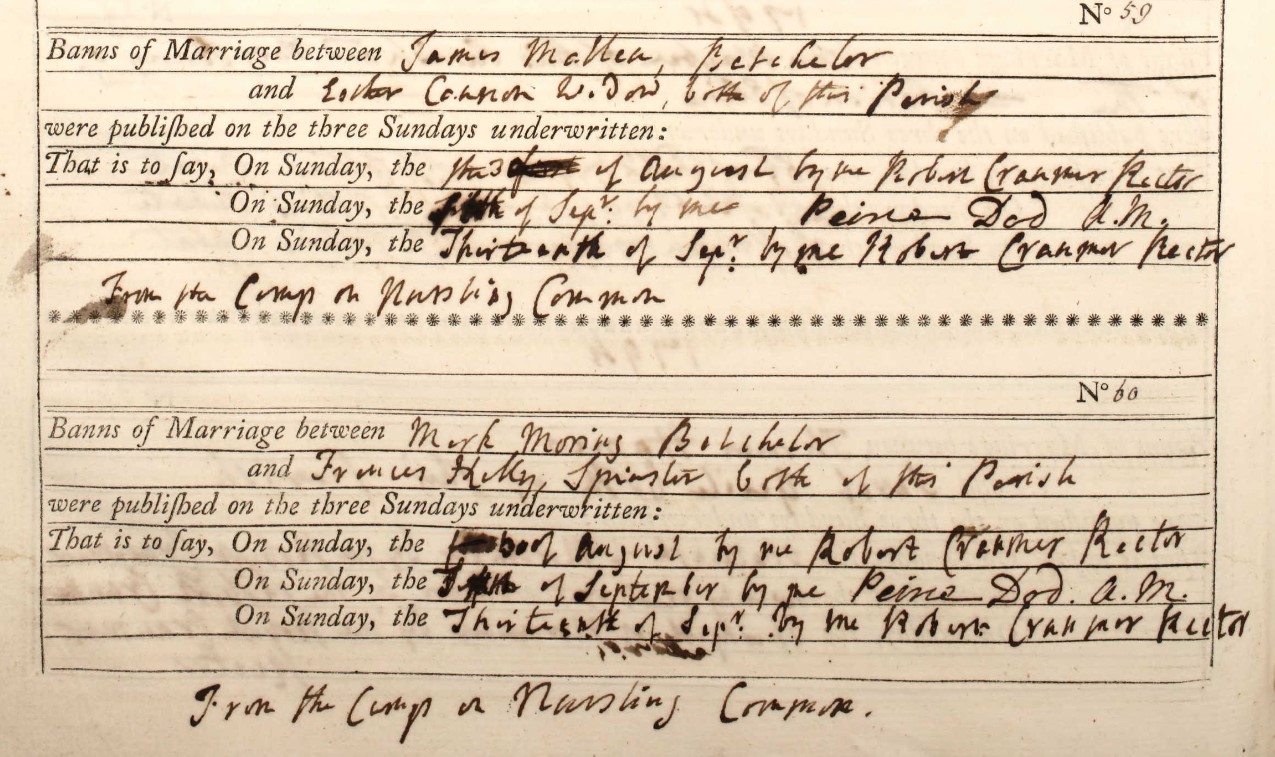
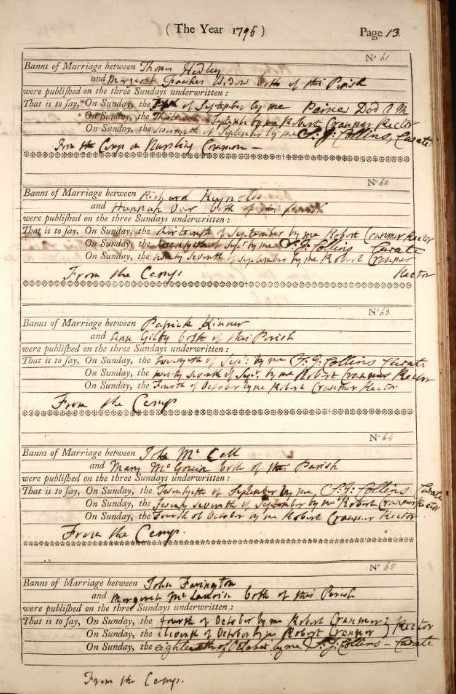
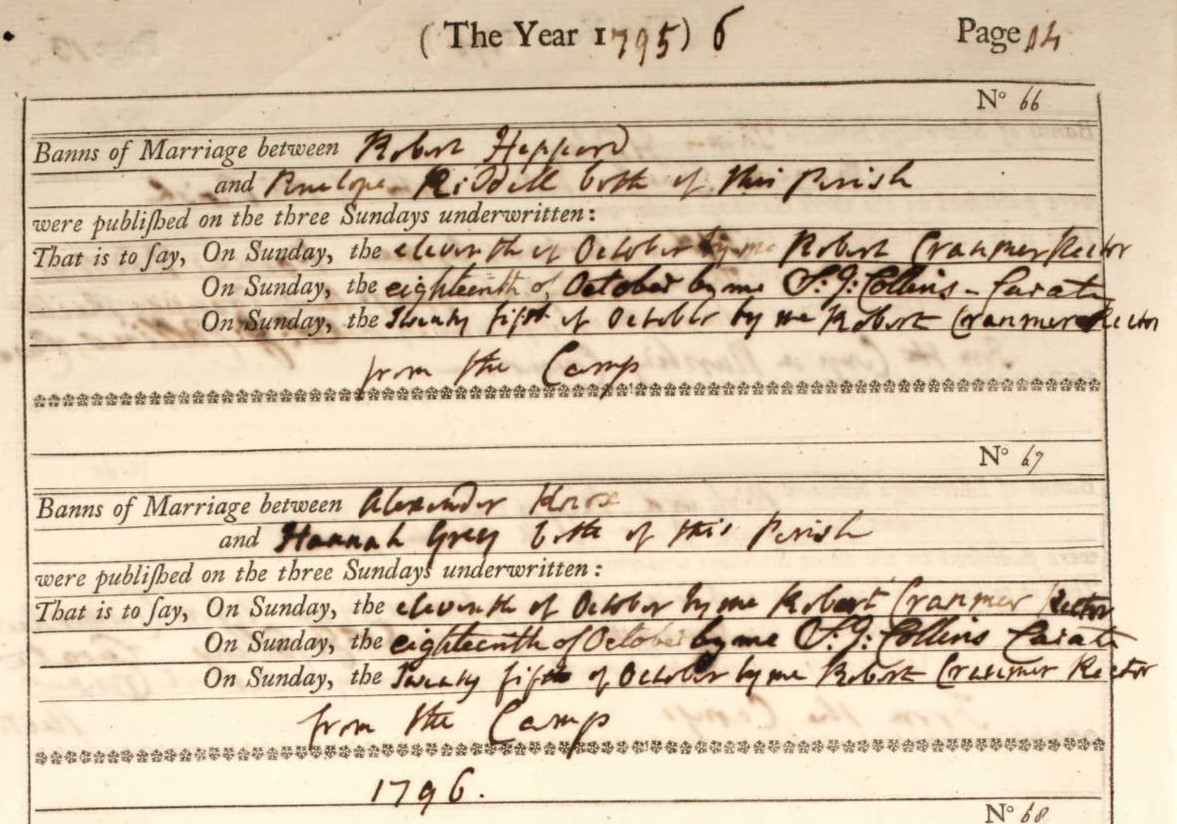
Note the further confirmation that the Camp is on Nursling Common.
There are nine sets of reading the Banns on the three pages above, but only six marriages by Banns in the Data above.
The following couples appear not to have made it into my Marriages data section
Thomas Hedley and Margaret Fawkes
Richard Reynolds and Hannah Over
Patrick Kinner and Ann Gilby
I will do some more research into these couples.
The Camp - The Great Push
The questions are all resolved thanks to two chapters in Soldiers, sugar, and seapower : the British expeditions to the West Indies and the war against revolutionary France by Duffy, Michael.
I am no longer looking for a small camp somewhere on Nursling Common. It was a vast undertaking, perhaps taking a significant part of the whole common.
I will precis the history gained from Chapters 7 and 8, together with other sources.
Industrial Revolution - 1750
Agricultural Revolution - 1670 - 1770
Canals - 1750 - 1900
Background - The Second Hundred Years' War. Perhaps the the First World War, with the Great War, 1914- 1918 being the second.
The Second Hundred Years' War is a periodization or historical era term used by some historians to describe the series of military conflicts around the globe between Great Britain and France that occurred from about 1689 (or some say 1714) to 1815, including several separate wars such as the Nine Years' War, the War of the Spanish Succession, the War of the Austrian Succession, the Seven Years' War, the American Revolutionary War and the French Revolutionary and Napoleonic Wars. The Second Hundred Years' War is named after the Hundred Years' War, which occurred in the 14th and 15th century. The term appears to have been coined by J. R. Seeley in his influential work The Expansion of England (1883).
The series of wars began with the accession of the Dutch William III as King of England in the Revolution of 1688. The Stuarts had sought friendly terms with Louis XIV: James I and Charles I, both Protestants, had avoided involvement as much as possible in the Thirty Years' War, while Charles II and the Catholic convert James II had even actively supported Louis XIV in his War against the Dutch Republic. William III, however, sought to oppose Louis XIV's Catholic regime and styled himself as a Protestant champion. Tensions continued in the following decades, during which France protected and supported Jacobites who sought to overthrow the later Stuarts and, after 1715, the Hanoverians. The principal Anglo-French conflicts in this time period were the Nine Years' War and the War of Spanish Succession. The war of Spanish Succession saw Britain begin its ascendancy as a commercial and naval power, but after the Peace of Utrecht, the two formed an Anglo-French alliance, their interests converging as they wished to prevent the rise of Spanish or Russian power. The alliance soon fell apart, and the two countries soon became bitter rivals once again.
After William III, the rivalry between the two countries shifted from being primarily about religion to being primarily about trade, colonies, and maintaining a balance of power. The primary conflicts in this time period between Britain and France were, in order: The War of the Austrian Succession, The Carnatic Wars, The Seven Years' War, and the American Revolutionary War. By the end of the Seven Years war, Britain decisively overtook France as Europe's greatest power, destroying French colonial power in India and North America. Yet France took advantage of American Revolutionary War to undermine British colonial hegemony in North America by supporting the rebellious colonists with both men and material, but debts from that conflict in turn sowed the economic seeds of France's own revolution shortly thereafter.
The Seven Years' War (1756–1763) was a global conflict involving most of the European great powers, fought primarily in Europe and the Americas. One of the opposing alliances was led by Great Britain and Prussia. The other alliance was led by France and Austria, backed by Spain, Saxony, Sweden, and Russia. The French and Indian War (1754–1763), the Anglo-Spanish War (1762–1763), and the Spanish–Portuguese War (1762–1763) were all parts of the Seven Years' War.
The War of the Austrian Succession ended in 1748, but failed to resolve ongoing tensions between the European powers. Continuing colonial disputes between Britain and France in North America resulted in the outbreak of the French and Indian War in 1754. Following the realignment of traditional alliances in the so-called 1756 Diplomatic Revolution, Prussia allied with Britain, while the long running French–Habsburg rivalry ended when Austria signed a treaty with France.
Spain entered the war on the French side in 1762, unsuccessfully attempting to invade Britain's ally Portugal in what became known as the Fantastic War. Spain lost Havana in Cuba and Manila in the Philippines to Britain, but they were returned in the 1763 Treaty of Paris.
In Europe, the large-scale conflict that drew in most of the European powers was centred on the desire of Austria to recover Silesia from Prussia. The Treaty of Hubertusburg ended the war between Saxony, Austria, and Prussia in 1763. France's supremacy in Europe was halted, while Prussia confirmed its status as a great power, challenging Austria for dominance within the Holy Roman Empire, thus altering the European balance of power.
The Anglo-French War, also known as the War of 1778 or the Bourbon War in Britain, was a military conflict fought between France and Great Britain, sometimes with their respective allies, between 1778 and 1783. As a consequence, Great Britain was forced to divert resources used to fight the American War of Independence (the rebellion by the Thirteen Colonies in North America) to theatres in Europe, India, and the West Indies, and to rely on what turned out to be the chimera of Loyalist support in its North American operations. From 1778 to 1783, with or without their allies, France and Britain fought over dominance in the English Channel, the Mediterranean, the Indian Ocean and the Caribbean.
Within days of the news of Burgoyne's surrender reaching France, King Louis XVI decided to enter into negotiations with the Americans that resulted in a formal Franco-American alliance and the French entry into the war, moving the conflict onto a global stage. Spain did not enter into the war until 1779, as an ally of France pursuant to the secret Treaty of Aranjuez. Vergennes' diplomatic moves following the French war with Britain also had material impact on the later entry of the Dutch Republic into the war, and declarations of neutrality on the part of other important geopolitical players like Russia.[9] Opposition to the costly war was increasing, and in June 1780 contributed to disturbances in London known as the "Gordon Riots".
At the same time France assisted the Spanish in operations against British-held Menorca and Gibraltar as well as islands in the Caribbean. Menorca was taken in 1781 as were many islands in the Caribbean. The Franco-Spanish alliance, however, in 1782 encountered severe setbacks with the defeat and capture of De Grasse at the Battle of the Saintes in April as well as the failure of the Great Siege of Gibraltar in September. France, also facing financial difficulties, wanted peace which meant coercing her Spanish ally into negotiations.
In addition, a series of naval battles between Admirals Edward Hughes and Pierre André de Suffren were fought in a French attempt to displace Britain from her Indian territories. The fighting here was largely inconclusive but the French were unable to displace the British and fighting only ended upon learning of the provisional Anglo-French-Spanish peace treaties of 1783.
The Bourbon War helped secure American independence and bring an end to the First British Empire but turned out to be detrimental to the French crown. The cost of participation in the American war inexorably led to France's own bankruptcy six years later, setting the stage for the French Revolution.
The American Revolutionary War (April 19, 1775 – September 3, 1783)
The conflict was fought in North America, the Caribbean, and the Atlantic Ocean. The war ended with the Treaty of Paris (1783), which resulted in Great Britain ultimately recognizing the independence.
After the British Empire gained dominance in North America with victory over the French in the Seven Years' War in 1763, tensions and disputes arose between Great Britain and the Thirteen Colonies over a variety of issues, including the Stamp and Townshend Acts. The resulting British military occupation led to the Boston Massacre in 1770. Among further tensions, the British Parliament imposed the Intolerable Acts in mid-1774. A British attempt to disarm the Americans and the resulting Battles of Lexington and Concord in April 1775 ignited the war. In June, the Second Continental Congress formalized Patriot militias into the Continental Army and appointed Washington its commander-in-chief. The British Parliament declared the colonies to be in a state of rebellion in August 1775. The stakes of the war were formalized with passage of the Lee Resolution by the Congress in Philadelphia on July 2, 1776, and the unanimous ratification of the Declaration of Independence on July 4, 1776.
The outbreak of the French Revolutionary Wars led to a renewed period of conflict between Britain and France, the latter now under the control of a republican government. The British led a pan-European coalition which opposed the French in the wars of the first, second, third, fourth, fifth and sixth coalitions. Despite Britain's allies in the Coalition suffering repeated defeats at French hands, British naval successes against the French, which deprived France of large parts of the French colonial empire, helped ensure the continued existence of further coalitions during the Napoleonic Wars. The final defeat of Napoleon in the Battle of Waterloo led to his abdication and exile, and effectively ended the recurrent conflict between France and Britain, with Britain decisively affirming its naval, imperial, and colonial supremacy over France for the foreseeable future. The British goal of restoring the French monarchy was confirmed by the Treaty of Paris and the subsequent Congress of Vienna.
After the end of the French Revolutionary and Napoleonic Wars, direct conflict between France and Britain came to an end, as both countries focused on expanding their colonial empires and consolidating influence in their respective spheres of influence. The two nations fought on the same side in the Greek War of Independence and the Crimean War, reflecting an increasing level of alignment in British and French foreign policies concerning Europe. During the fin de siècle period, growing levels of fear in both nations over the growing power of the German Empire (which was established in 1871 as a result of the Franco-Prussian War) led to the Entente Cordiale, a rapprochement in Anglo-French relations marked by a series of agreements signed on 8 April 1904. The Entente Cordial also resolved colonial disputes between Britain and France, and marked the definitive end of almost a thousand years of intermittent conflict, and replaced the modus vivendi that had existed since the end of the Napoleonic Wars in 1815 with a more formal agreement.
We have moved to far forward in time, but it was good to see how it ended. The Entente Cordial has lasted for a long time.
Moving back to the period under review.
The French Revolution was a period of political and societal change in France that began with the Estates General of 1789, and ended with the coup of 18 Brumaire in November 1799 and the formation of the French Consulate. Many of its ideas are considered fundamental principles of liberal democracy, while its values and institutions remain central to modern French political discourse.
The causes of the revolution were a combination of social, political, and economic factors which the ancien régime ("old regime") proved unable to manage. A financial crisis and widespread social distress led to the convocation of the Estates General in May 1789, its first meeting since 1614. The representatives of the Third Estate broke away, and re-constituted themselves as a National Assembly in June. The Storming of the Bastille in Paris on 14 July was followed by a series of radical measures by the Assembly, among them the abolition of feudalism, state control over the Catholic Church, and a declaration of rights. The next three years were dominated by the struggle for political control, and military defeats following the outbreak of the French Revolutionary Wars in April 1792 led to an insurrection on 10 August. The monarchy was replaced by the French First Republic in September, and Louis XVI was executed in January 1793.
After another revolt in June 1793, the constitution was suspended, and adequate political power passed from the National Convention to the Committee of Public Safety, led by the Jacobins. About 16,000 people were executed in what was later referred to as Reign of Terror, which ended in July 1794. Weakened by external threats and internal opposition, the Republic was replaced in 1795 by the Directory, and four years later, in 1799, the Consulate seized power in a military coup led by Napoleon Bonaparte on 9 November. This event is generally seen as marking the end of the Revolutionary period.
...
France primarily funded the Anglo-French War of 1778–1783 through loans. Following the peace, the monarchy borrowed heavily, culminating in a debt crisis. By 1788, half of state revenue was required to service its debt. In 1786, the French finance minister, Calonne, proposed a package of reforms including a universal land tax, the abolition of grain controls and internal tariffs, and new provincial assemblies appointed by the king. The new taxes, however, were rejected, first by a hand-picked Assembly of Notables dominated by the nobility, then by the parlements when submitted by Calonne's successor Brienne. The notables and parlements argued that the proposed taxes could only be approved by an Estates-General, a representative body that had last met in 1614.
Britain, as well as other countries, were immensely concerned with the risk of similar discontent and revolution spreading to other countries, including crossing the English Channel and destabilising the Government, and possibly deposing the monarchy.
Such fear resulted in some questionably decisions and actions.
The French Revolutionary Wars were a series of sweeping military conflicts resulting from the French Revolution that lasted from 1792 until 1802. They pitted France against Great Britain, Austria, Prussia, Russia, and several other countries.
The wars are divided into two periods: the War of the First Coalition (1792–1797) and the War of the Second Coalition (1798–1802). Initially confined to Europe, the fighting gradually assumed a global dimension. After a decade of constant warfare and aggressive diplomacy, France had conquered territories in the Italian Peninsula, the Low Countries, and the Rhineland due to its very large and powerful military, which had been totally mobilized for war against most of Europe with mass conscription of the vast French population. French success in these conflicts ensured military occupation and the spread of revolutionary principles over much of Europe.
As early as 1791, the other monarchies of Europe looked with outrage at the revolution and its upheavals; and they considered whether they should intervene, either in support of King Louis XVI, to prevent the spread of revolution, or to take advantage of the chaos in France. Austria stationed significant troops on its French border and together with Prussia, issued the Declaration of Pillnitz, which threatened severe consequences should anything happen to King Louis XVI and Queen Marie Antoinette. After Austria refused to recall its troops from the French border and to back down on the perceived threat of using force, France declared war on Austria and Prussia in the spring of 1792; both countries responded with a coordinated invasion that was eventually turned back at the Battle of Valmy in September. This victory emboldened the National Convention to abolish the monarchy. A series of victories by the new French armies abruptly ended with defeat at Neerwinden in the spring of 1793. The French suffered additional defeats in the remainder of the year and these difficult times allowed the Jacobins to rise to power and impose the Reign of Terror to unify the nation.
In 1794, the situation improved dramatically for the French as huge victories at Fleurus against the Austrians and Dutch and at the Black Mountain against the Spanish signaled the start of a new stage in the wars. By 1795, the French had captured the Austrian Netherlands and the Dutch Republic. The French also put Spain and Prussia out of the war with the Peace of Basel. A hitherto unknown general named Napoleon Bonaparte began his first campaign in Italy in April 1796. In less than a year, French armies under Napoleon destroyed the Habsburg forces and evicted them from the Italian peninsula, winning almost every battle and capturing 150,000 prisoners. With French forces marching toward Vienna, the Austrians sued for peace and agreed to the Treaty of Campo Formio, ending the First Coalition against the Republic.
The French Revolution and War with France.
In 1793, during the French Revolution, France declared war on Britain, Spain, Russia, the Holy Roman Empire, most of Italy, and The United Provinces. The conflict lasted for twenty-two years, with a series of victories by the French armies followed by defeats, leading to the rise of the Jacobins and the Reign of Terror.
Britain, France, Spain, Dutch, all had interests around the world. The stakes were immense. Letting France have its own way was not conscionable.
Spain and Portugal entered the anti-French coalition in January 1793. Britain began military preparations in late 1792 and declared that war was inevitable unless France gave up its conquests, notwithstanding French assurances they would not attack Holland or annex the Low Countries. Britain expelled the French ambassador following the execution of Louis XVI and on 1 February, France responded by declaring war on Great Britain and the Dutch Republic.
France drafted hundreds of thousands of men, beginning a policy of using mass conscription to deploy more of its manpower than the autocratic states could manage to do (first stage, with a decree of 24 February 1793 ordering the draft of 300,000 men, followed by the general mobilization of all the young men able to be drafted, through the famous decree of 23 August 1793). Nonetheless, the Coalition allies launched a determined drive to invade France during the Flanders Campaign.
France suffered severe reverses at first. They were driven out of the Austrian Netherlands, and serious revolts flared in the west and south of France. One of these, at Toulon, was the first serious taste of action for an unknown young artillery officer Napoleon Bonaparte. He contributed to the siege of the city and its harbour by planning an effective assault with well-placed artillery batteries raining projectiles down on rebel positions. This performance helped make his reputation as a capable tactician, and it fueled his meteoric rise to military and political power.
By the end of the year, large new armies had turned back foreign invaders, and the Reign of Terror, a fierce policy of repression, had suppressed internal revolts. The French military was in the ascendant. Lazare Carnot, a scientist and prominent member of the Committee of Public Safety, organized the fourteen armies of the Republic, and was then nicknamed the Organizer of the Victory.
The year 1794 brought increased success to the French armies. On the Alpine frontier, there was little change, with the French invasion of Piedmont failing. On the Spanish border, the French under General Dugommier rallied from their defensive positions at Bayonne and Perpignan, driving the Spanish out of Roussillon and invading Catalonia. Dugommier was killed in the Battle of the Black Mountain in November.
On the northern front in the Flanders Campaign, the Austrians and French both prepared offensives in Belgium, with the Austrians besieging Landrecies and advancing towards Mons and Maubeuge. The French prepared an offensive on multiple fronts, with two armies in Flanders under Pichegru and Moreau, and Jourdan attacking from the German border. The French withstood several damaging but inconclusive actions before regaining the initiative at the battles of Tourcoing and Fleurus in June. The French armies drove the Austrians, British, and Dutch beyond the Rhine, occupying Belgium, the Rhineland, and the south of the Netherlands.
On the middle Rhine front in July, General Michaud's Army of the Rhine attempted two offensives in July in the Vosges, the second of which was successful but not followed up, allowing for a Prussian counter-attack in September. Otherwise this sector of the front was largely quiet over the course of the year.
At sea, the French Atlantic Fleet succeeded in holding off a British attempt to interdict a vital cereal convoy from the United States on the Glorious First of June, though at the cost of one quarter of its strength. In the Caribbean, the British fleet landed in Martinique in February, taking the whole island by 24 March and holding it until the Treaty of Amiens, and in Guadeloupe in April, where they captured the island briefly but were driven out by Victor Hugues later in the year. In the Mediterranean, following the British evacuation of Toulon, the Corsican leader Pasquale Paoli agreed with admiral Samuel Hood to place Corsica under British protection in return for assistance capturing French garrisons at Saint-Florent, Bastia, and Calvi, creating the short-lived Anglo-Corsican Kingdom.
By the end of the year French armies had won victories on all fronts, and as the year closed they began advancing into the Netherlands.
The year [1795] opened with French forces in the process of attacking the Dutch Republic in the middle of winter. The Dutch people rallied to the French call and started the Batavian Revolution. City after city was occupied by the French. The Dutch fleet was captured, and the stadtholder William V fled to be replaced by a popular Batavian Republic, a sister republic which supported the revolutionary cause and signed a treaty with the French, ceding the territories of North Brabant and Maastricht to France on 16 May.
With the Netherlands falling, Prussia also decided to leave the coalition, signing the Peace of Basel on 6 April, ceding the west bank of the Rhine to France. This freed Prussia to finish the Third Partition of Poland.
The French army in Spain advanced in Catalonia while taking Bilbao and Vitoria and marching toward Castile. By 10 July, Spain also decided to make peace, recognizing the revolutionary government and ceding the territory of Santo Domingo, but returning to the pre-war borders in Europe. This left the armies on the Pyrenees free to march east and reinforce the armies on the Alps, and the combined army overran Piedmont.
Meanwhile, in Africa and Asia, the Dutch Cape Colony and Ceylon were invaded by the British.
Meanwhile, Britain's attempt to reinforce the rebels in the Vendée by landing troops at Quiberon failed, and a conspiracy to overthrow the republican government from within ended when Napoleon Bonaparte's garrison used cannon to fire grapeshot into the attacking mob (which led to the establishment of the Directory).
On the Rhine frontier, General Pichegru, negotiating with the exiled Royalists, betrayed his army and forced the evacuation of Mannheim and the failure of the siege of Mainz by Jourdan. This was a moderate setback to the position of the French.
In northern Italy, victory at the Battle of Loano in November gave France access to the Italian peninsula.
I think that is enough of Wikipedia. Great information, which provides the backdrop to Nursling Camp. France were walking through Europe and Britain was not able to stop them.
Some of the troops form Nursling Camp were involved in the attempt to reinforce the rebels in the Vendée by landing troops at Quiberon, but that initiative failed.
Britain could not win the land war in Europe, but it could hurt the French interests around the world, and hamper trade with France.
Soldiers, sugar, and seapower : the British expeditions to the West Indies and the war against revolutionary France by Duffy, Michael.
Chapter 7 - 'The Great Push'
'A complete success in the West Indies is essential to the interests ... of this country': the origins of the 'great push'
By mid-February 1795 it was at last clear to the Secretary of State for War that he would not secure his Caribbean objectives during the 1794-5 campaigning season. On the 13th, Dundas told his colleague, the Duke of Portland, that the reinforcement then on its way would arrive too late for much active exertion and must be spread out to defend British possessions. Instead, the must look to the autumn to reconquer Guadeloupe, for which 'a commanding force' would be needed, and likewise, if Saint-Domingue had not been evacuated by then, they would require ' a very powerful force' to ensure its undisturbed possession. In this lay the germ of the 'great push', ...
By the autumn the operation had developed into the biggest overseas expedition ever mounted from Britain. ...
In short, the only way to stop the revolutionary effect of the French doctrines in the Caribbean was to oust the French completely from the area, and since they seemed to have gained control of the Dutch West Indian possessions these, too, would have to be taken. ...
The full meaning of this was finally revealed on 23 July when Dundas alerted the Transport Board that it would shortly have to find shipping for an expedition of 25,000-30,000 men to the Caribbean. ...
July saw the failure of the only other alternative, a landing in support of the royalists on the west coast of France, and this was followed by news that Spain, too, had made peace.
Further news that the Spanish had ceded their colony of Santo Domingo to the French as part of the peace terms added to the pressure. Santo Domingo was larger and potentially much more fruitful that French Saint-Domingue. If France could secure its possession, it would facilitate the recovery of its own colony and threaten to overthrow the whole political, military, and commercial balance of the Caribbean.
The Cabinet recommendation which Dundas forwarded to the King next day was for 15,000 'effective' infantry to be sent to the Windward and leeward Islands to take Guadeloupe and St Lucia, 'not only from their own intrinsic value, but as being essential to the preservation of his Majesty's other colonies', and for 12,000 more 'effective' infantry to be sent to conquer the whole island of St Domingo, French and Spanish. According to a planter close to the ministers, Spanish Santo Domingo would then be offered to the emigre French royalists to be an independent settlement under British protection. Royal approval on 16 August set the seal on this 'great push' in the Caribbean.
By 'effective' infantry the Secretary for War meant musket-carrying rank and file, so that adding the normal proportion of one-eighth more for NCOs and officers, the force would be over 30,000 strong, exclusive of the artillery and cavalry which would be further added.
... and 4,000 more ordered to the French coast in early August, there were thus considerably less that 20,000 troops available for the expedition, ...
Gradually the expedition was assembled at camps at Nursling and Netley near Southampton and on Spike Island in the Cove of Cork. Summer 1795 saw most of the British regular army in movement to one or the other of those destinations. Of the twenty-three regiments allocated to the Windward and Leeward Islands contingent, seven (the 14th, 19th, 27th, 28, 33rd, 42nd, 57th) were already encamped at Southampton. They were to be joined by five more from the north-eastern district (8th, 37th, 44th, 55th, 58th); four more from the Norfolk garrison (3rd, 38th, 53rd, 88th), marching down to Tilbury to be shipped to Southampton: the 63rd came from Yarmouth: three came from the Channel Islands(2nd battalion 2nd, 92nd from Guernsey 2/29th from Jersey, and three from Plymouth (2/25th, 31st, 48th). To Southampton also came units to be drafted to make up the expedition's numbers. Three were already there (101st, 103rd, 109th) and a fourth (117th) was 'found' by Abercromby in the New Forest; the 94th came from Guernsey; and others came from as far as Leith in Scotland ('Pringle's regiment'), South Shields (115th), the Isle of Man (the 'Dublin regiment'), and Dublin (the Scottish 116th regiment to be drafted into the 42nd 'Black Watch'). Some units had already been drafted into the expedition's regiments before the latter embarked for Southampton -- the 114th and 133rd into the Norfolk contingents, for example.
Some of these regiments were on the move in early August, but it was not until final Cabinet approval of the expedition was given that, on the 15th, the Transport Board was ordered to provide shipping to concentrate the bulk of them. At that time it was Dundas's intention that Abercromby's force should be assembled and ready to embark at Southampton by 15 September. But to move so many men such long distances from so many directions took longer than anticipated.
In the event Abercromby's force sailed with 15,114 effective infantry - over 800 short of Dundas's final figure ...
Yet the expedition did constitute a considerable record of achivement, as its apoligists haened to point out. If it proved inpossible to send 30,000 men at one time, nevertheless the 18,742 officers and men who sailed with Abercromby on 16 November were still the largst single long-distance overseas expedition to depart from British shores, and it sailed earlier that Grey and earlier than any other expedition sent from Britain to the West Indies in the two previous wars. Moreover, an enormous effort had been put into making it the best-equiped expedition to leave Britain.
Just a very short extract from Chapter 8 'Christian's Gales'
The great storm of 17-18 November
As the delays in the expedition mounted, so Dundas became more and more impatient. Abercromby's vast camp on Nursling Common -- 'the largest of Regulars ever known in the country' -- was becoming an embarrassment. In a tear of national food scarcity a new town of 15,000 population had suddenly been planted on the south coast -- at a time when there were less than fifty towns in England and Wales with over 10,000 population -- and in an area already heavily committed to supplying the fleet. The strain on local supply was enormous and very costly.
The arrival of the bulk of the transports at Portsmouth on 20 October sent the admiral [Christian] to Nursling to arrange the embarkation of the expedition with the army. One brigade was already afloat in the abortive advanced convoy of the Commerce de Marseilles. Now two more were marched down to Gosport to embark on the East Indiamen at Stokes Bay, while the lighter West Indiamen saild up to Southampton to embark the remaining three infantry brigades and the cavalry.
The above extracts are just a small take from the very excellent
Soldiers, sugar, and seapower : the British expeditions to the West Indies and the war against revolutionary France by Duffy, Michael.
Without which I would most likely still be unawares of the reason for a spike in baptisms, marriages, and burials, recorded in the Nursling Parish Register. There is so much more in the book. It is worth reading in full. I have just extracted enough to fit with the Nursling Camp narrative, and provide an inkling to the scale of the camp and the endeavour. The book continues with how the campaign progressed, but I will not tell all here.
For comparison, the population of the nearby town of Southampton, in 1801 was 10,056 according to;-
GB Historical GIS / University of Portsmouth, Southampton UA through time | Population Statistics | Total Population, A Vision of Britain through Time.
URL: https://www.visionofbritain.org.uk/unit/10142611/cube/TOT_POP
Date accessed: 27th January 2025
That is how the Nursling Camp was emptied and returned to being Nursling Common. Such a mighty endeavour, but so little known.
Nursling Common played a small but significant, unsung part, in a great and important act of self preservation for Britain.
I suspect there is a similar spike in church activities in Netley, for Netley Camp. Which Netley though, Netley on the East of Southampton Water, or what is now Netley Marsh, to the west, in the Parish of Ealing.
About 12 miles between Nursling Camp and Netley, 41/2 hours walk, with Southampton in between, but to the south of the route crossing the River Itchen at Mansbridge, the lowest fixed crossing at the time. About 5 miles between Nursling Camp and Netley Marsh, 2 hours walk.
Searching the internet for Nursling Camp 1795;
The Bedwell Arms between Lordshill and Rownhams finally closed on December 31st. 1971. Locals gave it a rather crude name!
The site had a hospice in the 16th century. In 1795 an on site spring provided water for the Officers from the army transit camp on Nursling Common. The spring also supplied pure water to Southampton Eye Hospital.
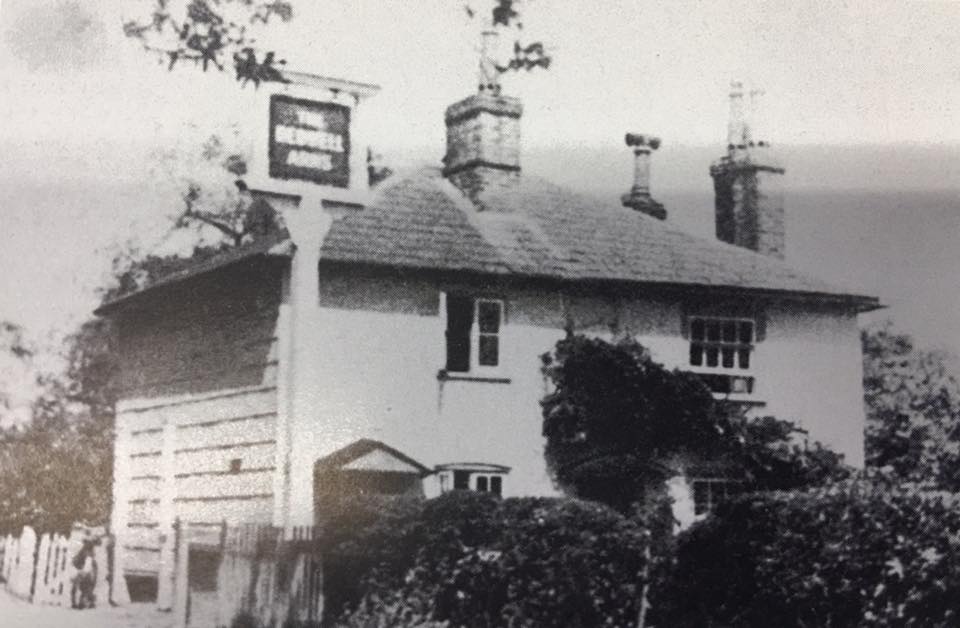
Together with the Facebook post
 Bed Well: Possibly site of Bedwell Arms Rownhams on NLS Old OS 25" Map Hampshire and Isle of Wight LVII.13 Revised: 1895, Published: 1897
Bed Well: Possibly site of Bedwell Arms Rownhams on NLS Old OS 25" Map Hampshire and Isle of Wight LVII.13 Revised: 1895, Published: 1897
There is a well marked W, annotated Bed Well on the above map, near the junction of Rownhams Lane and Bakers Drove. This could be the location of the Bedwell Arms Public House mentioned in the Facebook posts. Therefore, the site of the source of water for the soldiers of the Nursling Camp in 1795.
Ordnance Survey, 1:25,000 maps of Great Britain -- OS Map SU 31 Sheet 41/31 - B - Publication date: Revised: 1907 to 1947, Published: 1951
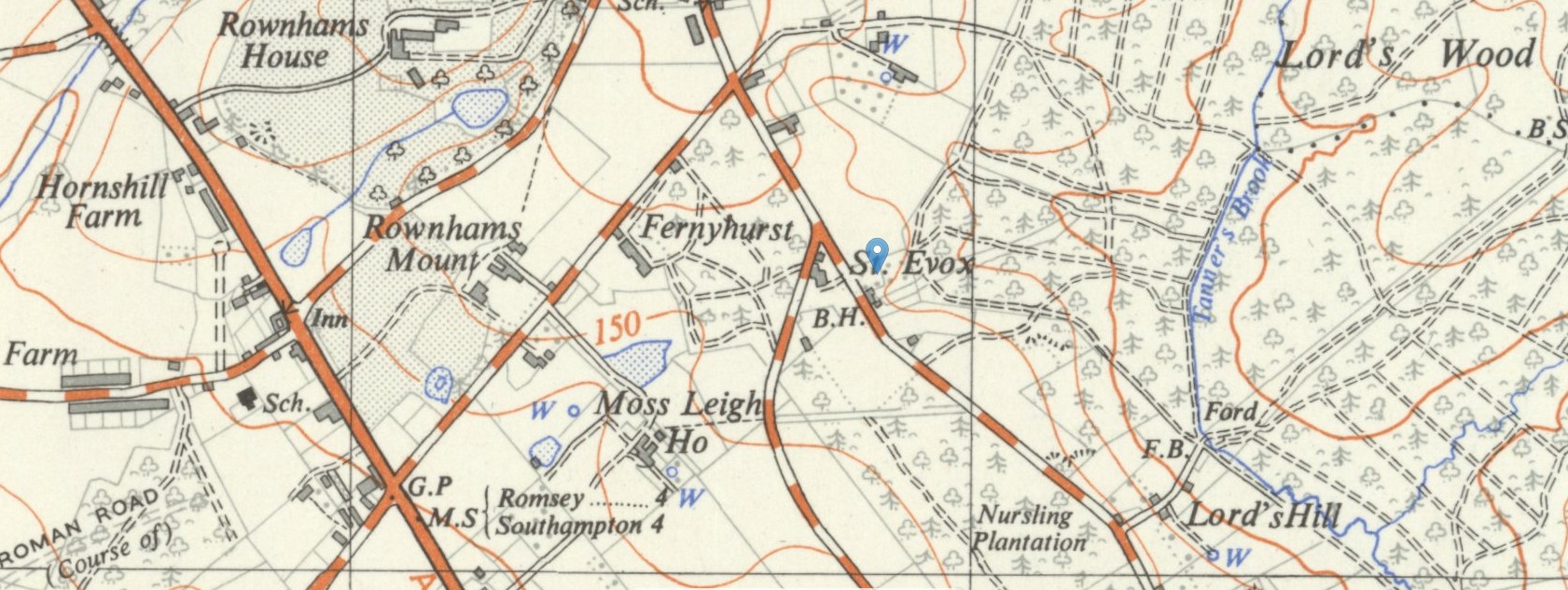 Ordnance Survey, 1:25,000 maps of Great Britain -- NLS Old OS Map SU 31; Sheet 41/31 - B - Publication date: Revised: 1907 to 1947, Published: 1951 -- Bed Well - Bedwell Arms Rownhams
Ordnance Survey, 1:25,000 maps of Great Britain -- NLS Old OS Map SU 31; Sheet 41/31 - B - Publication date: Revised: 1907 to 1947, Published: 1951 -- Bed Well - Bedwell Arms Rownhams
With the blue marker in the same place as the previous map, it appears that the same two buildings are shown adjacent to road, Rownhams Lane. The annotation B.H. represents Beer House. This is a stronger hint that it is the Bedwell Arms.
THE BRITISH ARMY AND THE CARIBBEAN EXPEDITIONS OF THE WAR AGAINST REVOLUTIONARY FRANCE 1793-1801
Michael Duffy
Jump back to top of Parish Records tabs
Disbursements
Disbursements by the Parish
At he back of the Parish Register book 1736 to 1797, there are notes about disbursements made by the Parish.
Both Long and Mabey surnames appear.
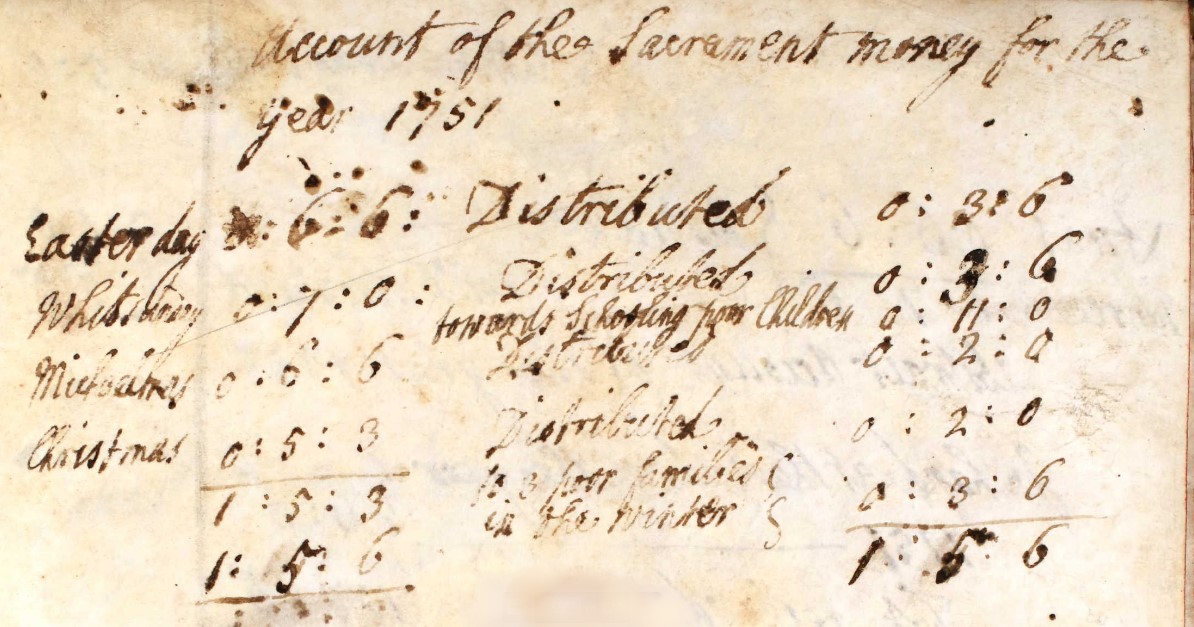
Account of the Sacrament money for the year 1751
It appears the church received £1 5s 3d over the course of the year, and distributed slightly more at £1 5s 3d. The biggest portion being 'towards Schooling poor Children' at 11s. Also there 'to 3 poor families in the Winter. at 3s 6d. which is possibly 1s 2d each.
In 2023, the relative value of £0 1s 2d from 1751 ranges from £10.39 to £1,586.00. Labour earnings of that income or wealth is £142.40. Is that the equivalent of the Winter Fuel Allowance in the UK?
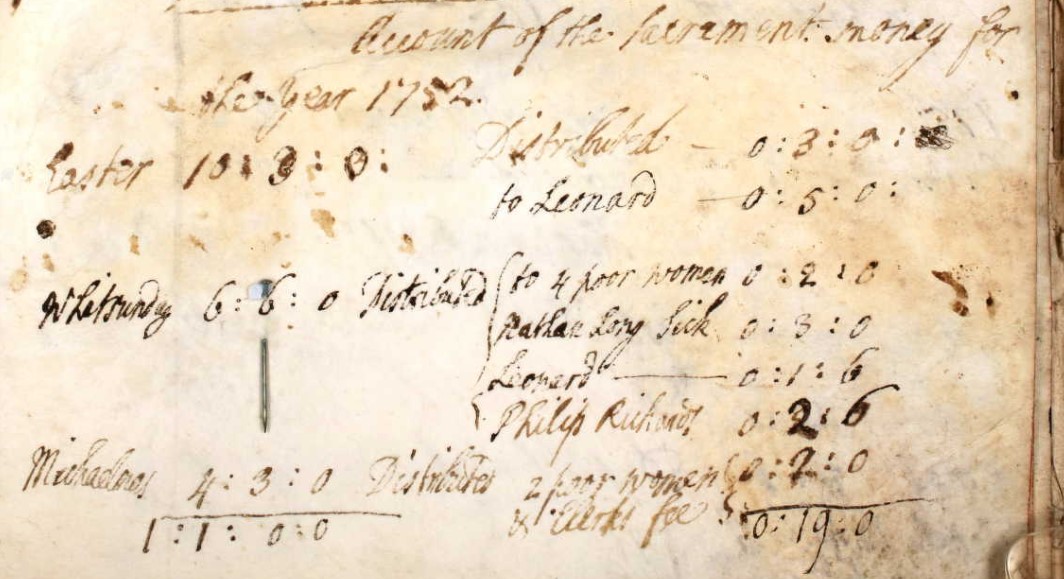
Distributed 1752, possibly Whitsunday.
to 4 poor women
Nathan Long Sick
Leonard
Philip Richard
From the above I assume that Nathan Long was on long term sick and could not work, and he received 3s 0d to support him and his family.
There is a Nathan Long in my tree, Nathan Long 1745–1768 Birth ABT. 1745 • Nursling, Hampshire, England. In 1752 he would have been about 7 years of age. So I think that confirms that it would have been his father receiving the aid. Again, from my tree, Nathaniel Long 1710–1768; Birth 9 FEB 1710 • Eling, Hampshire, England; Death 6 DEC 1768 • Nursling, Hampshire, England. This Nathan was about 42 years old at the date of this disbursement and died when he was 58 years of age.
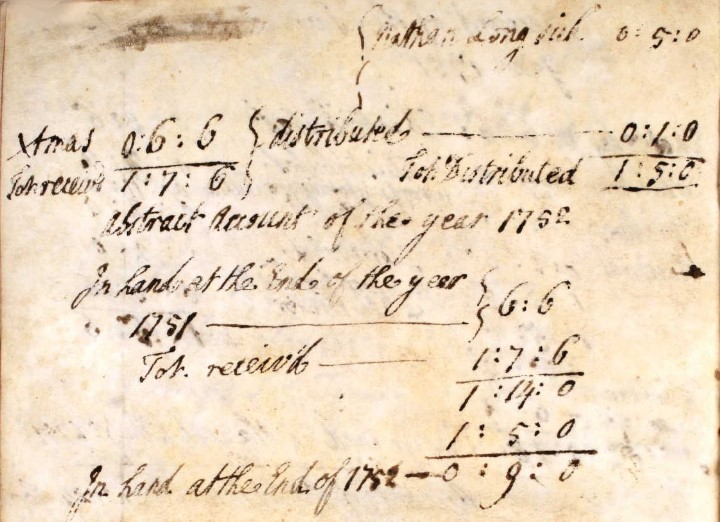
Nathan Long received another 5s 0d in 1752.
The total distributed by the parish was £1 5s 0d whilst the total received was £1 7s 6d.
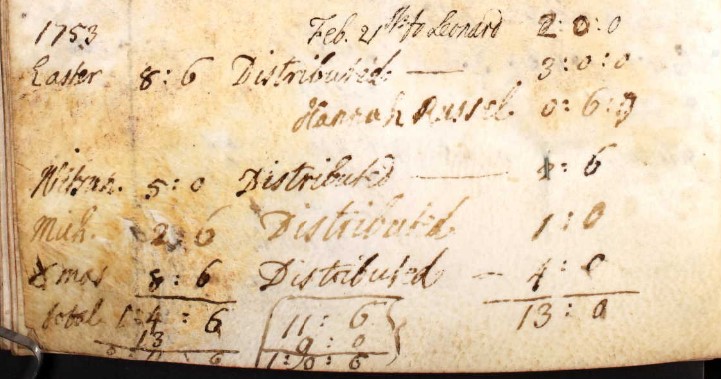
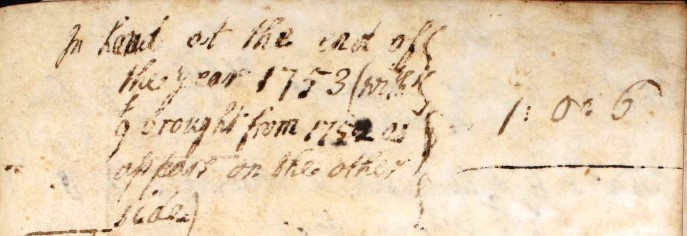
Hannah Russel is the only name mentioned in the disbursements, but Nathan Long could be among the un-named disbursements.
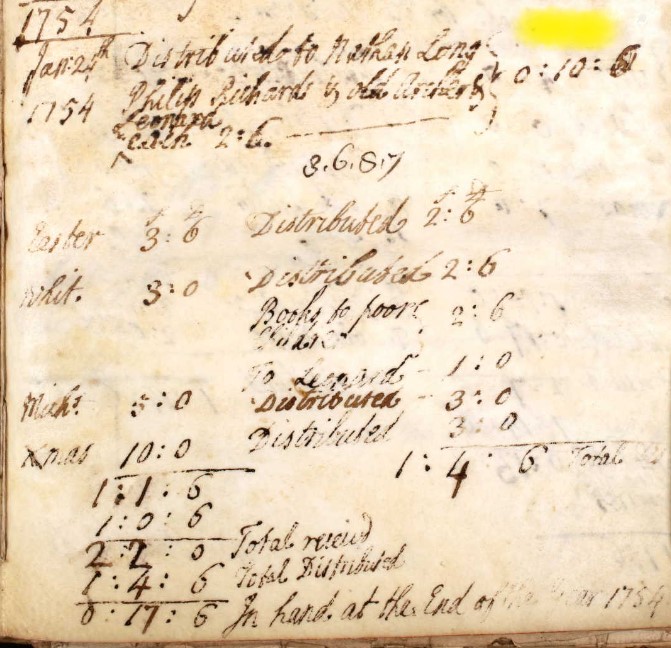
Jan 24th 1754 Distributed to Nathan Long, Philip Richards & old Archer & Leonard each 2:6
Nathan Long receives another £0 2s 6d by name but without the sick annotation.
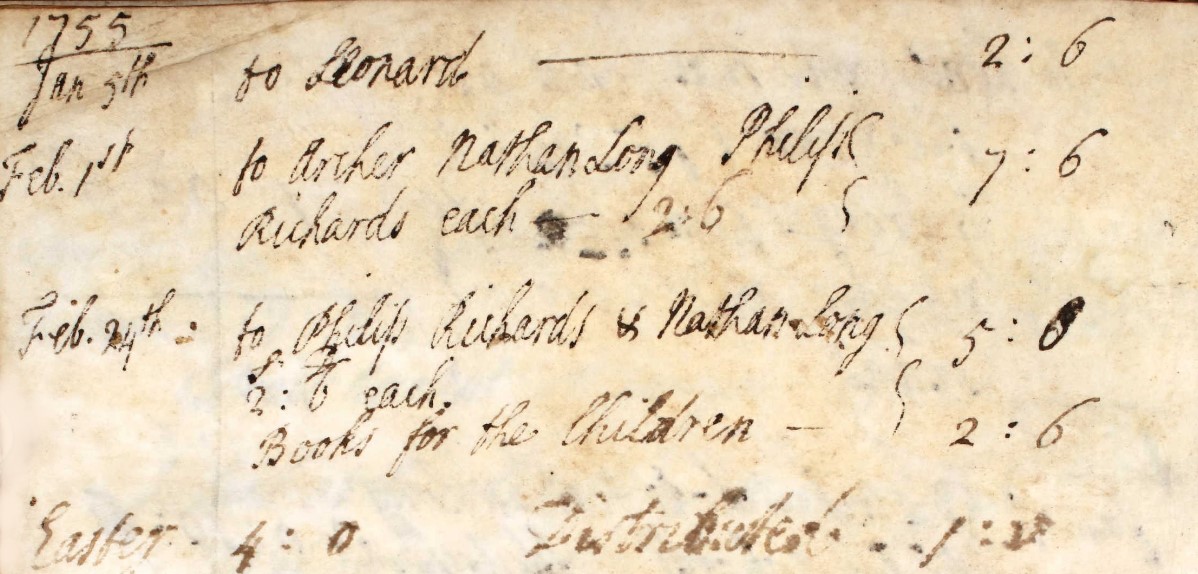
1755
Jan 5th [1755] to Leonard 2s 6d
Feb. 1st [1755] to Archer, Nathan Long Philip Richards each 2:6
Feb. 24th [1755] to Philip Richards & Nathan Long 2:6 each
Books for the Children 2s 6d.
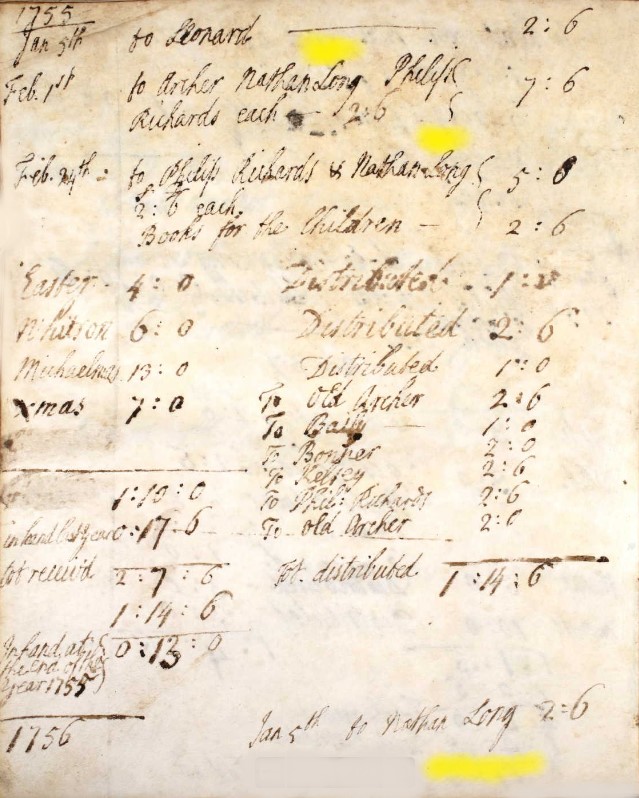
1755 Again, but full page.
Other names so the rest of the page;-
Old Archer, Baily, Bonner, Kelsey, Phil Richards, and old Archer again.
Into 1756, and Jan 5th to Nathan Long 2s 6d at the bottom of the page.
Onto the next page, also 1756.
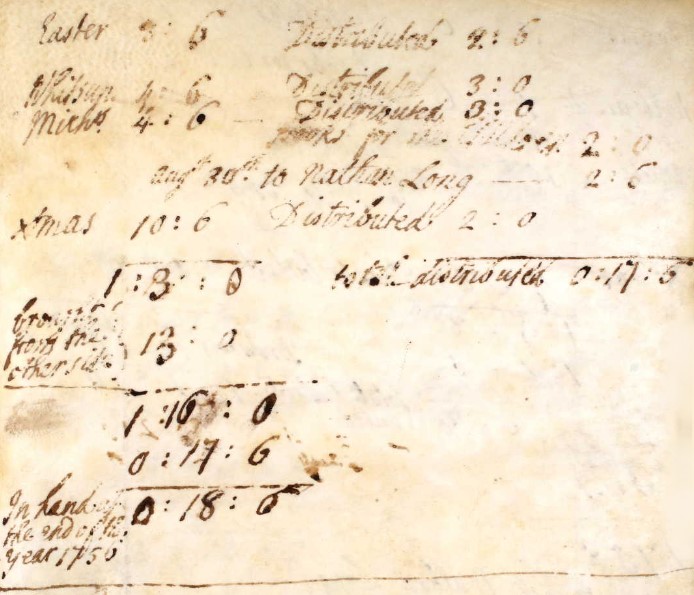
Augt 30th to Nathan Long 2s 6d.
Also, Books for the Children 2s 0d.

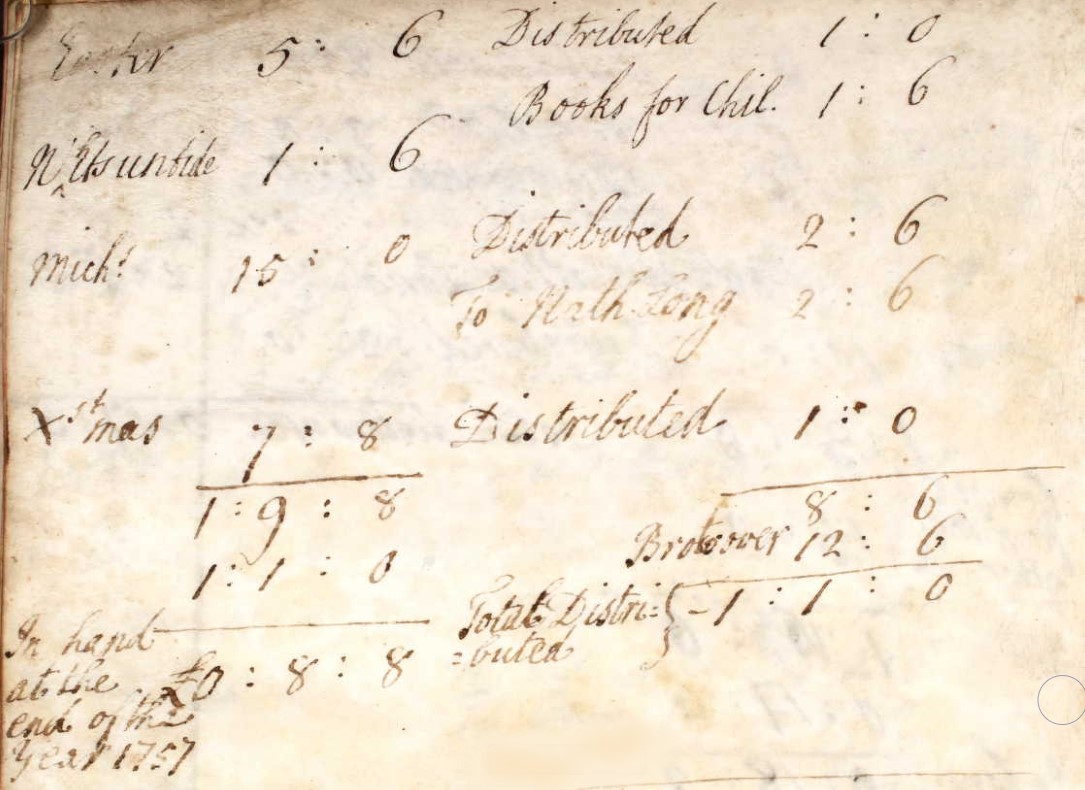
1757
Jan : 29 Distributed to poor in Beef 12s 6d
Books for Children 1s 6d
To Nath Long 2s 6d
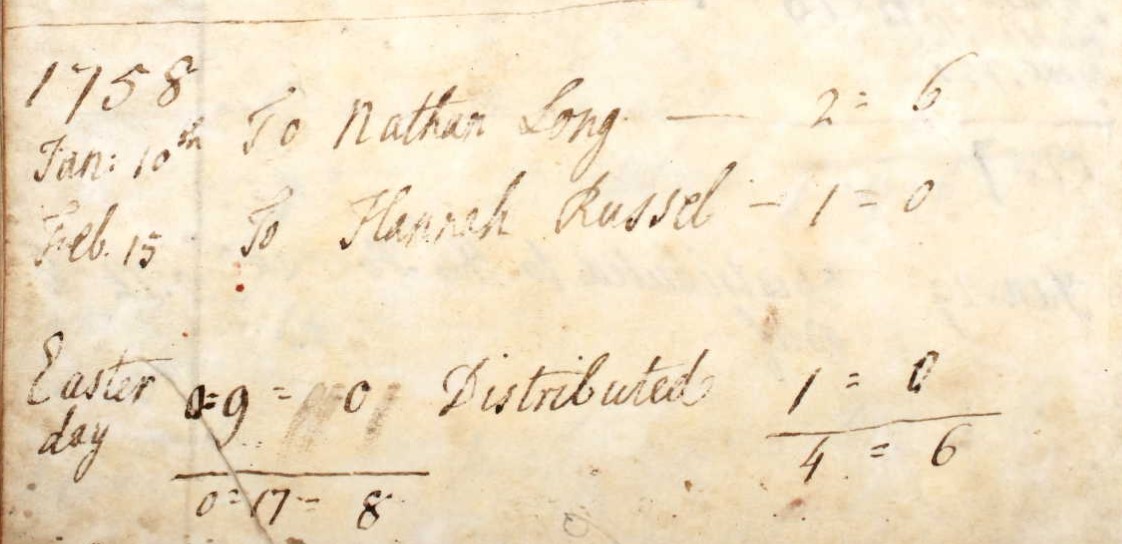
On 10th January 1758 Nathan Long received £0 2s 6d, otherwise known as half a crown. Or 30 pennies, a 1/8th of a pound sterling. In 2023, the relative value of £0 2s 6d from 1758 ranges from £20.52 to £2,805.00. More specially, labour earnings of that income or wealth is £297.30. That is a lot of money as a parish disbursement.
Hannah Russel appears again, another 1s.
Archer and Philip Richards not mentioned.
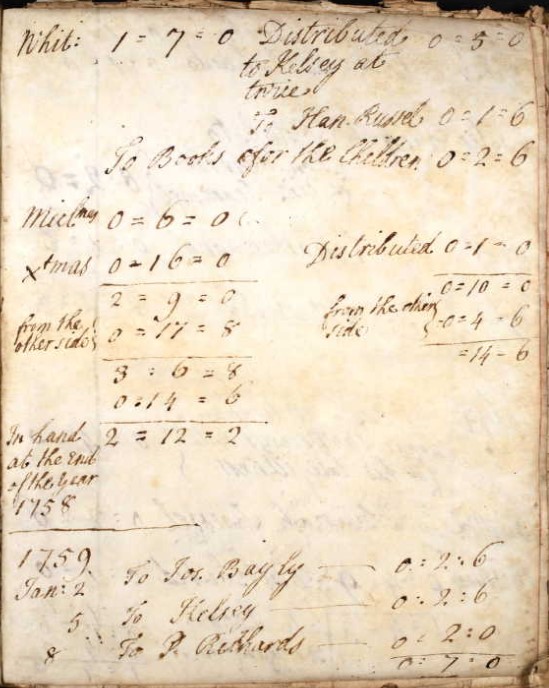
1758 continues with distributed to Kelsey at twice 5s 0d, to Han. Russel £0 1s 6d and to books for the children £0 2s 6d.
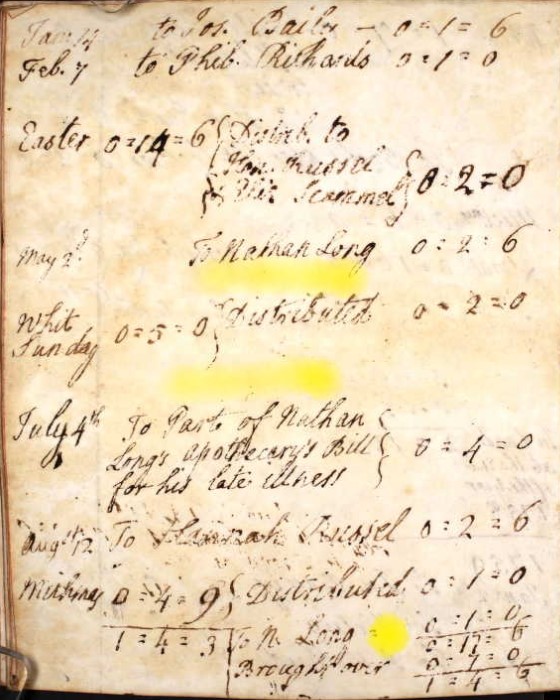
Distributed to Joseph Baily, Philip Richards, Eliz Scammel.
May 2nd. To Nathan Long £0 2s 6d
Then on
July 4th To Part of Nathan Long's apothecary's Bill for his late illness. £0 4s 0d.
Augt 12 To Hannah Russel
Third time this year
To N Long £0 1s 0d.
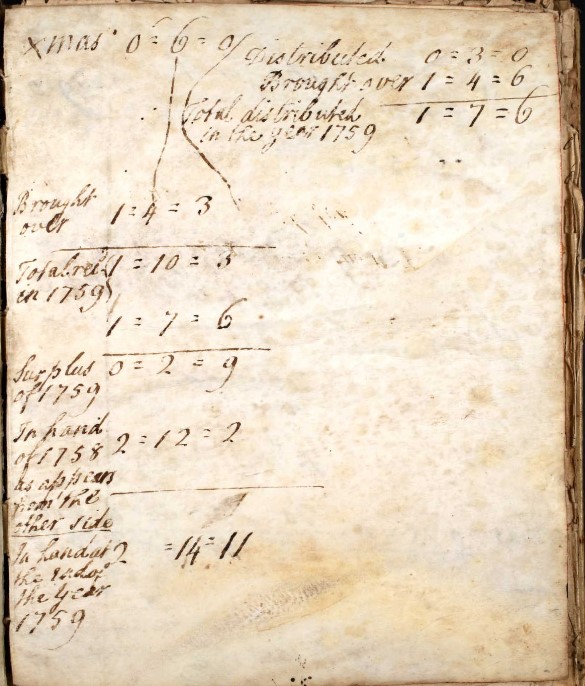
Year end calculations, 1759.
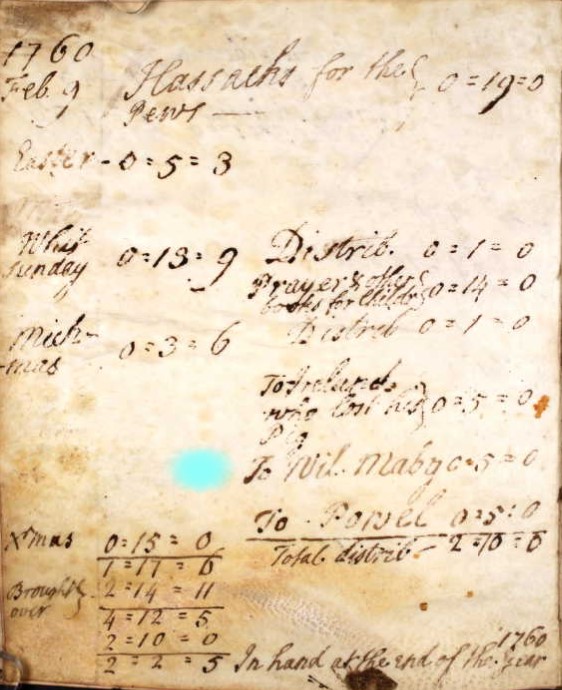
1760
Hassocks for the Pews £0 19s 0d.
Prayer & other books for Children £0 14s 0d.
To Irelands, who lost his pig £0 5s 0d.
To Wil Maby £0 5s 0d.
This could be to William Mabey, the sum of 5s. His first time as far as I have seen.
To Powel £0 5s 0d.
Nathan Long appears not to be specifically mentioned in 1760.
The forgoing, from 1752 to 1759, suggests that the Long family were among the poorest in the parish, with Nathan Long perhaps on the long term sick list. Is there a reason why he is not entered for 1760, or is it just a change in the amount of data recorded? Has he perhaps died? I don't think so, as there are more entries below.

1761, Books to Children, £0 16s 0d.
Distributed to Eliz Scammel, to Powel. Some unspecified distributed. Nathan Long not mentioned.
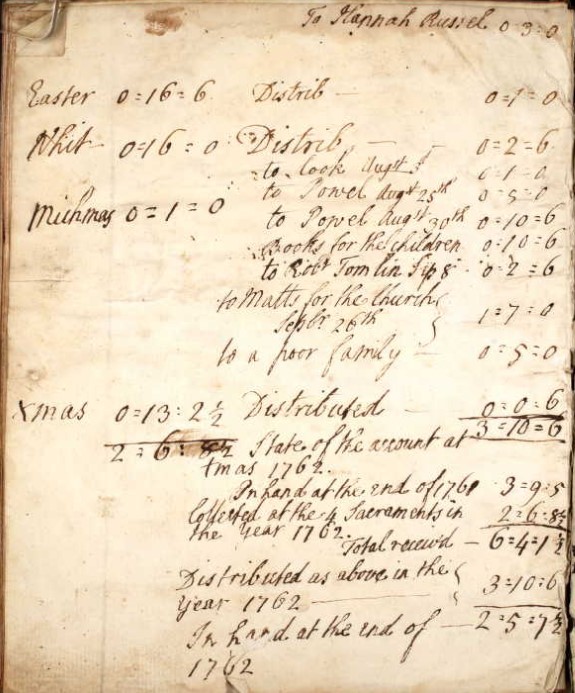
1762
Distributed to;
Dame Cook, (from bottom of previous page), (Not necessarily entitled Dame, more likely a form of address, perhaps as a widow)
Hannah Russel, Cook, Powel, Powel, Books for the Children, Robert Tomlin, Matts for the Church, and to a poor family.
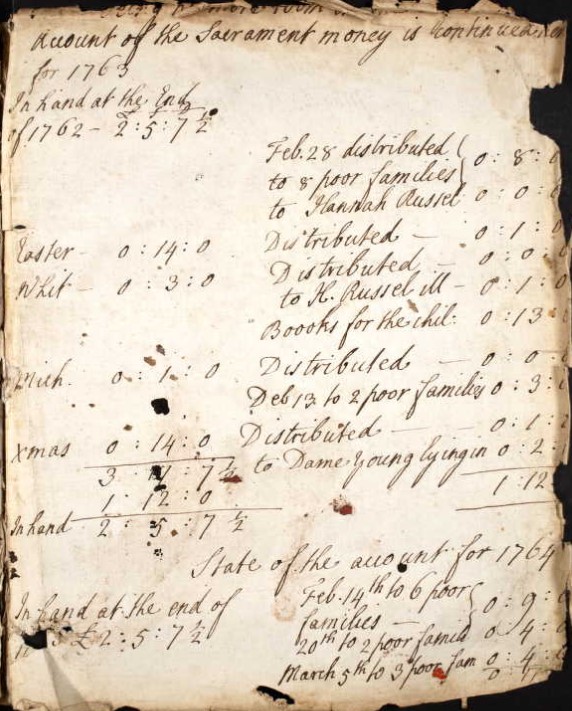
1763
Distributed to;
8 poor families, Hannah Russel, Hannah Russel ill, Books for the children, 2 poor families, Dame Young lying in
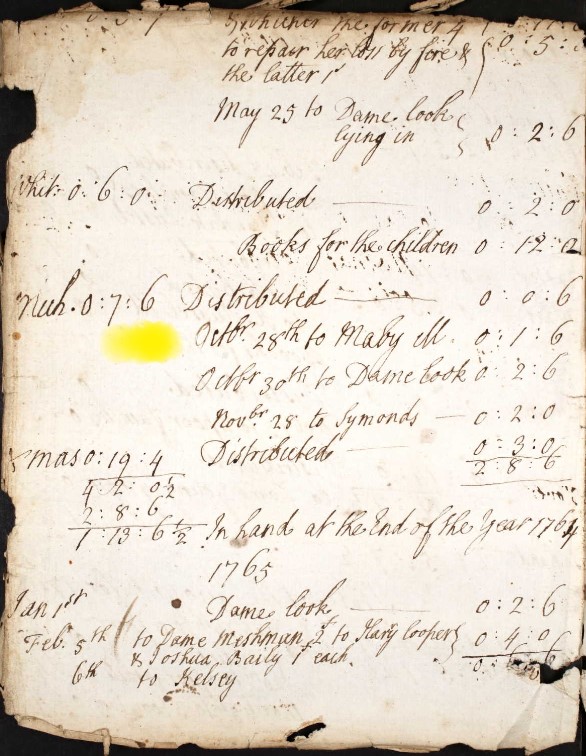
1764
Distributed to;
6 poor families, 2 poor families, 3 poor families (all from bottom of previous page)
(top of page broken) ... & Wither the former 4 ?? to repair her loss by fire & the latter ?, Dame Cook lying in, Books for the Children, Maby ill, Dame Cook, and to Symonds.
Could the Maby reference be one of out family of interest?
Octbr 28th to Maby ill 0:1:6, £0 1s 6d.
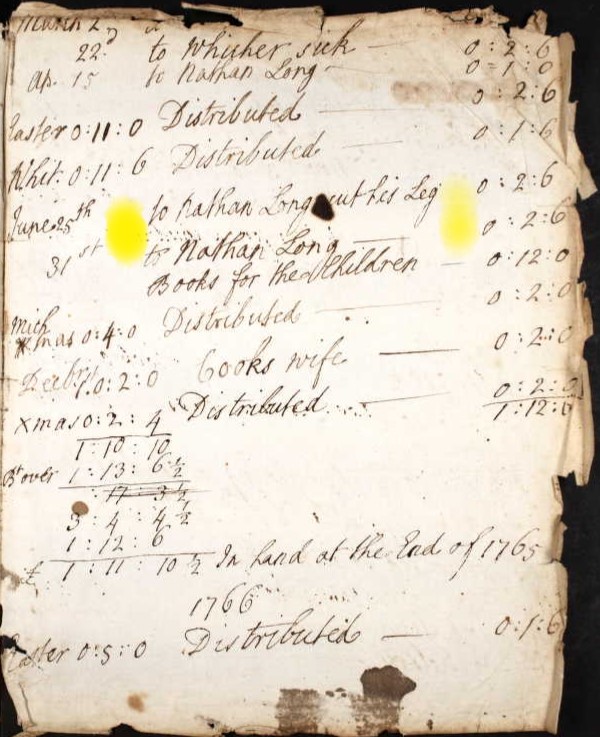
1765
Distributed to;
Dame Cook, Dame Meshman, 2 to Harry Cooper, & Joshua Baily 1 each, and to Kelsey. (all from bottom of previous page)
Whicher sick, Nathan Long, to Nathan Long cut his leg, Nathan Long, Books for the Children, and Cooks Wife.
Nathan Long is back on the list after a few years absence. The absence could have been that he was included it the poor families, other un-named distributed, or that he did not receive aid from the parish 1760 to 1764, inclusive.
Ap 15 to Nathan Long 0:1:0
June 25th to Nathan Long cut his leg 0:2:6
31st to Nathan Long 0:2:6
Nathan Long received £0 6s 0d. across three instances, but is it the same Nathan Long as previously encountered?
Nathanial Long, the suspected previous recipient of parish aid, shown above was now ?? years of age and had married Mary Powel in ????. Widower and Widow. Whereas his son, Nathan Long, previously discounted because of his young age, was now 20 years old. So it could be either of them.
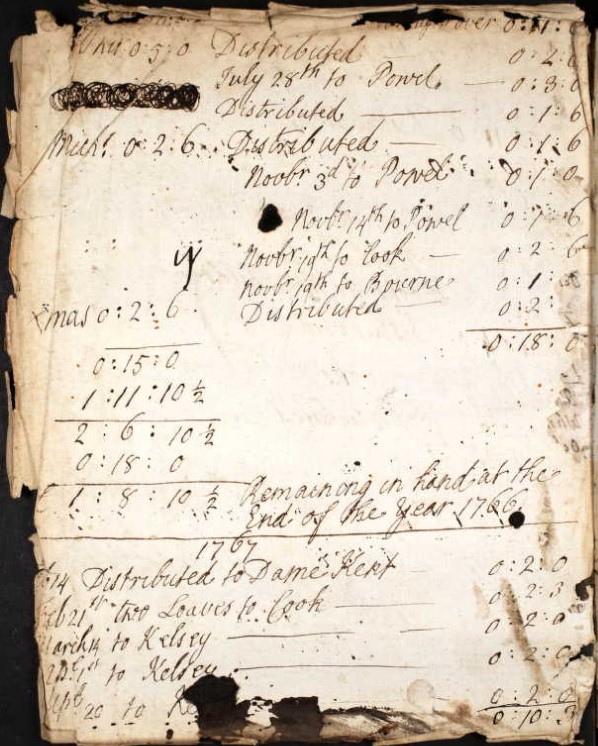
1765
Distributed;
To Powel, Powel, Powel, Cook and Bourne
1767
Distributed;
two loves to Cook, to Kelsey, Kelsey, and probably Kelsey again.
There are a number of other Disbursement pages, however, I have not noticed any persons of interest, on a cursory review.
The pages then start again with years 1736, 1739-1742, 1774-1775, then back to 1742-1750 covered to some extent.
Data Sheet
Data Sheet
Records, data, and general information about John and Mary Mabey of Nursling and their family
Husband and Wife
Birth
Baptism
John Son of William & Anne Mabey

Extract of the Nursling Parish Register
Jan 17 Jno S of William & Anne Mabey
Jan 17, 1771 John Son of William & Anne Mabey, Baptised at St Boniface Church, Nursling, Hampshire
Joseph & Mary Son & Daughter of James & Ann Peny

Joseph & Mary Son & Daughter of James & Ann Peny was baptised Novr iii - 3rd November 1776
I believe Mary is the person I was looking for. She becomes John Mabey's wife.
Marriage
John Maybe to Mary Penny
| 1794 | |||||
| No 54 | |||||
| Banns of Marriage between | John Maybe | of this parish | |||
| and | Mary Penny | of the parish of Eling | |||
| were published on the three Sundays underwritten: | |||||
| That is to say, | On Sunday, | the 16th of Feby | 1794 | by me S. J. Collins | Curate |
| On Sunday, | the 23d of Feby | 1794 | by me S. J. Collins | Curate | |
| On Sunday, | the 2d of March | 1794 | by me S. J. Collins | Curate |
The Bride is from the Parish of Eling, so unsurprisingly, the marriage took place in Eling.

The first entry on this page, no. 408, is copied here just because John Mebey signed as a witness. The signature looks to be the same for his own wedding, so perhaps it has no other significance than he was presence for both weddings, on the third of March and could write.
| 1794 | ||||||
| No. 409 | ||||||
| John Mebey Batchelor of the Parish of Nursling | ||||||
| and | ||||||
| Mary Penny of this parish Spinster | ||||||
| were Married in this Church by | Banns this | Third Day of March in the Year One Thousand seven Hundred and Ninety Four | by me | Charles Sloman | Curate | |
| This Marriage was solemnized between us | John Mebey | |||||
| Mark + of Mary Penny | ||||||
| In the Presence of | Philip Stride | |||||
| Thomas Bessant | ||||||
| 3 Mar 1794 |
The associated Bishop's Transcripts, also for Eling.
Death
Burial
Census
Census and Voting Registers
UK Census dates from 1911Census.org;
1841 Census Sunday 6th June 1841
1851 Census Sunday 30th March 1851
1861 Census Sunday 7th April 1861
1871 Census Sunday 2nd April 1871
1881 Census Sunday 3rd April 1881
1891 Census Sunday 5th April 1891
1901 Census Sunday 31st March 1901
1911 Census Sunday 2nd April 1911
1841
1841 Census Sunday 6th June 1841
After his death.
1851
1851 Census Sunday 30th March 1851
After his death.
1861
1861 Census Sunday 7th April 1861
After his death.
1871
1871 Census Sunday 2nd April 1871
After his death.
1881
1881 Census Sunday 3rd April 1881
After his death.
1891
1891 Census Sunday 5th April 1891
After his death.
1901
1901 Census Sunday 31st March 1901
After his death.
1911
1911 Census Sunday 2nd April 1911
After his death.
Parents
Parents
William & Anne Mabey
His Father
William Mabey
Ancestry Synopsis
When William Mabey was born on 31 March 1734 in Eling, Hampshire, his father, William, was 29 and his mother, Elizabeth, was 26. He married Ann Long on 29 October 1760 in Nursling, Hampshire. They had 11 children in 21 years. He died on 14 April 1795 in Nursling, Hampshire, at the age of 61.
Baptism
William the Son of William Meabee

William the Son of William Maebee was Bapt. March xxxi. Baptised 31st March 1734 in St. Mary the Virgin Church, Eling.
The blue dot is just to highlight the use of a capital M, in a word recognisable as Mary, for comparison with Maebee, which is much less certain.
Marriage
William Maby [Mabey] to Anne Long at St Boniface Church, Nursling Hampshire, on 29 October 1760.
One of only two weddings at that church, that year.
Extracts from the Nursling Parish Register.

The marriages in this book from pencil page 42 to pencil page 48 seem to be abridged from the fuller book as ordered by Act of George II . S.C. Wilks Feb. 1854.

1760 Oct 29 William Maby to Ann Long

| 1760 | |||||
| No 9 | |||||
| Banns of Marriage between | William Maby | ||||
| and | Anne Long | ||||
| were published on the three Sundays underwritten: | |||||
| That is to say, | On Sunday, | the 12 | ) | ||
| On Sunday, | the 19 | } | October | by Ed. Morris Rector | |
| On Sunday, | the 26 | ) |

| 1760 | ||||||
| No. 11 | ||||||
| William Maby of this Parish Batchelor | ||||||
| and | ||||||
| Anne Long Spinster of this parish | ||||||
| were Married in this Church by | Banns this | 29 Day of October in the Year One Thousand seven Hundred and Sixty | by me | Ed: Morris | Rector | |
| This Marriage was solemnized between us | William Mybe | |||||
| Mark x of Anne Long | ||||||
| In the Presence of | John Grove | |||||
| Elizabeth Fillere | ||||||
| 29 Oct 1760 |
John Grove is the witness to a number of these marriages which suggests that he may be a clerk or a churchwarden as opposed to a relative.
2nd Marriage
Death
Assumed to be shortly before 14th April 1795.
Burial

Burials, 1795
April 14 William Mayby aged 63 years
His Mother
Anne Long
Ancestry Synopsis;
When Ann Long was born on 9 October 1741 in Nursling, Hampshire, her father, Nathaniel, was 31, and her mother, Rebecca, was 24. She married William Mabey on 29 October 1760 in her hometown. They had 11 children in 21 years. She died on 18 October 1821 in Nursling, Hampshire, having lived a long life of 80 years.
Baptism
Ann, Daughter of Nathaniel & Rebeccah Long

Oct: 9. Ann, Daughr. of Nathaniel & Rebeccah Long.
Oct: 9, 1741. Ann, Daughter of Nathaniel & Rebeccah Long, Baptised at St Boniface Church, Nursling, Hampshire.
Marriage
William Maby [Mabey] to Anne Long at St Boniface Church, Nursling Hampshire, on 29 October 1760.
Extracts from the Nursling Parish Register. (The same as for William Mabey above)

The marriages in this book from pencil page 42 to pencil page 48 seem to be abridged from the fuller book as ordered by Act of George II . S.C. Wilks Feb. 1854.

1760 Oct 29 William Maby to Ann Long

| 1760 | |||||
| No 9 | |||||
| Banns of Marriage between | William Maby | ||||
| and | Anne Long | ||||
| were published on the three Sundays underwritten: | |||||
| That is to say, | On Sunday, | the 12 | ) | ||
| On Sunday, | the 19 | } | October | by Ed. Morris Rector | |
| On Sunday, | the 26 | ) |

| 1760 | ||||||
| No. 11 | ||||||
| William Maby of this Parish Batchelor | ||||||
| and | ||||||
| Anne Long Spinster of this parish | ||||||
| were Married in this Church by | Banns this | 29 Day of October in the Year One Thousand seven Hundred and Sixty | by me | Ed: Morris | Rector | |
| This Marriage was solemnized between us | William Mybe | |||||
| Mark x of Anne Long | ||||||
| In the Presence of | John Grove | |||||
| Elizabeth Fillere | ||||||
| 29 Oct 1760 |
John Grove is the witness to a number of these marriages which suggests that he may be a clerk or a churchwarden as opposed to a relative.
Death
Assumed to be shortly before
Burial
Yet to be found
Her Father
1758
Marriage of James Penny and Ann Eldridge

| 1758 | ||||||
| No. 52 | ||||||
| James Penny of the Parish of Lyndhurst | ||||||
| and | ||||||
| Ann Eldridge of this Parish | ||||||
| were Married in this Church by | Banns this | thirteenth Day of April in the Year One Thousand seven Hundred and fifty eight | by me | Joseph Scott | Curate | |
| This Marriage was solemnized between Us | C the Mark of James Penny | |||||
|
O the Mark of Ann Eldridge |
||||||
| In the Presence of | O the Mark of Joseph Jones | |||||
| O the Mark of James Olding | ||||||
| 13 April 1758 |
Her Mother
Ann Eldridge
1738
Ann the Daughter of Robert & Ann Eldridge

Ann the Daughter of Robert & Ann Eldridge was baptised October xxxi - 31st October 1738, baptised at St Mary the Virgin Church, Eling, Hampshire.
1758
Marriage of James Penny and Ann Eldridge

| 1758 | ||||||
| No. 52 | ||||||
| James Penny of the Parish of Lyndhurst | ||||||
| and | ||||||
| Ann Eldridge of this Parish | ||||||
| were Married in this Church by | Banns this | thirteenth Day of April in the Year One Thousand seven Hundred and fifty eight | by me | Joseph Scott | Curate | |
| This Marriage was solemnized between Us | C the Mark of James Penny | |||||
|
O the Mark of Ann Eldridge |
||||||
| In the Presence of | O the Mark of Joseph Jones | |||||
| O the Mark of James Olding | ||||||
| 13 April 1758 |
1819
Ann Penny

Burials in the Parish of West Knoyle, Wiltshire - Ann Penny Abode, West Knoyle was buried Sepr 14th [1819] aged 81
Given the Baptism date, shown above in this section, of 31st October 1738 and the burial date of 14th September 1819, the duration between those dates is 80 years, 10 months, 14 days excluding the end date, which in the absence of Birth and Death dates, is therefore assumed to be close to an age calculation. About 11/2 months shy of the 81 years shown above. That, in my opinion, is close enough, not to create a red flag.
However, West Knoyle is a long way from Eling. In fact it is about 40 miles, which would be about 41/2 hours walking, from Eling Hill, where the vicarage is. The challenge therefore is to find out why she was there. Are her family still there in the 1841 census, for instance?
Children
Parents Children and Children
His Parents
Ann Mabey nee Long and William Mabey's children's Records.
Scroll left or right along the tabs. There is a tab for each year of child bearing age following their marriage, which helps to indicate years when no children of William and Mary were born, or survived long enough to be baptised, or alternatively, where no record has yet been found. They had 11 children in 21 years.
1760
No record yet found
1761 Martha (Sarah)
From my Ancestry Hurst Family Tree
Martha (Sarah) Mabey
1761–1784
Birth BEF. 1 AUG 1761 • Nursling, Hampshire, England
Death 2 NOV 1784 • Nursling, Hampshire, England
From Discovery above
Birth
Currently assumed to be just before Baptism
Baptism
Martha Daughter of William & Mary Maby

Aug 1 Martha D of Willm & Mary Maby
Aug 1, 1761 Martha Daughter of William & Mary Maby
Maby is not Mabey but is similar.
William Mabey and Ann Long were married at St Boniface Church, Nursling, Hampshire on 29 October 1760. So 1st August 1761 is a respectable date of first born after marriage.
However, who is Mary? William married Ann, not Mary. Is Mary an alternative name for Ann, such as Mary Ann, or Ann Mary. Not according to the baptism record.
The record remains not validated.
Marriage
John Osman to Sarah Maybey

| 1784 | |||||
| No 33 | |||||
| Banns of Marriage between | John Oasman | ||||
| and | Sarah Maybe | both of this parish | |||
| were published on the three Sundays underwritten: | |||||
| That is to say, | On Sunday, | the seventeenth | day of | October | |
| On Sunday, | the twenty fourth | day of | October | by me S. J. Collins | |
| On Sunday, | the thirty first | day of | October 1784 | Curate |

| 1784 | ||||||
| No. 84 | ||||||
| John Osman of this Parish Batchelor | ||||||
| and | ||||||
| Sarah Maybey of the same, Spinster | ||||||
| were Married in this Church by | Banns this | second Day of November in the Year One Thousand seven Hundred and Eighty four | by me | Ed: Morris | Rector | |
| This Marriage was solemnized between us | + the Mark of John Osman | |||||
|
+ the Mark of Sarah Maybey |
||||||
| In the Presence of | + the Mark of John Hicks | |||||
| Thos Richards | ||||||
| 2 Nov 1784 |
Nice marriage details, including Banns, but there is something on a glaring problem here. The bride's name is Sarah Maybey, and it is not the spelling of the surname. On Ancestry, Sarah appears to be associated with Martha as one in the same person. However, I have yet to find definitive evidence as to why this association has been made, let alone that it is correct.
The record remains not validated.
I have started to build the tree branches under this couple in the hope of finding more information, including DNA traces which may prove the link. It may be a case that there are too many generations between any tester and the couple.
Death
Burial
1762 William
From my Ancestry Hurst Family Tree
William Mabey
1762–1856
Birth 1762 • Hampshire, England
Death 29 APR 1856 • Nursling, Hampshire, England
From Discovery above
No Prime data yet found
1763
No record yet found
1764 Susan
From my Ancestry Hurst Family Tree
Susan Mabey
1764–1764
Birth 17 JAN 1764 • Nursling, Hampshire, England
Death 10 MAR 1764 • Nursling, Hampshire, England
From Discovery above
Birth
Currently assumed to be just before Baptism
Baptism
Susan Daughter of William & Anne Maby

May 4 Susan. D. of Willm & Anne Maby
May 4, 1764 Susan Daughter of William & Anne Maby
Again, Maby is not Mabey but is similar.
At least the parents are the expected William and Ann.
1765
1766
No record yet found
1767
No record yet found
1768 Joseph
From my Ancestry Hurst Family Tree
Joseph Mabey
1768–1856
Birth 1768 • Eling, Hampshire, England
Death 1856 • Romsey, Hampshire, England
From Discovery above
Birth
Currently assumed to be just before Baptism
Baptism
Joseph Son of William & Anne Mabey

Sep 12 Joseph. S, of Willm. & Anne Mabey
Sep 12, 1768, Joseph Son of William & Anne Mabey.
1769
No record yet found
1770
No record yet found
1771 John
From my Ancestry Hurst Family Tree
John Mabey
1771–1856
Birth BEF. 17 JAN 1771 • Nursling, Hampshire, England
Death 24 APR 1856 • Nursling, Hampshire, England
From Discovery above
Birth
Currently assumed to be just before Baptism
Baptism
John Son of William & Anne Mabey

Jan 17 Jno S of William & Anne Mabey
Jan 17, 1771 John Son of William & Anne Mabey
1772
No record yet found
1773 Richard
From my Ancestry Hurst Family Tree
Richard Mabey
1773–1835
Birth BEF. 31 MAY 1773 • Nursling, Hampshire, England
Death 28 JAN 1835 • Romsey, Hampshire, England
From Discovery above
Birth
Currently assumed to be just before Baptism
Baptism
Richard Son of William & Anne Mabey

May 31 Richd S. of Wm & Anne Mabey
May 31, 1773 Richard Son of William & Anne Mabey
1774
No record yet found
1775 Milly
From my Ancestry Hurst Family Tree
Milly Mabey
1775–1782
Birth BEF. 30 AUG 1775 • Nursling, Hampshire, England
Death BEF. 4 JUN 1782 • Nursling, Hampshire, England
From Discovery above
Birth
Currently assumed to be just before Baptism
Baptism
Milly Daughter of William & Ann Mabey

Aug 30 Milly, D. of Willm & Ann Mabey
Aug 30, 1775 Milly Daughter of William & Ann Mabey
1776
No record yet found
1777
No record yet found
1778 Mary
From my Ancestry Hurst Family Tree
Mary Mabey
1778–1800
Birth BEF. 15 FEB 1778 • Nursling, Hampshire, England
Death 1800 • Nursling, Hampshire, England
From Discovery above
Birth
Currently assumed to be just before Baptism
Baptism
Mary Daughter of William and Ann Mabey

Feb 15 Mary Daughter of William and Ann Mabey
Feb 15, 1778 Mary Daughter of William and Ann Mabey
1779
No record yet found
1780 Susan
From my Ancestry Hurst Family Tree
Susan Mabey
1780–
Birth BEF. 17 SEP 1780 • Nursling, Hampshire, , England,
Death Unknown
From Discovery above
Birth
Currently assumed to be just before Baptism
Baptism
Susan Daughter of William & Ann Mabey

Sep 17 Susan, D. of William & Ann Mabey
Sep 17, 1780 Susan Daughter of William & Ann Mabey
Second use of the name Susan in this family, which implies the first Susan died before this year.
1781 Charlotte
From my Ancestry Hurst Family Tree
Charlotte Mabey
1781–
Birth 1781 • Hampshire, England
Death Unknown
From Discovery above
No Prime data yet found
1782 Elizabeth
From my Ancestry Hurst Family Tree
Elizabeth Mabey
1782–1843
Birth BEF. 17 NOV 1782 • Nursling, Hampshire, England
Death ABT. 1843
From Discovery above
Birth
Currently assumed to be just before Baptism
Baptism
Elizabeth Daughter of William & Anne Maybe

Novr 17. Elizabeth Daughter of William & Anne Maybe
Nov 17, 1782 Elizabeth Daughter of William & Anne Maybe
Note surname written as Maybe not Mabey. Assumed to be the same family.


Another copy within the same Register, fortunately with the same information.
1783
No record yet found
1784
No record yet found
1785
No record yet found
Her Parents
Ann Penny nee Eldridge and James Penny's children's Records.
Scroll left or right along the tabs. There is a tab for each year of child bearing age following their marriage, which helps to indicate years when no children of William and Mary were born, or survived long enough to be baptised, or alternatively, where no record has yet been found. They had ?????? children in ???????? years.
ggggggggggggggggggggggggggggggggggggggggggggggggggggggggggggggggggggggggggggggggggggggggggggggggggggggg
1758
No record yet found
From my Ancestry Hurst Family Tree
From Discovery above
Birth
Currently assumed to be just before Baptism
Baptism
Marriage
Death
Burial
1759 John
John Penny
No record yet found
From my Ancestry Hurst Family Tree
From Discovery above
Birth
Currently assumed to be just before Baptism
Baptism
Marriage
Death
Burial
1760
No record yet found
From my Ancestry Hurst Family Tree
From Discovery above
Birth
Currently assumed to be just before Baptism
Baptism
Marriage
Death
Burial
1761
No record yet found
From my Ancestry Hurst Family Tree
From Discovery above
Birth
Currently assumed to be just before Baptism
Baptism
Marriage
Death
Burial
1762
From my Ancestry Hurst Family Tree
No record yet found
From my Ancestry Hurst Family Tree
From Discovery above
Birth
Currently assumed to be just before Baptism
Baptism
Marriage
Death
Burial
1763
No record yet found
From my Ancestry Hurst Family Tree
From Discovery above
Birth
Currently assumed to be just before Baptism
Baptism
Marriage
Death
Burial
1764 Richard
Richard Penny
No record yet found
From my Ancestry Hurst Family Tree
From Discovery above
Birth
Currently assumed to be just before Baptism
Baptism
Marriage
Death
Burial
1765
No record yet found
From my Ancestry Hurst Family Tree
From Discovery above
Birth
Currently assumed to be just before Baptism
Baptism
Marriage
Death
Burial
1766
No record yet found
From my Ancestry Hurst Family Tree
From Discovery above
Birth
Currently assumed to be just before Baptism
Baptism
Marriage
Death
Burial
1767
No record yet found
From my Ancestry Hurst Family Tree
From Discovery above
Birth
Currently assumed to be just before Baptism
Baptism
Marriage
Death
Burial
1768 Ann
Ann Penny
No record yet found
From my Ancestry Hurst Family Tree
From Discovery above
Birth
Currently assumed to be just before Baptism
Baptism
Marriage
Death
Burial
1769
No record yet found
From my Ancestry Hurst Family Tree
From Discovery above
Birth
Currently assumed to be just before Baptism
Baptism
Marriage
Death
Burial
1770
No record yet found
From my Ancestry Hurst Family Tree
From Discovery above
Birth
Currently assumed to be just before Baptism
Baptism
Marriage
Death
Burial
1771
No record yet found
From my Ancestry Hurst Family Tree
From Discovery above
Birth
Currently assumed to be just before Baptism
Baptism
Marriage
Death
Burial
1772
No record yet found
From my Ancestry Hurst Family Tree
From Discovery above
Birth
Currently assumed to be just before Baptism
Baptism
Marriage
Death
Burial
1773
No record yet found
From my Ancestry Hurst Family Tree
From Discovery above
Birth
Currently assumed to be just before Baptism
Baptism
Marriage
Death
Burial
1774
No record yet found
From my Ancestry Hurst Family Tree
From Discovery above
Birth
Currently assumed to be just before Baptism
Baptism
Marriage
Death
Burial
1775
No record yet found
From my Ancestry Hurst Family Tree
From Discovery above
Birth
Currently assumed to be just before Baptism
Baptism
Marriage
Death
Burial
1776 Joseph and Mary
Joseph Penny
No record yet found
From my Ancestry Hurst Family Tree
From Discovery above
Birth
Currently assumed to be just before Baptism
Baptism
Marriage
Death
Burial
Mary Penny
No record yet found
From my Ancestry Hurst Family Tree
From Discovery above
Birth
Currently assumed to be just before Baptism
Baptism
Marriage
Death
Burial
1777
No record yet found
From my Ancestry Hurst Family Tree
From Discovery above
Birth
Currently assumed to be just before Baptism
Baptism
Marriage
Death
Burial
1778
No record yet found
From my Ancestry Hurst Family Tree
From Discovery above
Birth
Currently assumed to be just before Baptism
Baptism
Marriage
Death
Burial
1779
No record yet found
From my Ancestry Hurst Family Tree
From Discovery above
Birth
Currently assumed to be just before Baptism
Baptism
Marriage
Death
Burial
1780
No record yet found
From my Ancestry Hurst Family Tree
From Discovery above
Birth
Currently assumed to be just before Baptism
Baptism
Marriage
Death
Burial
1781
No record yet found
From my Ancestry Hurst Family Tree
From Discovery above
Birth
Currently assumed to be just before Baptism
Baptism
Marriage
Death
Burial
1782
From my Ancestry Hurst Family Tree
From Discovery above
Birth
Currently assumed to be just before Baptism
Baptism
1783
No record yet found
From my Ancestry Hurst Family Tree
From Discovery above
Birth
Currently assumed to be just before Baptism
Baptism
Marriage
Death
Burial
1784
No record yet found
From my Ancestry Hurst Family Tree
From Discovery above
Birth
Currently assumed to be just before Baptism
Baptism
Marriage
Death
Burial
1785
No record yet found
From my Ancestry Hurst Family Tree
From Discovery above
Birth
Currently assumed to be just before Baptism
Baptism
Marriage
Death
Burial
Mary Mabey nee Penny and John Mabey children's Baptism Records.
Scroll left or right along the tabs. There is a tab for each year of child bearing age following their marriage, which helps to indicate years when no children of William and Mary were born, or survived long enough to be baptised, or alternatively, where no record has yet been found.
1795 John
No record yet found
From my Ancestry Hurst Family Tree
From Discovery above
Birth
Currently assumed to be just before Baptism
Baptism
Marriage
Death
Burial
1796
No record yet found
From my Ancestry Hurst Family Tree
From Discovery above
Birth
Currently assumed to be just before Baptism
Baptism
Marriage
Death
Burial
1797 George
No record yet found
From my Ancestry Hurst Family Tree
From Discovery above
Birth
Currently assumed to be just before Baptism
Baptism
1797
George Son of John & Mary Maybey

April 23 George S. of John & Mary Maybey
Apr 23, 1797 George Son of John & Mary Maybey
Marriage
Death
Burial
1798
No record yet found
From my Ancestry Hurst Family Tree
From Discovery above
Birth
Currently assumed to be just before Baptism
Baptism
Marriage
Death
Burial
1799 William
No record yet found
From my Ancestry Hurst Family Tree
From Discovery above
Birth
Currently assumed to be just before Baptism
Baptism
Marriage
Death
Burial
1800
No record yet found
From my Ancestry Hurst Family Tree
From Discovery above
Birth
Currently assumed to be just before Baptism
Baptism
Marriage
Death
Burial
1801
No record yet found
From my Ancestry Hurst Family Tree
From Discovery above
Birth
Currently assumed to be just before Baptism
Baptism
Marriage
Death
Burial
1802
No record yet found
From my Ancestry Hurst Family Tree
From Discovery above
Birth
Currently assumed to be just before Baptism
Baptism
Marriage
Death
Burial
1803
No record yet found
From my Ancestry Hurst Family Tree
From Discovery above
Birth
Currently assumed to be just before Baptism
Baptism
Marriage
Death
Burial
1804
No record yet found
From my Ancestry Hurst Family Tree
From Discovery above
Birth
Currently assumed to be just before Baptism
Baptism
Marriage
Death
Burial
1805
No record yet found
From my Ancestry Hurst Family Tree
From Discovery above
Birth
Currently assumed to be just before Baptism
Baptism
Marriage
Death
Burial
1806
No record yet found
From my Ancestry Hurst Family Tree
From Discovery above
Birth
Currently assumed to be just before Baptism
Baptism
Marriage
Death
Burial
1807
No record yet found
From my Ancestry Hurst Family Tree
From Discovery above
Birth
Currently assumed to be just before Baptism
Baptism
Marriage
Death
Burial
1808
No record yet found
From my Ancestry Hurst Family Tree
From Discovery above
Birth
Currently assumed to be just before Baptism
Baptism
Marriage
Death
Burial
1809
No record yet found
From my Ancestry Hurst Family Tree
From Discovery above
Birth
Currently assumed to be just before Baptism
Baptism
Marriage
Death
Burial
1810
No record yet found
From my Ancestry Hurst Family Tree
From Discovery above
Birth
Currently assumed to be just before Baptism
Baptism
Marriage
Death
Burial
1811
No record yet found
From my Ancestry Hurst Family Tree
From Discovery above
Birth
Currently assumed to be just before Baptism
Baptism
Marriage
Death
Burial
1812
No record yet found
From my Ancestry Hurst Family Tree
From Discovery above
Birth
Currently assumed to be just before Baptism
Baptism
Marriage
Death
Burial
1813
No record yet found
From my Ancestry Hurst Family Tree
From Discovery above
Birth
Currently assumed to be just before Baptism
Baptism
Marriage
Death
Burial
1814
No record yet found
From my Ancestry Hurst Family Tree
From Discovery above
Birth
Currently assumed to be just before Baptism
Baptism
Marriage
Death
Burial
1815
No record yet found
From my Ancestry Hurst Family Tree
From Discovery above
Birth
Currently assumed to be just before Baptism
Baptism
Marriage
Death
Burial
1816
No record yet found
From my Ancestry Hurst Family Tree
From Discovery above
Birth
Currently assumed to be just before Baptism
Baptism
Marriage
Death
Burial
Work and locations
Work and locations
ccccccccccccccccccccccccccccccccccccccccccccccccccccccccccccccccccccccccccccccccccccccccccccccccccccccc
Work
No information about his work yet.
Nursling overview
Nursling Overview
The Parish of Nursling
A Study of the Parish of Nursling in the County of Hampshire, or sometime known as the County of Southamptonshire.
I refer you to the Millbrook One Place Study in the first instance. That has a lot of the background information which would be repetitive if just repeated here.
For an extensive description of the parish follow the link to British History Online.
Nursling has also been called Nutshalling as can be seen in the Ordnance Survey drawing held at the British Library. Nutshalling is circled in blue. The nearby Grove Place is circled in green, the seat of Sir Charles Mills. Shirley, in the adjacent parish of Millbrook is circled in orange.
Before delving deeper, some information about the Ordnance Survey drawing held at the British Library. The British Library has also made the drawing available on Wikimedia The surveyor was: Crocker, Edmund - Medium: Pen and ink on paper - Date: 1806.
British Library notes;
This drawing was completed in 1806. The detail with which it records the road network is greater than in previous maps - testimony to the Ordnance Survey's urgency and military intent. The Roman road from Winchester to Old Sarum is marked running from the top left of the map, with smaller sections of the road shown in the Chilworth area. The origin and terminus of these roads are also noted. A line with a circle at each end leads from the margins of the map to Morstead. This line was used to plot locations and landmarks. Several "Ancient Entrenchments" are marked, notably an iron-age hillfort near Winchester called St. Catherine's Hill. The fort is indicated by concentric rings of dark, cross-hatched strokes ('hachures'). Week Turnpike Gate is marked on the road between Week and Winchester.
The recording of a dog kennel above Little Sombourne and bathing houses on the coast between Southampton and Redbridge reveal the meticulousness of the Survey, and perhaps too the interests of the draughtsman.
The map below is an extract of the map referred to in the British Library notes.
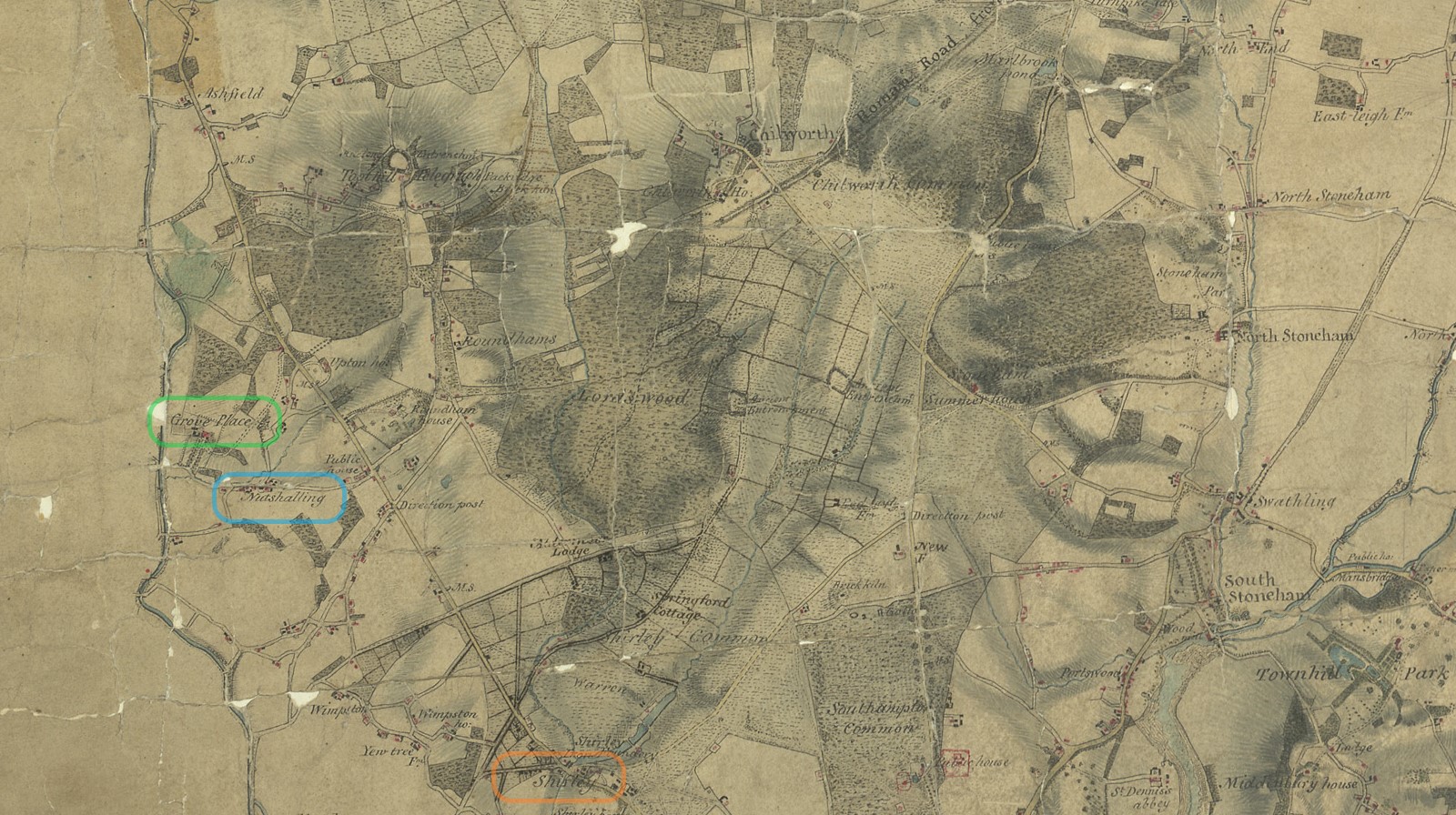
Not circled, but the following can also be seen on this map extract. Lordswood, Roundhams {Rownhams}, and Toothill, with the Telegraph. Together with a few named houses, Springford Cottage, Aldermore Lodge, Roundham House, Upton House, and Chilworth House,
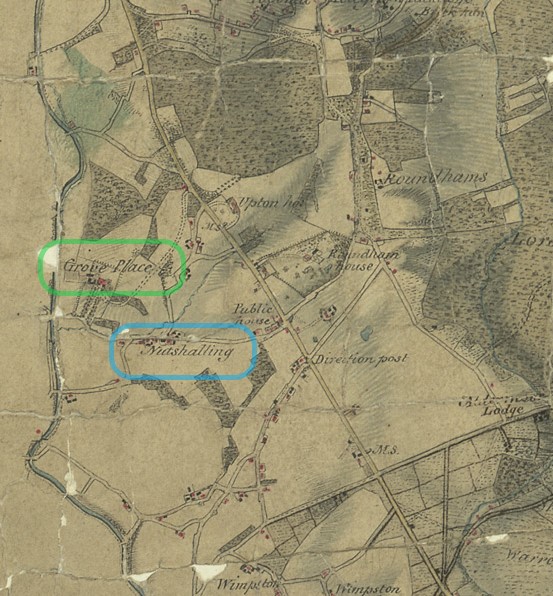
This is the same Drawing referred to above but zooming to Grove Place and Nutshalling.
We are getting ahead of ourselves. Below we jump further back in time, to maps between 1575 and 1788. Nursling, or a variation of spelling of same, is shown on all the maps, despite how very small the village was.
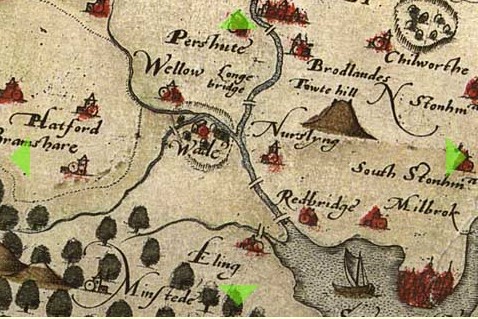 |
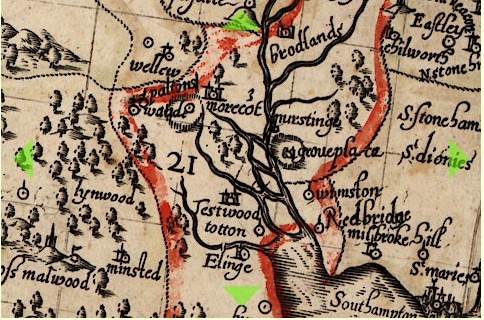 |
| Saxton 1575 | Norden 1595 |
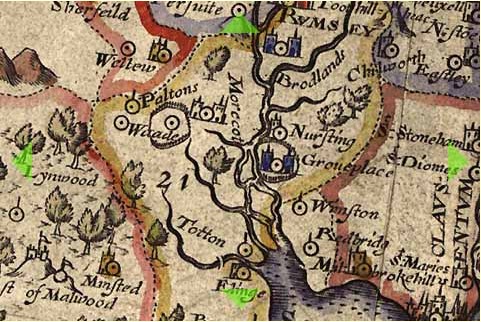 |
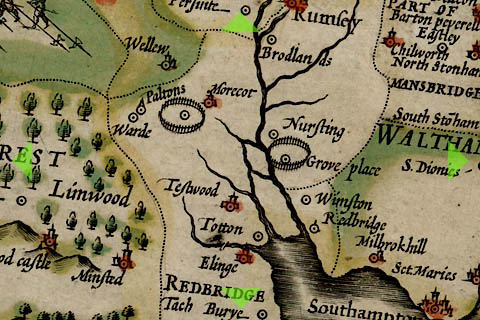 |
| Norden 1607 | Speed 1611 |
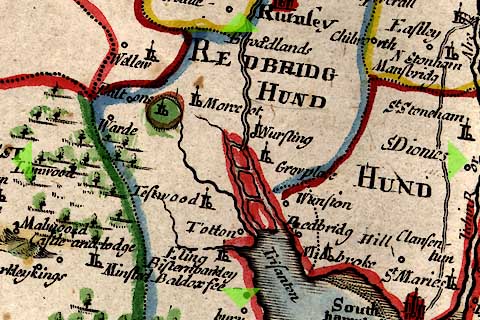 |
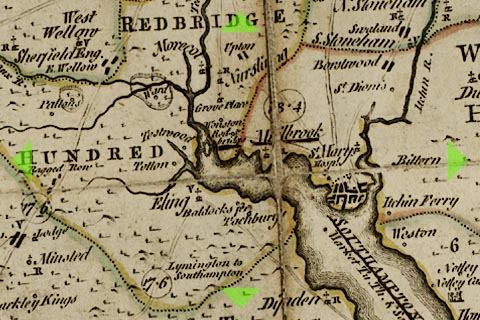 |
| Morden 1695 | Kitchen 1751 |
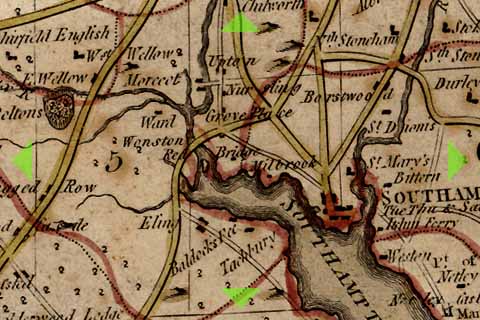 |
|
| Harrison 1788 | |
| The names and dates refer to the originator of the map and date. | |
| Click the link to go to the Old Hampshire Mapped website for more information. | |
| See how much the skill of mapping has changed over time. | |
We also need to look at some old large scale maps, also from the Old Hampshire Mapped website.
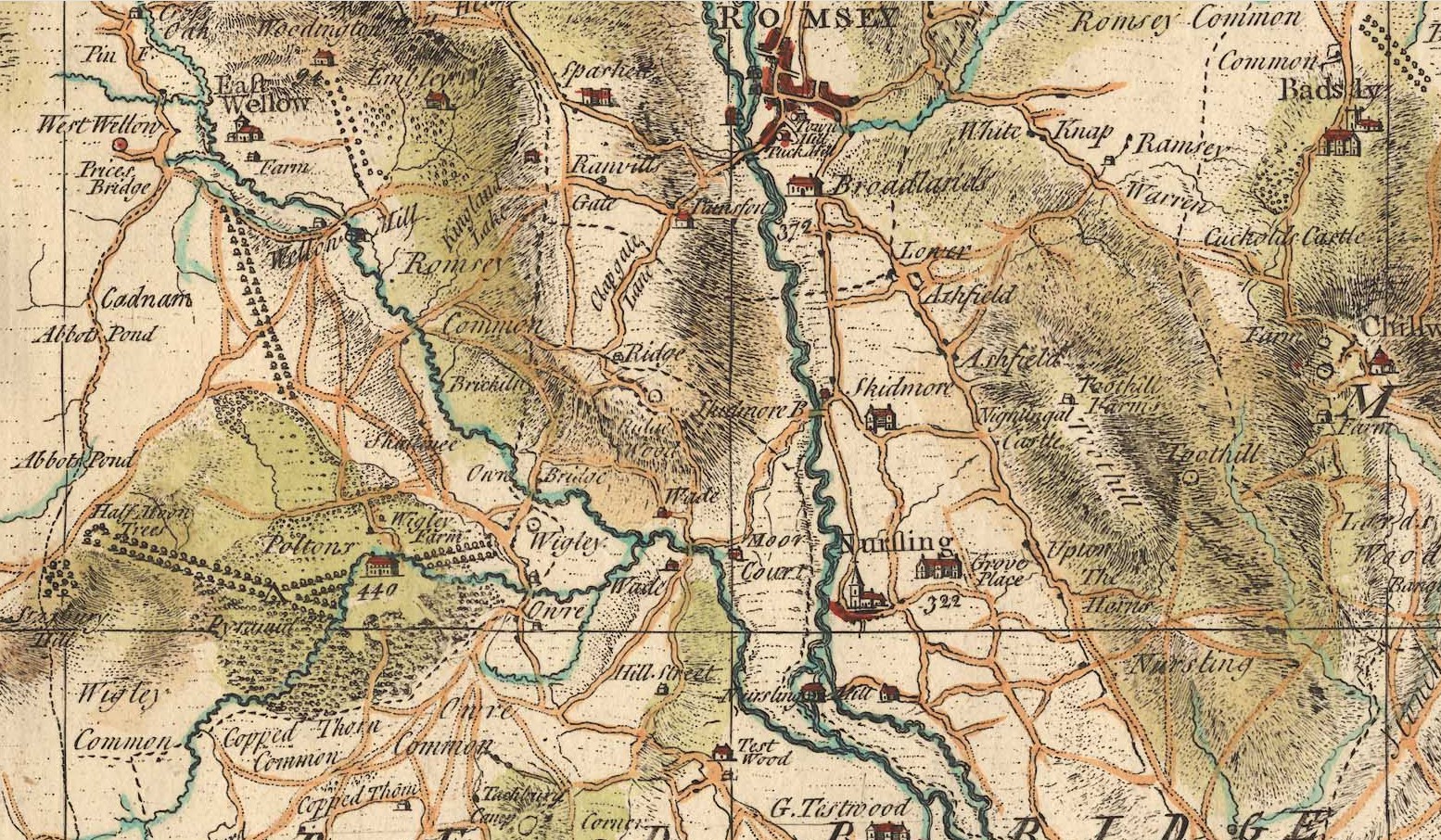
An extract of Taylor's Hampshire 1759. At 1759 this is not dissimilar to the period of interest of the article about John and Mary Mabey of Nursling. Grove Place is annotated 322.
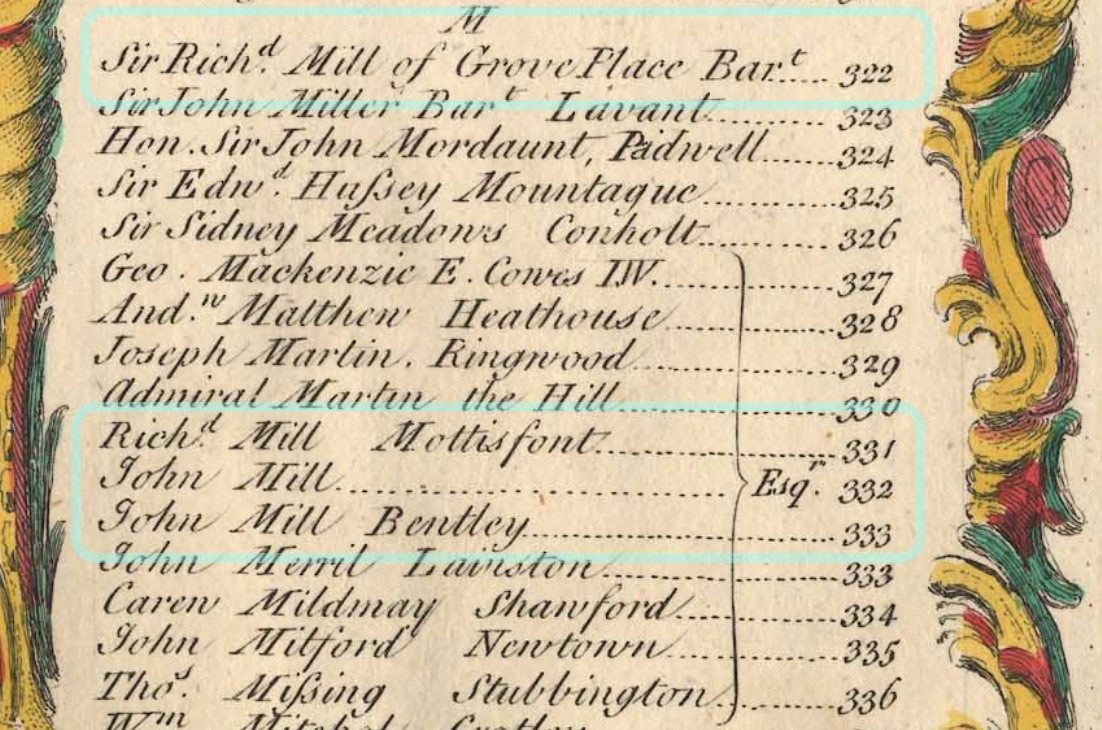
The Mill family were prominent in the area for a long time.
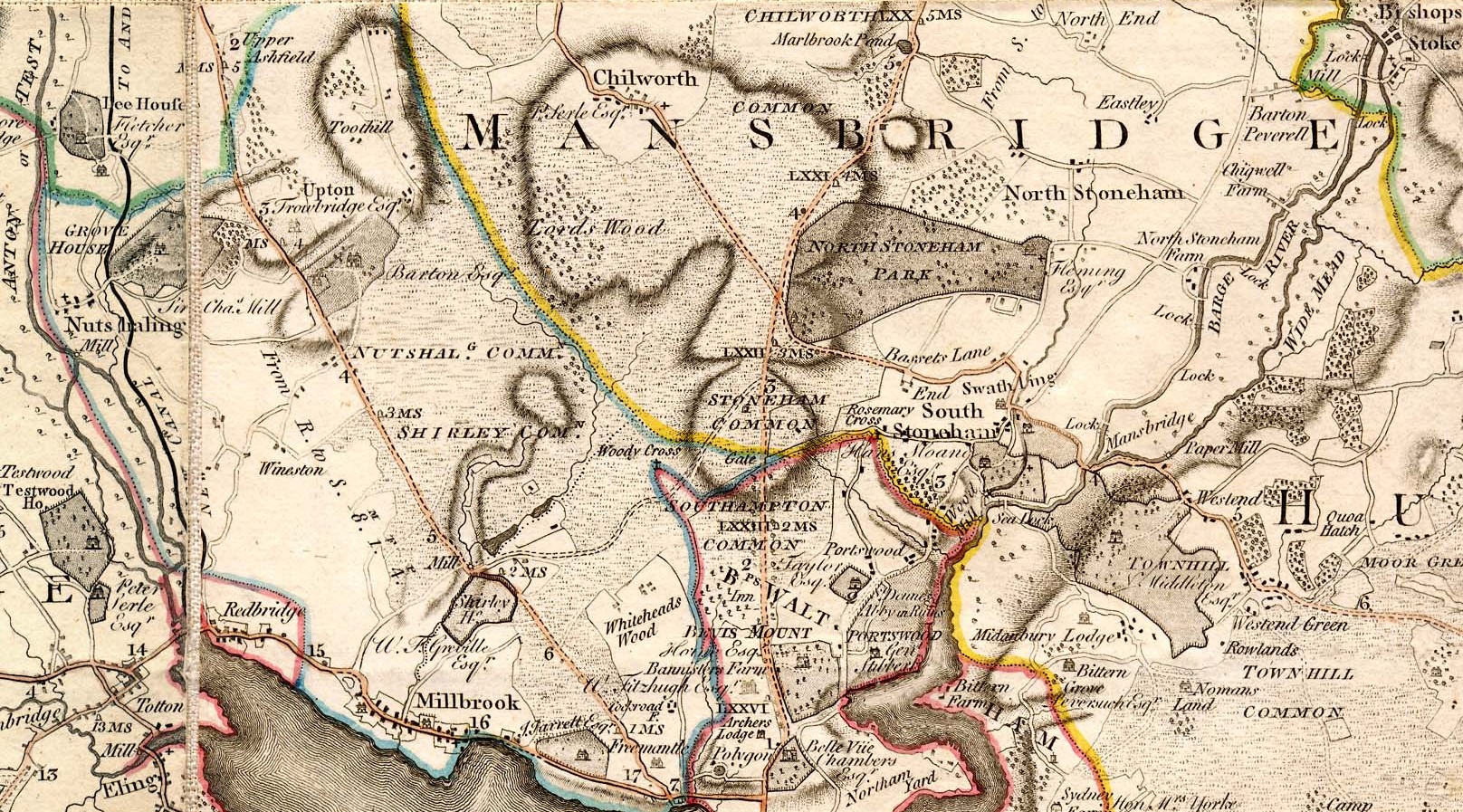
An extract from Milne's Hampshire 1791. This map has names of prominent people added as well as places
| Named people on Map | Residence | Link |
|---|---|---|
| J Jarrett Esq | Freemantle House | http://sotonopedia.wikidot.com/page-browse:freemantle-house |
| W. F. Grenville Esq | Shirley House | http://sotonopedia.wikidot.com/page-browse:shirley-house |
| Sir Charles Mill | Grove House / Place | http://sotonopedia.wikidot.com/page-browse:grove-place |
| Peter Serle Esq | Testwood House | http://sotonopedia.wikidot.com/page-browse:testwood-house |
| Barton Esq | Rownhams House | http://sotonopedia.wikidot.com/page-browse:rownhams-and-rownhams-house |
| Trowbridge Esq | Upton House | https://www.british-history.ac.uk/vch/hants/vol3/pp433-439 |
| Fletcher Esq | Lee House | http://research.hgt.org.uk/item/lee-house/ |
Nutshalling / Nursling Common and Shirley Common is shown on this map. On later maps Shirley Common is much smaller, and in the area of Whiteheads Wood.
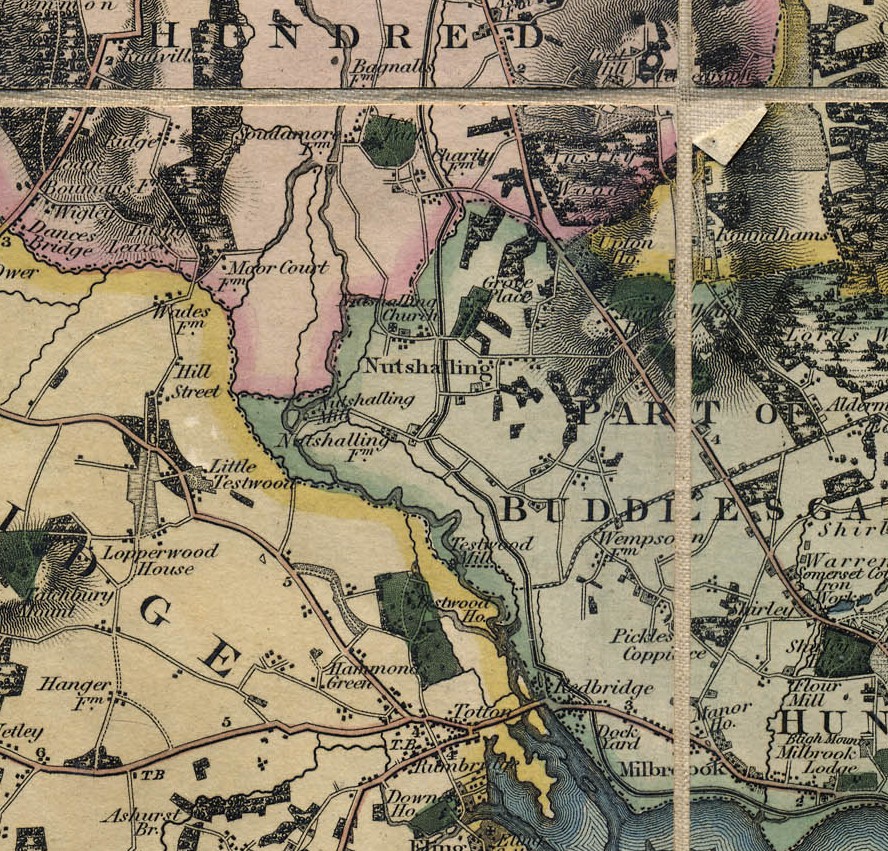
An extract of Greenwood's Hampshire 1826 with Nutshalling and Grove Place clearly shown.
The Parish
The maps so far show the village of Nursling or Nutshalling but not the extent of the parish.
NURSLING, or Nutshalling, a parish, in the union of Romsey, hundred of Buddlesgate, Romsey and S. divisions of the county of Southampton, 5 miles (N. W.) from Southampton. There is a place of worship for Wesleyans.
County map of Parishes - Hampshire
Extract from Great Britain, Atlas and Index of Parish Registers, from Ancestry
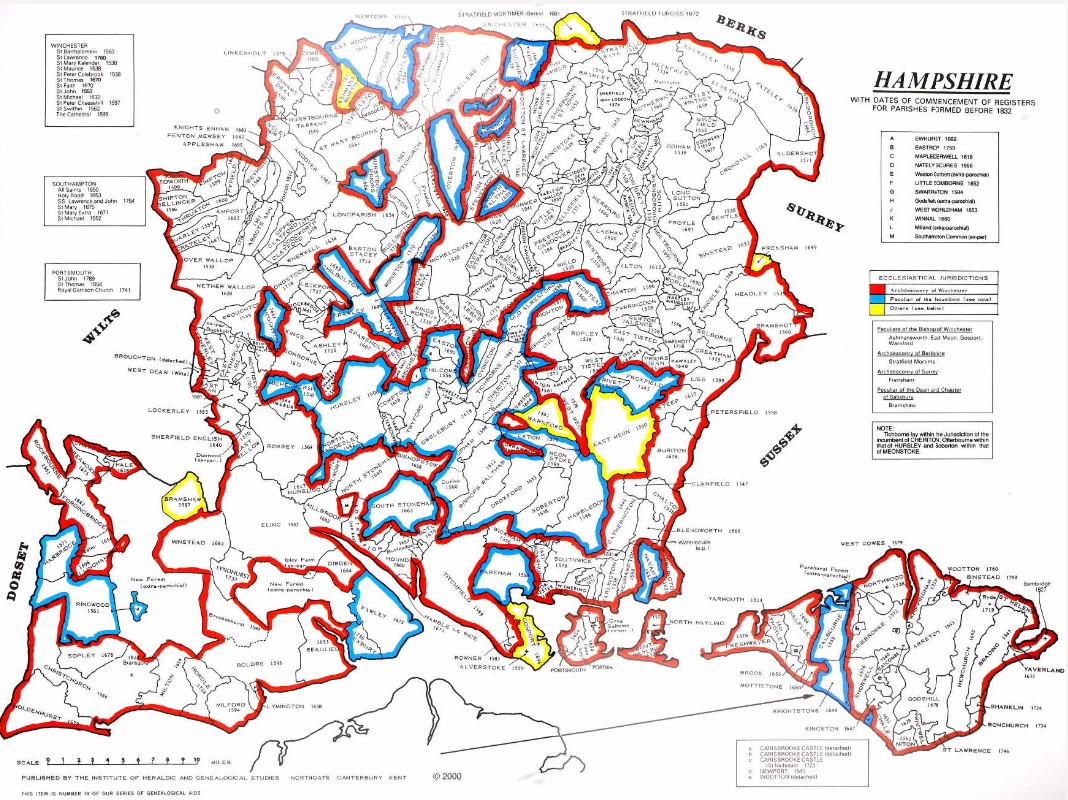
Same map but in more detail
The same map but zoomed in and split into four parts for ease of use.
There is a vertical overlap on each segment to try to avoid the difficulty of interpreting the information, reading at the joints.
At one time this was done with mouse rollover, but that no longer consistently works on all browsers, so back to static.
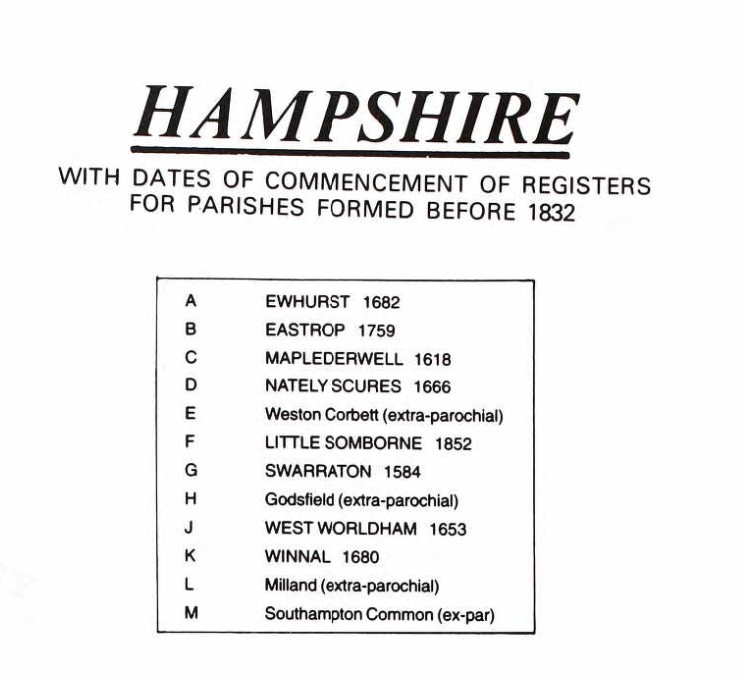
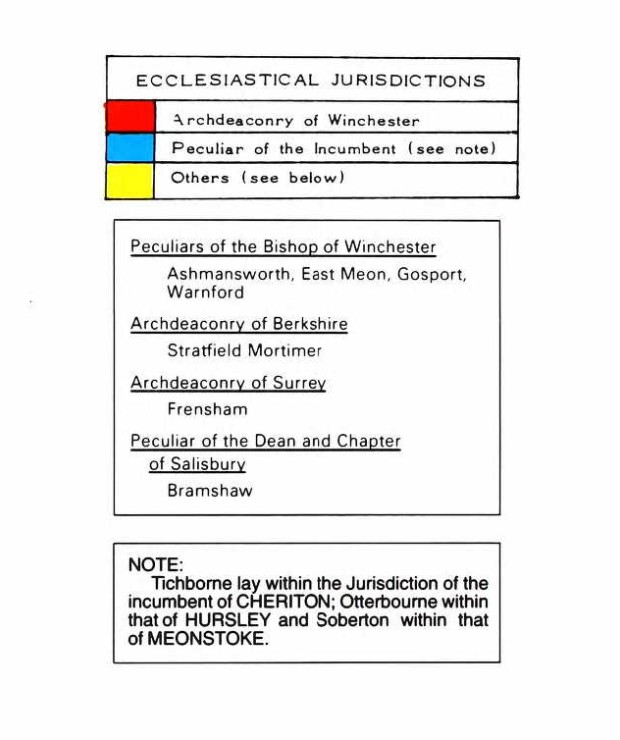
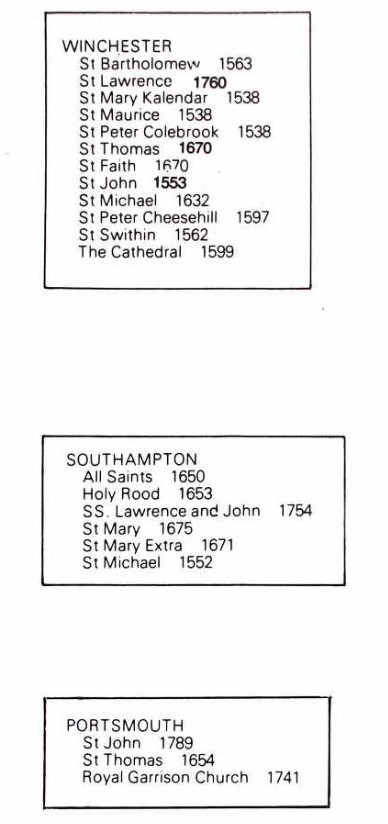
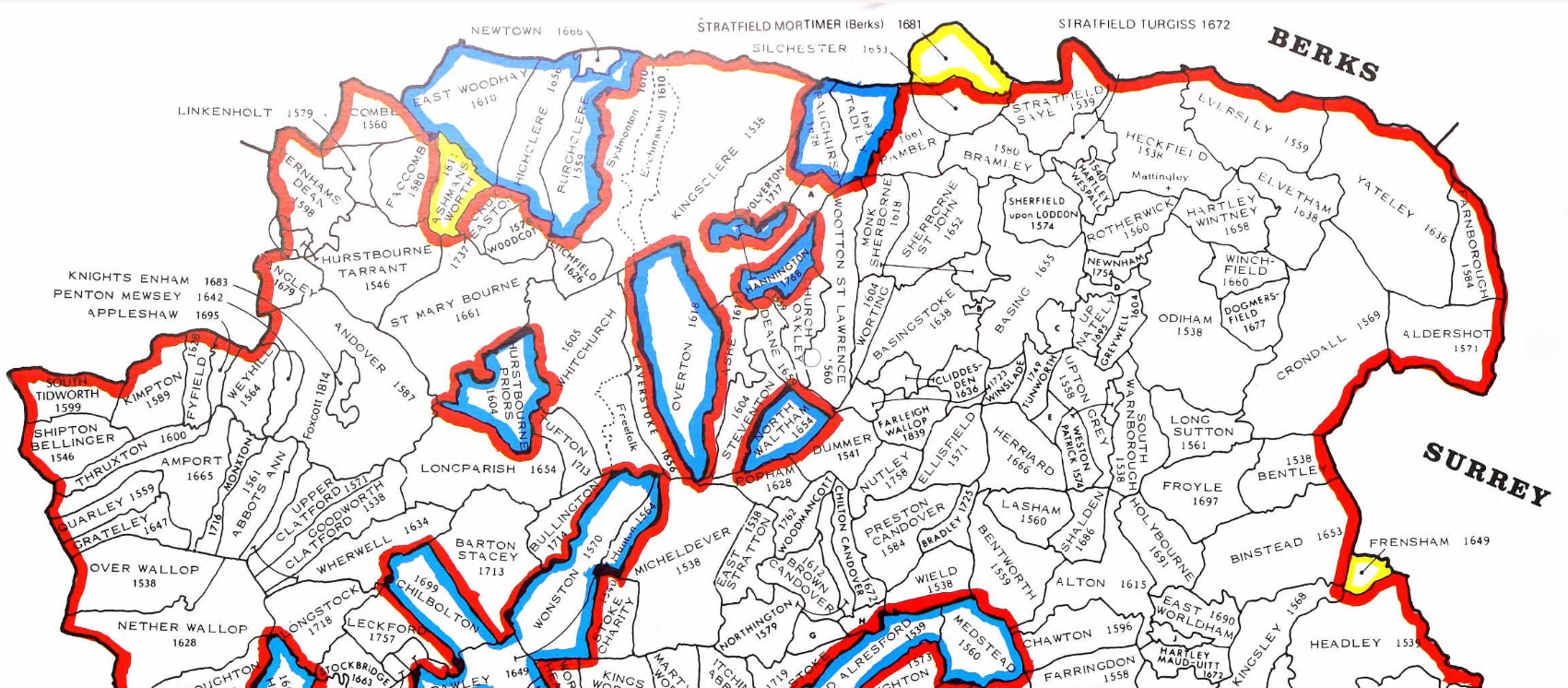
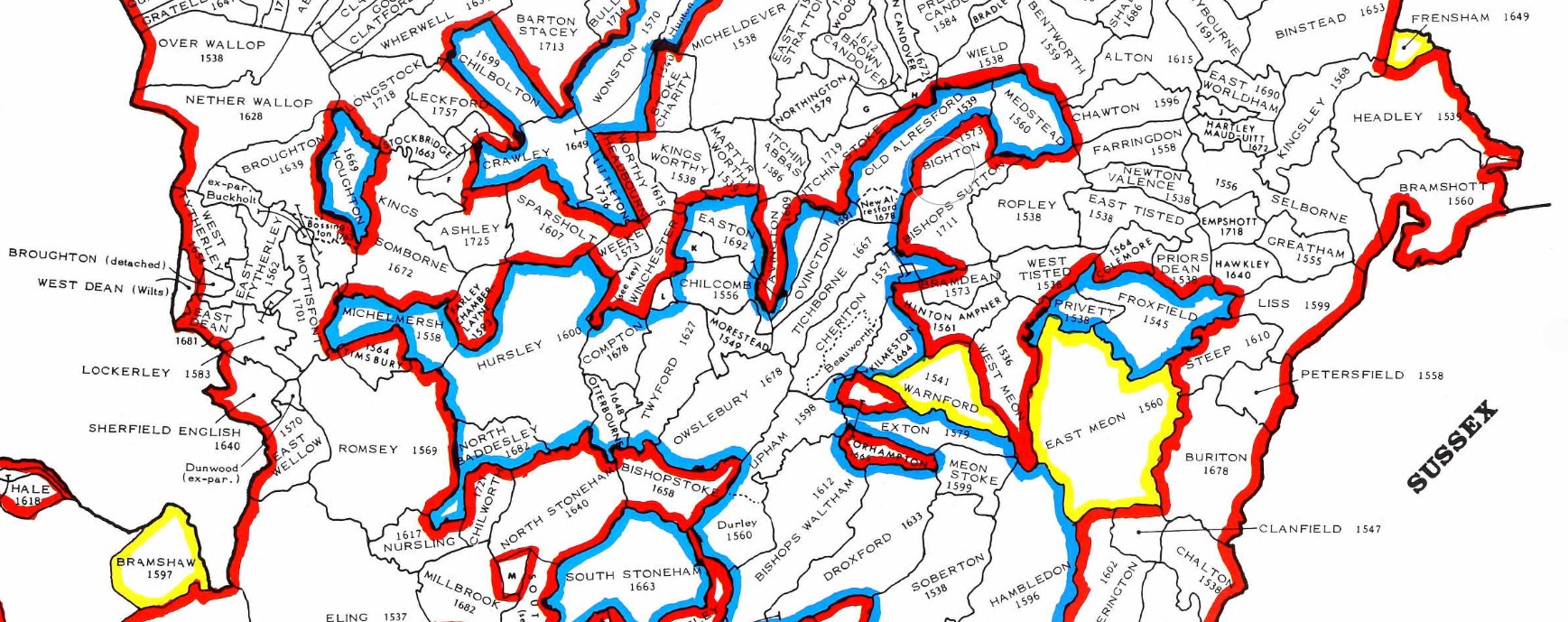
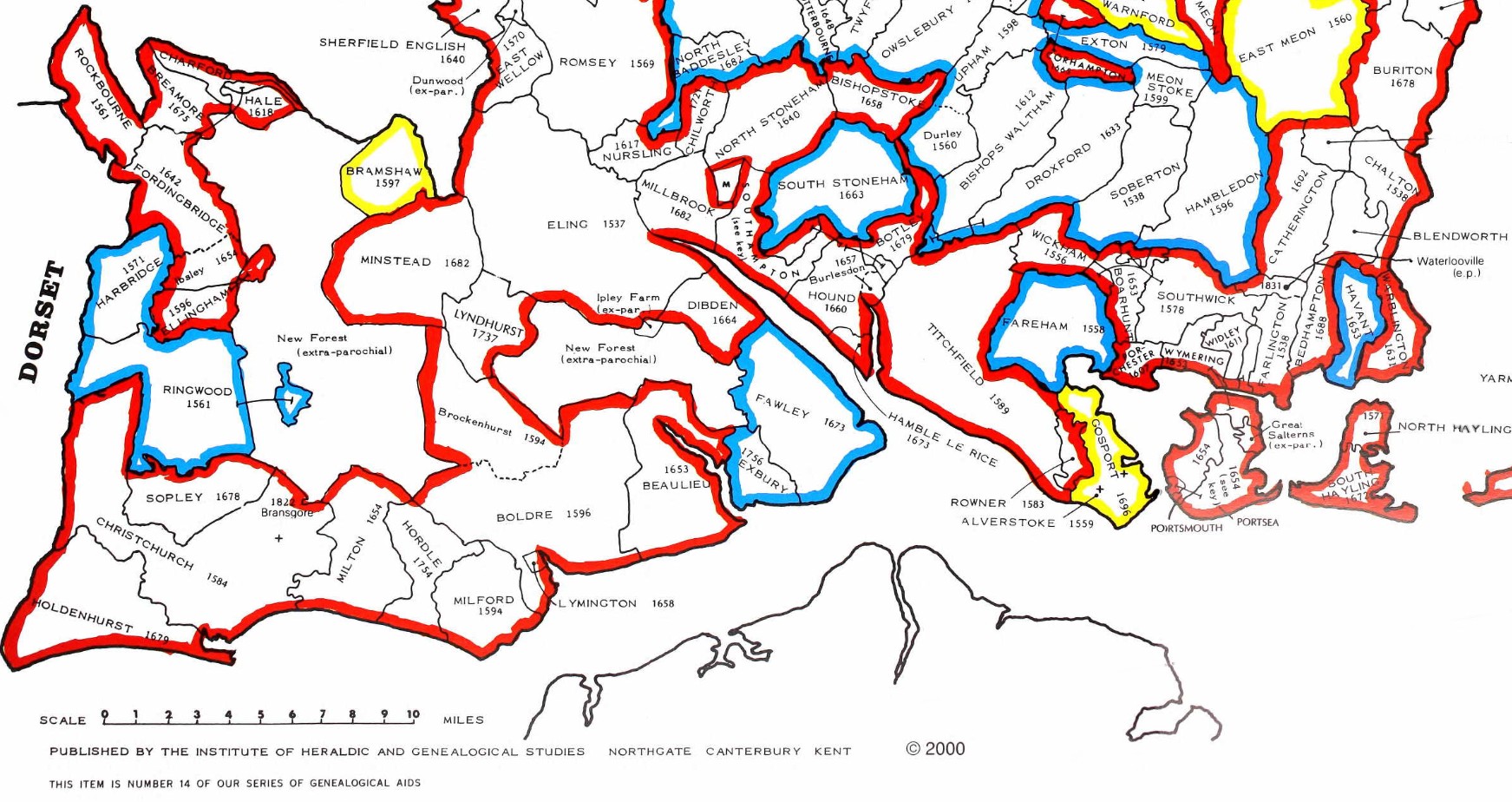
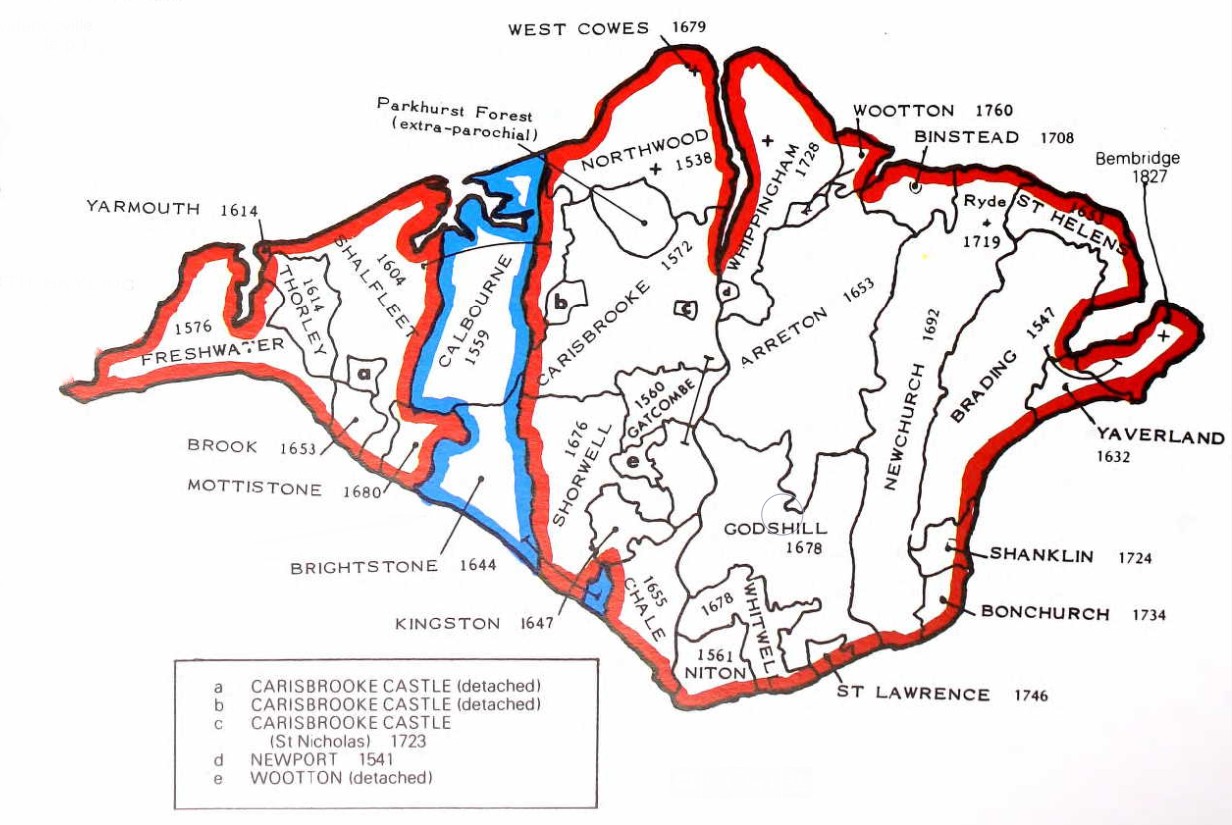
The County of Hampshire Parishes.
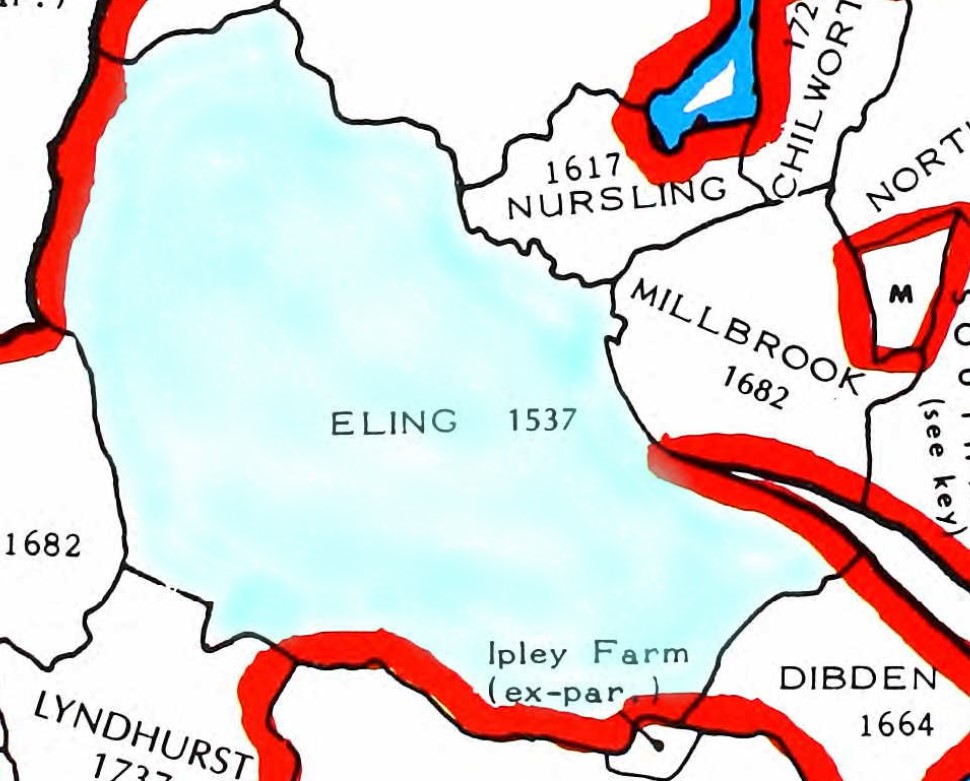
Zooming into the parish of Eling for this map, with a wash of light blue. Adjacent parishes to the North include Millbrook and Nursling. The dates indicate the early parish records.
An extract of Family Search English Jurisdictions 1851. Search for Nursling, to get the map below.
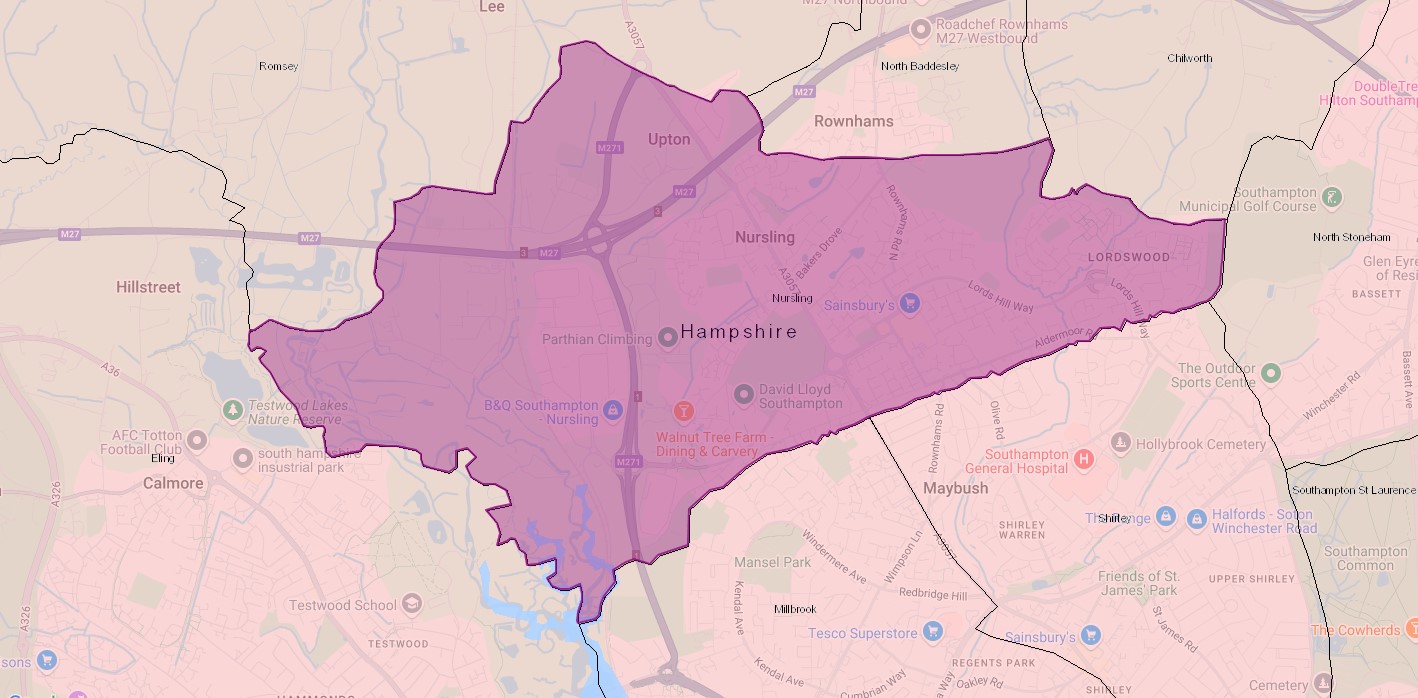
A similar map but for the parish of North Baddesley, which includes Rownhams.
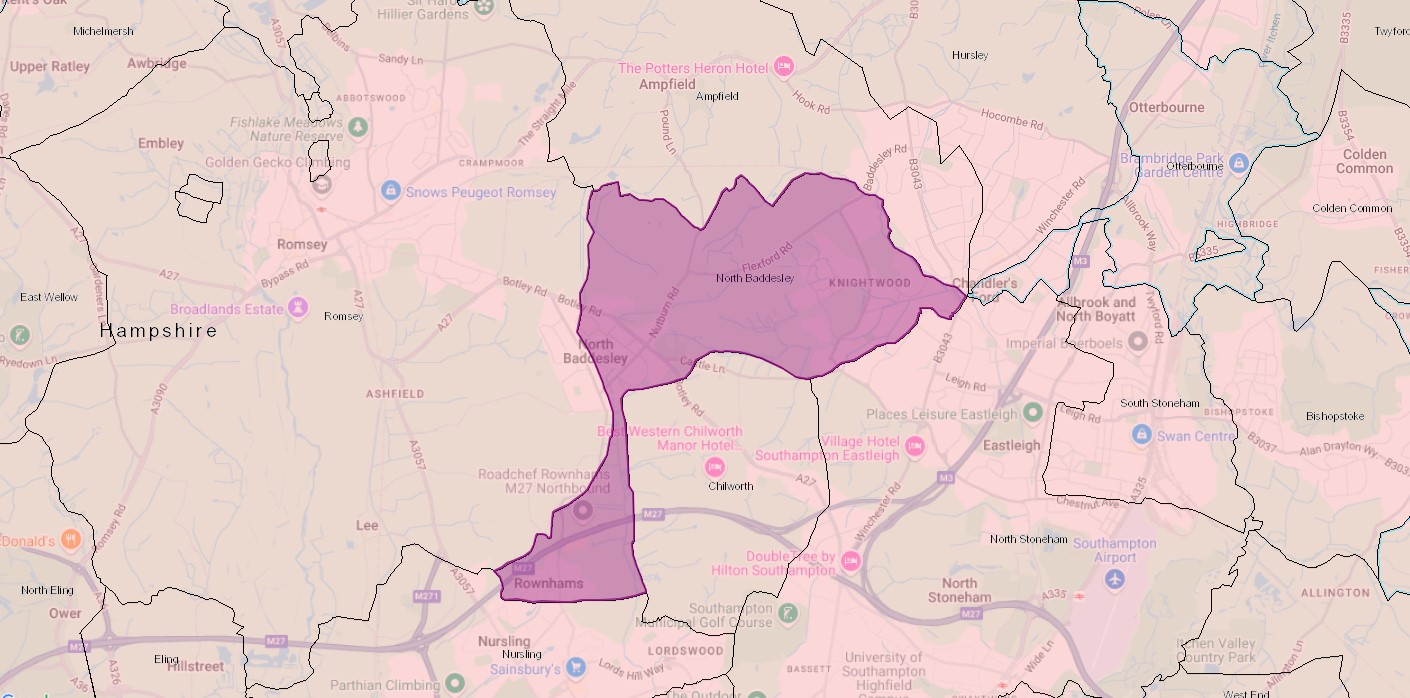
Rownhams was formerly a chapelry in the parishes of Nursling, Romsey and North Baddesley, on 1 October 1897 became a separate civil parish, on 1 April 1932 the parish was abolished to form "Nursling and Rownhams". In 1931 the parish had a population of 540.
St John’s Church in Rownhams was constructed in the 1850’s having been financed by Oliver Colt who lived in Rownhams House.
From Kelly's "Directory of Hampshire and the Isle of Wight (1911)"
ROWNHAMS is an ecclesiastical parish formed in 1856 from the parishes of Romsey Extra, Nursling and North Baddesley, and into a civil parish by Local Government Board Order No 36648, dated Oct 1st, 1897; it is 1½ miles north from Nursling station on the Southampton and Salisbury line of the London and South Western railway, 4 west-by-north-west from Southampton and 3½ south-east from Romsey, in the New Forest division of the county, hundred of Buddlesgate, union of Romsey, county court district of Romsey, rural deanery of Romsey and archdeaconry and diocese of Winchester, overlooking the valley of the Test, and bounded on the side by the road from Southampton to Romsey. The church of St. John the Evangelist is an edifice of stone in the Decorated style, consisting of chancel, nave, transepts, vestry, south porch and a tower with spire containing one bell and tubular chimes, hung in 1889 to the memory of the Rev. Robert Francis Wilson M.A. vicar here 1863-1888: in the chancel is a brass to William Oliver Colt, founder of this church, died April 9th. 1853, and Jane, his widow, by whom the work was completed about 1856, who died September 5th. 1875: the church was consecrated October 25th. 1856: all the windows are stained: the reredos is of alabaster, gilt and colored (sic): there are 220 sittings. The register dates from the year 1856. The living is a vicarage, net yearly value £190, with residence and 3 acres of glebe, in the gift of the Bishop of Winchester, and held since 1891 by the Rev. George Mead M.A. of St. John's College, Oxford. The vicarage house is of red brick in the Elizabethan still, and was erected by the late Mrs. Colt, of Rownhams Park. Rownhams House, the property and residence of Lord Abinger J.P. is a mansion of brick, situated in a park of 40 acres. The chief landowners are Wilfred W. Ashley esq. M.P., J.P. of Broadlands, Romsey, Mrs Vaudry-Barker-Mill, of Langley Manor, Tankerville Chamberlayne esq. of Cranbury Park, who is lord of the manor, and John E.A. Willis Fleming esq. of Chilworth Manor. The chief crops are barley, wheat and oats. The soil is clay, sand and gravel; subsoil, clay. The area is 1985 acres of land and 4 of water; rateable value , £3428; the population in 1901 was 498 in the civil and 481 in the ecclesiastical parish"
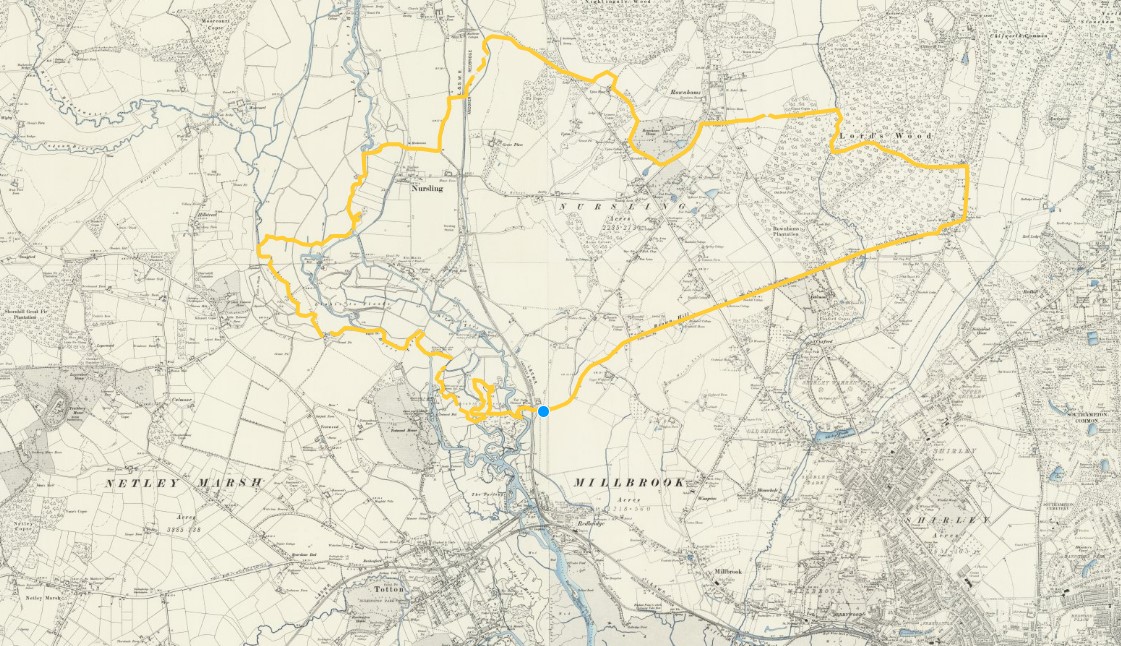
An Ordnance Survey, OS 6" Old Map from the National Library Of Scotland. The link will take you to a similar map, with the marker at St Boniface Church Nursling. The Map is made up from the following sheets;-
Hampshire & Isle of Wight Sheet LVII.SW
Revised: 1895, Published: 1897
Hampshire & Isle of Wight Sheet LVI.SE
Revised: 1895, Published: 1897
Hampshire & Isle of Wight Sheet LXV.NW
Revised: 1895 to 1896, Published: 1898
Hampshire & Isle of Wight Sheet LXIV.NE
Revised: 1895 to 1896, Published: 1897
Unfortunately, if you follow the link, the yellow line will not be there. I drew that onto the digital map using one of the tools. Zooming in a long way I followed the boundary markers, hoping they were the parish boundary.
You could also follow the doted line on the map at the link, for the detailed position. It may not be exactly the same boundary as shown on the English Jurisdictions 1851 map, above. Not only is there a time difference but the may be a difference between civil and ecclesiastical boundaries.
To get you a little closer, I have made copies of the above, zoomed in and split North and South.

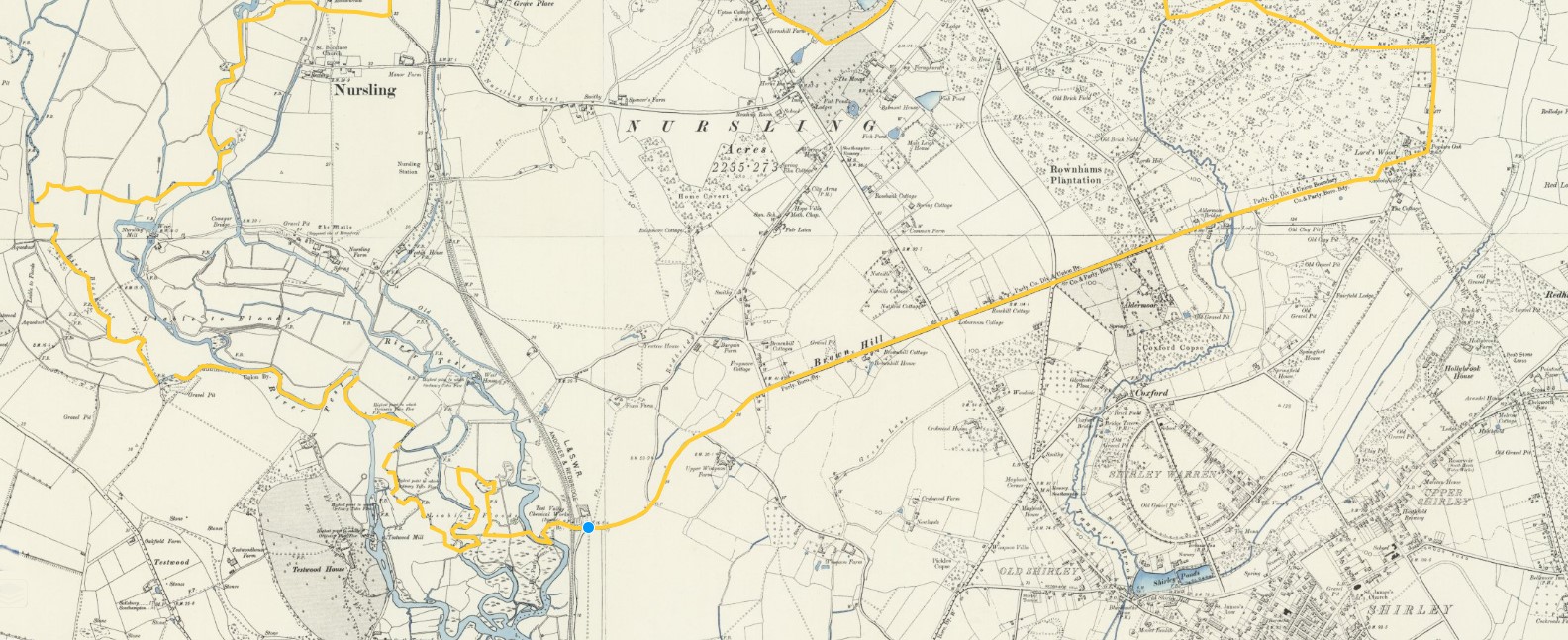
I have not tried to align the two sheets. There are some vary torturous routes for the boundary, especially near the river.
All of the above maps of the Parish are before the separation and creation of a separate Rownhams Parish from lands of Nursling, Romsey, and North Baddesley Parishes, on 1 October 1897.
However, Rownhams House and the village of Rownhams do appear to be outside of the boundary shown. It is possible that the imminent boundary change was know and incorporated onto the maps as part of the revision.
Some of the dotted lines I have followed are Poor Law Union boundaries and others are Civil Parishes. Looking further at the key, I don't think the maps show ecclesiastical boundaries, so at least that is one potential variation resolved.
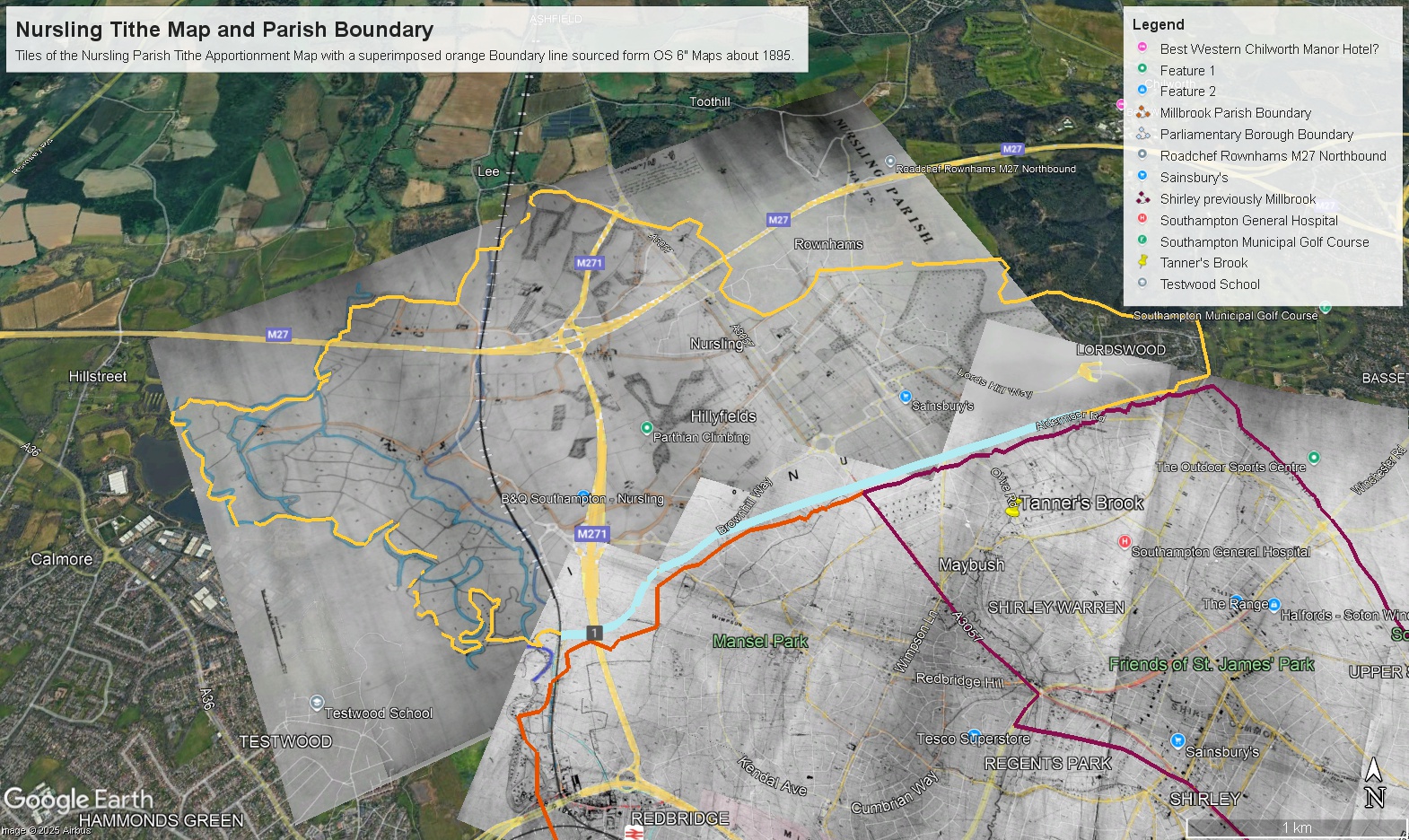
The above is a copy of a Google Earth image created by overlaying tiles of Nursling Parish Tithe Apportionment Map and the Boundary line created on the OS 6" maps above. Also shown is some of Millbrook Parish Tithe Apportionment Map. Although the lines and the edge of the Tithe Map do not align everywhere, there is a reasonable correlation. Apart for part of Lordswood, which appears to be missing. Although, on the original image it does go further into Lordswood, closer to the shape of the boundary. Something to rectify at a later date. The Tithe Apportionment is dated 19th Sept 1846. My conclusion therefore is that the orange line above is before the separation of part of the Parish for the creation of the Parish of Rownhams.
The above ESRI Church of England Parish map brings us up to date. Click on the map in the area of Nursling to bring up the boundary and information about the Parish. It does work here but it is easier to see if you first click on 'View larger map', which opens a new page. The statistics are fascinating. You can also click on one of the dots to bring up information about that. Click in different places to see different parts of the boundary, or adjacent parishes.
Eling overview
Eling Overview
Eling Hampshire
Eling a small village and town, as well as a large parish on the banks of the River Test opposite Southampton, and adjacent to the New Forest, in the county of Hampshire, sometimes known as Southamptonshire, or County of Southampton.
Bronze Age 1500BC
A Bronze Age Settlement to the North of the Town was discovered when the Testwood Lakes were excavated. A jetty, bridge and dagger were all found dating from that period.
The town has a history back to before Bronze Age times. It is thought the name Eling probably derives from Edlas’s people, or Edlingas as it appeared in the Domesday Book.
Domesday Book 1066-1086
Eling was a settlement in Domesday Book, in the hundred of Redbridge and the county of Hampshire.
It had a recorded population of 69 households in 1086, putting it in the largest 20% of settlements recorded in Domesday.
![Domesday_-_Eling.jpeg]() Land of King William
Land of King William
Households
- Households: 13 villagers. 43 smallholders. 13 slaves.
Land and resources
- Ploughland: 20 ploughlands. 5 lord's plough teams. 7 men's plough teams.
- Other resources: Meadow 125 acres. Woodland 20 swine render;in Forest. 2 mills, value 1 pound 5 shillings. 1 fishery. 1 salthouse. 1 church. 0.5 church lands.
Valuation
- Annual value to lord: 20 pounds in 1086; 38 pounds 8 shillings and 2 pence when acquired by the 1086 owner; 38 pounds 8 shillings and 2 pence in 1066.
Owners
- Tenant-in-chief in 1086: King William.
- Lord in 1086: King William.
- Lord in 1066: King Edward.
Other information
- Partially waste in 1086.
- Phillimore reference: Hampshire 1,27
Hampshire Parishes - Eling Parish 1537
Original data;
Smith, Cecil R. Humphery. The Phillimore Atlas and Index of Parish Registers. Digitized images. Institute of Heraldic and Genealogical Studies, Canterbury, Kent, England. From Ancestry
County map of Parishes - Hampshire
Extract from Great Britain, Atlas and Index of Parish Registers, from Ancestry

Same map but in more detail
The same map but zoomed in and split into four parts for ease of use.
There is a vertical overlap on each segment to try to avoid the difficulty of interpreting the information, reading at the joints.
At one time this was done with mouse rollover, but that no longer consistently works on all browsers, so back to static.







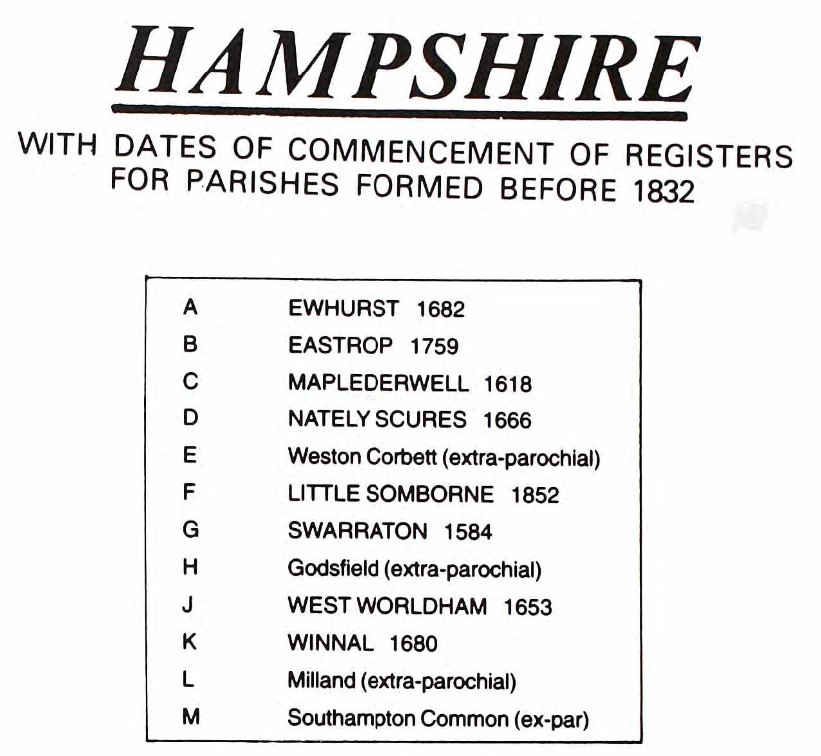
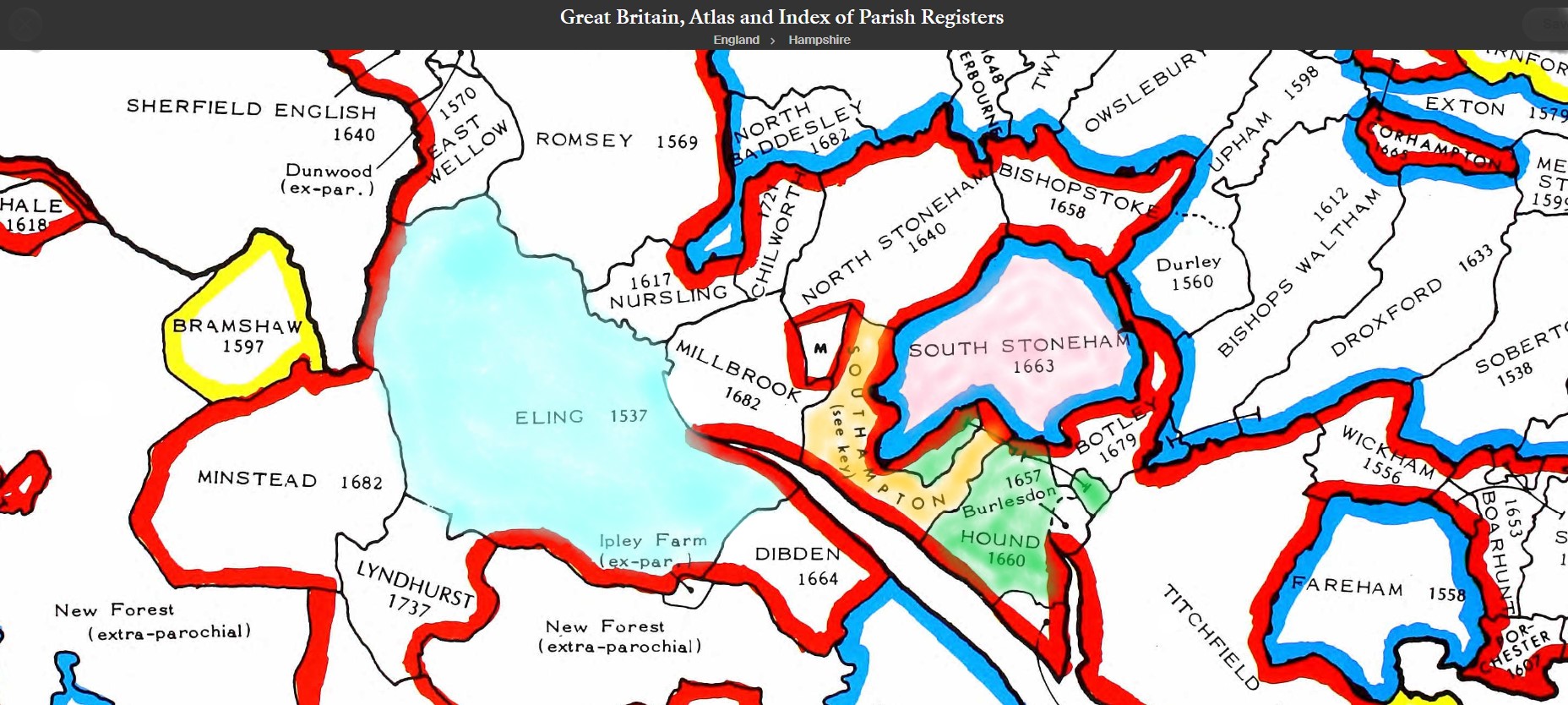
The above map is an extract of the The Phillimore Atlas and Index of Parish Registers for Hampshire. Of particular interest, the Parishes of Eling - 1537, Southampton, Hound 1660, and South Stonham 1663.
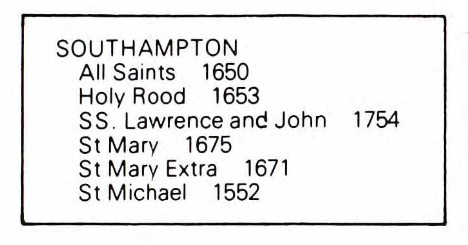
Southampton contains the following parishes;
- All Saints - 1650
- Holy Rood - 1653
- SS, Lawrence and John, sometimes written as St Lawrence and St John - 1754
- St Mary - 1675
- St Mary Extra - 1671 (Other side of the River Itchen)
- St Michael - 1552
- Southampton Common, marked as M, extra-parochial.
The dates are not when the parishes were formed but as it states by the County Title, the dates of the commencement of Registers of Parishes formed before 1832.
I think that may be expanded to dates of registers still in existence.

Old Hampshire Maps
The website for Old Hampshire Maps and Other Historic Resources is a most excellent source of information which I often refer to.
I normally click on the top left icon, Old Hampshire Mapped, but believe that the one next to it on the right is more extensive and gets to the same maps and more.
This section could be called an indulgence to my lifelong fascination with maps and travel. Maps can tell you so much more than just how to get from A to B. Maps over time add to so much more.
Generally, the maps refer to Eling the settlement as opposed to the much larger parish. Something in the history must have given Eling some significance.
Saxton 1575
Saxton's map of Hampshire 1575
Extract from the Old Hampshire Mapped website about Saxton's map.
Map, hand coloured copper plate engraving, Southamtoniae, ie Hampshire, scale about 4 miles to 1 inch, engraved by Leonard Terwoort, Antwerp, Netherlands, published by Christopher Saxton, map maker, London? about 1575.
Published in the Atlas of England and Wales; it was usually issued in hand coloured form; measurements and notes made in the field were worked up later, with the help of earlier manuscript maps if available; Saxton almost certainly used the rudimentary triangulation techniques first described by the cartographer Frisius, Belgium, 1533.
Hills are drawn in profile to provide a general impression of the local topography, while named settlements are shown by a variety of symbols including a church with tower; rivers, coastline, some bridges, deer parks and woods are all included; the most obvious omission on Saxton's maps, to our eyes, are roads, which were not included on general county maps until the 1690s.
The map '... provides us with our first english example of accurate cartography': Colonel Close: 1930:: Hampshire Field Club.
Saxton's county maps were engraved by Ryther, Hogenberg, Reynolds, Terwoort and Scatter.
Direct link to Eling.(Settlement)
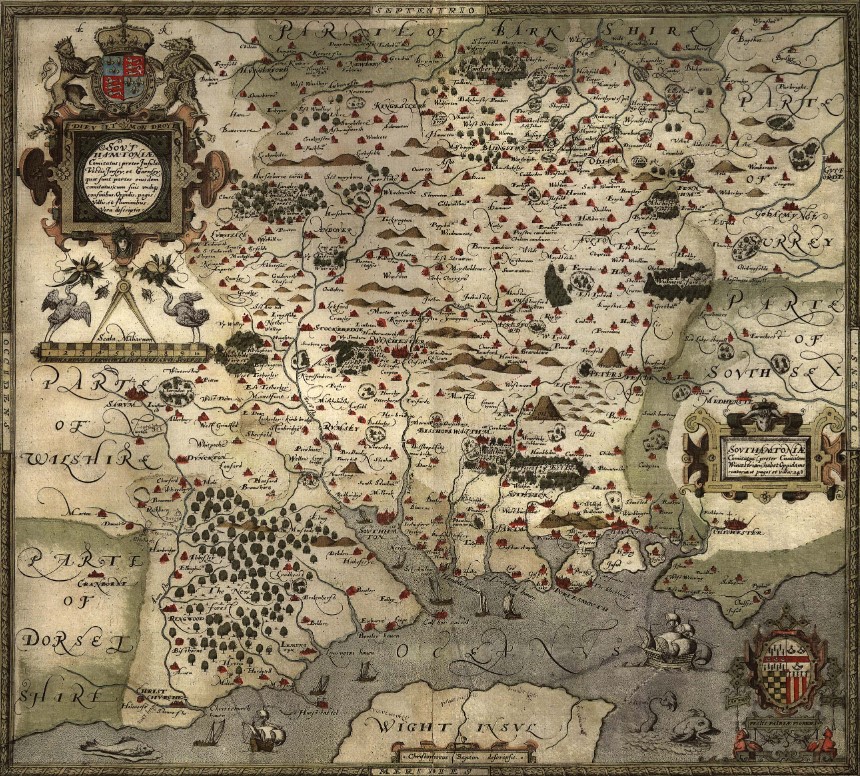
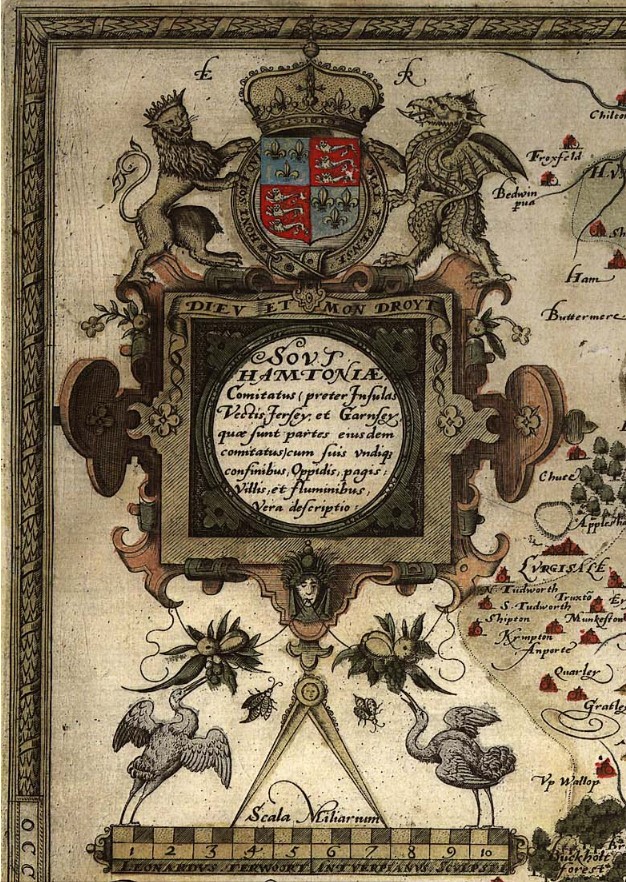
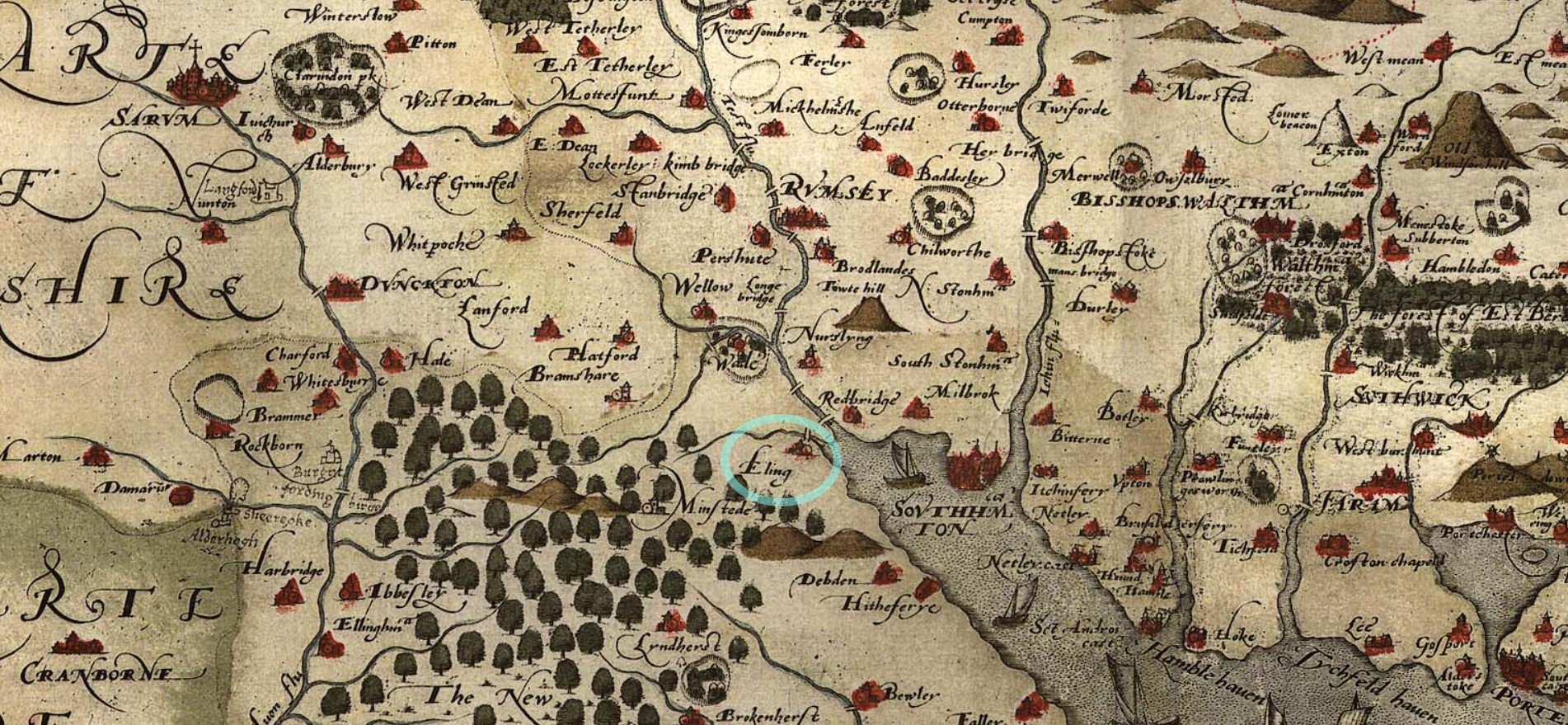
The ancient settlement of Eling circled in blue, to help locate it.
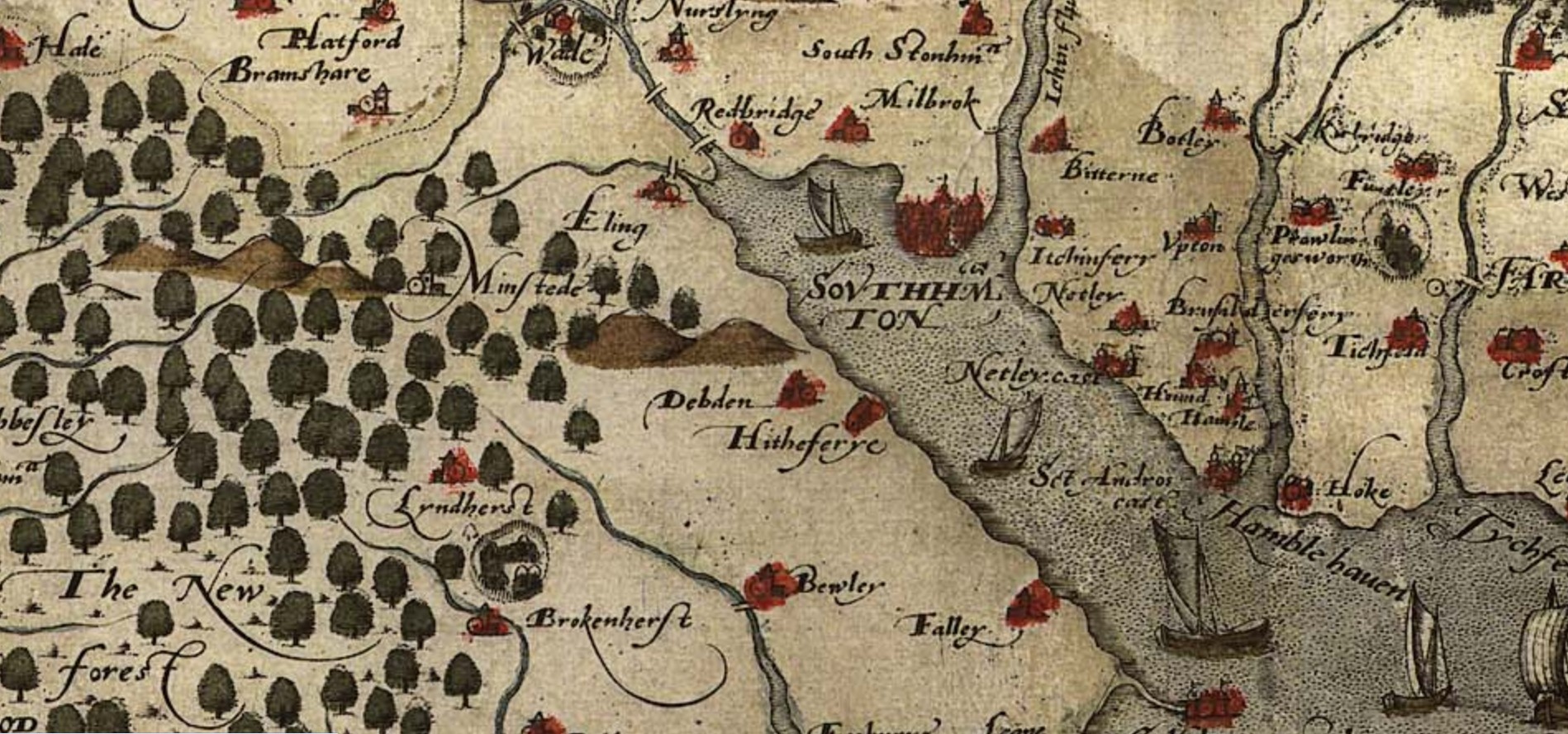
Zoomed in some more on the same map. Showing from the New Forest, Eling, Southampton, across to the Hamble.
Norden 1595
Norden's Hampshire 1595
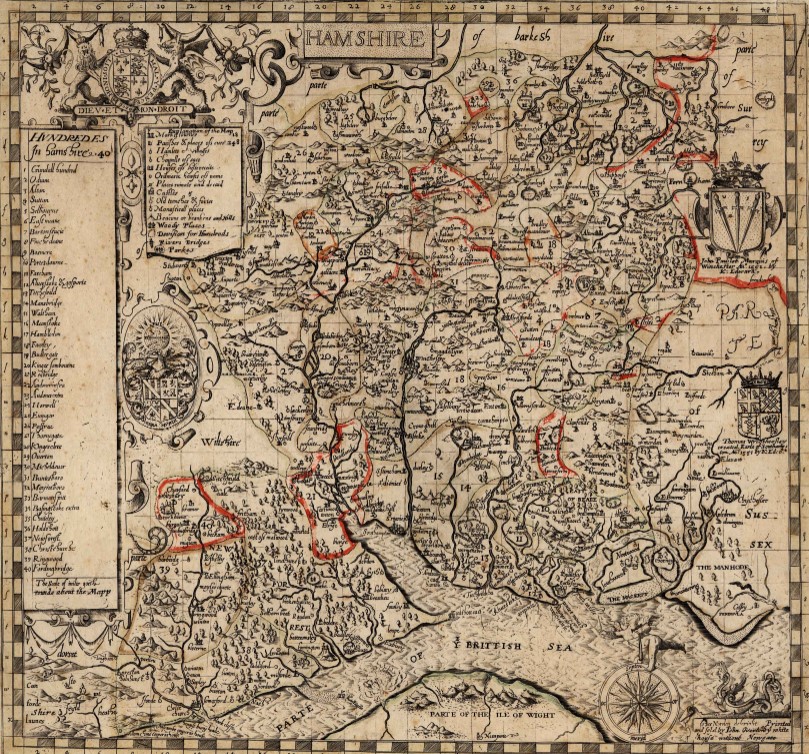
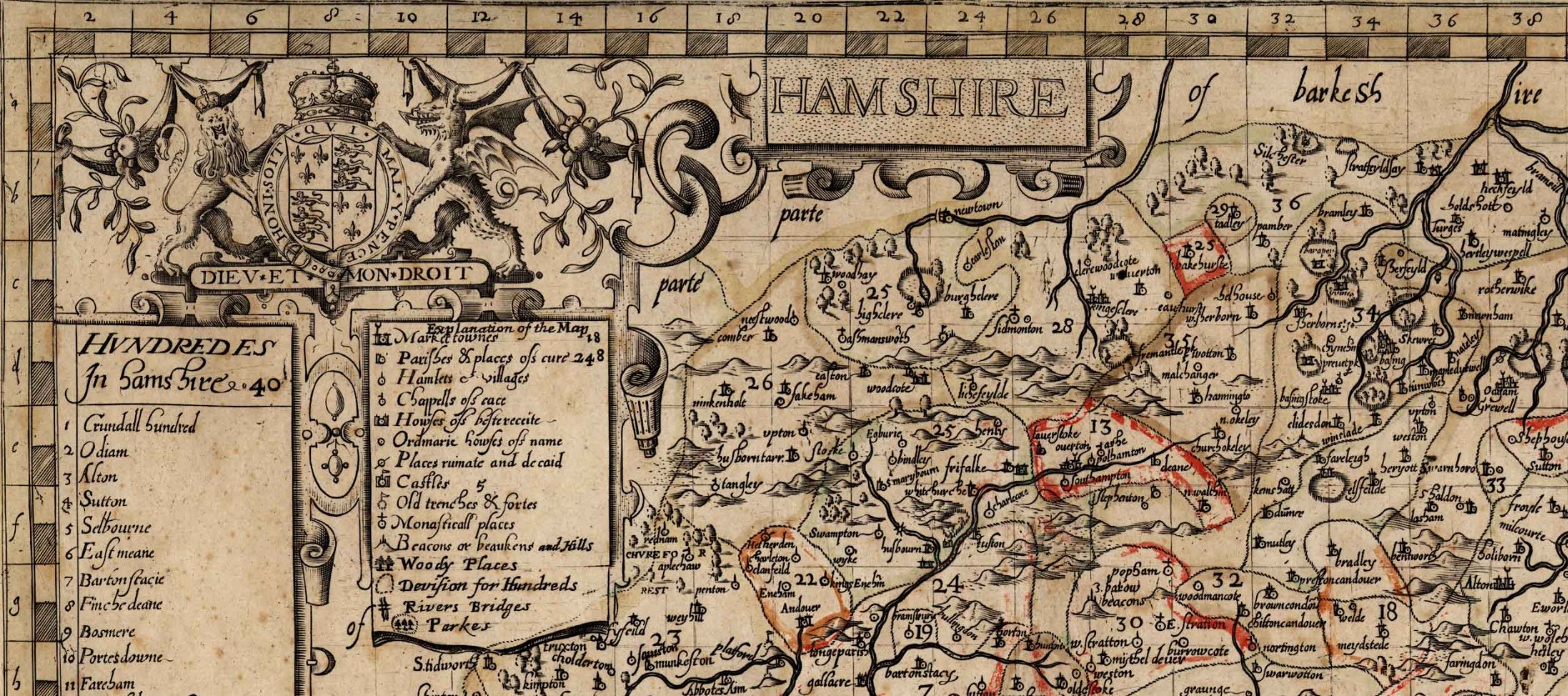
A map of Hampshire, including the Hundreds of the time. Remembering that a Hundred was an administrative area, part of and smaller than a County, and bigger than, and containing multiple Parishes.
The origin of the division of counties into hundreds is described by the Oxford English Dictionary (OED) as "exceedingly obscure". It may once have referred to an area of 100 hides; in early Anglo-Saxon England a hide was the amount of land farmed by and required to support a peasant family, but by the eleventh century in many areas it supported four families. Alternatively the hundred may have been an area originally settled by one "hundred" men at arms, or the area liable to provide one "hundred" men under arms.
Either way, a huge area of land for such a small population.
![Norden s Hampshire 1595 Hundreds and key]() Details
Details
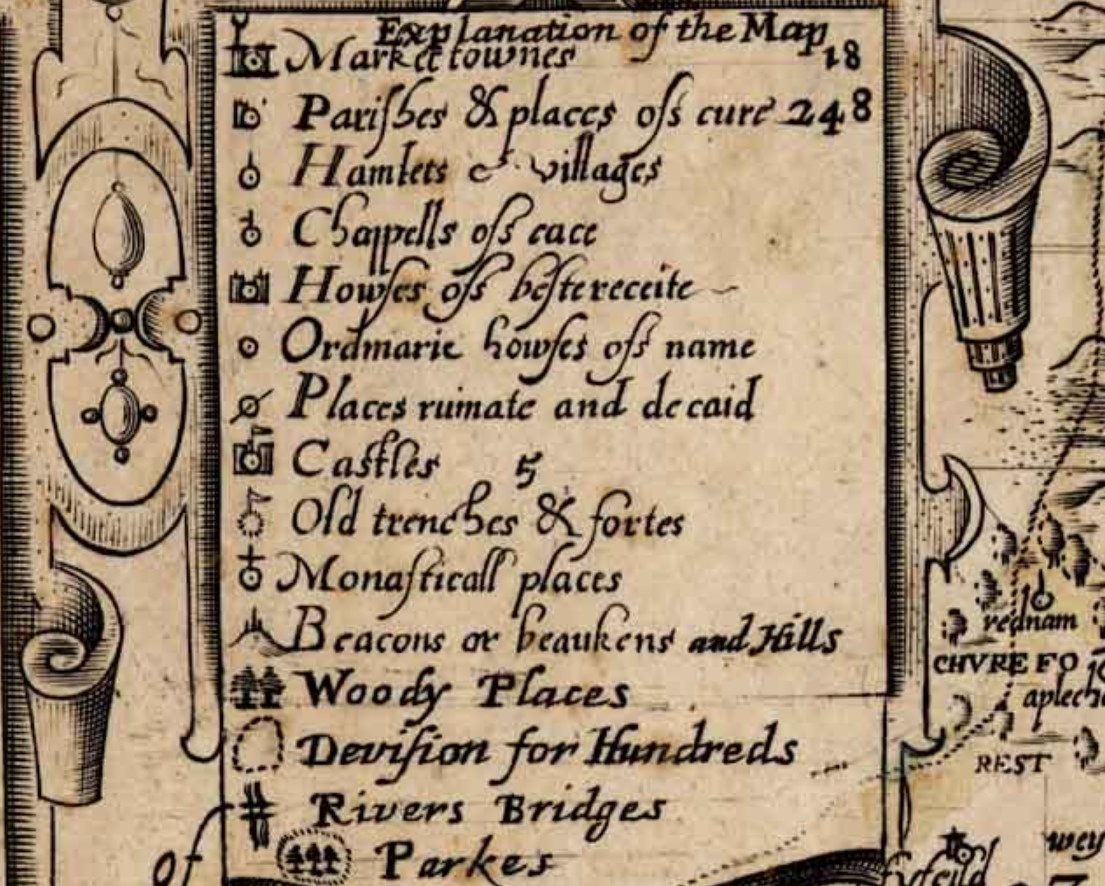
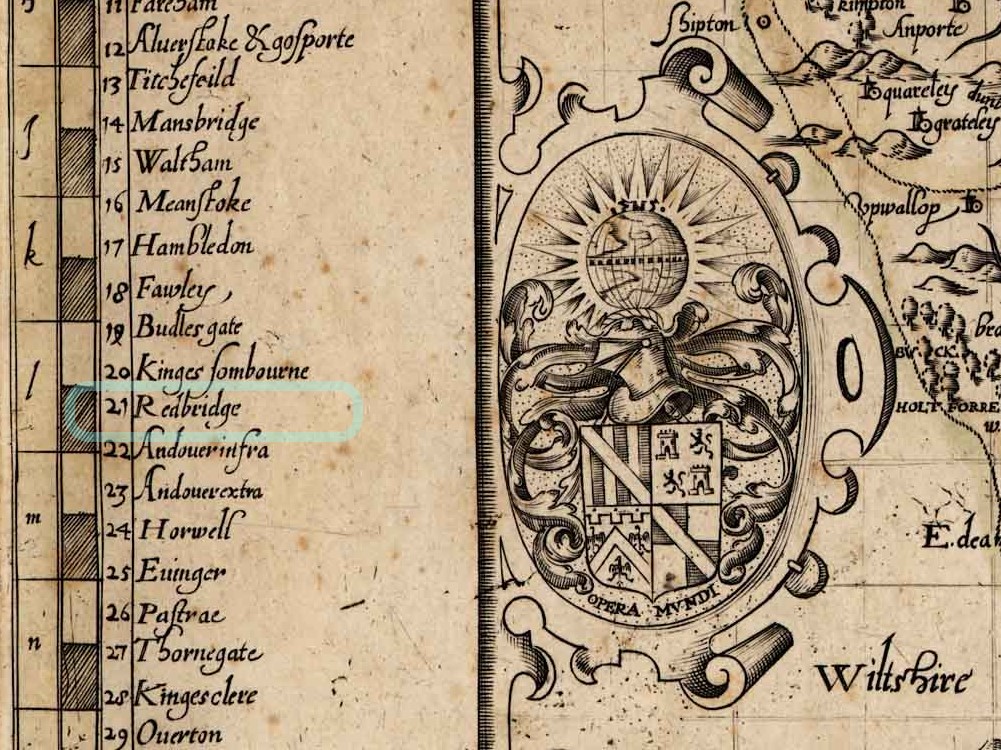
Eling is within the Hundred of Redbridge. Indicated on this map as 21. Fortunately, some of the hundreds have boundaries marked in red on this copy of the map, and 21 is one of them.
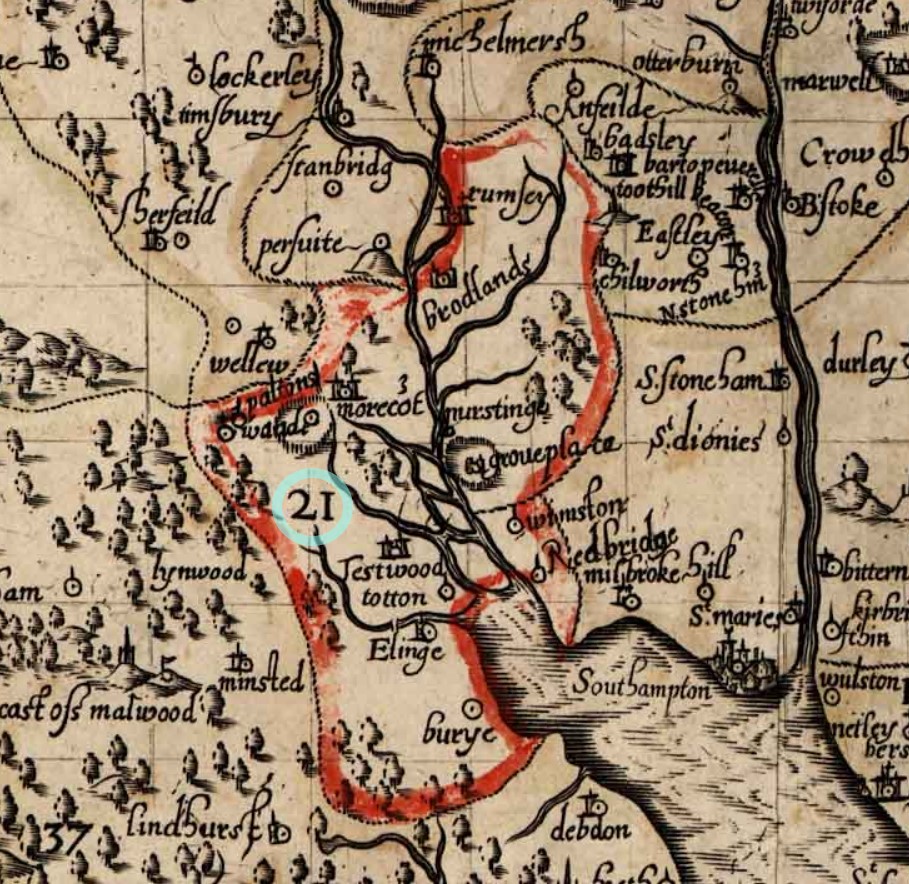
From this map it appears that the Hundred of Redbridge, at the time, extended North as far as Romsey, with its town and Abbey, including the Broadlands Estate, and South just past Elinge, on level with Lyndhurst. Note the spelling of Eling with an e at the end.
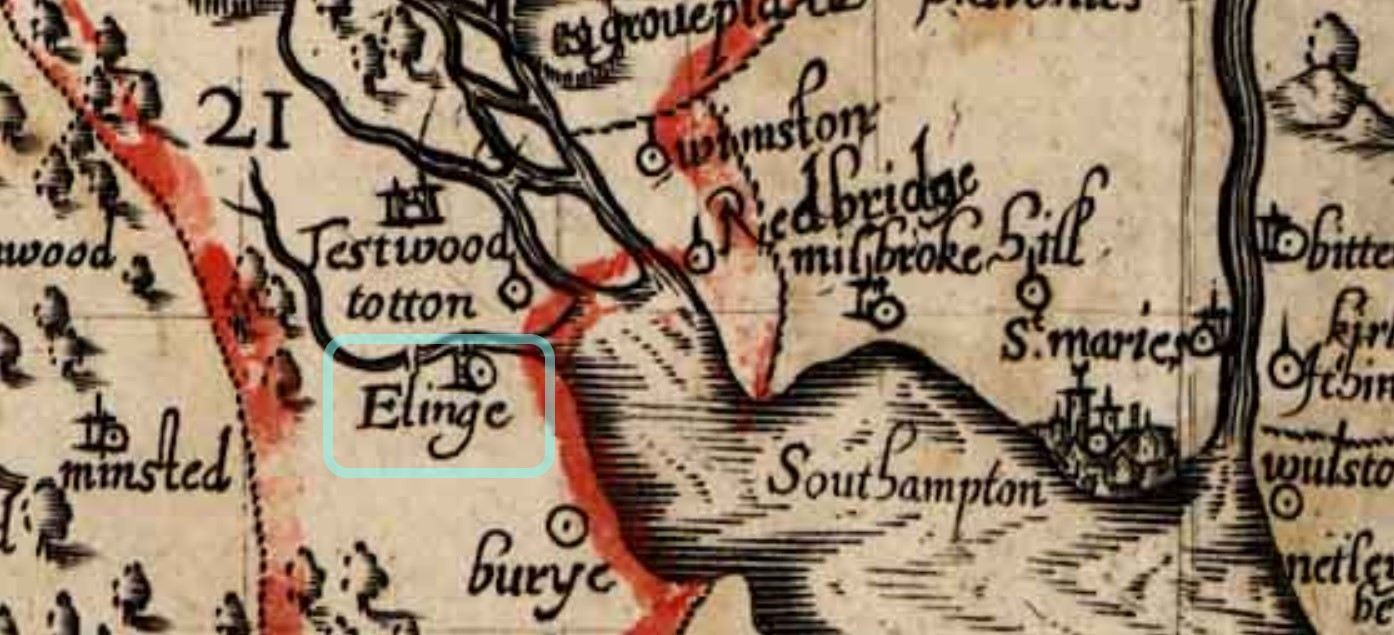
According to the Key or 'Explanation of the Map' the icon attributed to Elinge appears to be that of a Parish. This map is dated from 1595 and from elsewhere Parish Records commenced in 1537, which obviously predates the map.
Taylor's Hampshire 1759
Taylor's Hampshire 1759 - Section 33.
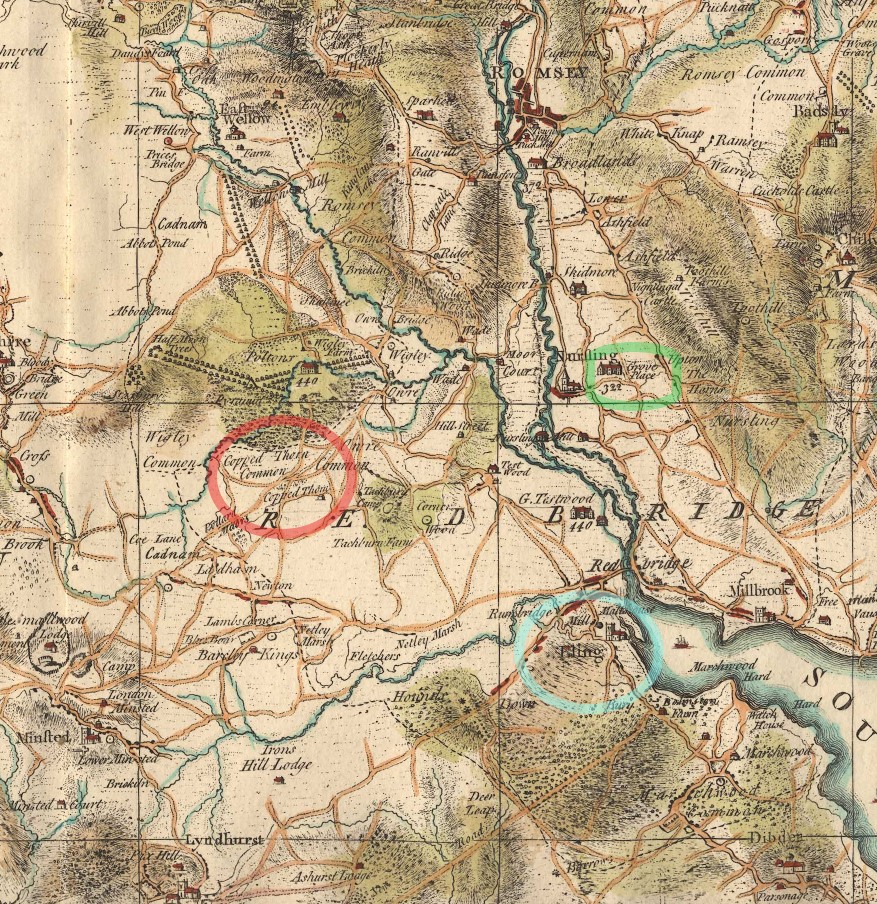
Circled in green, Grove Place, in Nursling, is not part of this story, but does get a mention elsewhere on this site. Eling, the settlement, circled in blue, is the centre of attention. Eling the parish, takes up a large portion of the map, and the Hundred of Redbridge takes up even more. Extending to Romsey
Copped Thorn Common and Copped Thorn are circled in red, and turn up later in our story, under a slightly changed name.
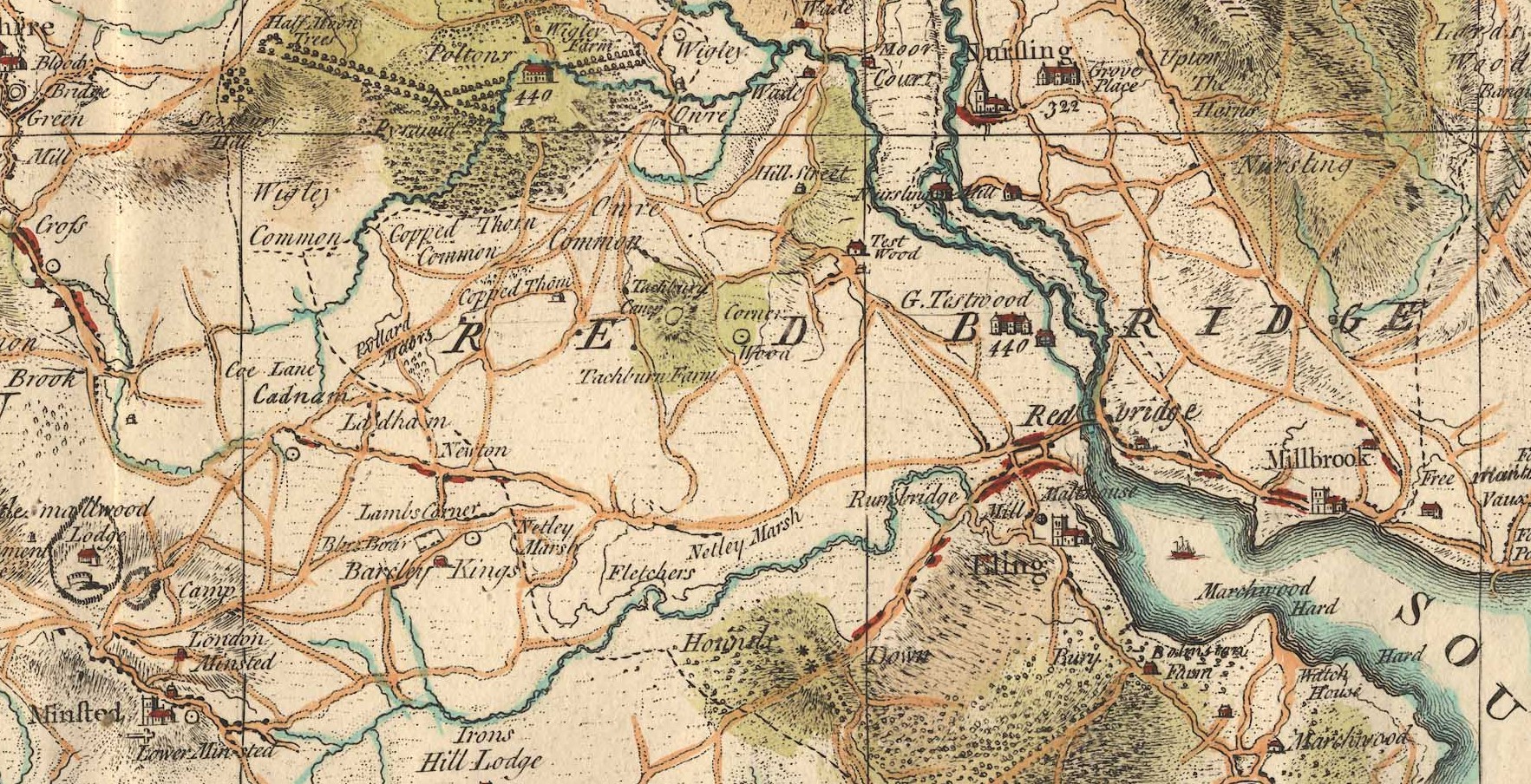
I will have to look up house 440 at Poltons. It is interesting that Great Testwood carries the same number. Poltons is now known as Paultons Park - Home of Peppa Pig World. How things change.
The estate can be traced back to 1086 where the ‘Paulet’ manor was in the possession of Glastonbury Abbey. The house became derelict and burned down in a great fire on 5 November 1963. Click the link to read about the Estate's History.
The above only looks at Section 33 of Taylor's Map of Hampshire. If you want to look at the whole map, which is very decorated, follow the link to the article Taylor's Map of Hampshire 1759 which opens in a new window.
Eling Parish Split in three 1837-1846
Ancient Parish of Eling
The Parish of Eling was divided, which is understandable, as it was a huge area, and would have had a growing population. Initially into, South to North, Marchwood, (1846), Ealing (Ancient) and North Eling (1837), .
The maps are from FamilySearch.
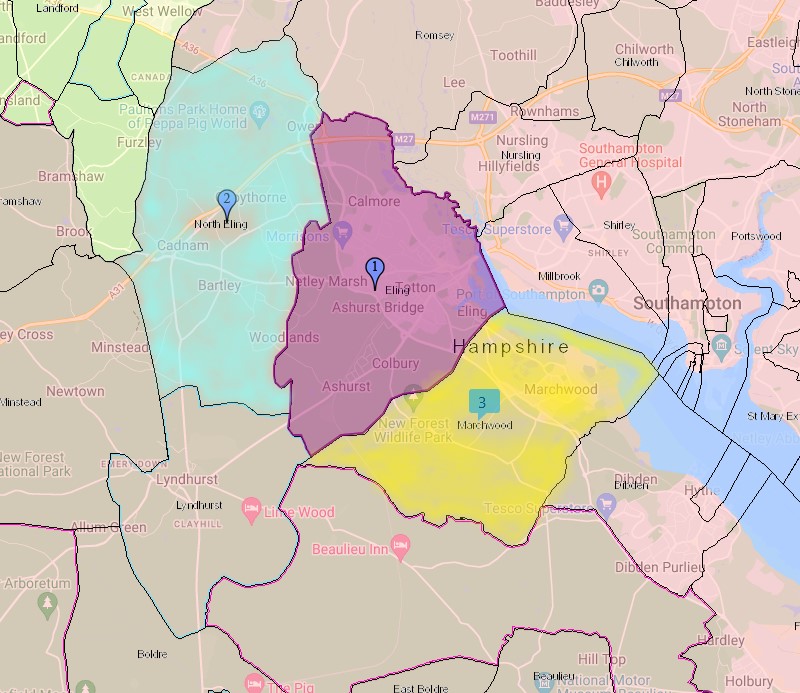
North Eling, blue wash, Eling, mouve, Marchwood, yellow.
Eling - re-sized
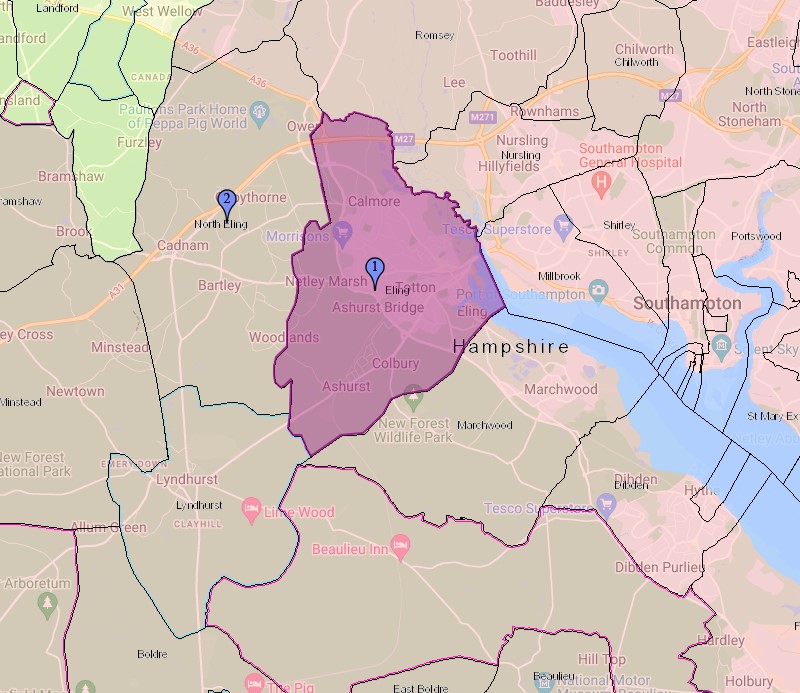
First the map with the revised size Eling parish as 1 and the newly formed North Eling as 2. Marchwood is also formed from the Ancient Parish of Ealing.
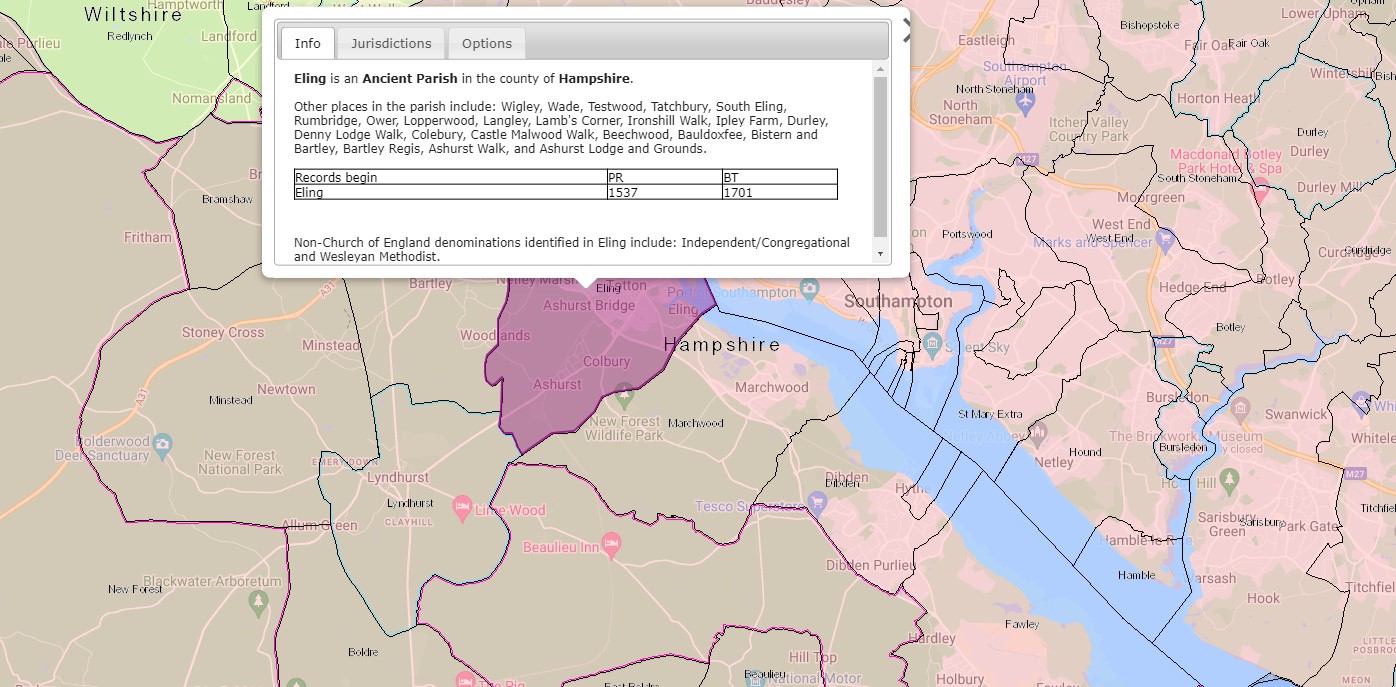
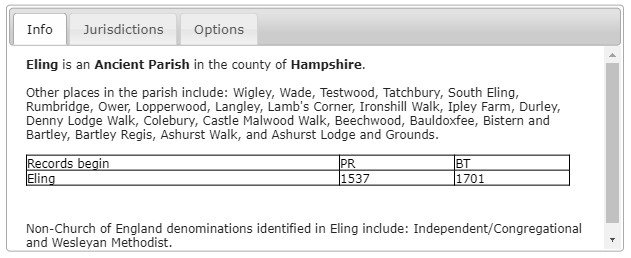
Eling is an Ancient Parish in the county of Hampshire
Other places include: Wigley, Wade, Testwood, Tatchbury, South Eling, Rumbridge, Ower, Lopperwood, Langley, Lamb's Corner, Ironshill Walk, Ipley Farm, Durley, Denny Lodge Walk, Colebury, Castle Malwood Walk, Beechwood, Bauldoxfee, Bistern and Bartley, Bartley Regis, Ashurst Walk, and Ashurst Lodge and Grounds.
Parish records begin in 1537 and Bishops Transcripts 1701.
Non-Church of England denominations identified in Eling include: Independent/Congregational and Wesleyan Methodist.
I have transcribed the image, which is clearly legible sat here, mainly to provide searchable text, but hopefully also to provide the information irrespective of the devise used to view this article.
North Eling
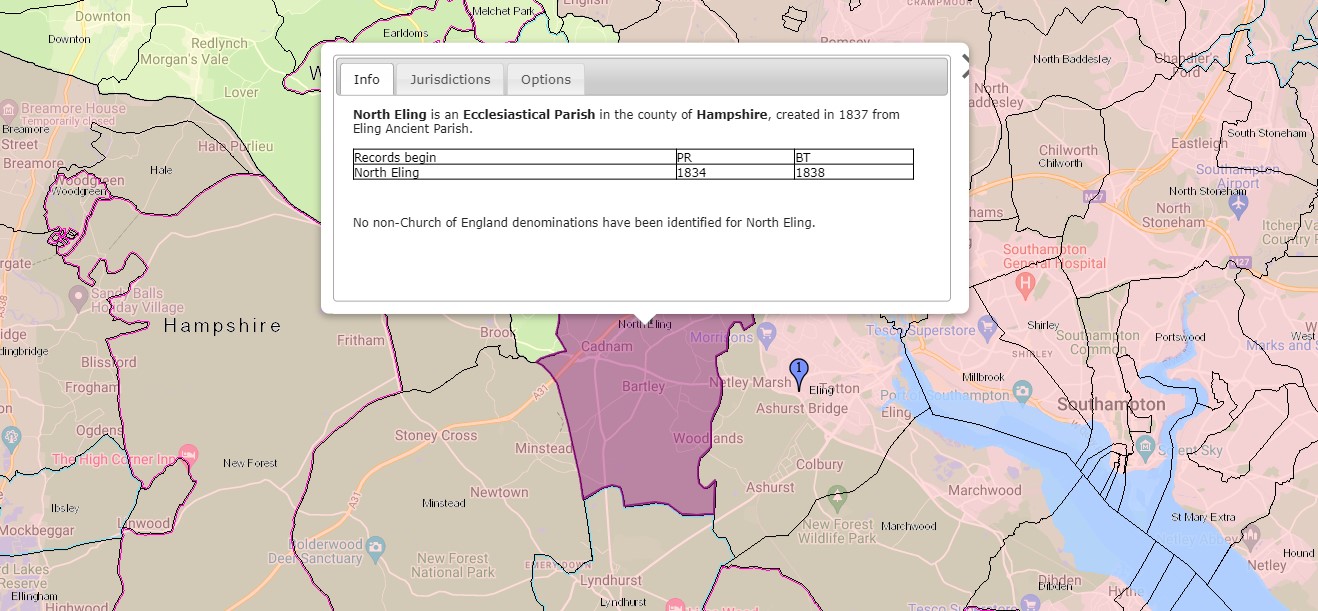
North Eling is an Ecclesiastical Parish in the county of Hampshire, created in 1837 from Eling Ancient Parish.
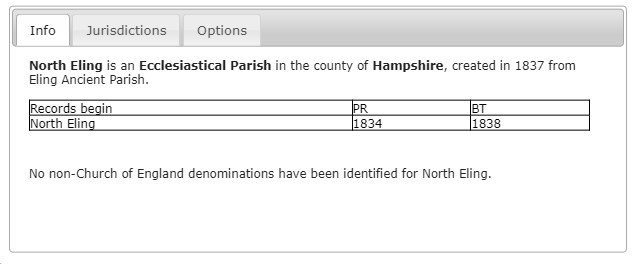
Parish records begin in 1834 and Bishops Transcripts 1838. Interesting that the Parish records commence before the creation of the parish. No non-Church of England denominations have been identified for North Eling.
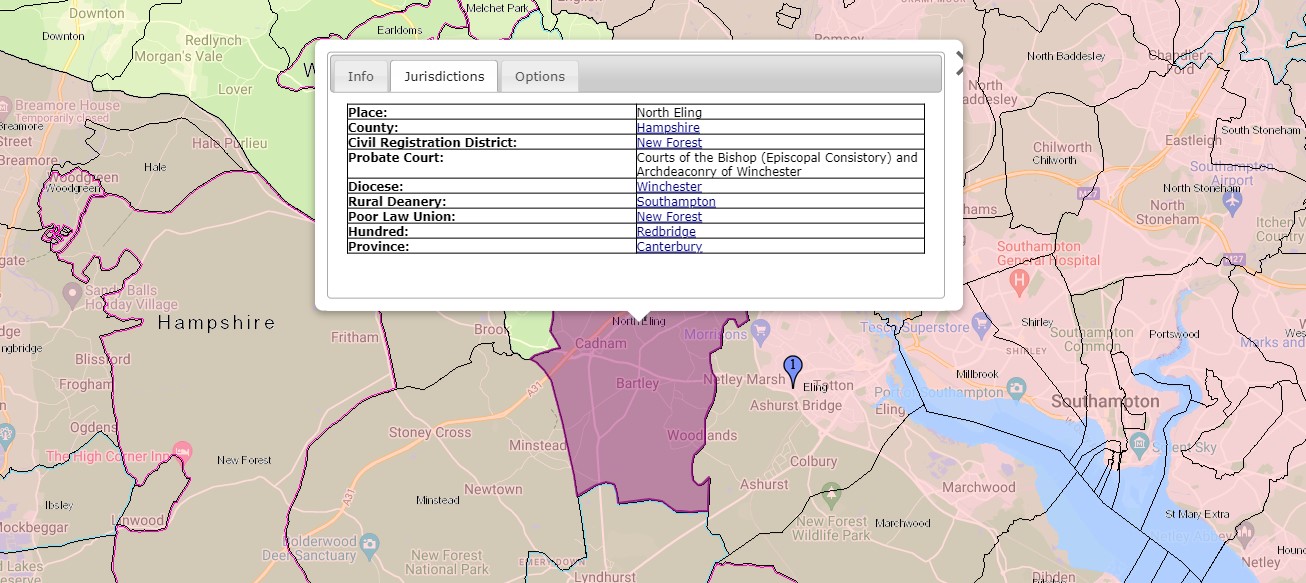
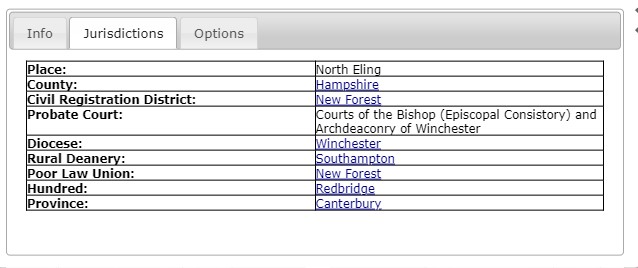
Jurisdictions;
- Place; North Eling
- County; Hampshire
- Civil Registration District; New Forest
- Probate Court; Courts of the Bishop (Episcopal Consistory) and Archdeaconry of Winchester.
- Diocese; Winchester
- Rural Deanery; Southampton
- Poor Law Union; New Forest
- Hundred; Redbridge
- Province; Canterbury
All the Jurisdictions apart from the place are the same for all three parishes.
Marchwood
Nine years after the division of the Ancient Parish of Eling to create North Eling, a further split to create the Parish of Marchwood.
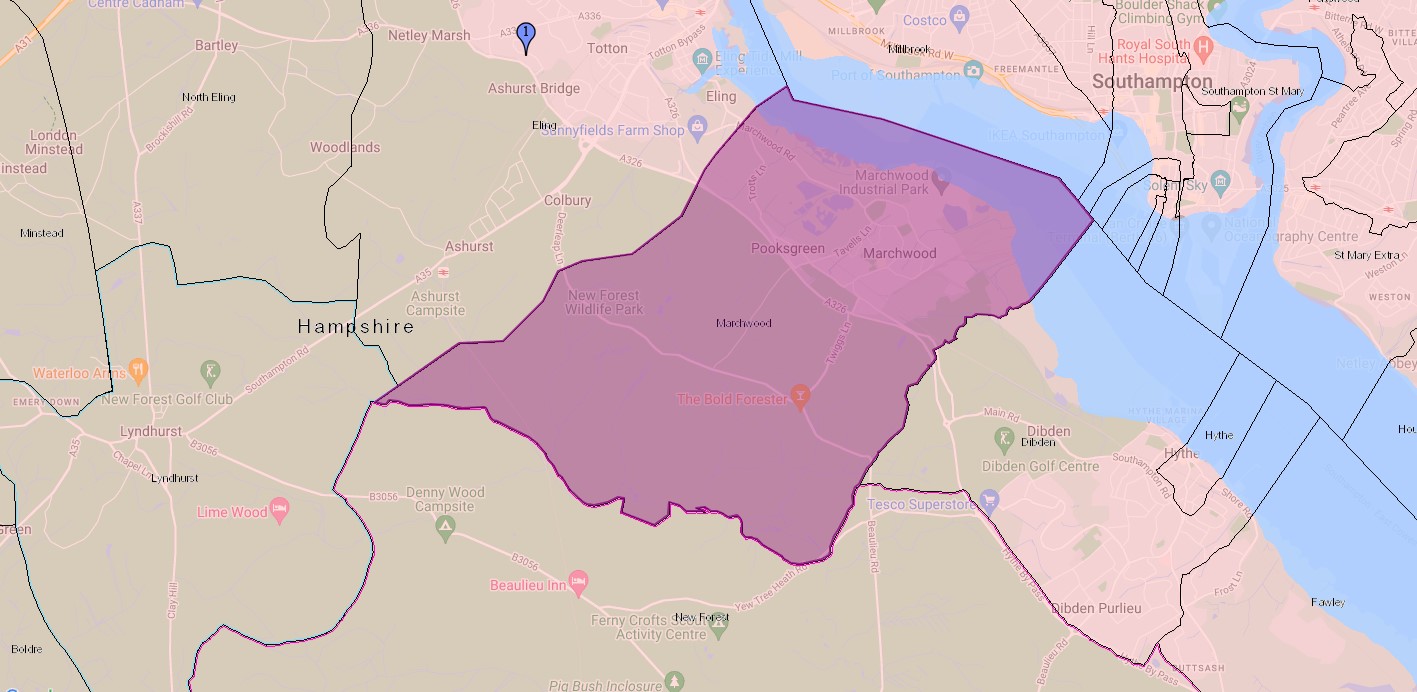
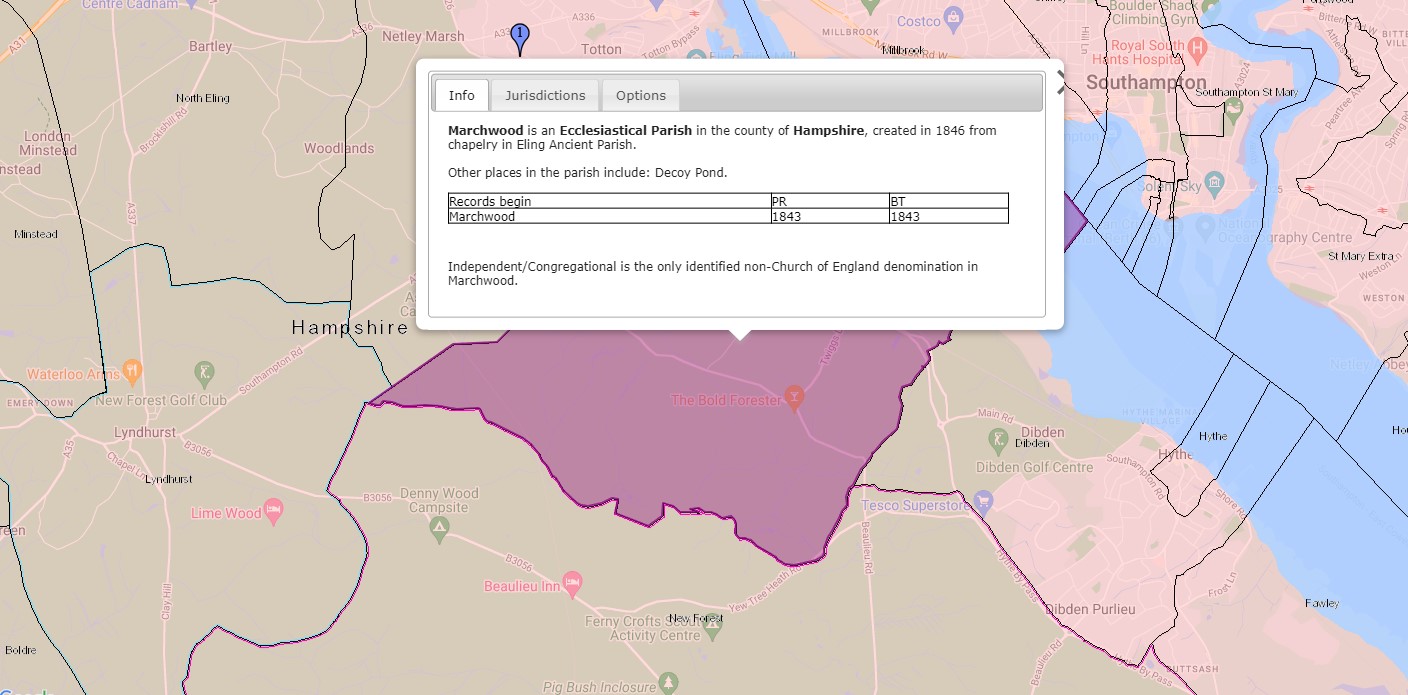
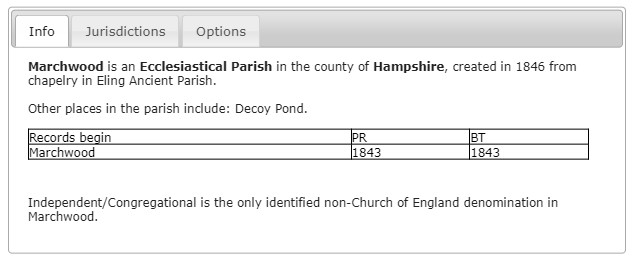
Marchwood is an Ecclesiastical Parish in the county of Hampshire, created in 1846 from chapelry in Ealing Ancient Parish.
Other places in the parish include: Decoy Pond.
Parish records begin in 1843 and Bishops Transcripts 1843. Interesting that the Parish records commence before the creation of the parish.
Independent/Congregational is the only identified non-Church of England denomination in Marchwood.
ArcGIS Church of England Parishes Map
An extract of ArcGIS Church of England Parishes Map focused on the parish of Eling
Ordnance Survey
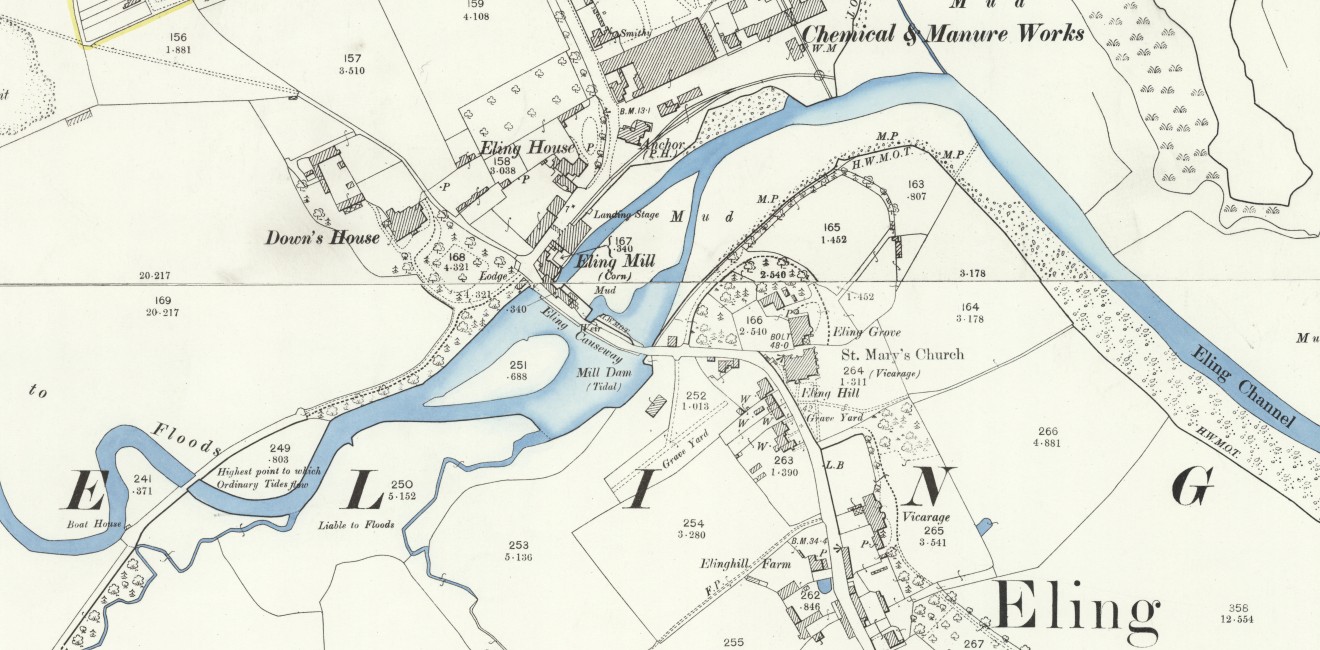 OS 25 Old Map Eling village - Hampshire and Isle of Wight LXIV.12 Revised: 1895, Published: 1897
OS 25 Old Map Eling village - Hampshire and Isle of Wight LXIV.12 Revised: 1895, Published: 1897
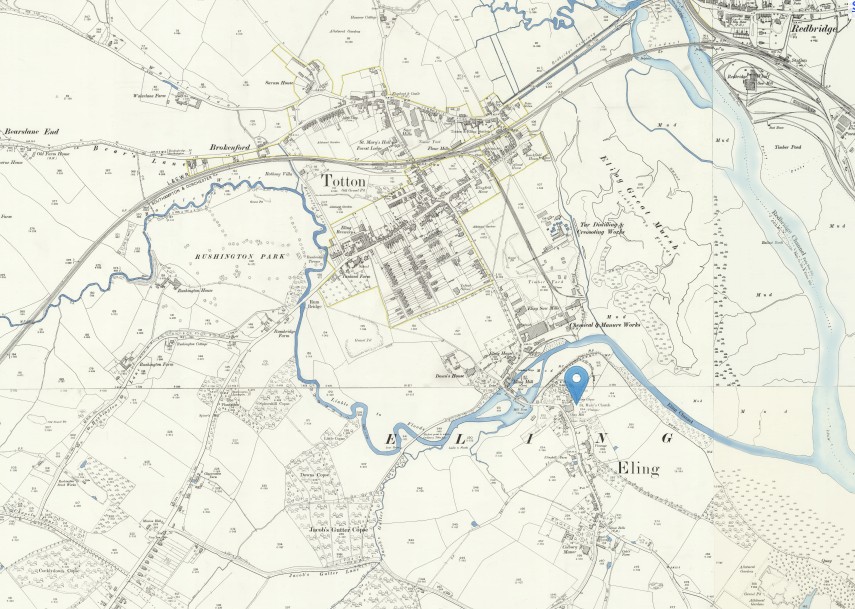 OS 25 Old Map Eling and Totton - Hampshire and Isle of Wight LXIV.8 Revised: 1896, Published: 1897
OS 25 Old Map Eling and Totton - Hampshire and Isle of Wight LXIV.8 Revised: 1896, Published: 1897
 OS 6 Old Map Ancient Eling 4 parish boundaries plus Eling mark - Hampshire & Isle of Wight Sheet LXIV.NE Revised: 1895 to 1896, Published: 1897
OS 6 Old Map Ancient Eling 4 parish boundaries plus Eling mark - Hampshire & Isle of Wight Sheet LXIV.NE Revised: 1895 to 1896, Published: 1897
For this rendition of the 6" version of the same Ordnance Survey Map I have slowly traced the boundary makers shown on the map to more easily see the ancient parish of Eling, as well as the now four resultant parishes.
First it was one parish, then three, then four at the time of this map, 1895.
It is made up of several map sheets, one of which is Hampshire & Isle of Wight Sheet LXIV.SE
Revised: 1895, Published: 1898.
The village of Eling is shown by the blue marker.
The 1895 Eling Parish boundary is shown with the orange line.
The Parish of Copythorne has a yellow outer boundary.
The Parish of Netley Marsh has a green outer boundary.
The Parish of Colbury has a red outer boundary.
The Parish of Marchwood has a light blue outer boundary.
With inner boundaries sharing adjacent parishes colours.
I have saved the lines, but unfortunately they will not show when you follow the link, click the map, to the source information.
The following maps are zoomed in to each parish.
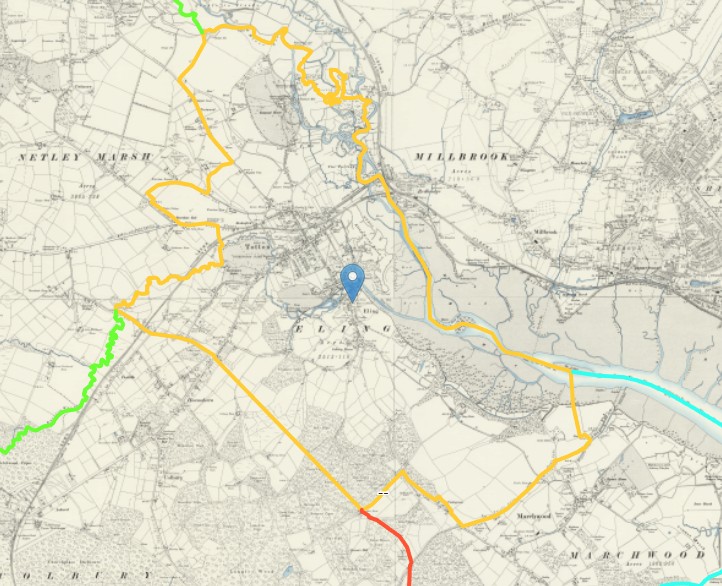
The 1895 Eling Parish boundary is shown with the orange line.
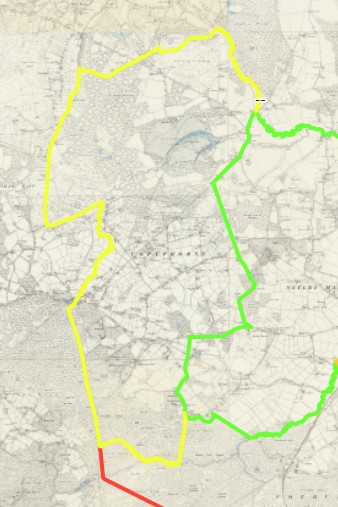
The 1895 Parish of Copythorne has a yellow outer boundary.
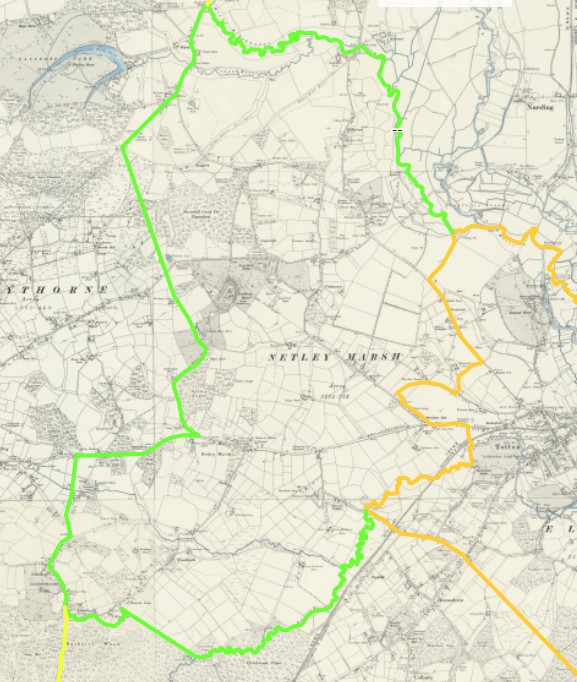
The 1895 Parish of Netley Marsh has a green outer boundary.
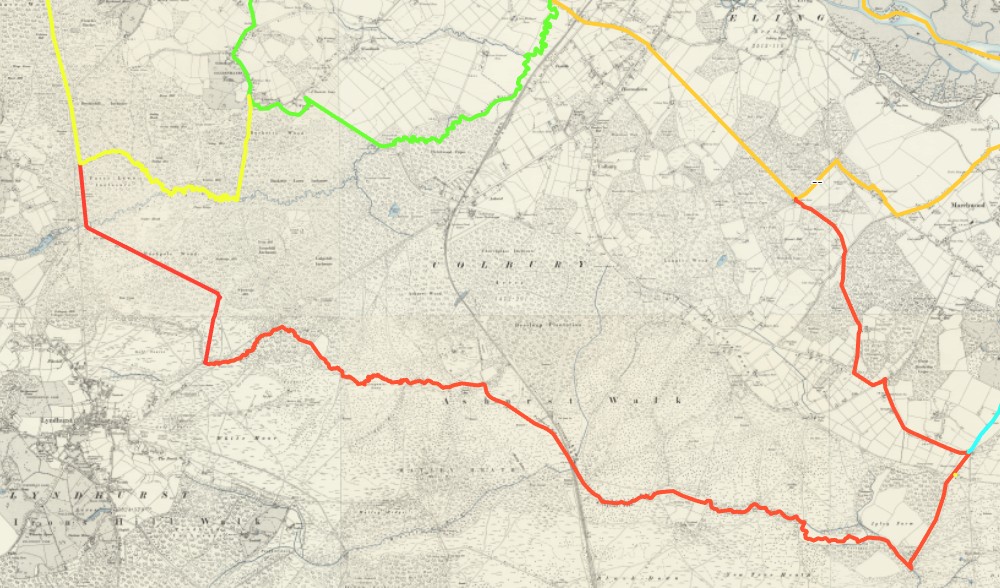
The 1895 Parish of Colbury has a red outer boundary.
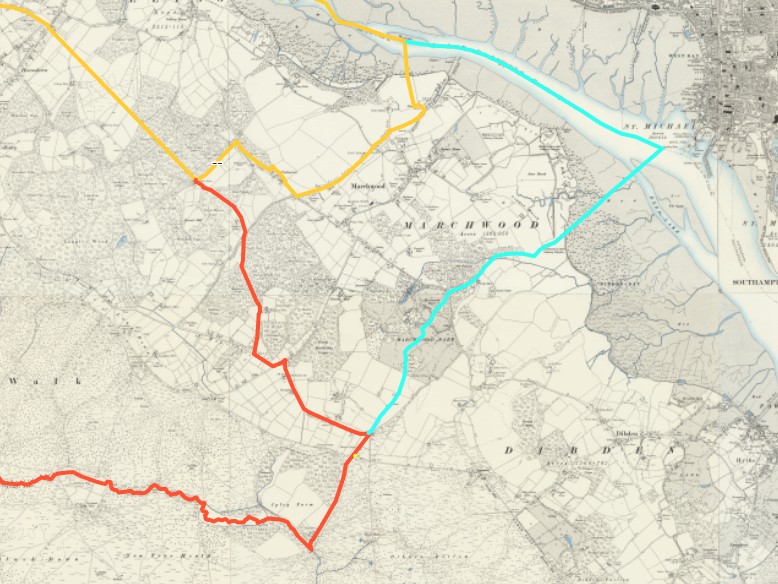
The 1895 Parish of Marchwood has a light blue outer boundary.
The Vicarage Eling
The Vicarage, Eling Hill, Eling, Hampshire, England.
The vicarage, Eling Hill is a recuring address for some Penny and Eldridge families, according to some other peoples Trees.
The vicarage of St Mary's aka St Mary the Virgin church is adjacent to the marker on the above map.
Although, on these OS 25" Maps, there is another Vicarage slightly further along Eling Hill, opposite Elinghill Farm.
Andover - old
Andover
Andover is an Ancient Parish and a market town in the county of Hampshire. Foxcott is a chapelry of Andover.
Other places in the parish include: King’s Enham, Hatherden, Enham Kings, Charlton, Woodhouse, Wildhern, Swanhill, Smannell, and Little London.
Alternative names: Andover With Foxcott
Parish church:
Parish registers begin:
Parish registers: 1587
Bishop’s Transcripts: 1703
Nonconformists include: Baptist, Church of Jesus Christ of Latter-day Saints, Independent/Congregational, Particular Baptist, Primitive Methodist, Society of Friends/Quaker, and Wesleyan Methodist.
Jumping back in time to closer to that of Abraham Hurst, Taylor's Map of Hampshire 1759.
Milne's Map of Hampshire 1791, Andover and surrounding area.
Jumping forward out of the period of Abraham Hurst, which ended in 1777, above is an OS Original Series Map at about 1817. A little more detail, but not a huge change in the size of Andover.
The Greenwood 1826 Map of Hampshire, Andover and area, included here just to complete the set of Old Maps of Hampshire with a scale of approximately one Inch. Perhaps a little clearer as it is in colour.
Click on any of the above maps to view them at source, Old Hampshire Mapped. There are a lot more maps to see there.
Broughton and Houghton
Broughton is 10 to 11 miles, about 4hrs walking, away from Andover depending on which route taken, and is less than 3 miles from Houghton, only 1 hour walking. Unfortunately Google Maps does not yet have an option for riding a horse or horse and carriage, but somewhat quicker that walking
Houghton is around 10 miles, slightly less than 4hrs walking, away from Andover depending on which route taken.
The Parishes of Broughton and Houghton are both small and adjacent to one another.
The above is a screenshot of the current ESRI Church of England (CoE) Parish Map, centred on Broughton. On the live map there is a lot of statistical information about the Parish in the current time. Click on the image to go to the live map. The web address is to this image,but it may automatically redirect you London. If this is the case search for Broughton, Test Valley, Hampshire, England, GBR or Houghton, Test Valley, Hampshire, England, GBR
Not very relevant to the issue at hand, in the mid 1700's but interesting.
Still not the 1700's but a very much closer representation in Old OS maps.
A National Library of Scotland Georeferenced tiled Map with both Broughton and Houghton, both circled in blue, showing their relative positions. Just two miles as the crow flies. That is just the villages though as the parishes abut residences on either side of the parish boundary could be even closer.
An image of an Old OS Sheet map showing the village of Broughton, beside Wallop Brook, a tributary of the River Test.
An image of an Old OS map showing the village of Houghton and the River Test, on its way to Romsey, Millbrook, and Southampton.
An image of an Old OS map showing a closer view of the centre of the village of Broughton and the Parish Church of St. Mary's.
An image of an Old OS Sheet map showing a closer view of the centre of the village of Houghton and the Parish Church of All Saints'
Pittleworth, Bossington
Pittleworth is a farm and manor in a Parish South of Houghton called Bossington
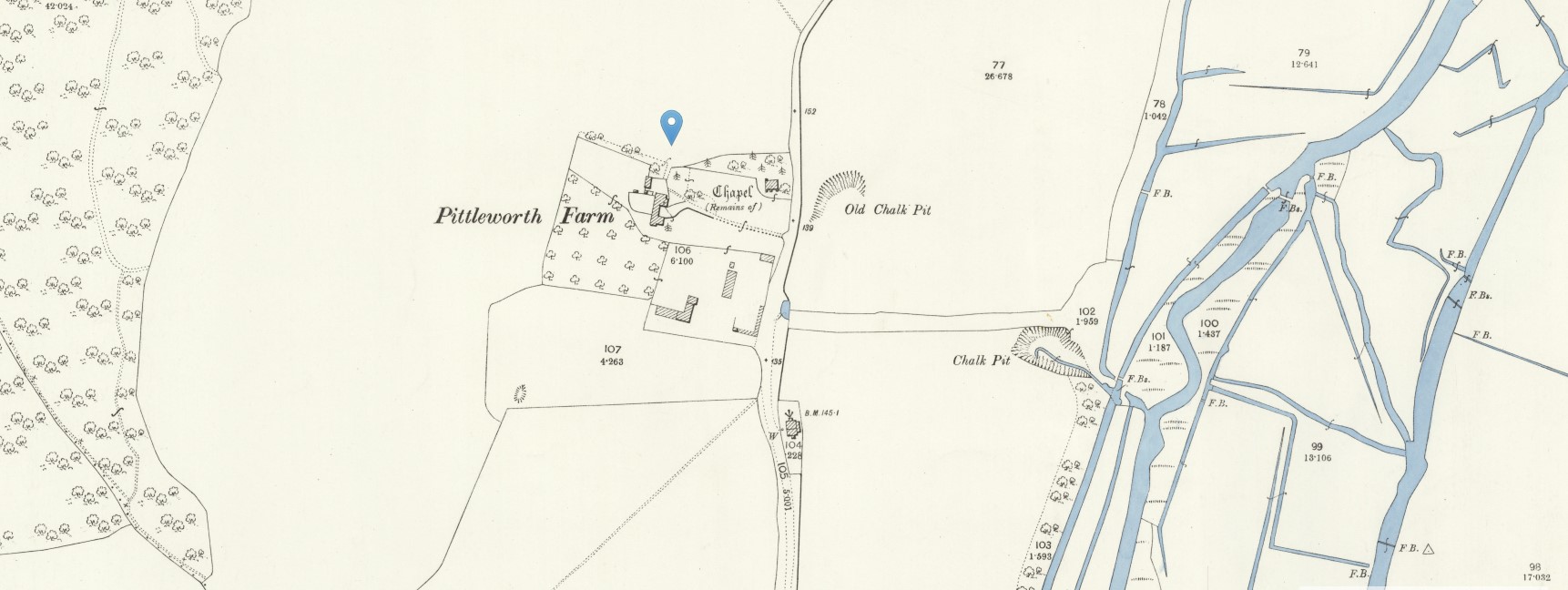
Buckholt, Broughton
Buckholt Farm and Buckholt, Broughton, Hampshire
The entry for the baptism of Sarah Hurst 1781 referred to Abraham and Sarah Hurst of Buckholt. Sometimes that would refer to a place and other-times a Farm. There are not a lot of building in the area of Buckholt and no apparent hamlet or village so it could easily be referring to Buckholt Farm.
Conclusion
Conclusion
Key data about John Mabey and his family.
Dates
Key Dates
| Name | Birth | Baptism | Marriage | Death | Interval between children | Mothers age at birth |
| John Mabey | 17th January 1771 | 3rd March 1794 | (Marriage 25 y, 1 m, 29 d) | |||
| Mary Penny | 3rd March 1794 | |||||
| (Marriage 2 y, 7 m, 28 d) | 27 years, 9 months, 26 days | |||||
| 1 year, 1 month, 7 days | 28 years, 11 months, 1 day | |||||
Data Sources / Evidence
Key Data Sources / Evidence
| Baptism | Census | ||||||||||||
| Name | Birth | Record |
Parish Image |
1841 |
1851 |
1861 |
1871 |
1881 |
1891 |
1901 |
1911 |
Death | |
| John Mabey | X | Charwoman | |||||||||||
| Mary Penny | X | -- | -- | -- | Carman | ||||||||
| X | X | X | -- | -- | |||||||||
| -- | -- | Greengrocer assistant, Dock labourer | |||||||||||
| -- | -- | Farrier, Fish Monger | |||||||||||
| -- | -- | Seaman, Dock labourer | |||||||||||
| -- | -- | Charwoman | |||||||||||
| -- | -- | ||||||||||||
| -- | -- | ||||||||||||
| -- | -- | ||||||||||||
Places of Interest
Places of Interest
| Place | Event | Date | Note |
| Birth | |||
| Baptism | |||
| . | Census 1841 | ||
| Christ Church With St Mary and St Stephen, Spitalfields, Tower Hamlets, Middlesex | Marriage | ||
| Marriage | |||
| Baptism of | |||
| Census 1851 | |||
| Baptism of | |||
| Baptism of | |||
| Baptism of | |||
| Baptism of | |||
| Census 1861 | |||
| Baptism of | |||
| Baptism of | |||
| Baptism of | 13th February 1870 | ||
| Census 1871 | |||
| Census 1881 | |||
| Census 1891 | |||
| Death |
Tree
| William Mabey | Anne Long | James Penny | Ann Eldridge | |||||||
| 1761 Martha (Sarah) |
1762 William |
1764 Susan |
1768 Joseph |
1771 John |
child 1 | child 2 | child 3 | child 4 | child 5 | |
| 1773 Richard |
1775 Milly |
1778 Mary |
1780 Susan |
1781 Charlotte |
child 6 | child 7 | child 8 | child 9 | child 10 | |
| 1782 Elizabeth |
child 12 | child 13 | child 14 | child 15 | child 11 | child 12 | child 13 | child 14 | child 15 | |
| John Mabey | Mary Penny | |||||||||
| child 1 | child 2 | child 3 | child 4 | child 5 | child 6 | child 7 | child 8 | child 9 | child 10 | |
| next ancestor | or next ancestor | |||||||||
| child 1 | child 2 | child 3 | child 4 | child 5 | child 6 | child 7 | child 8 | child 9 | child 10 | |
xxxxxxxxxxxxxxxx
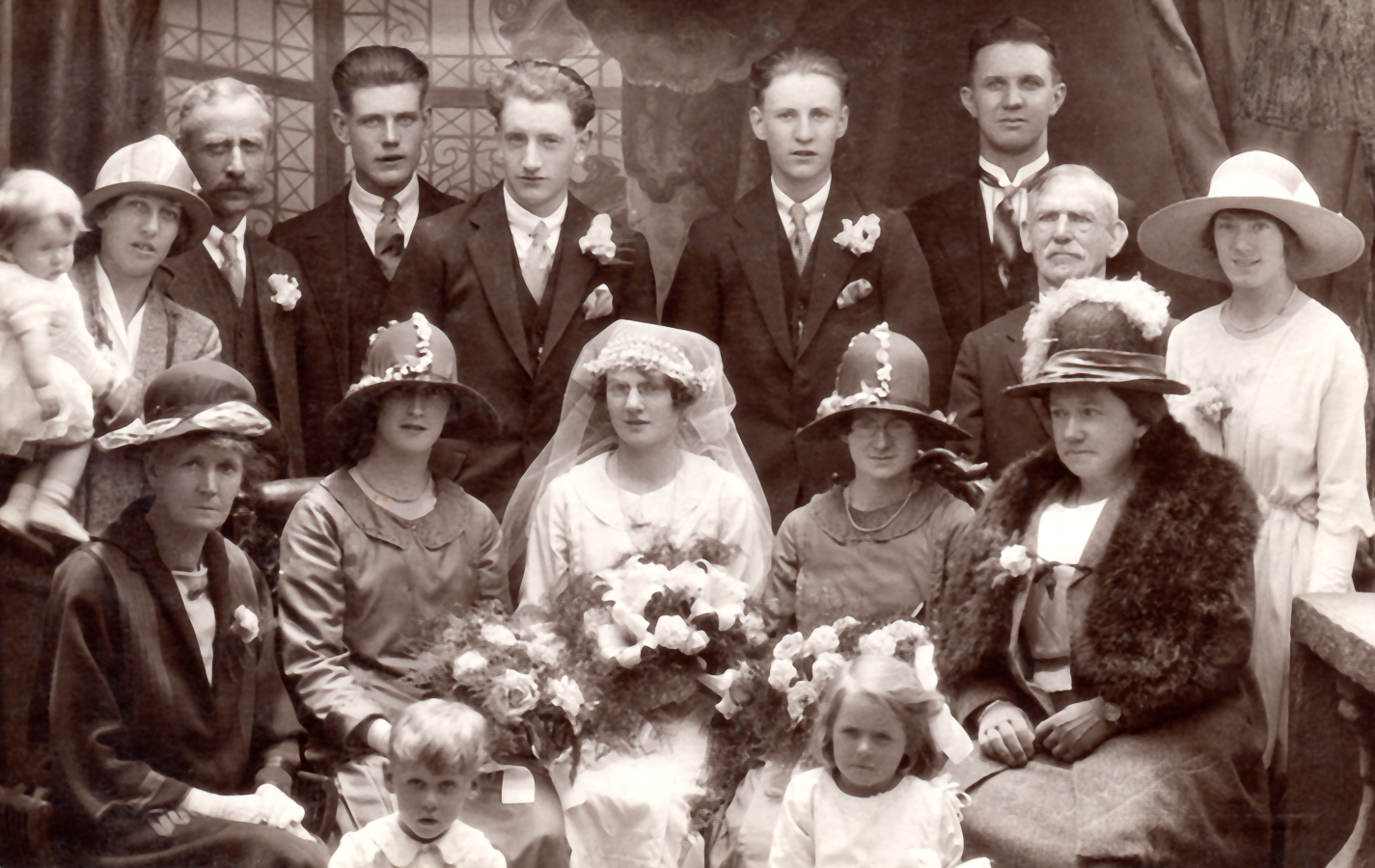
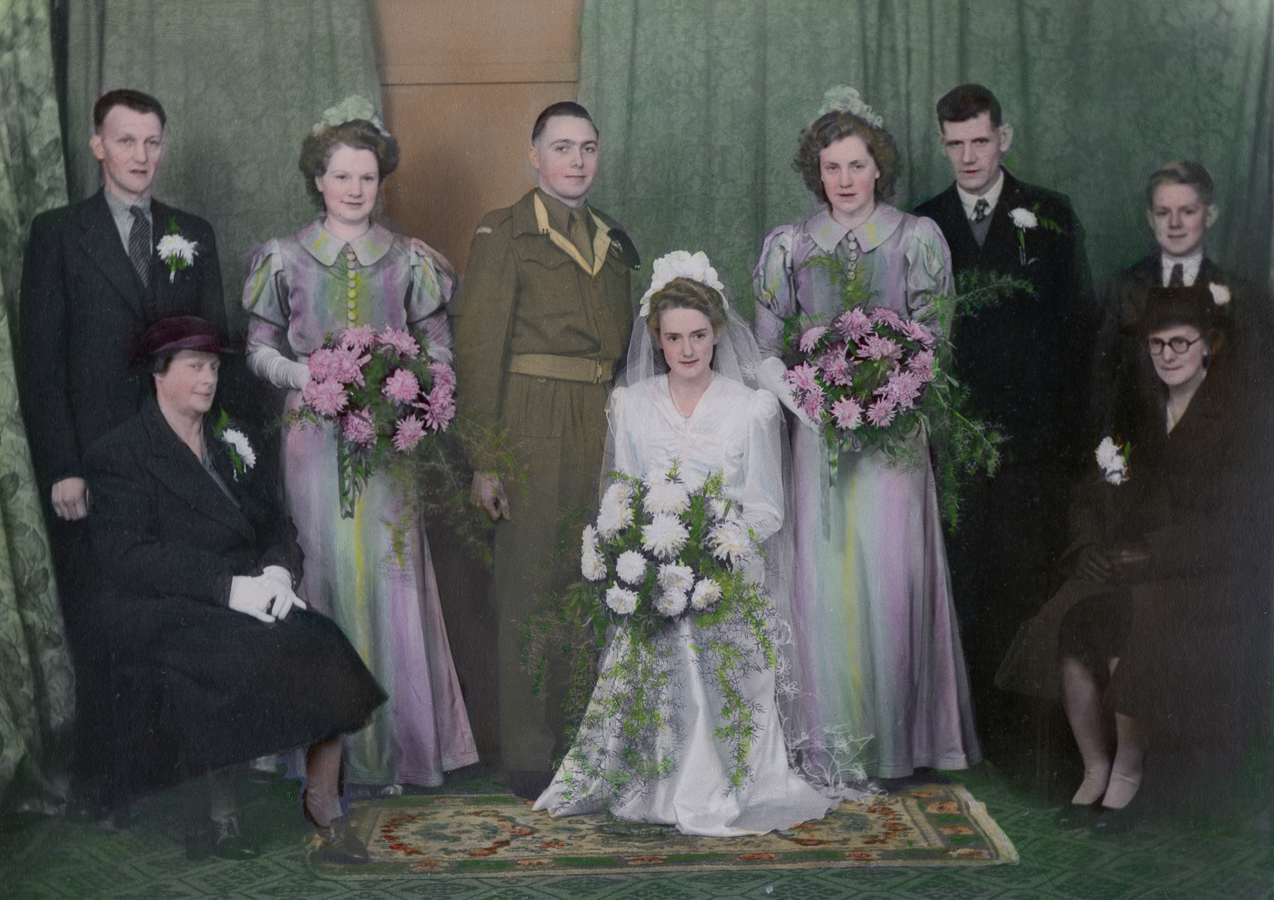
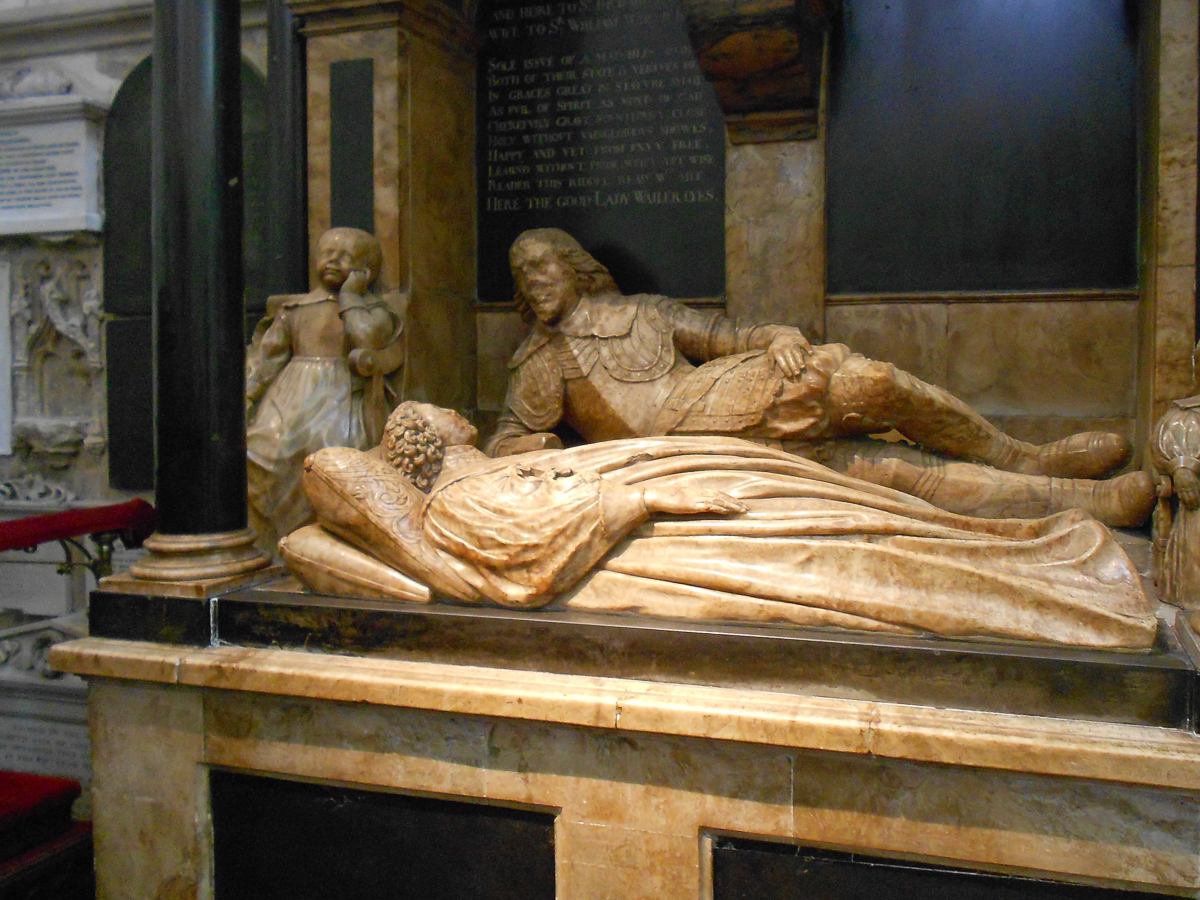
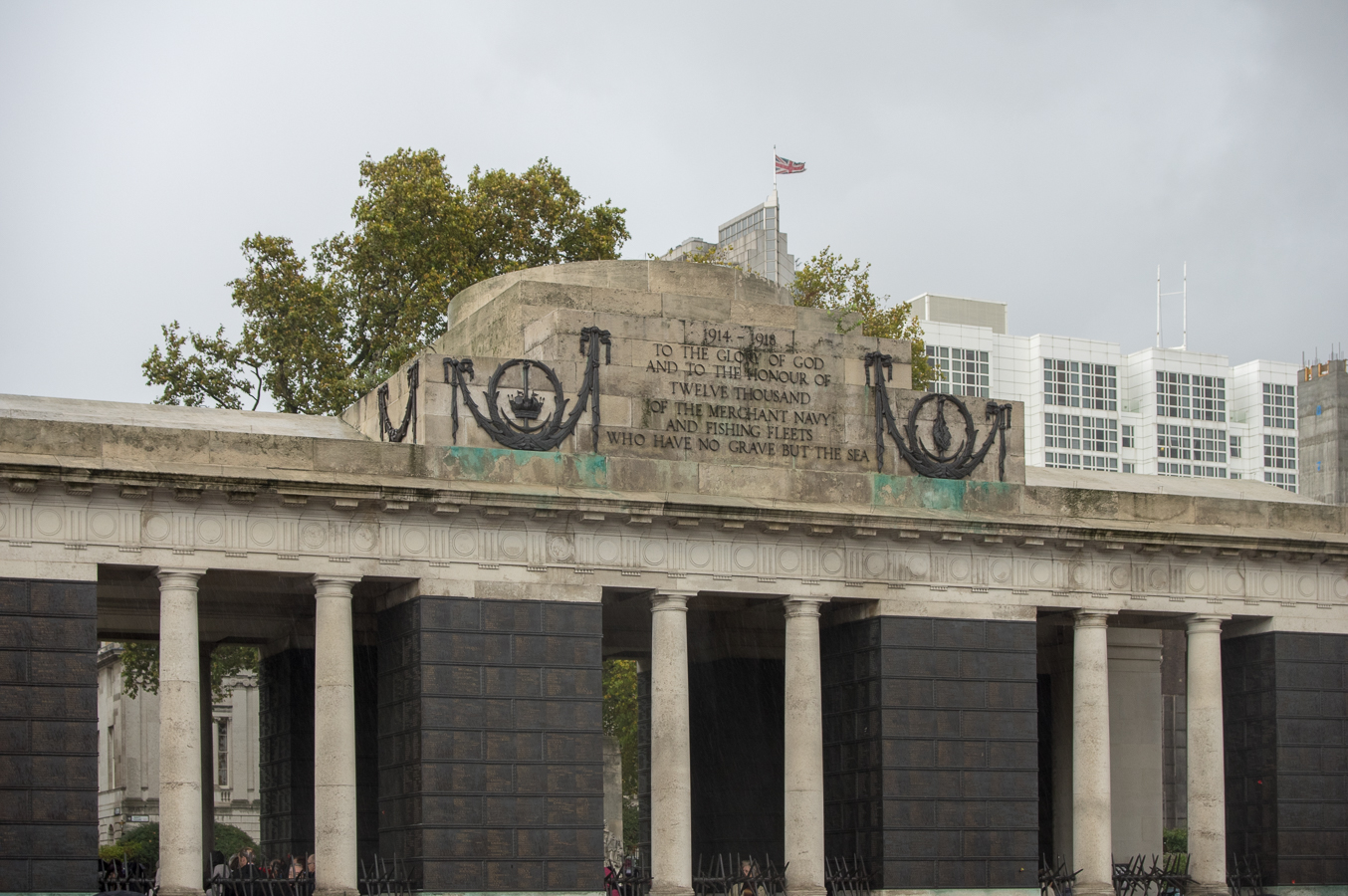

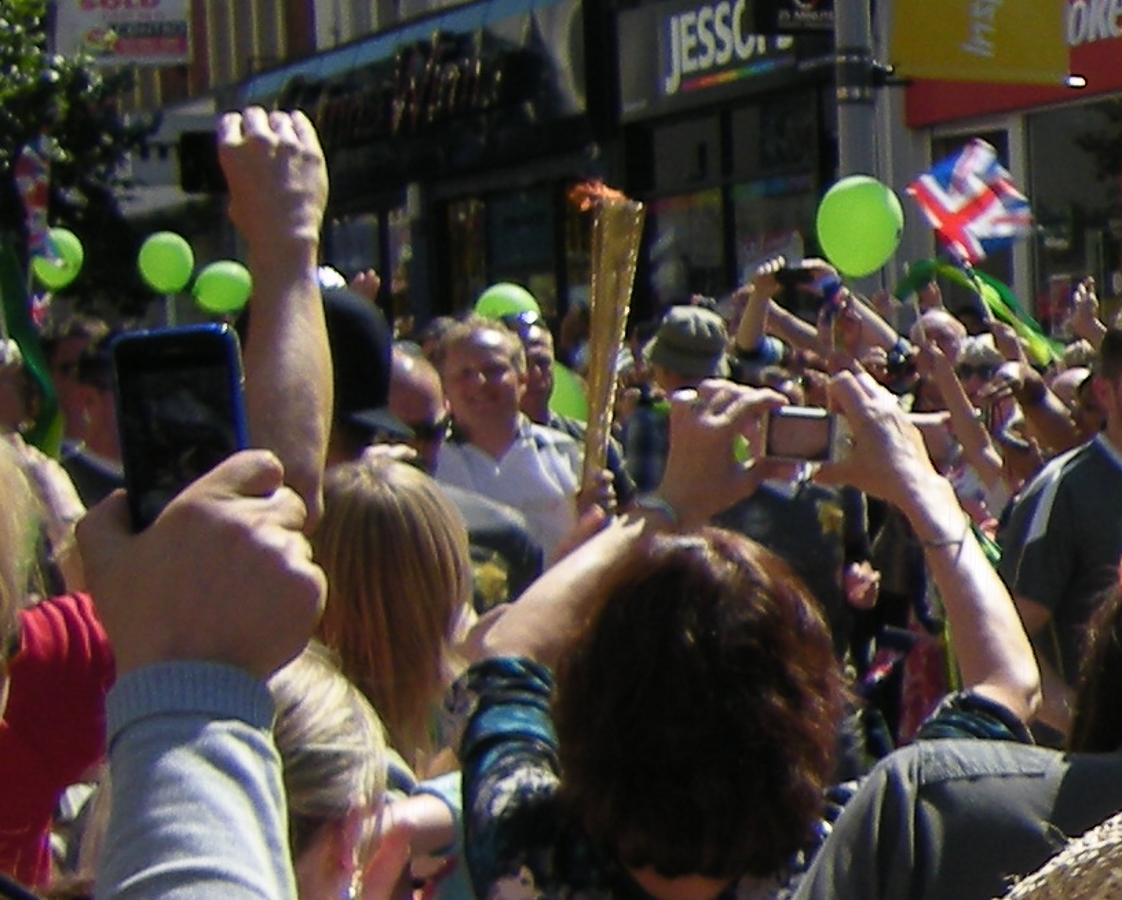
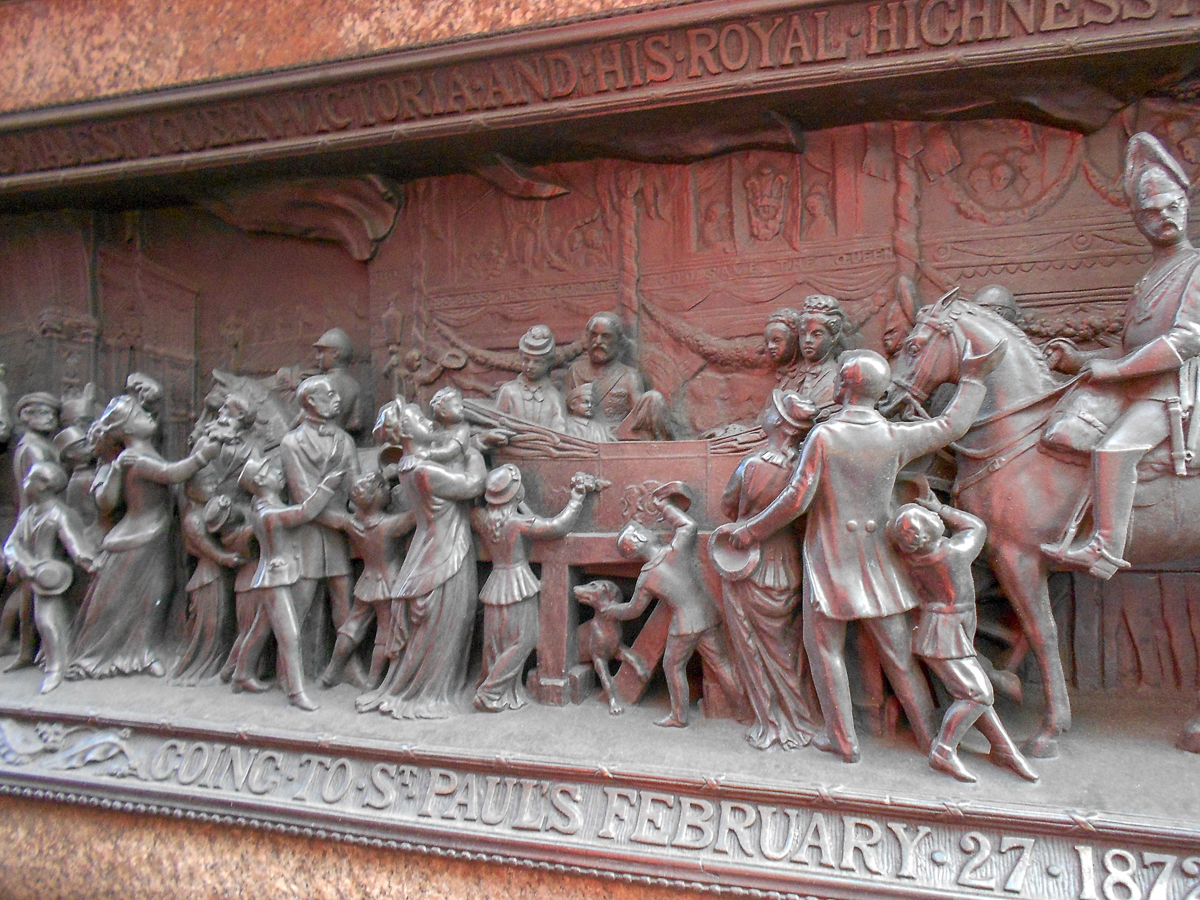
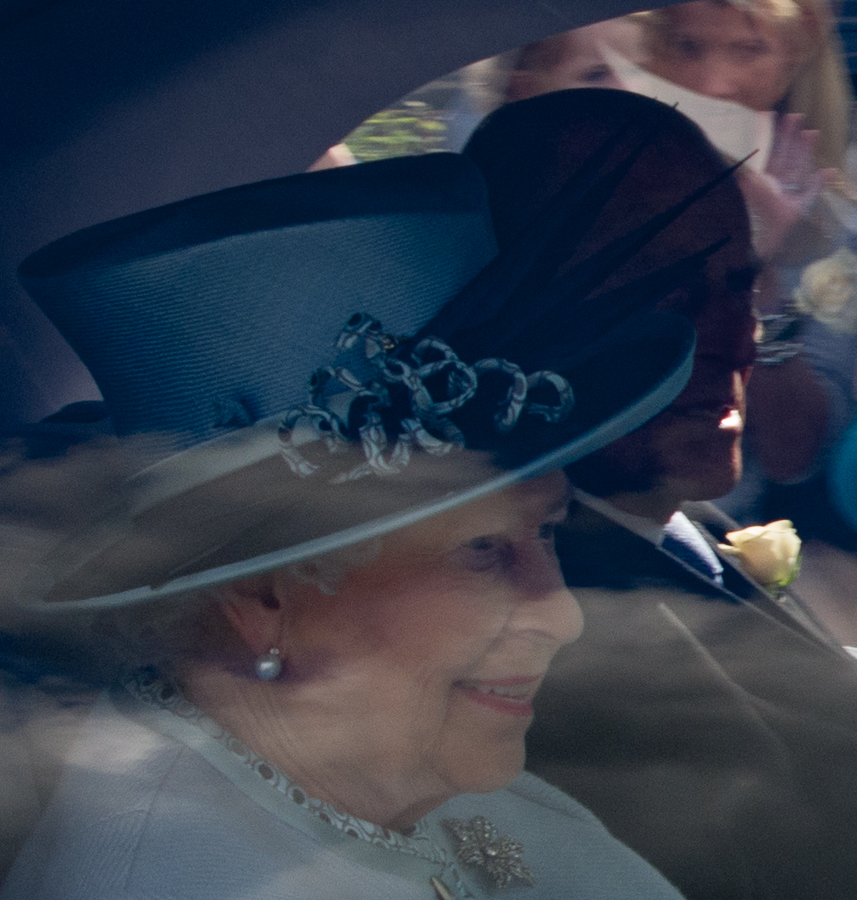

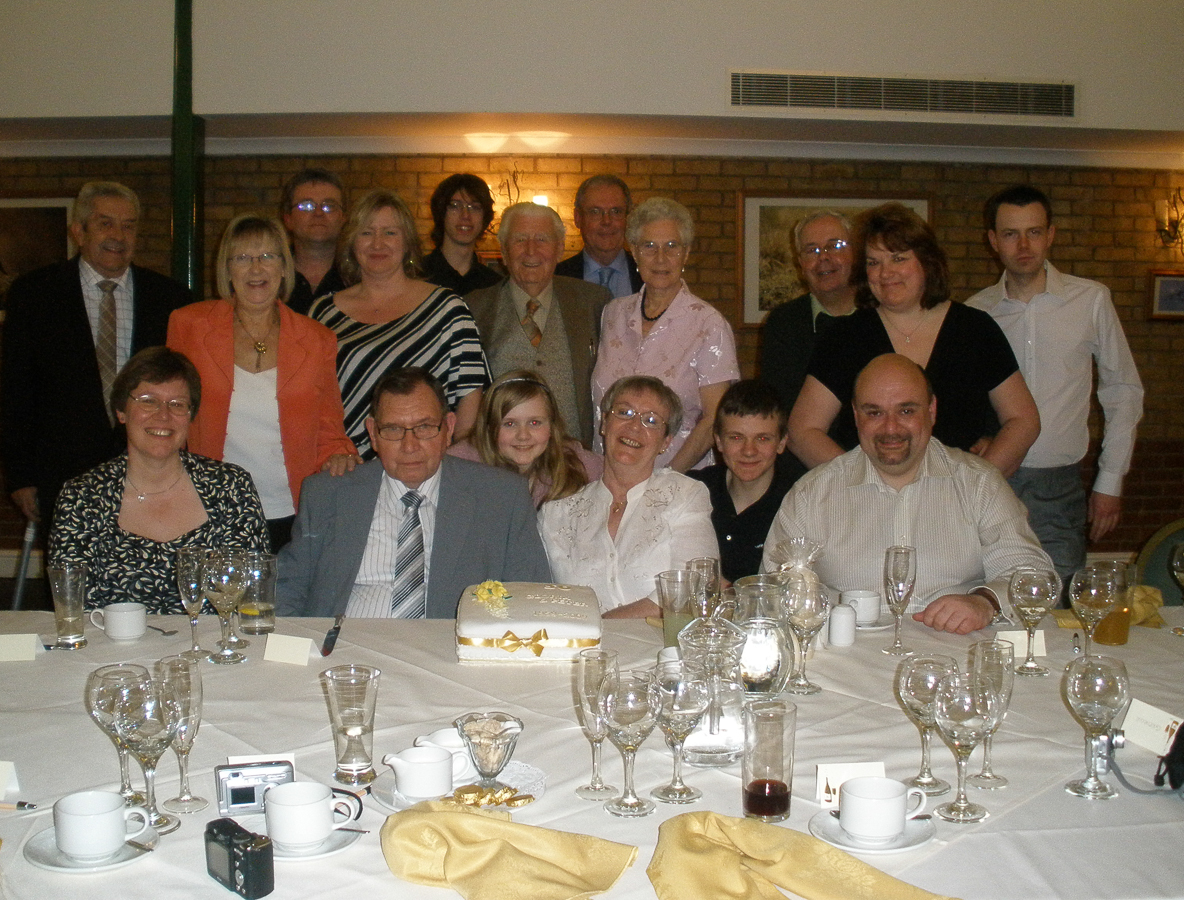

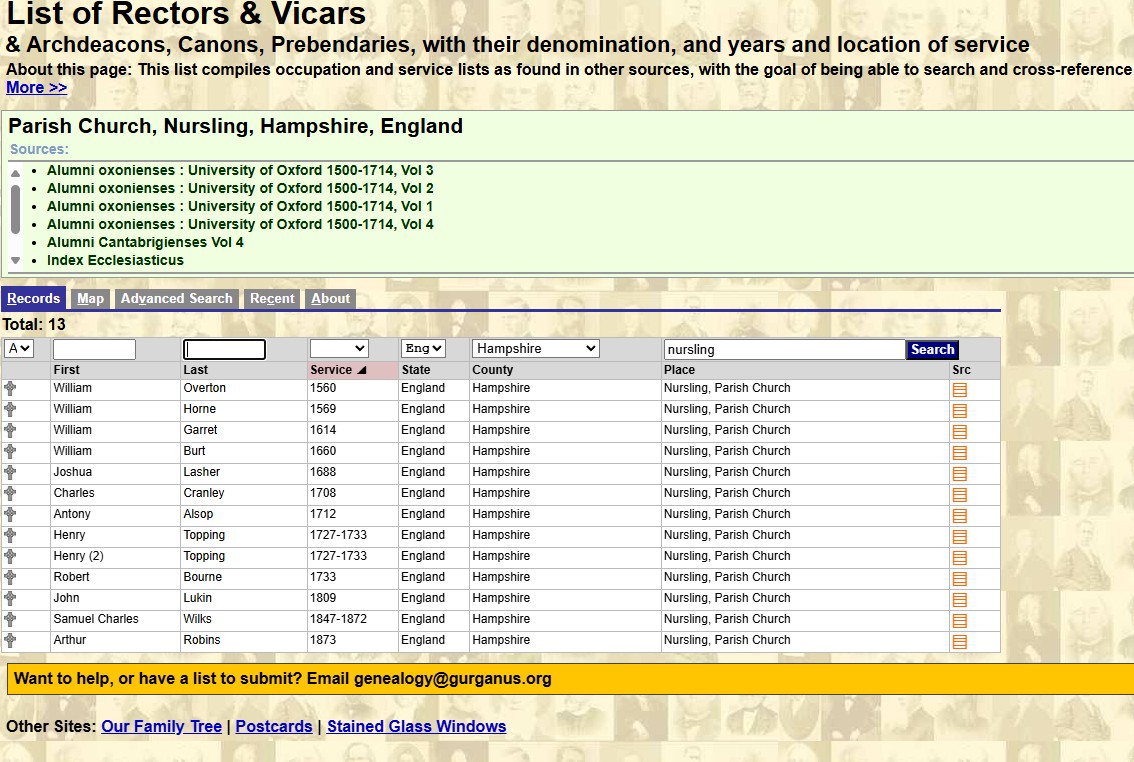
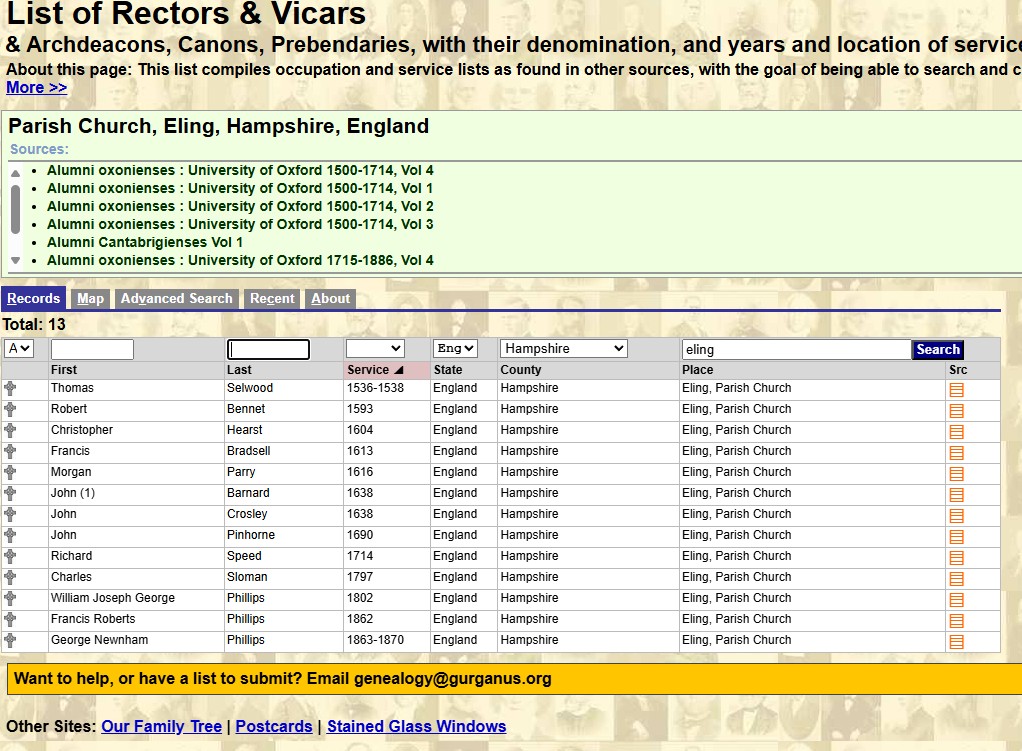
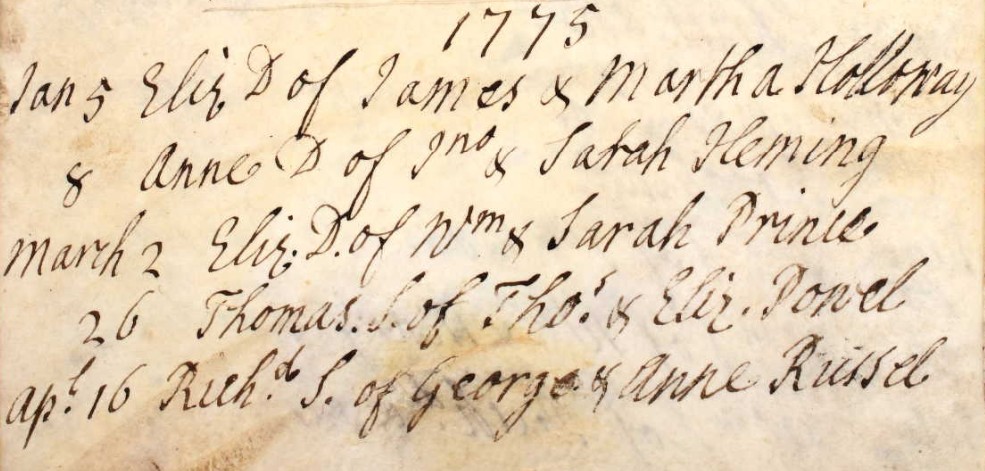
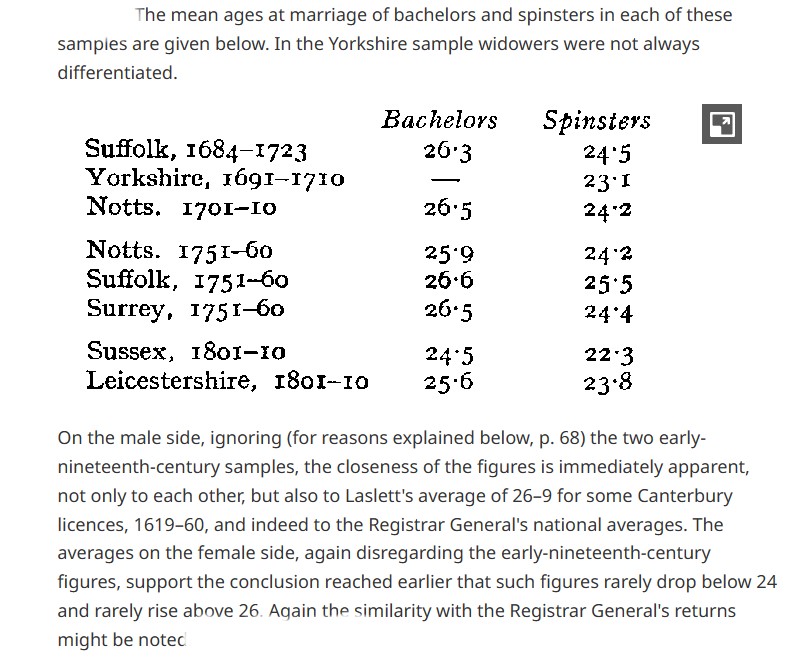
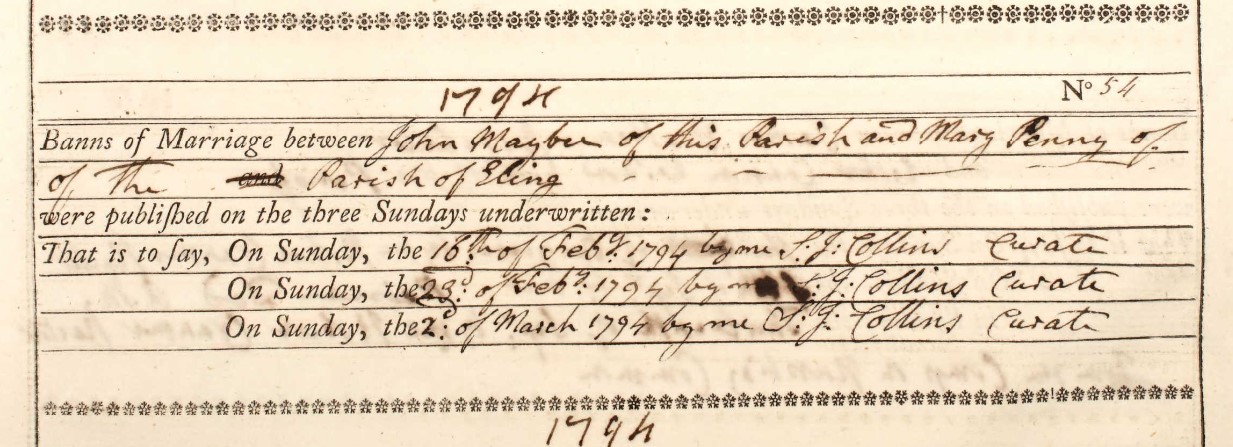
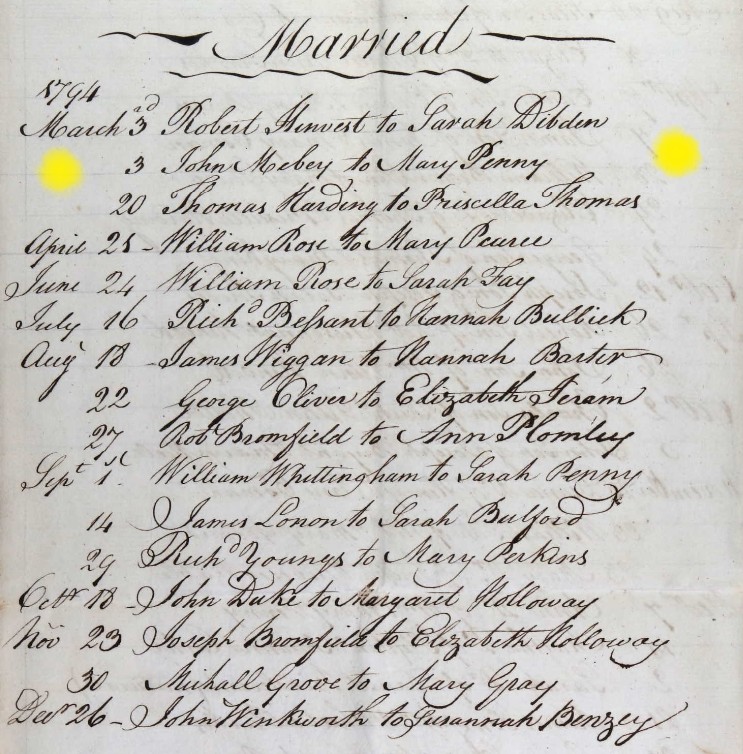
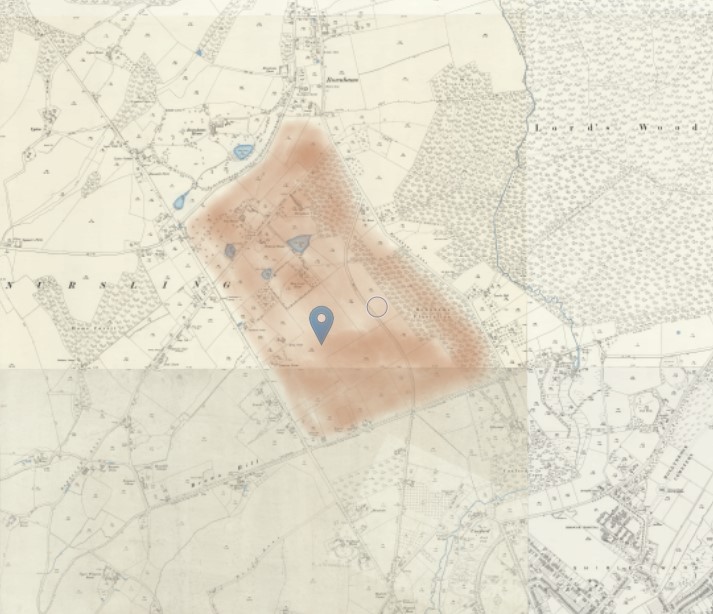
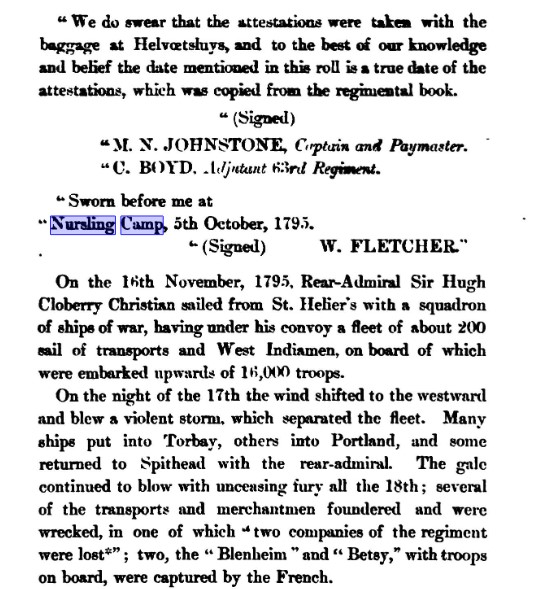
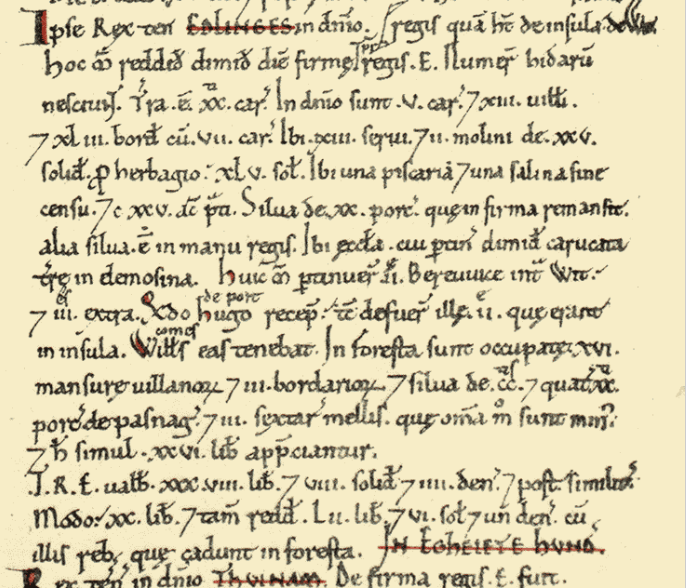 Land of King William
Land of King William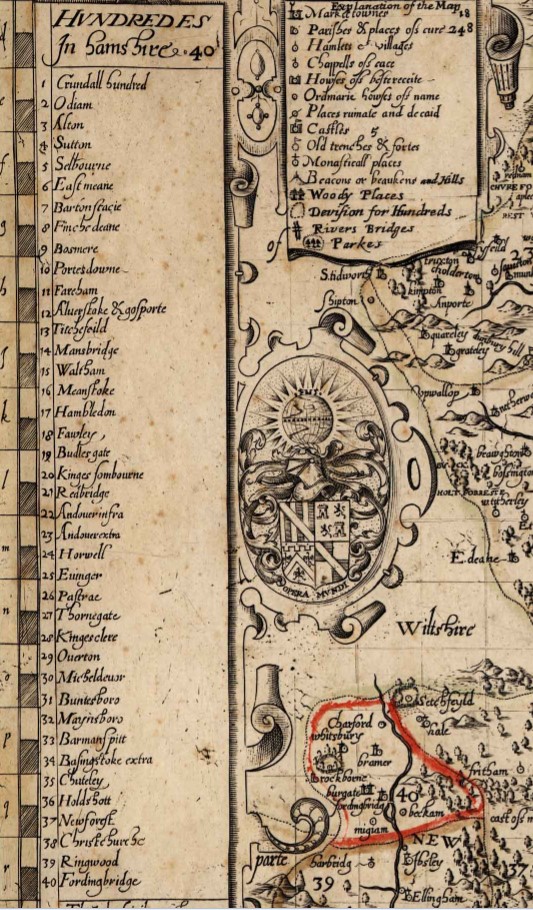 Details
Details